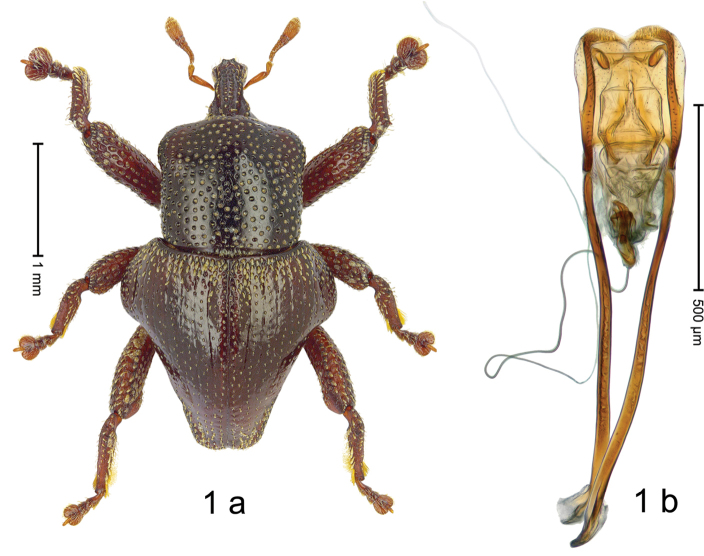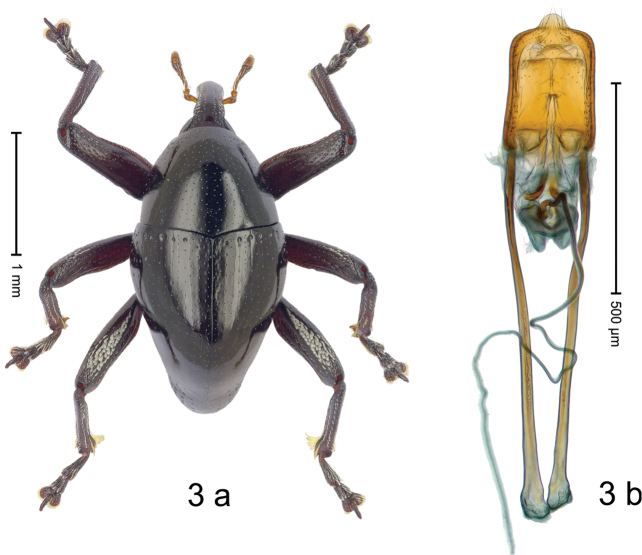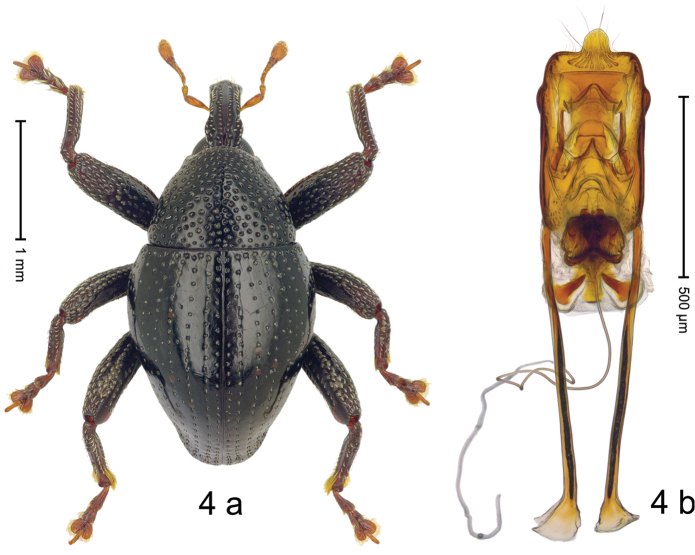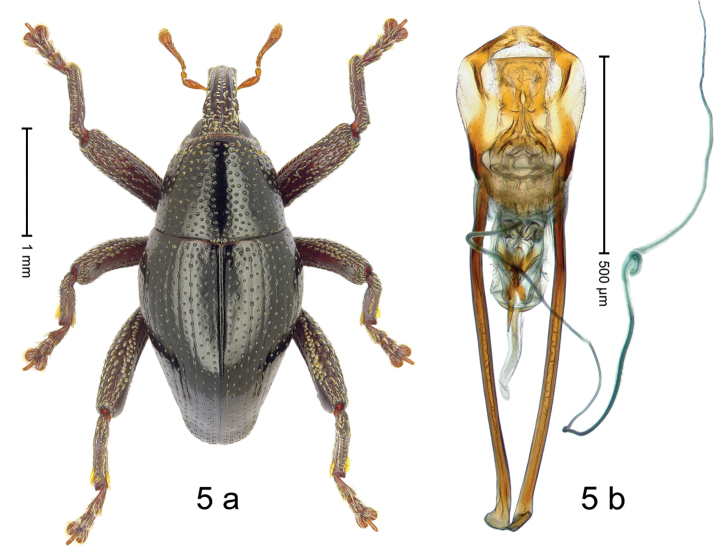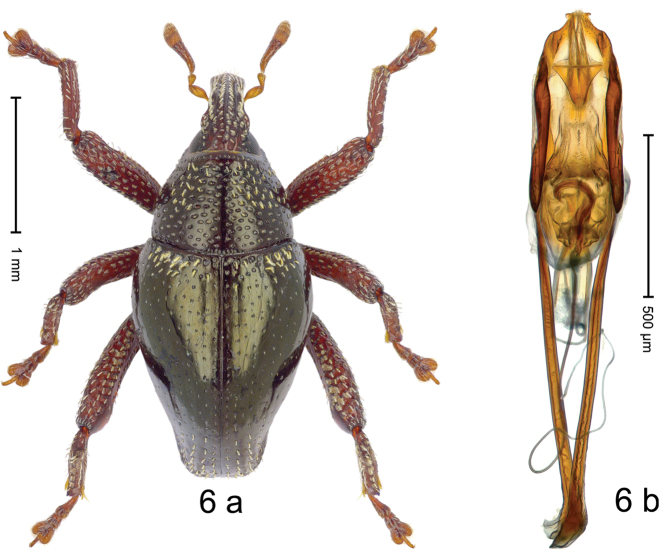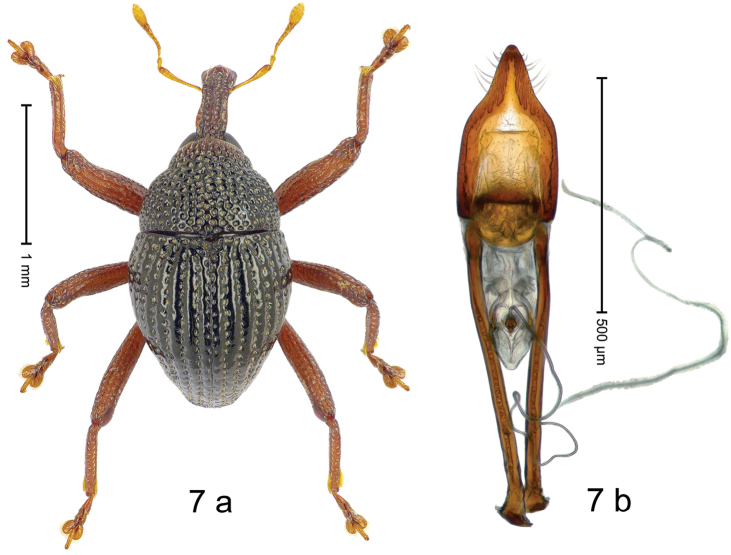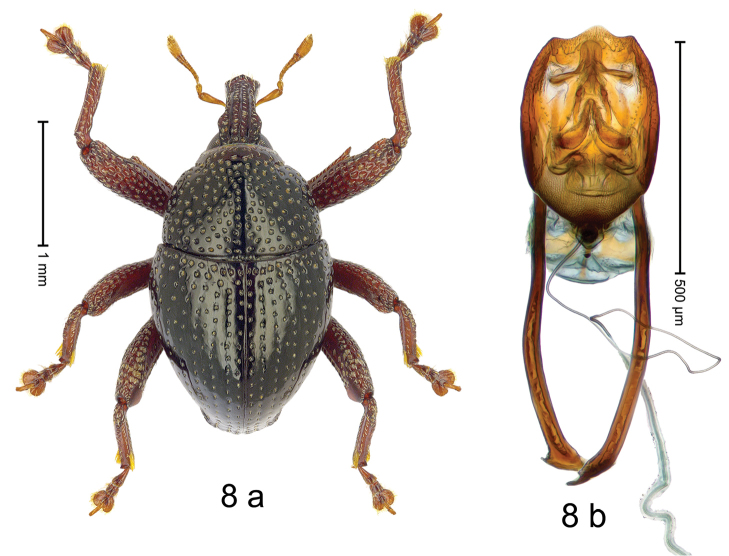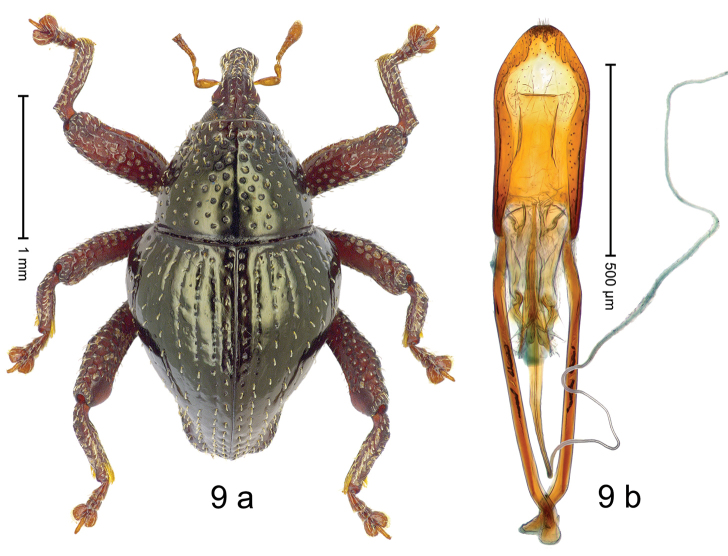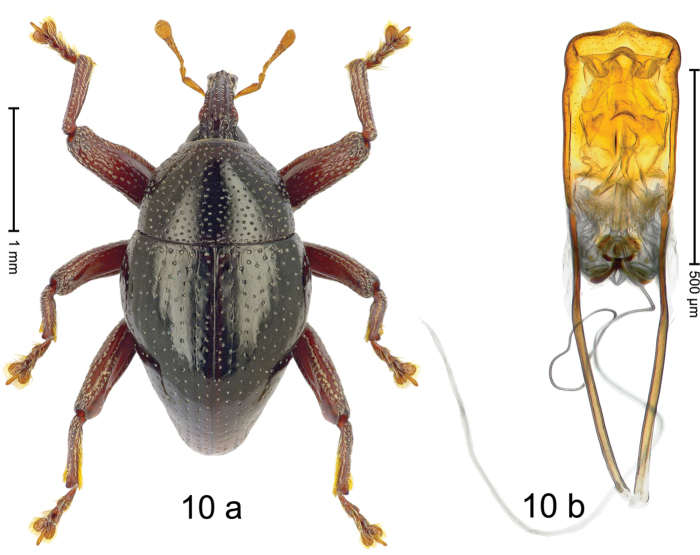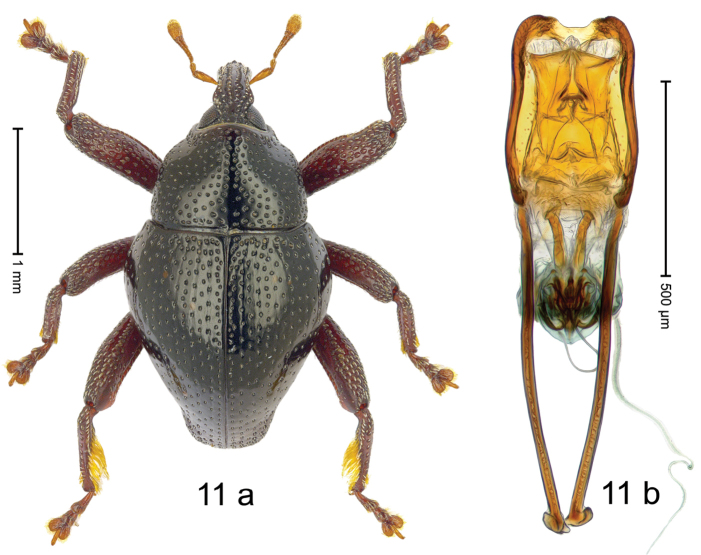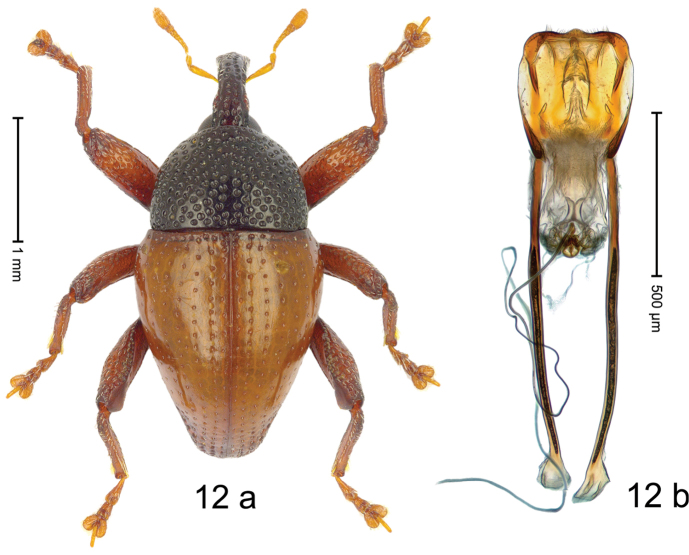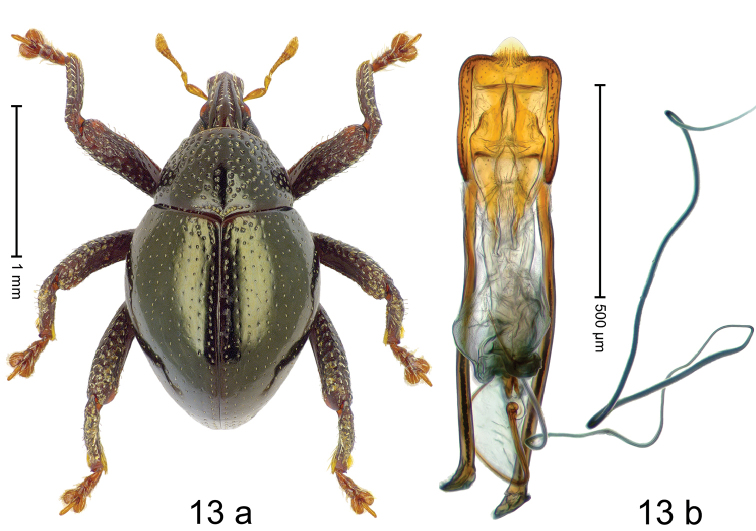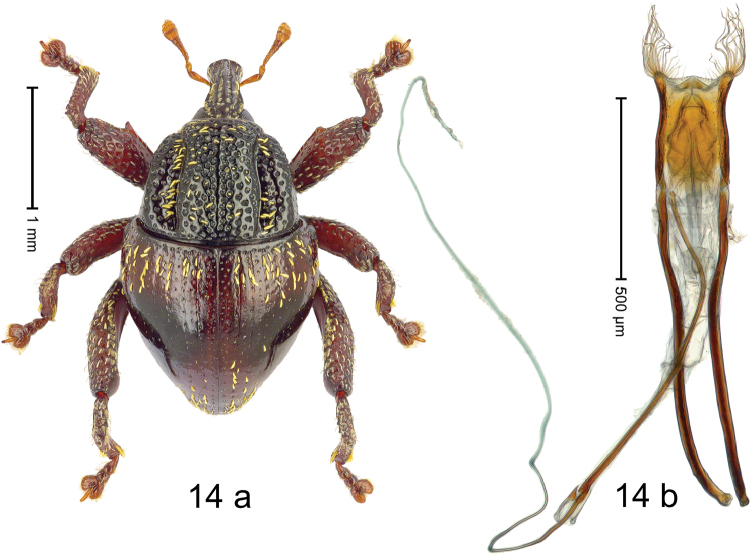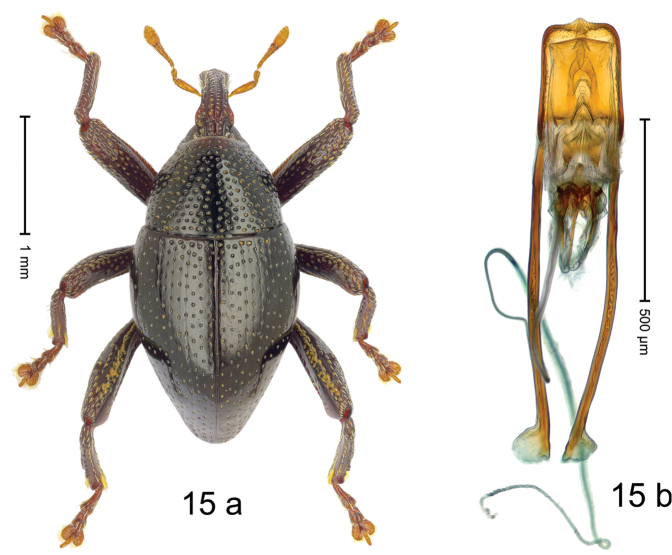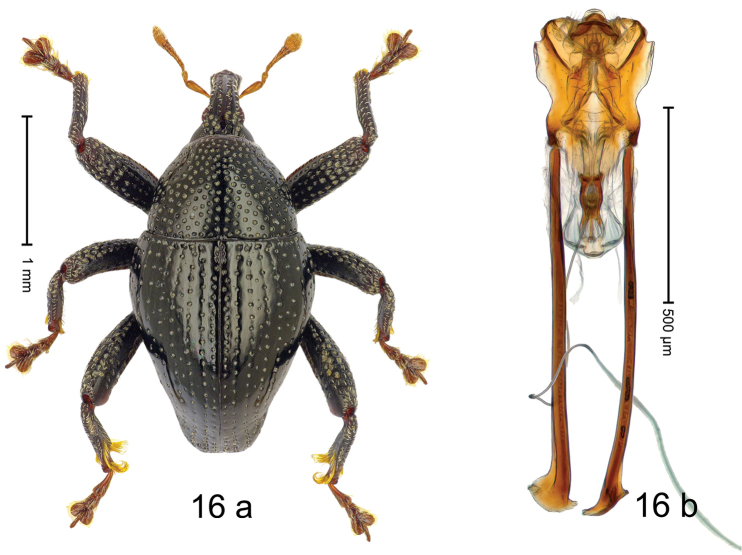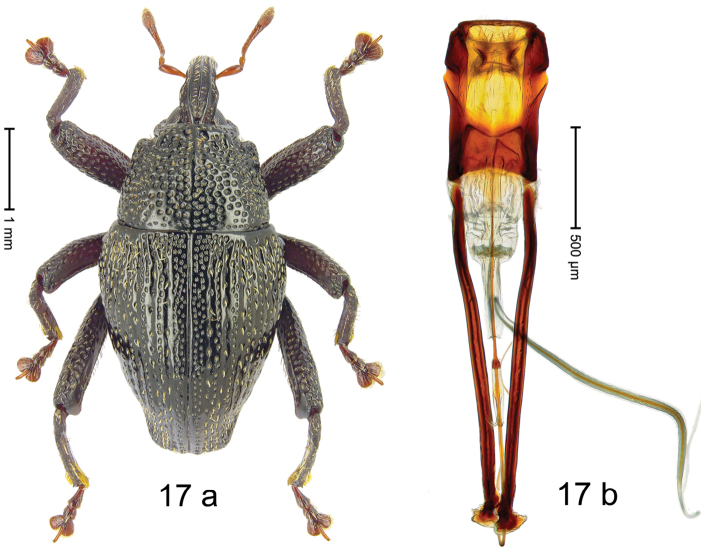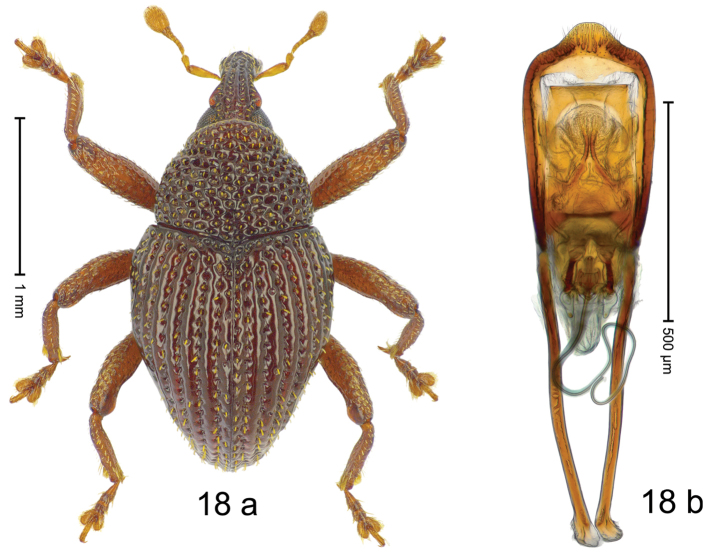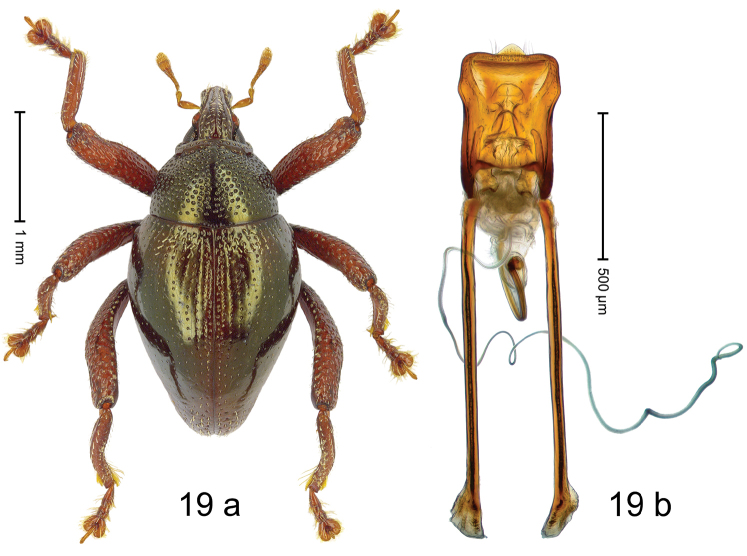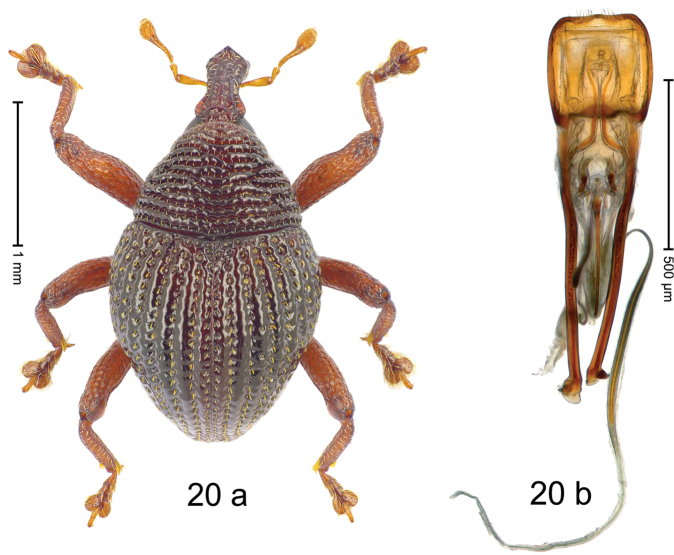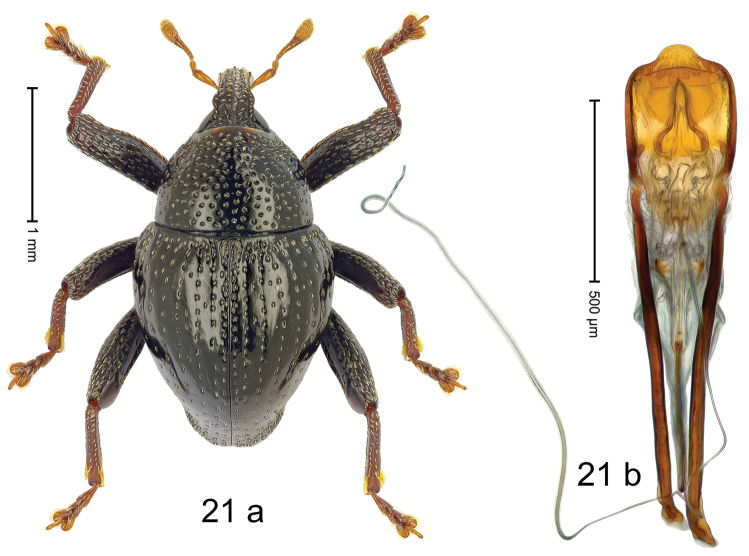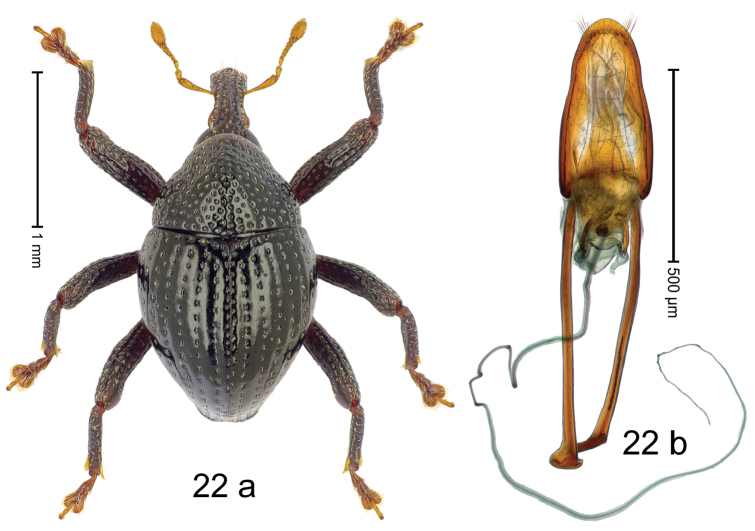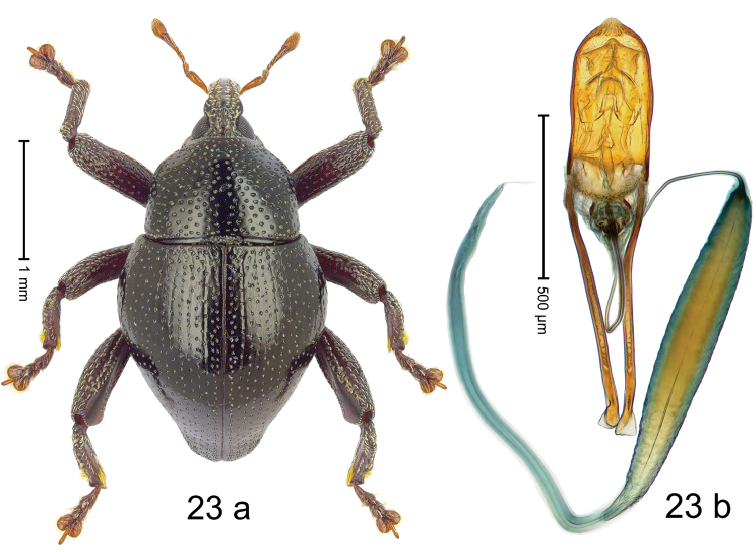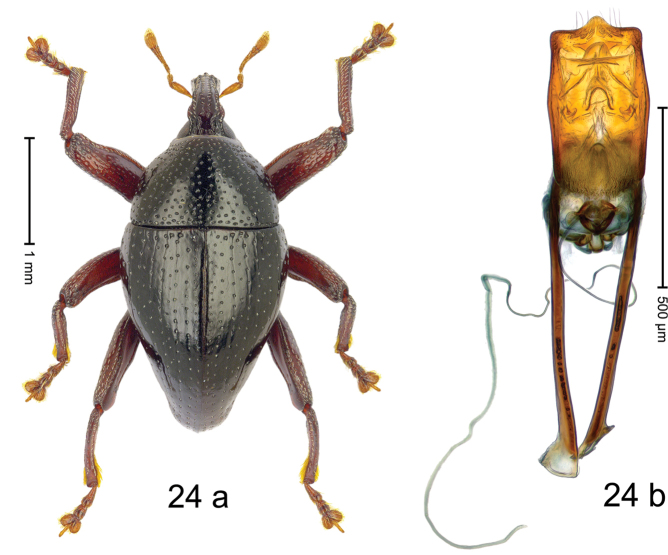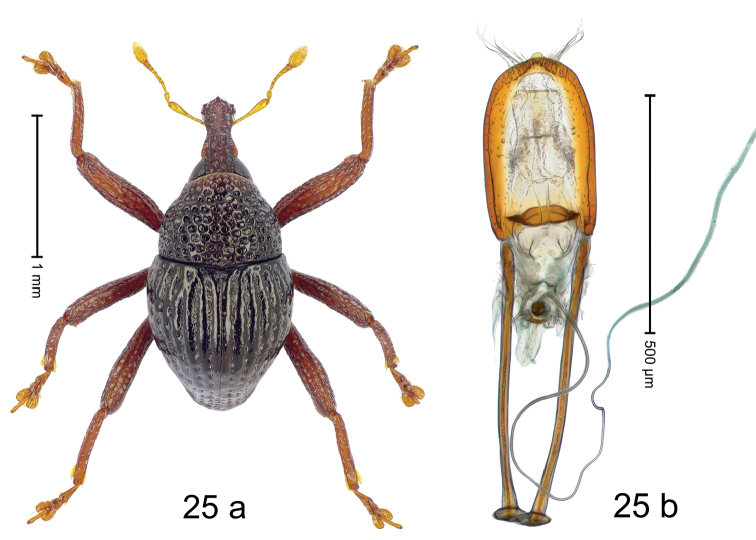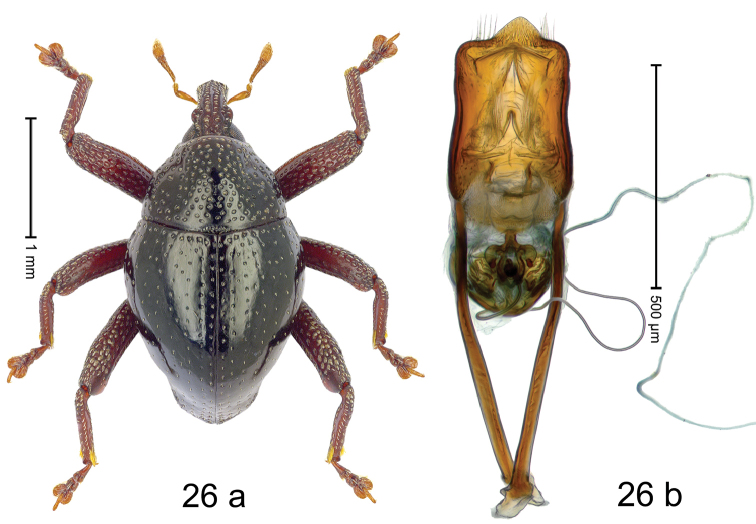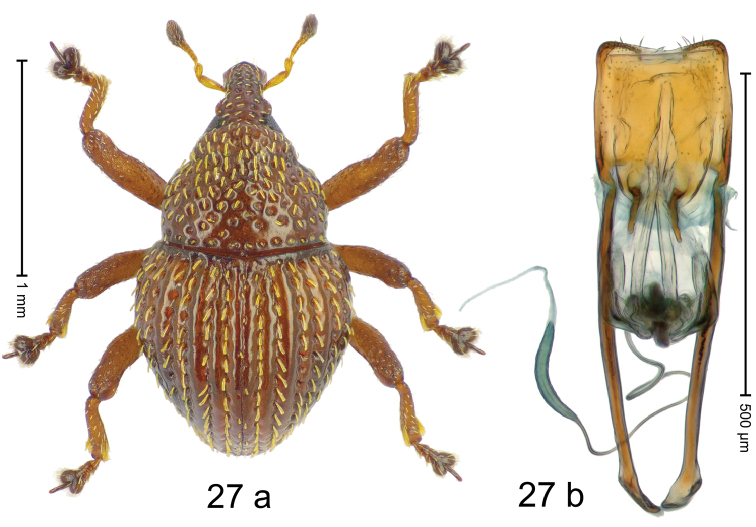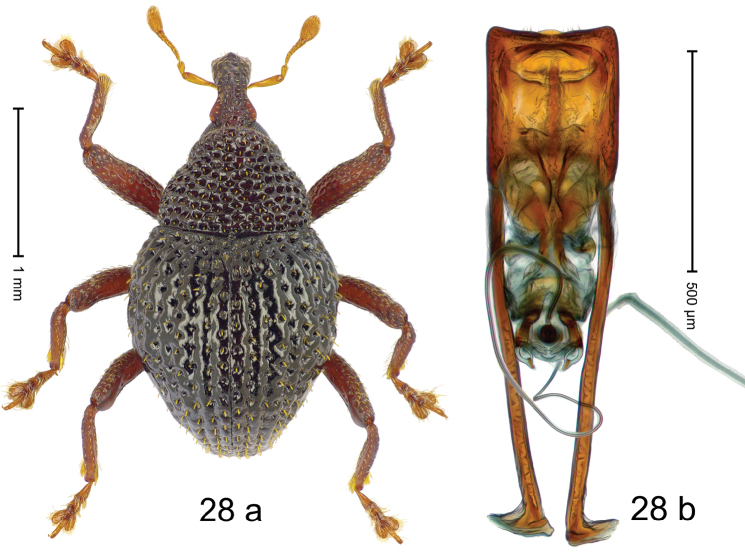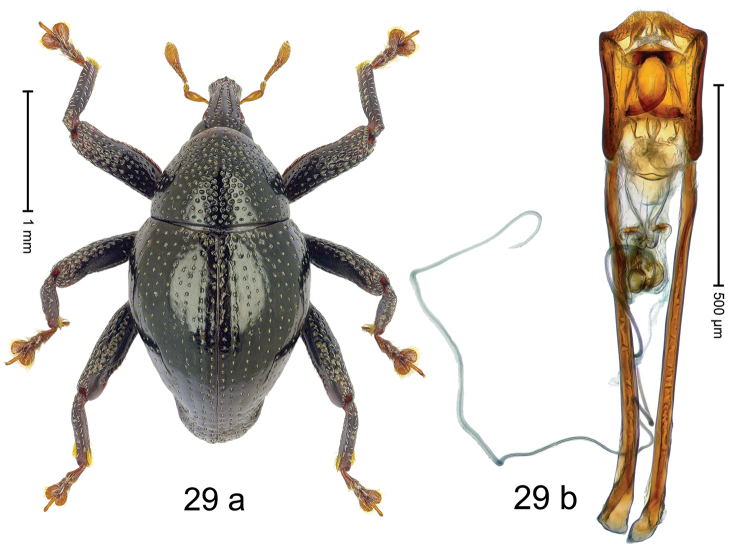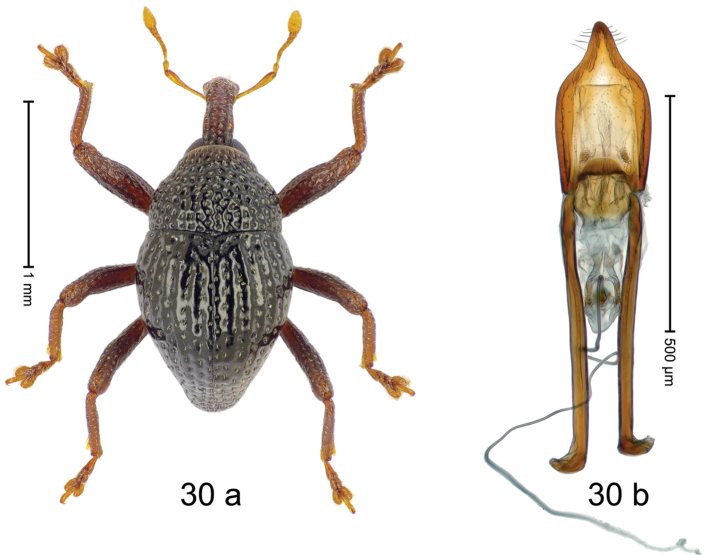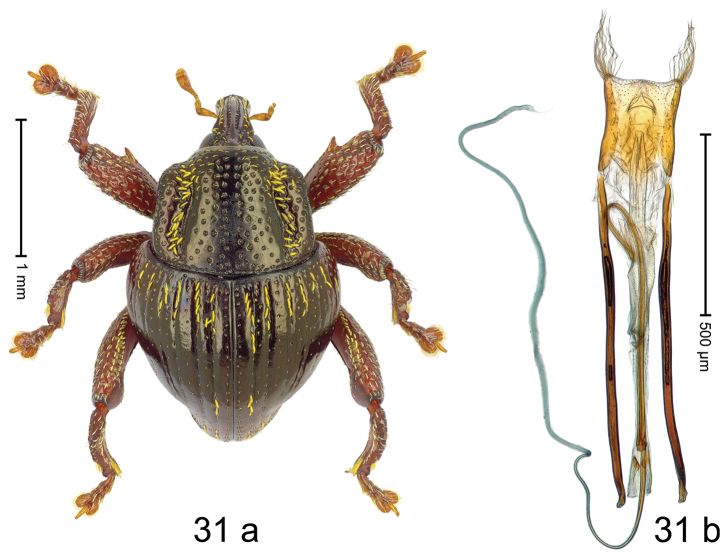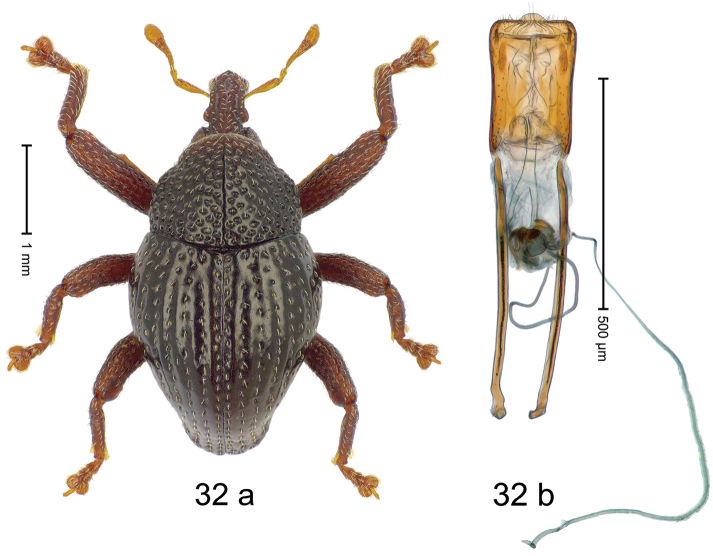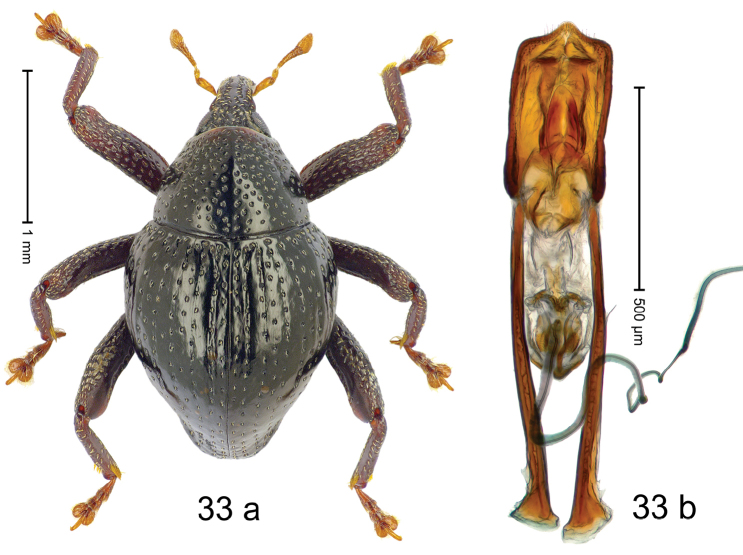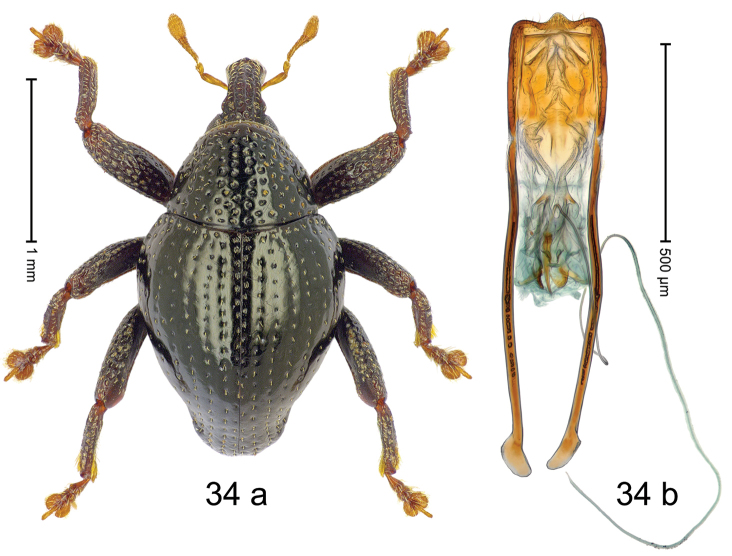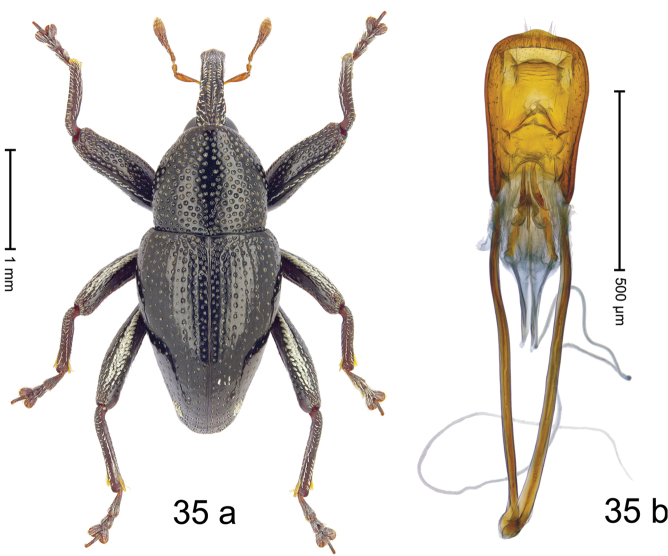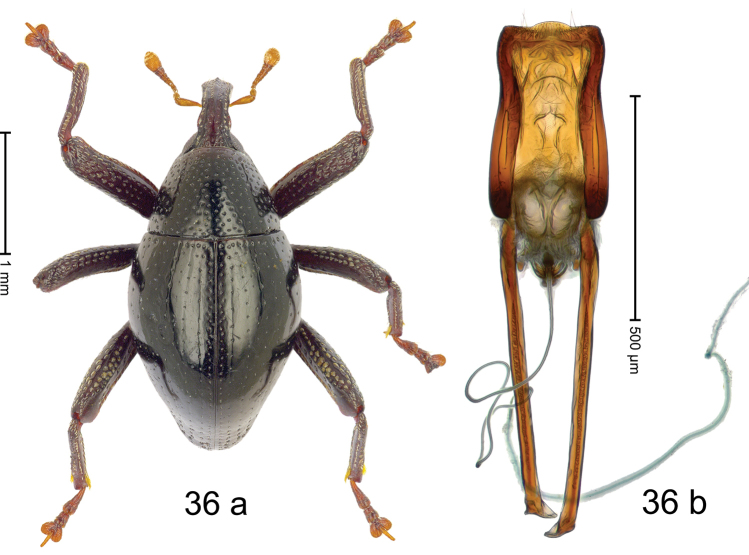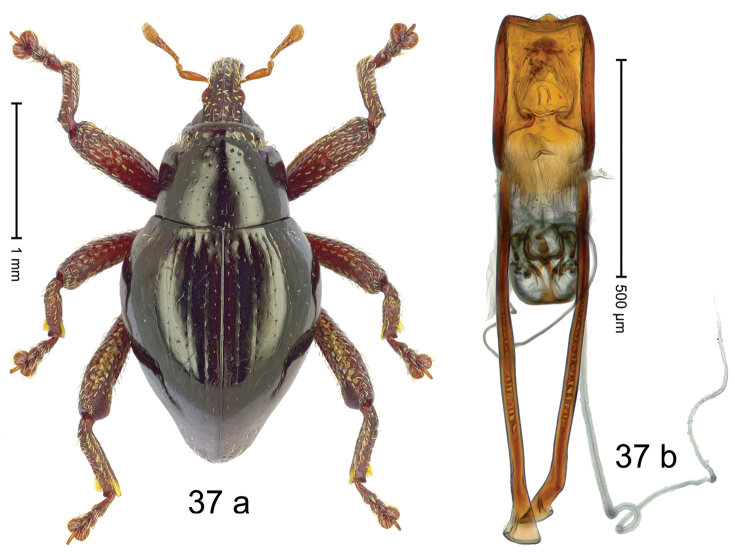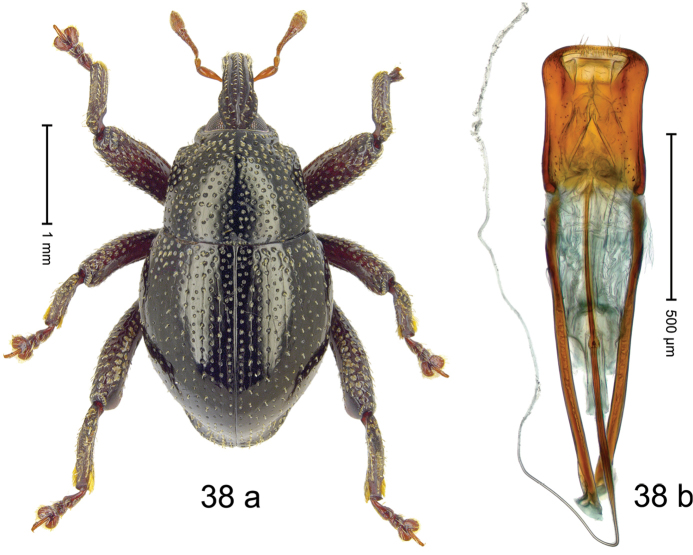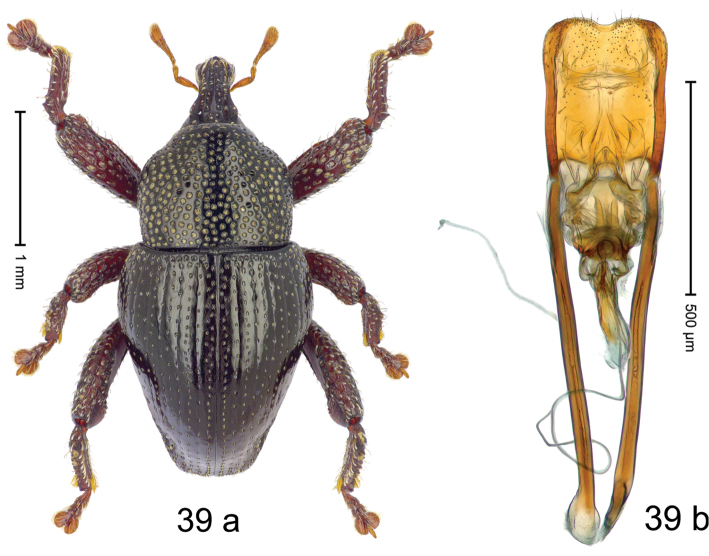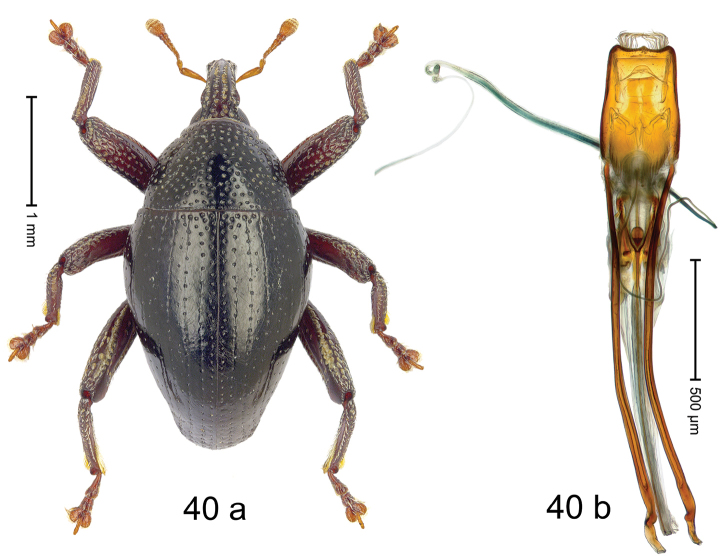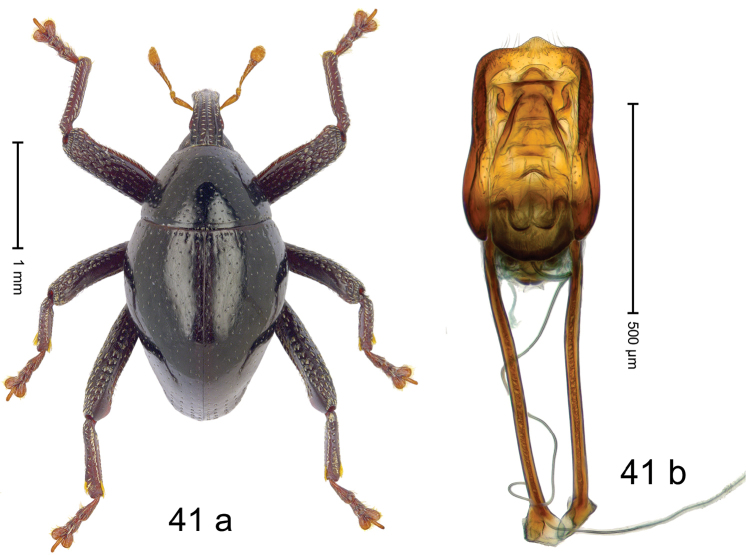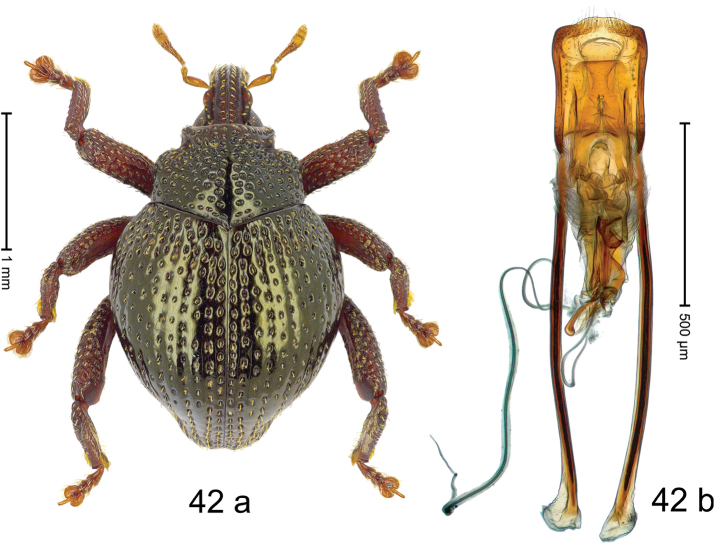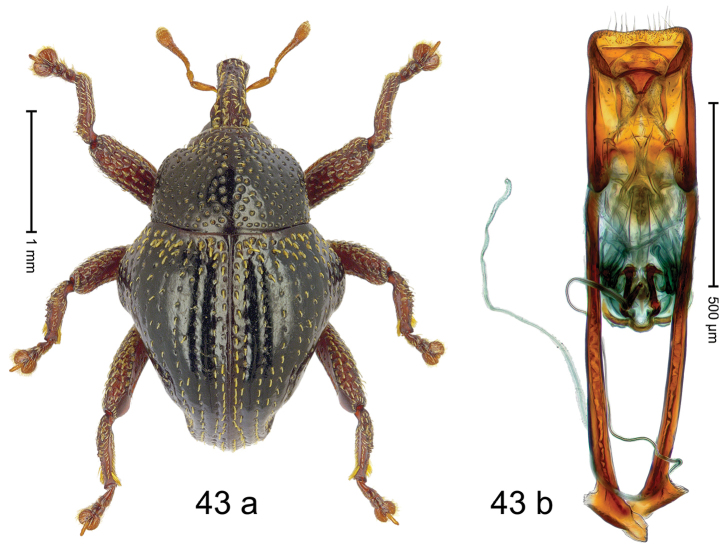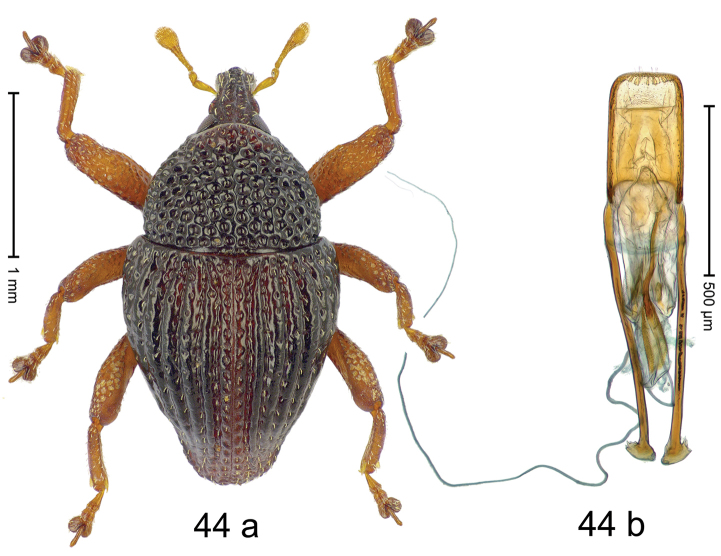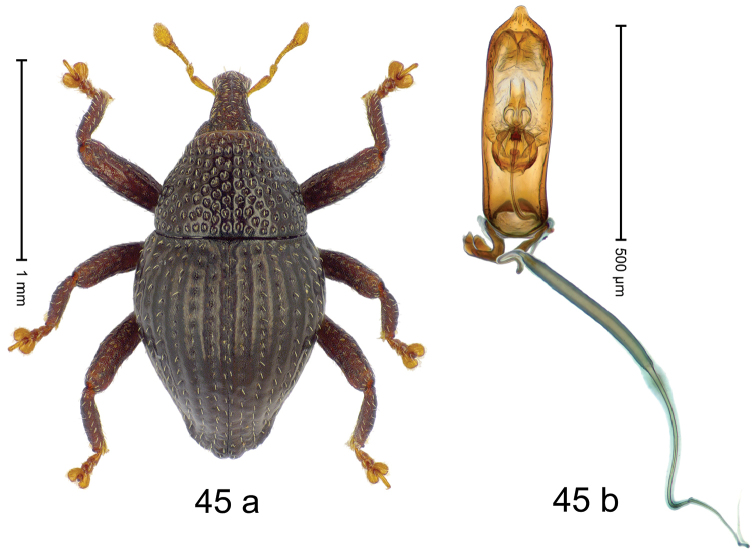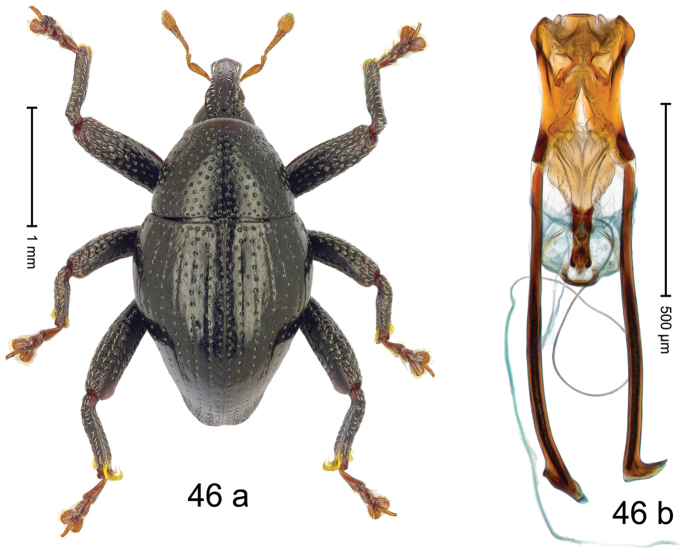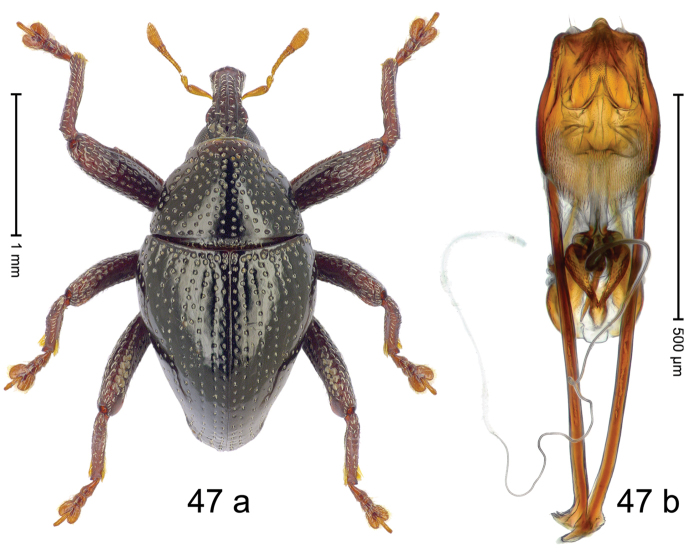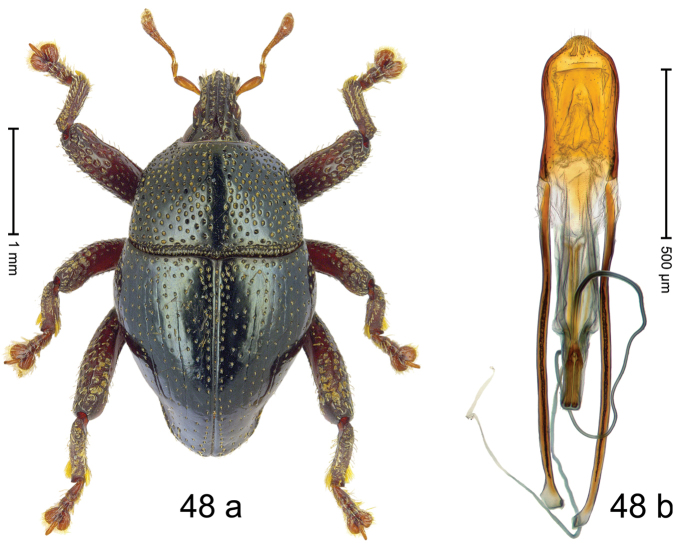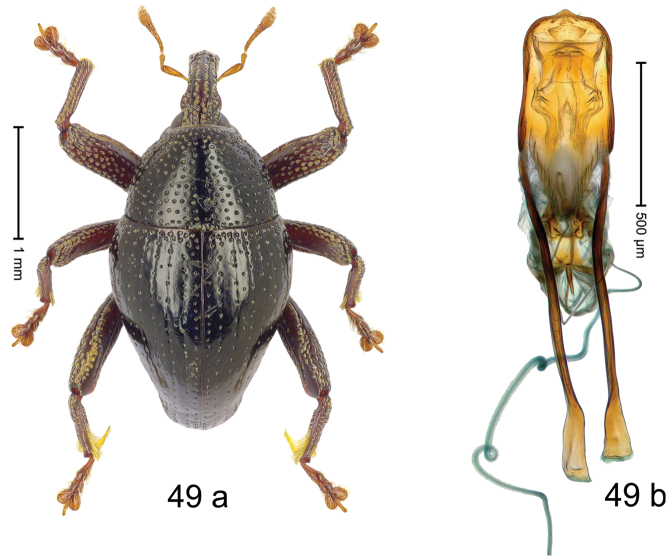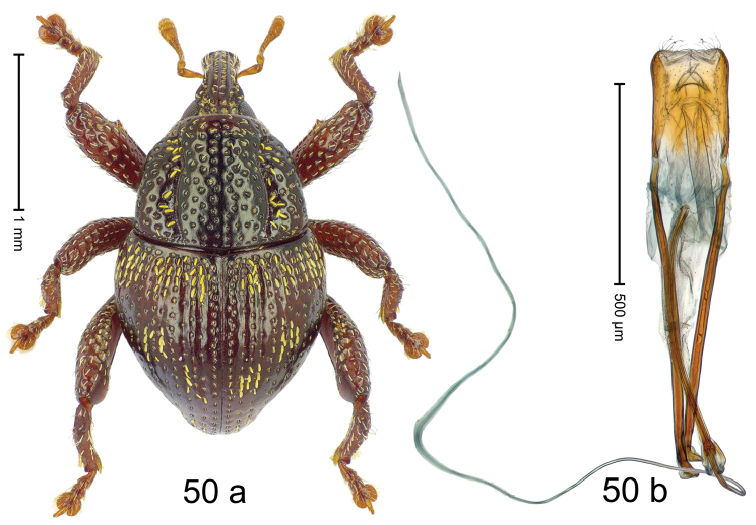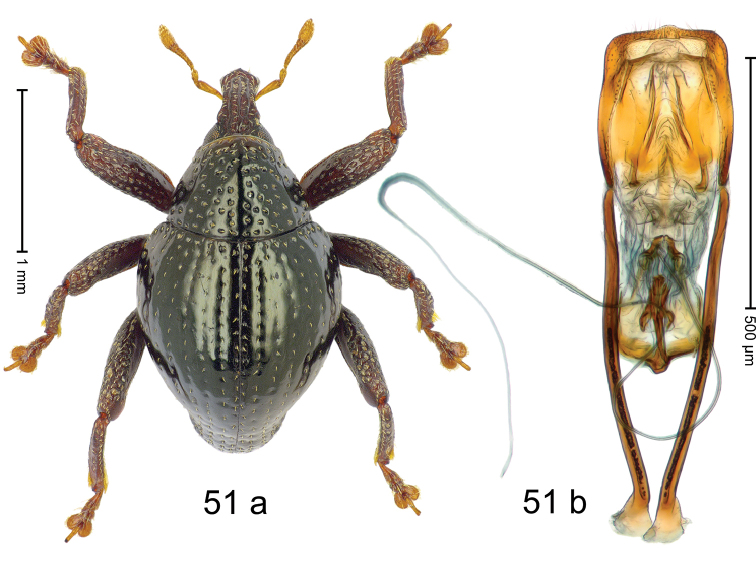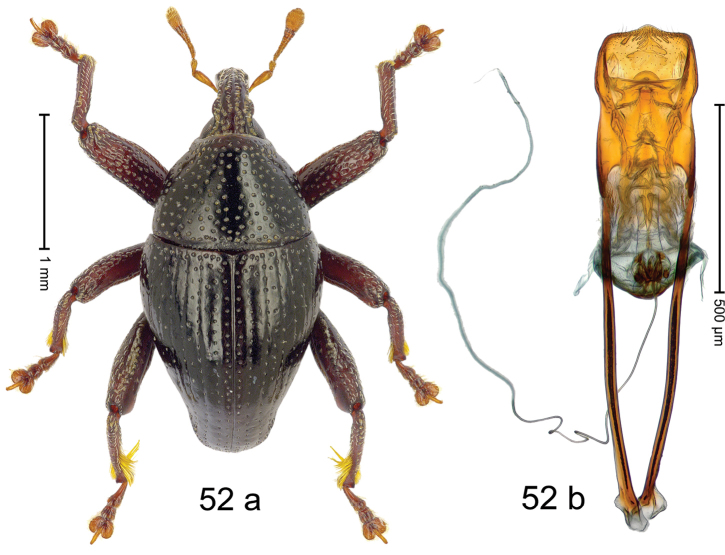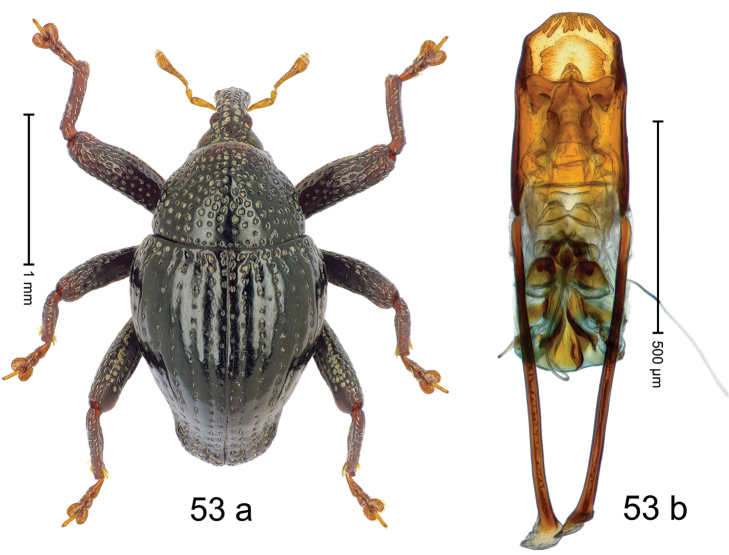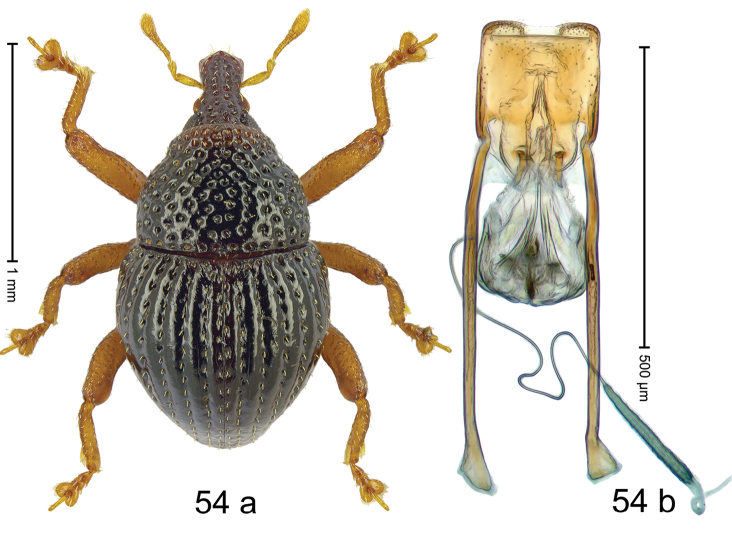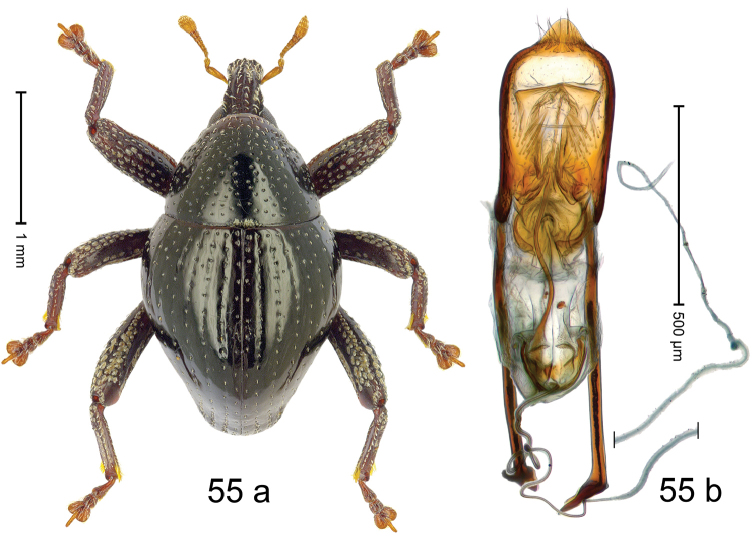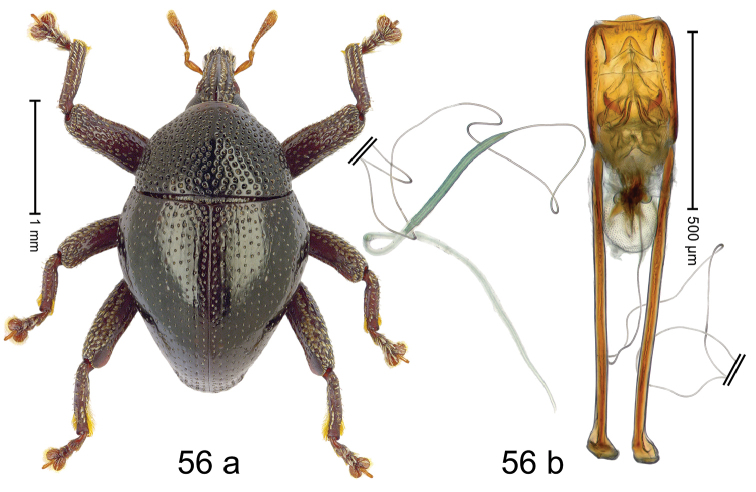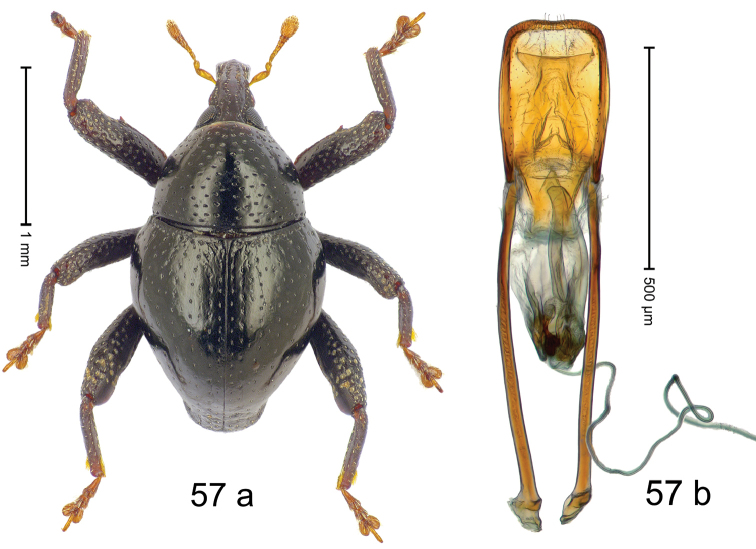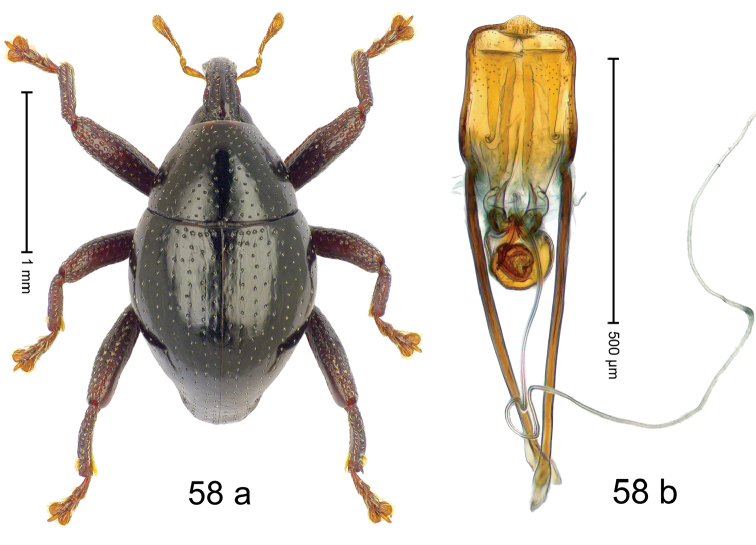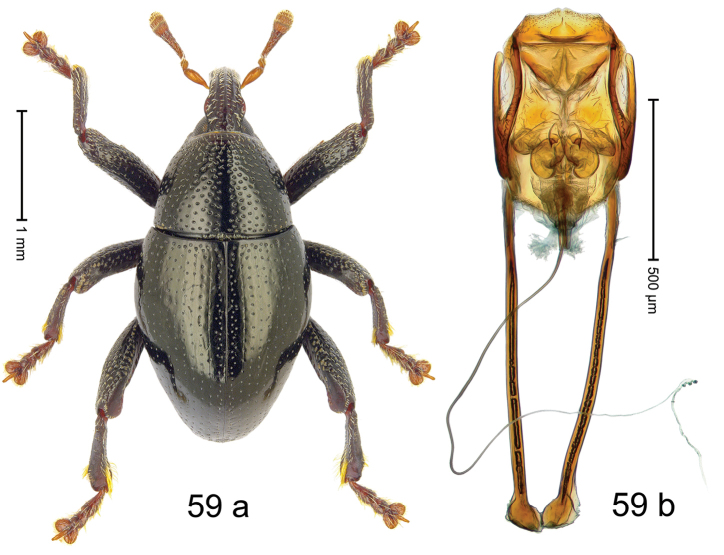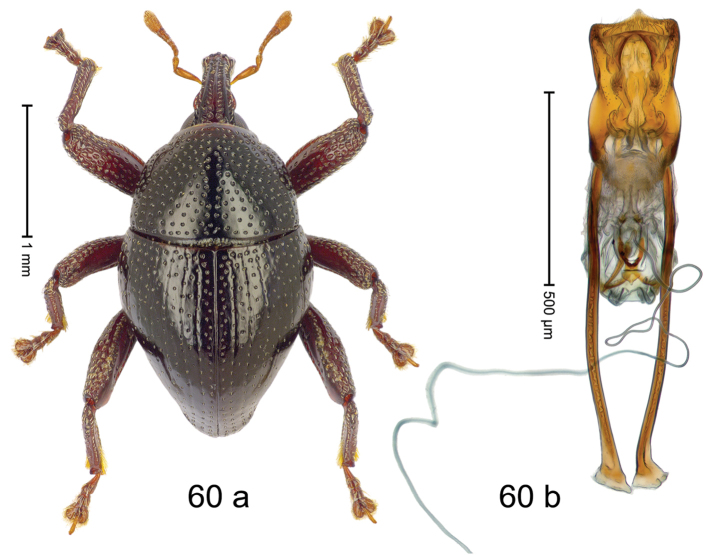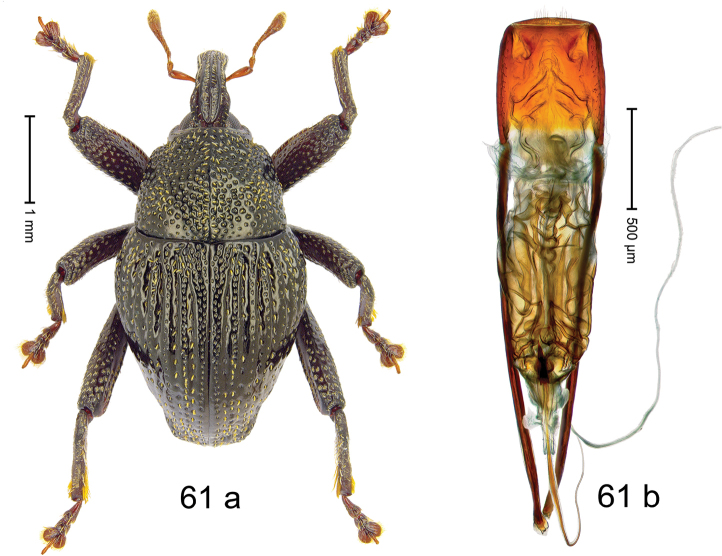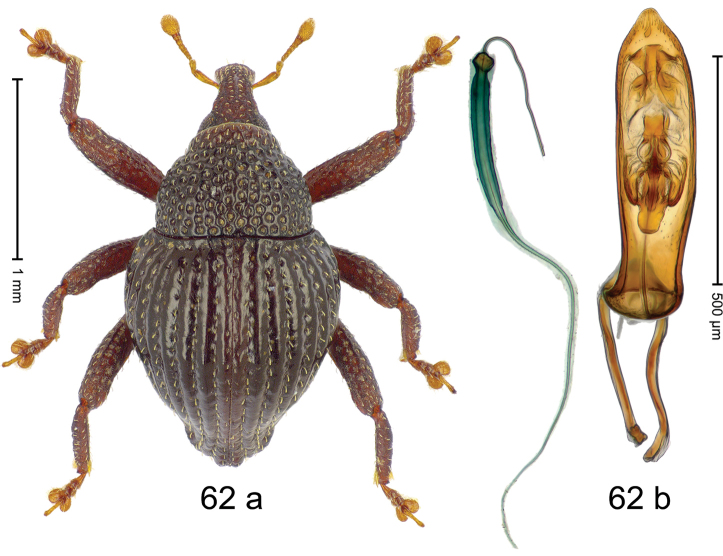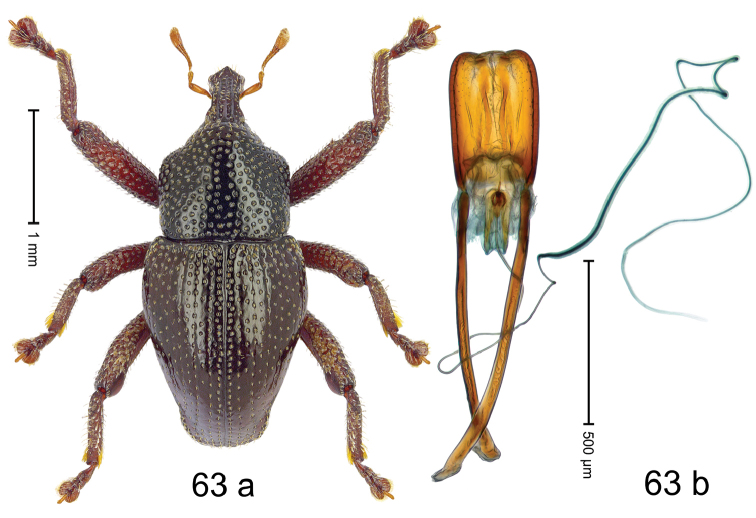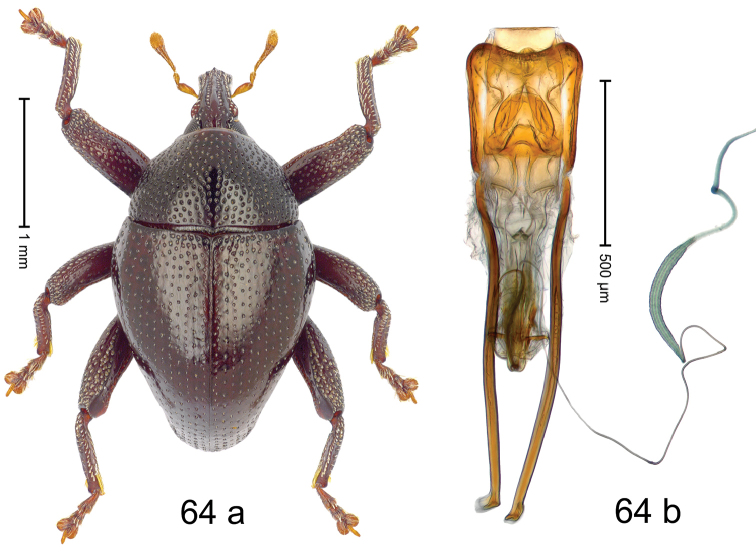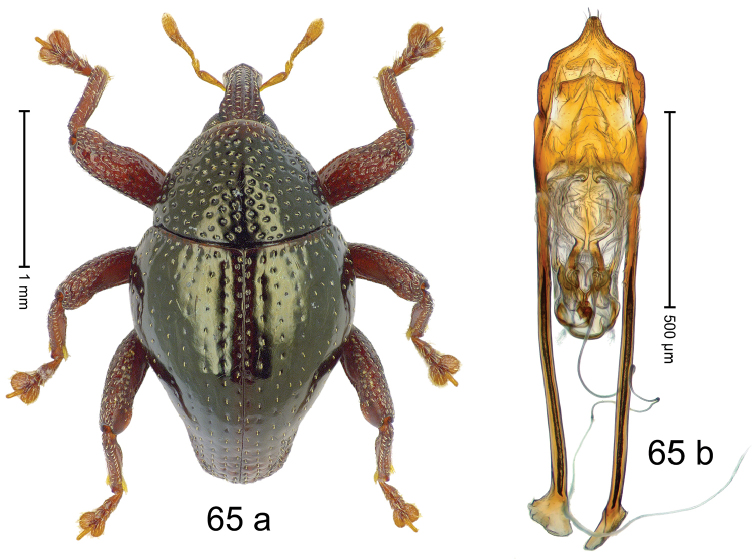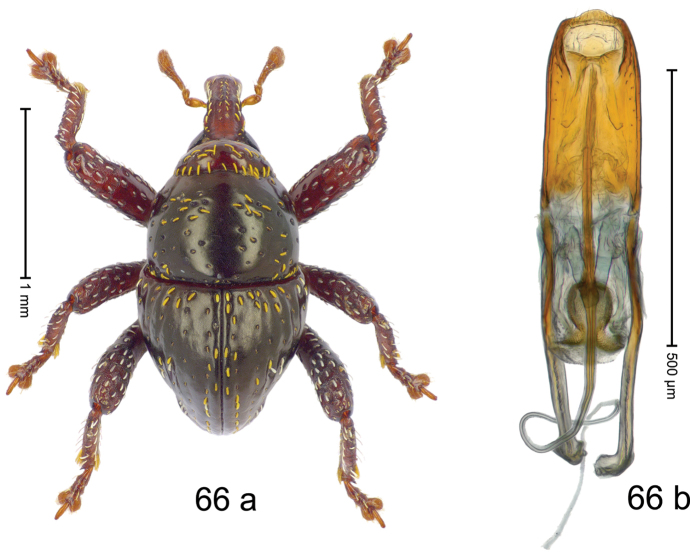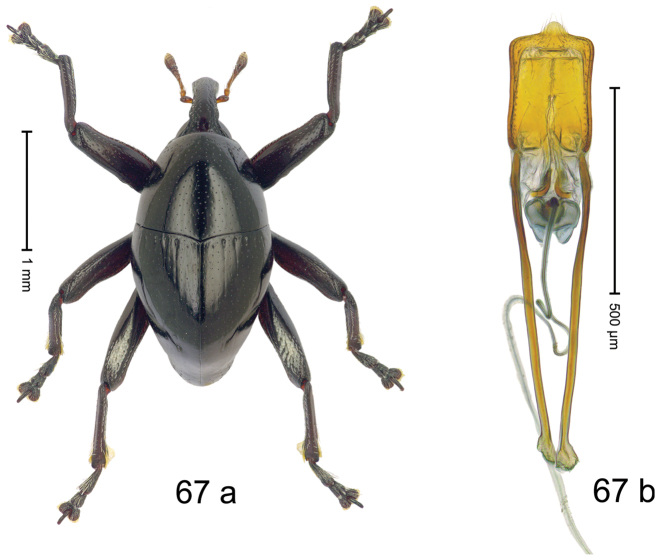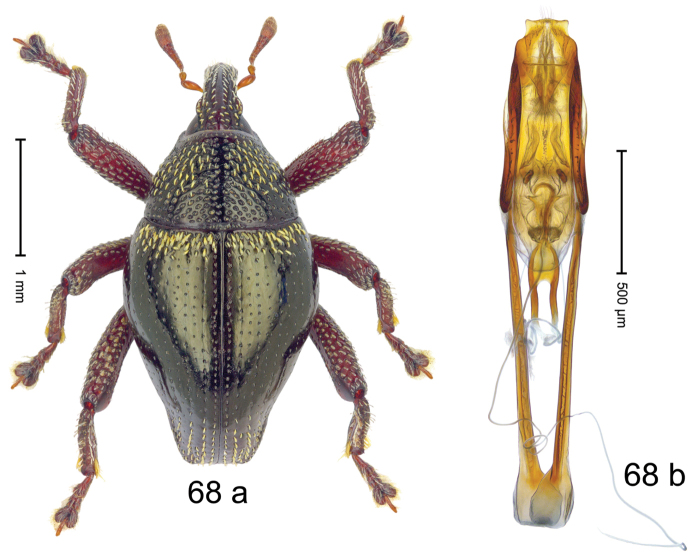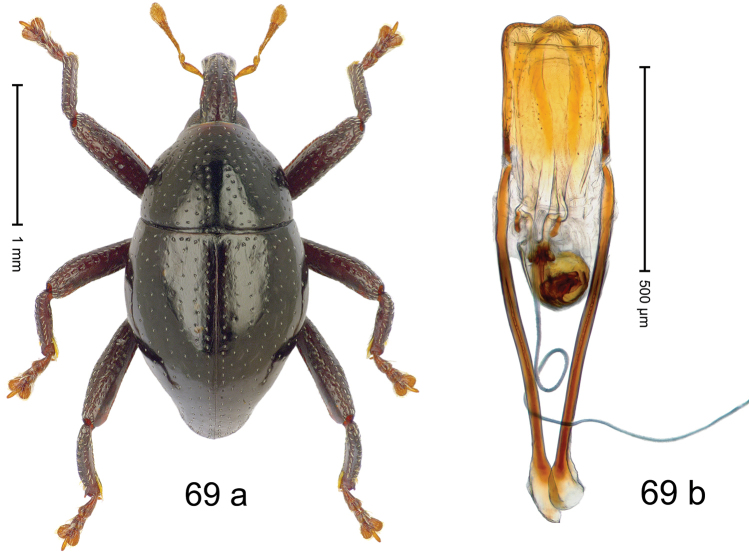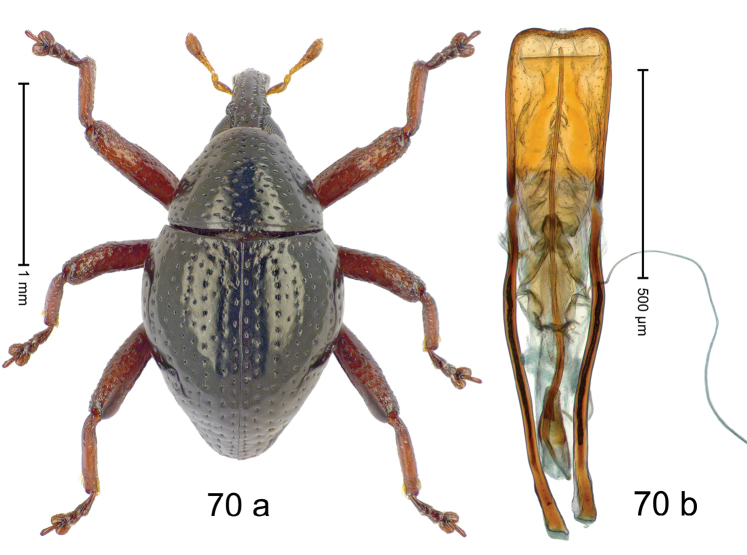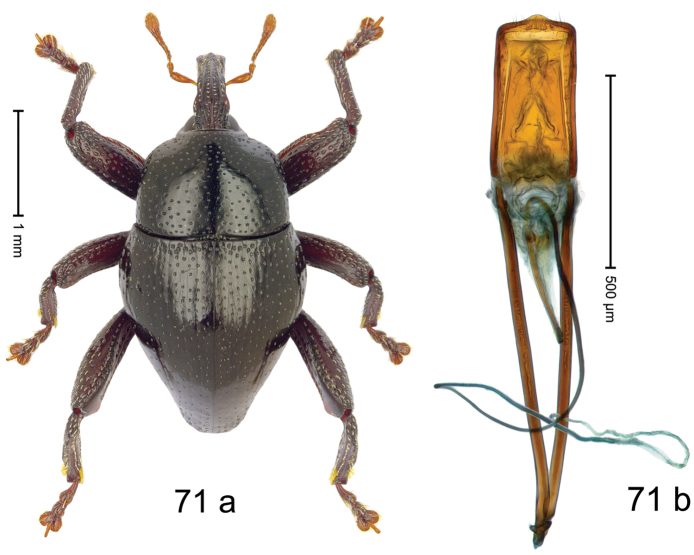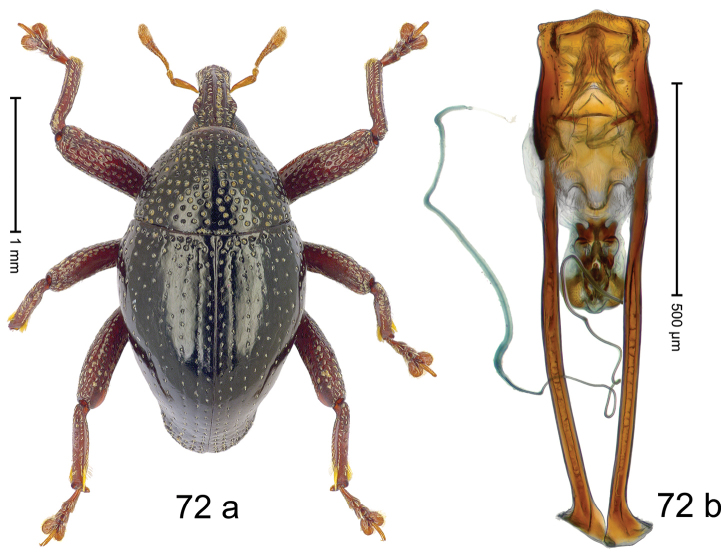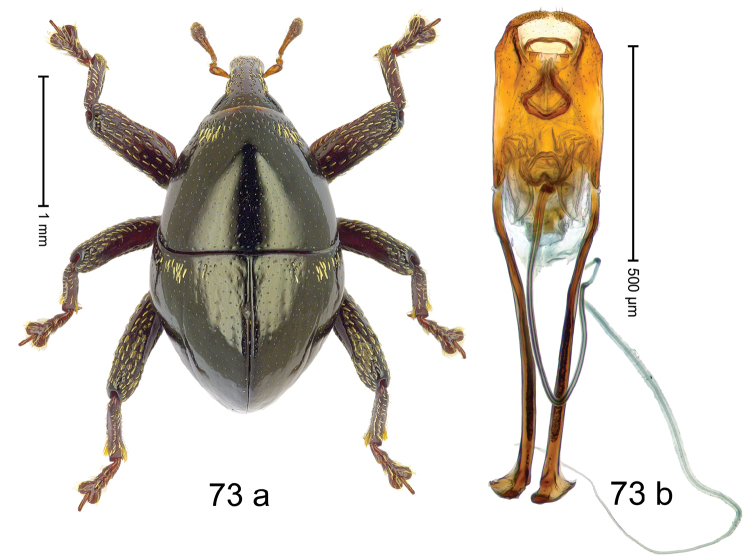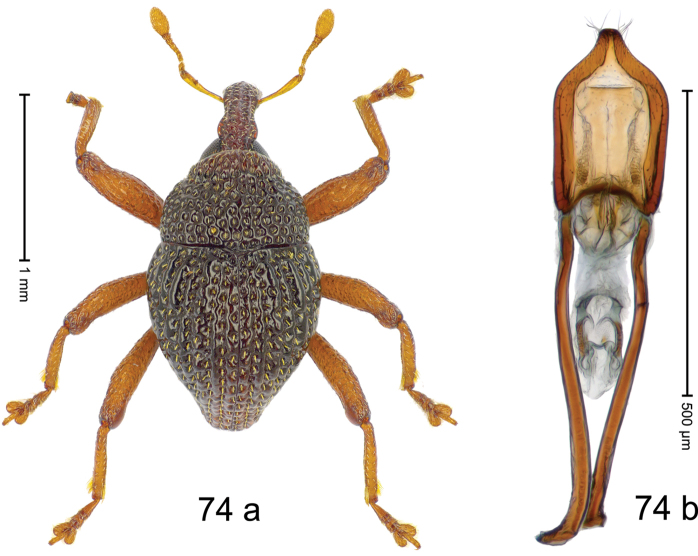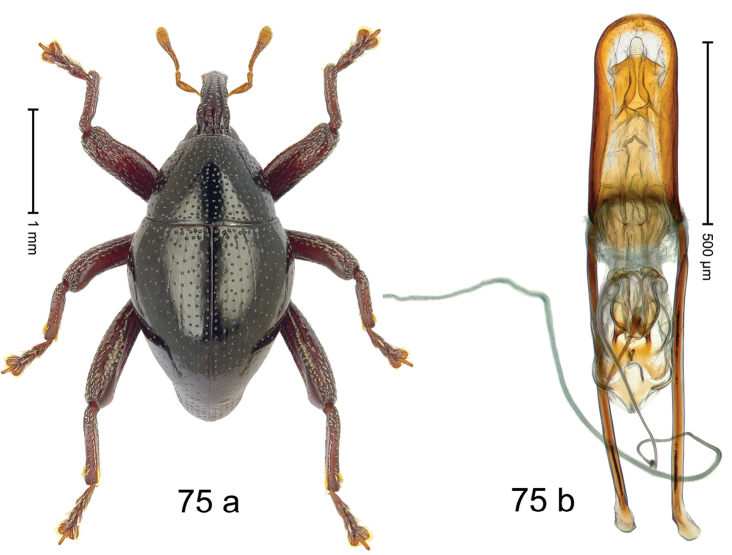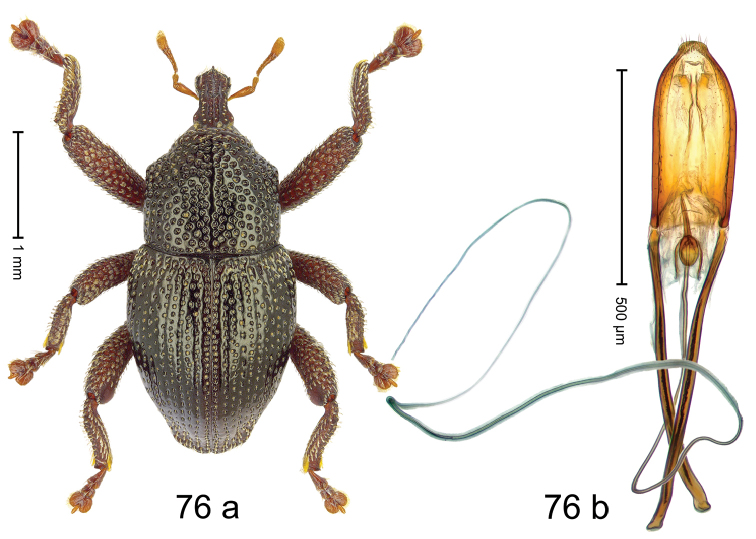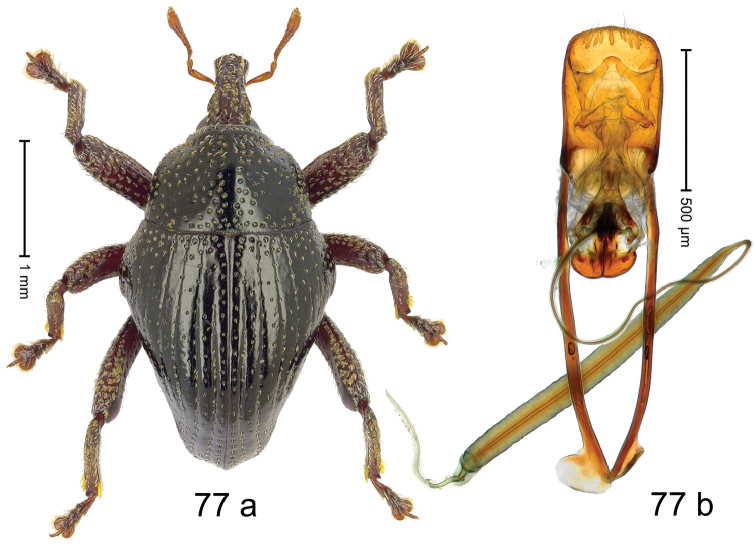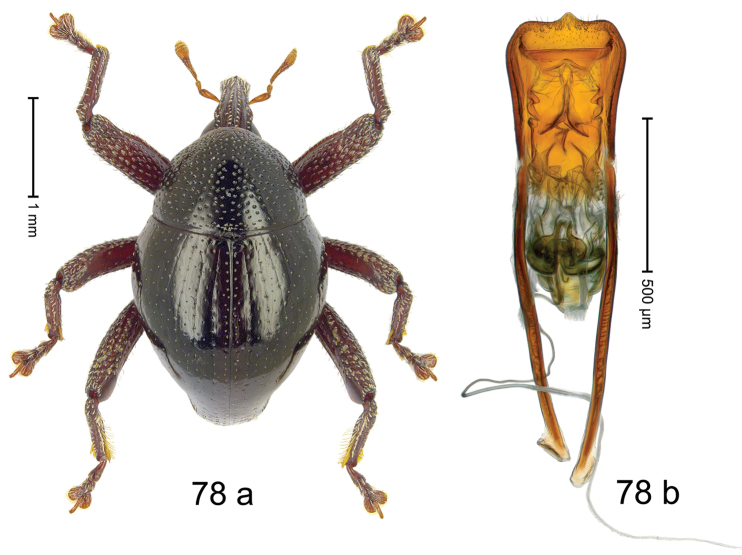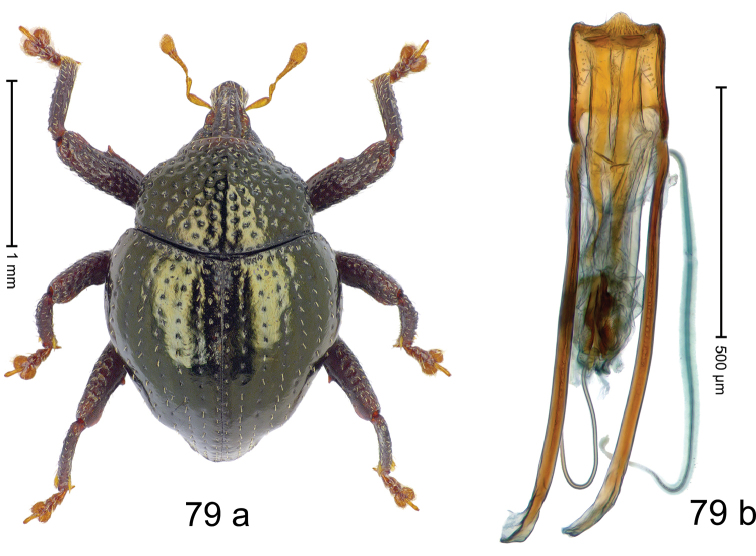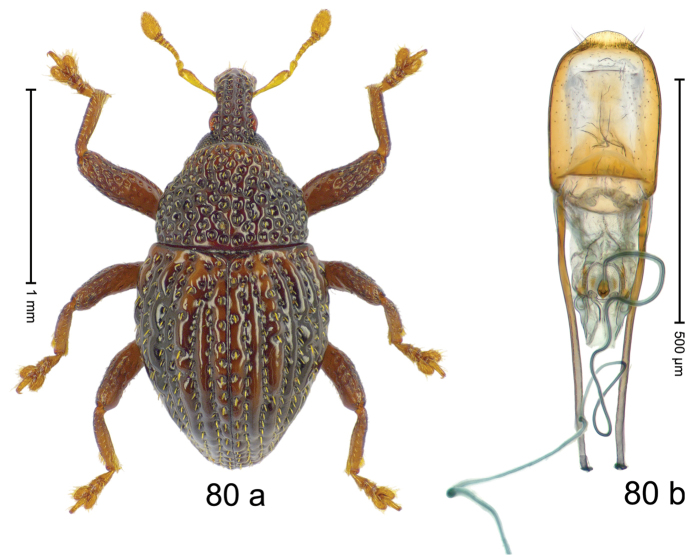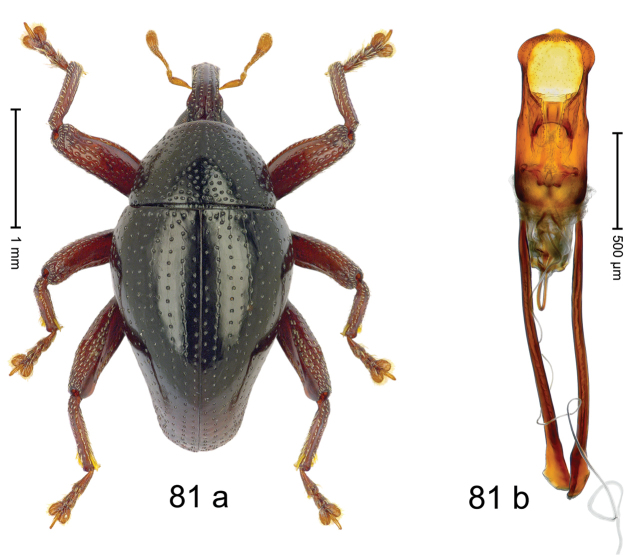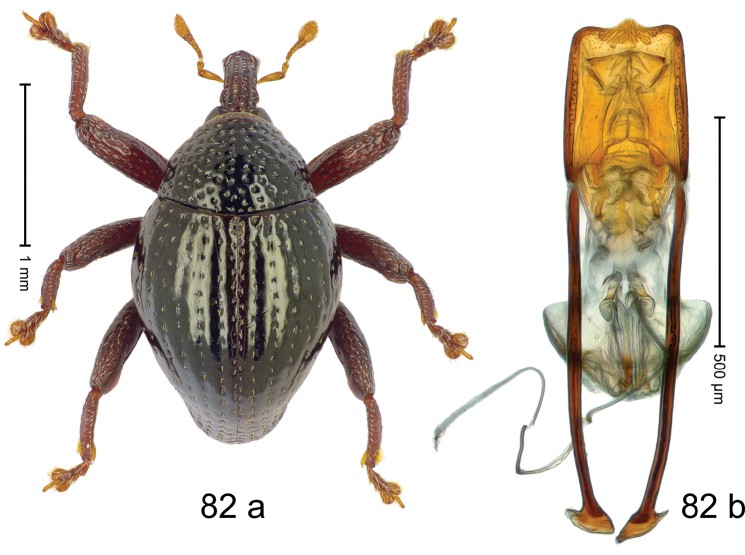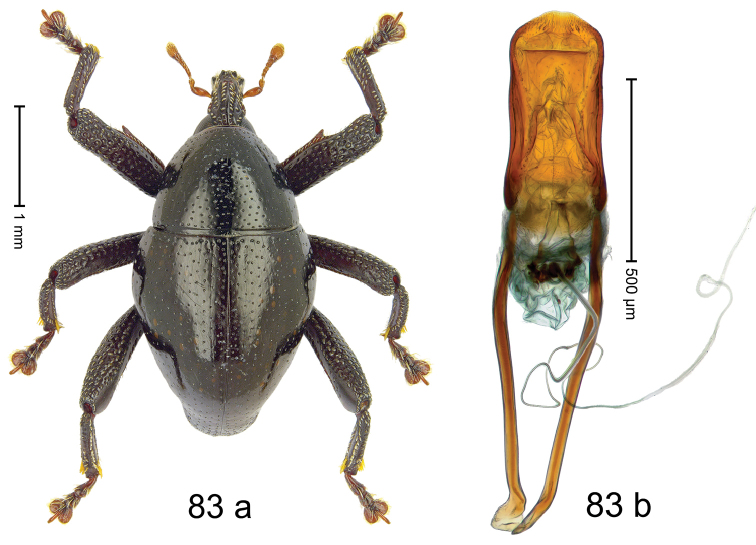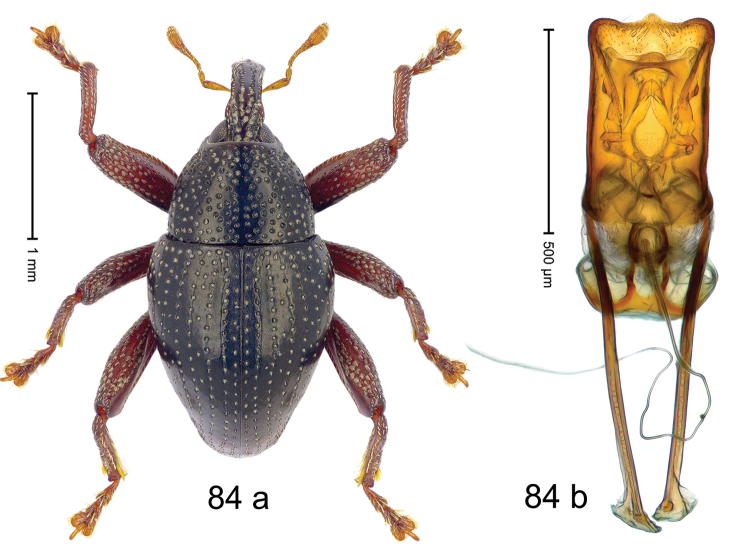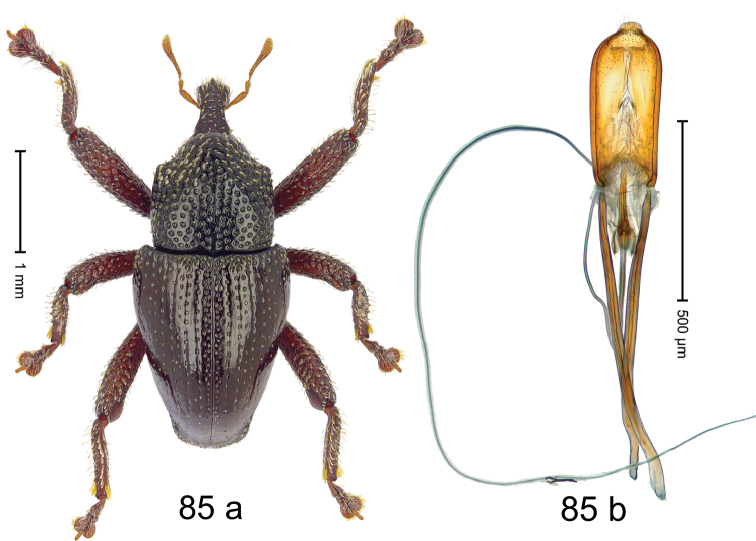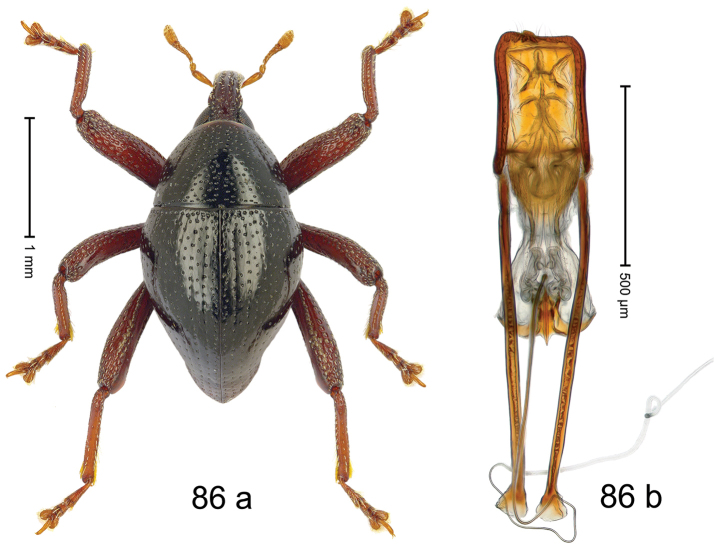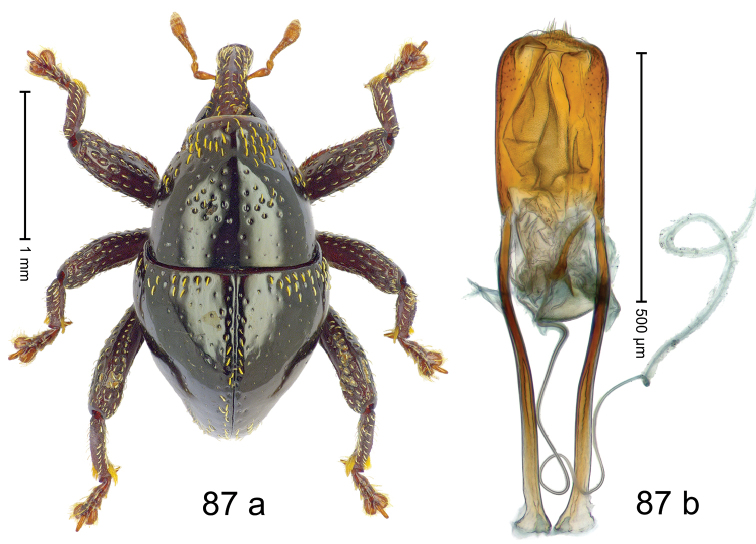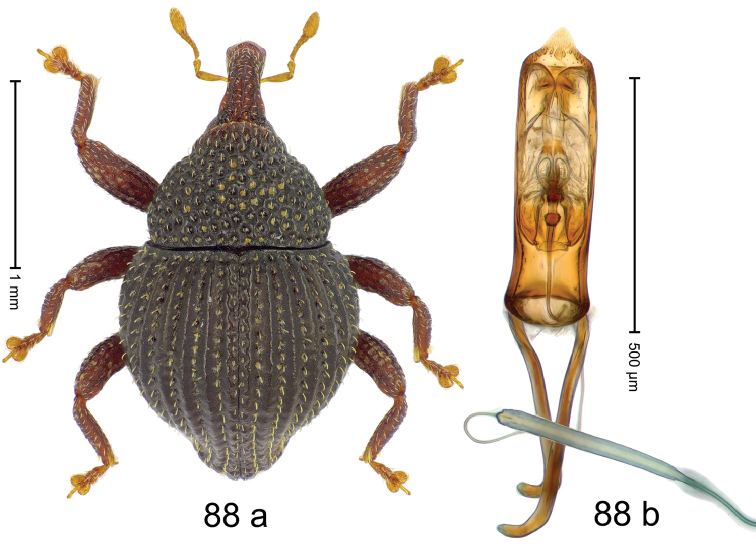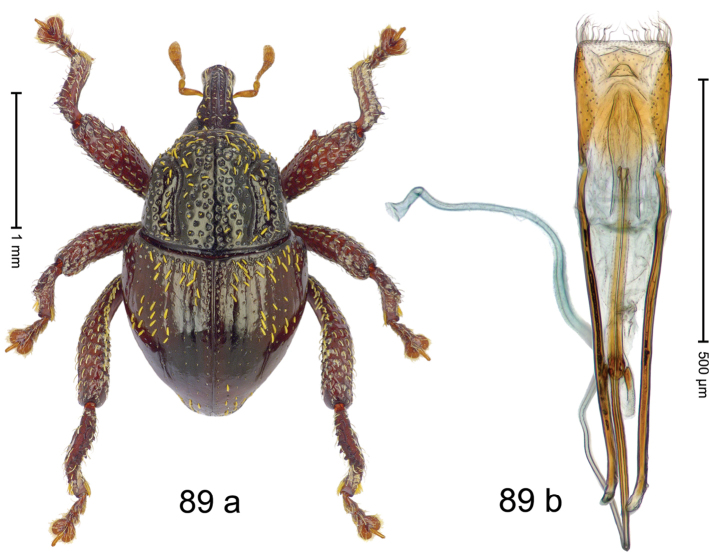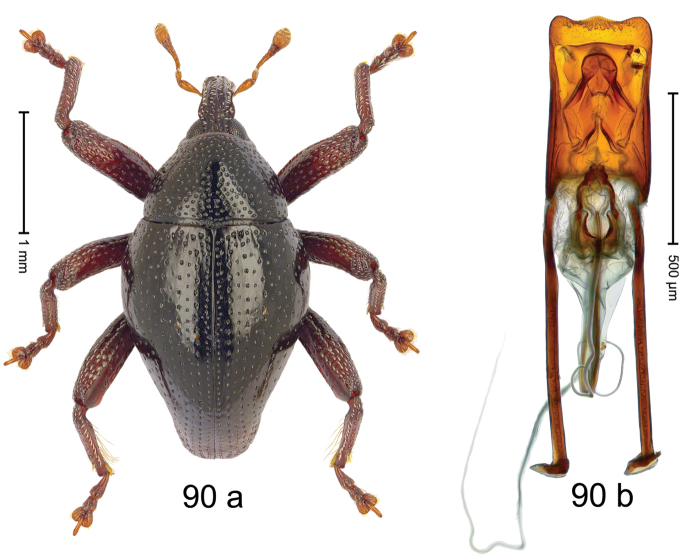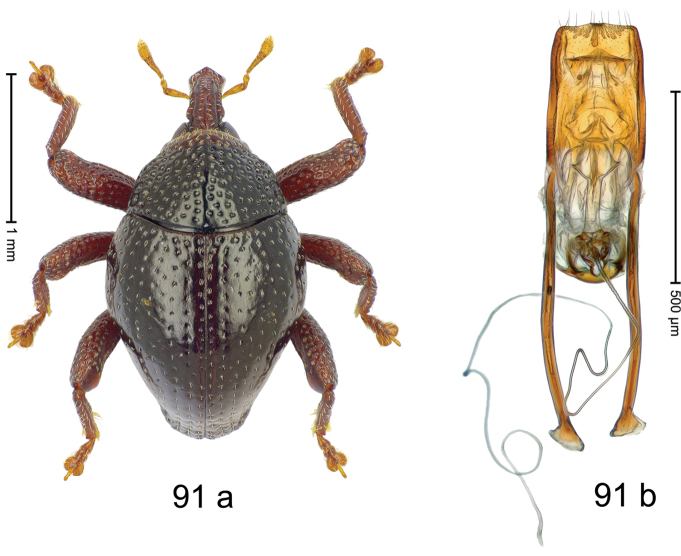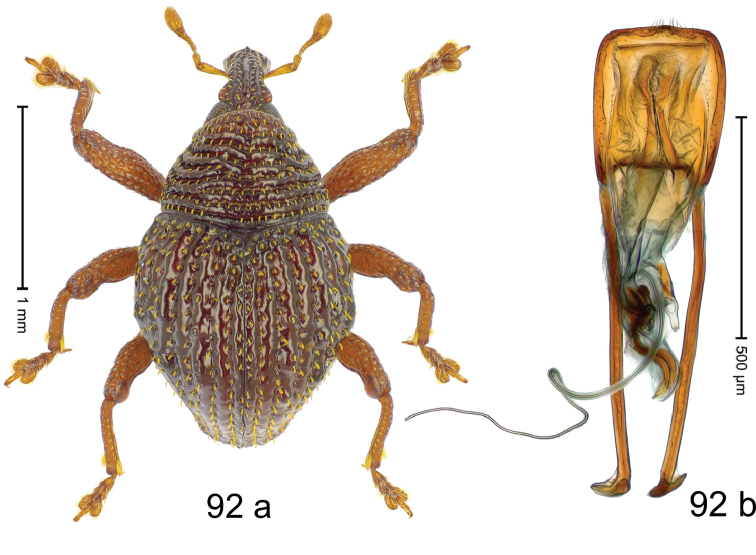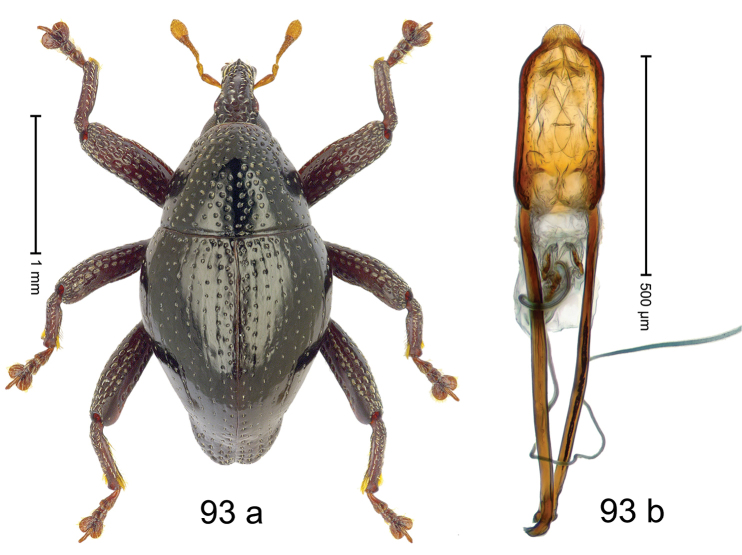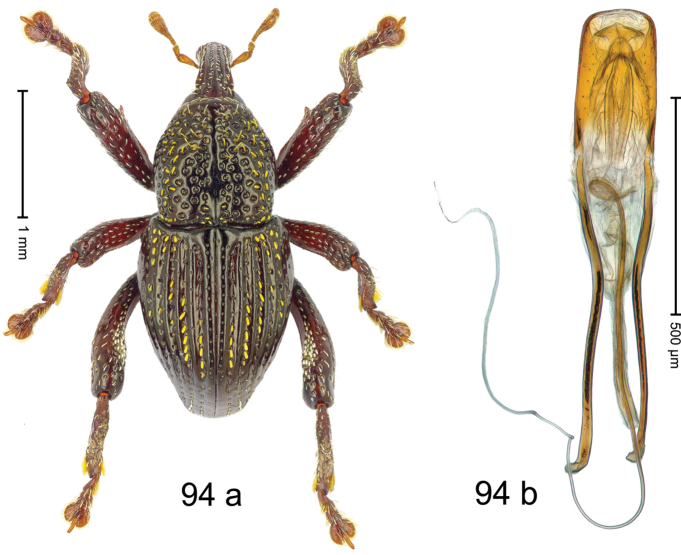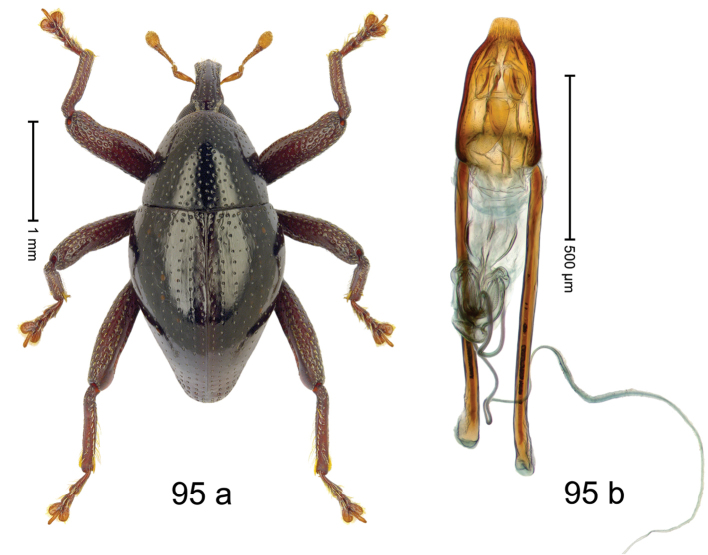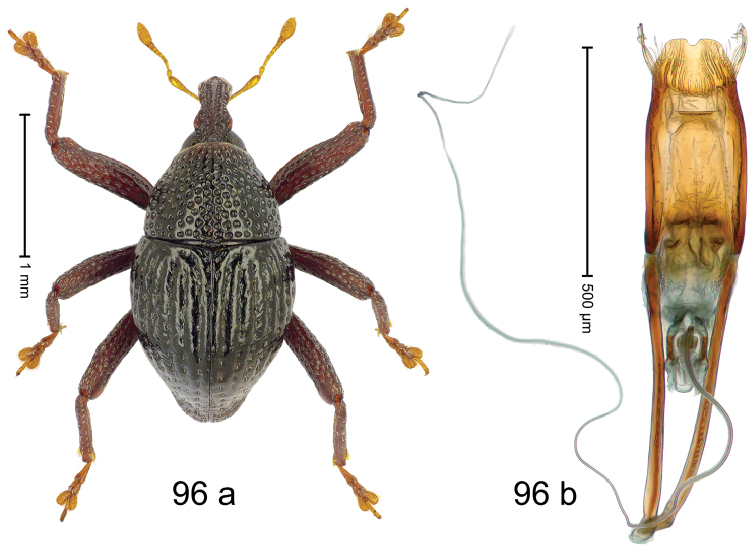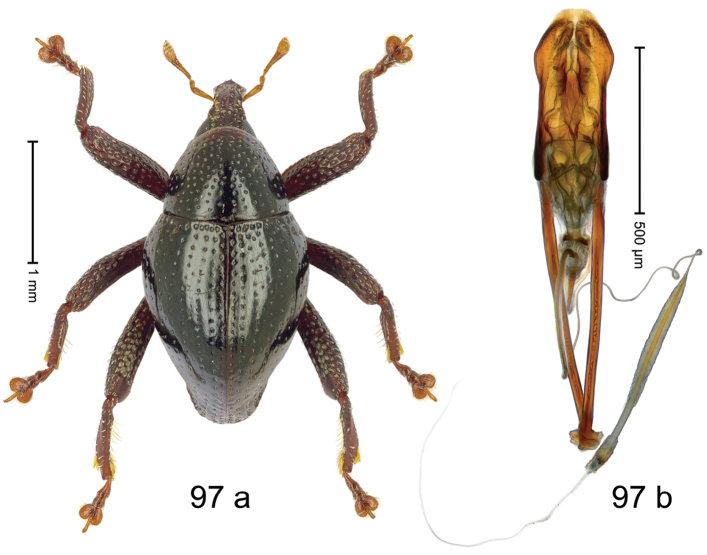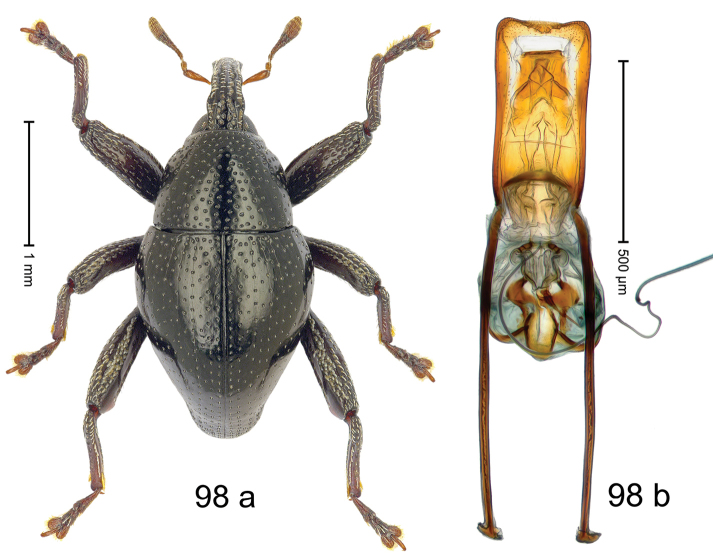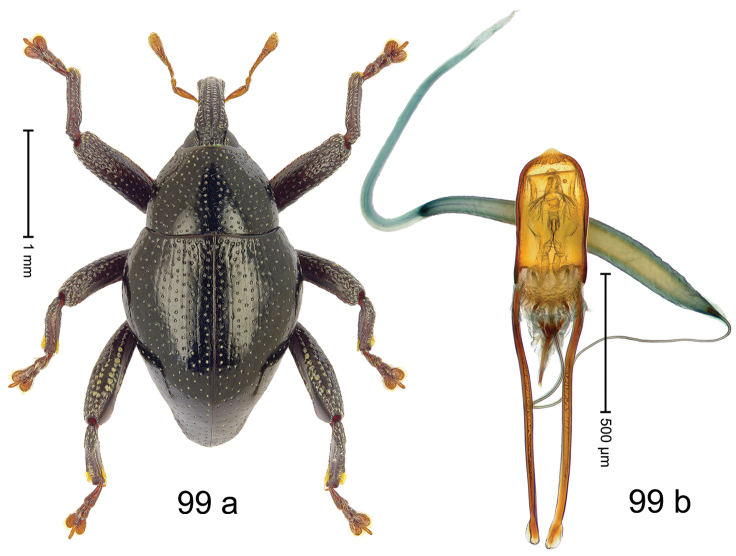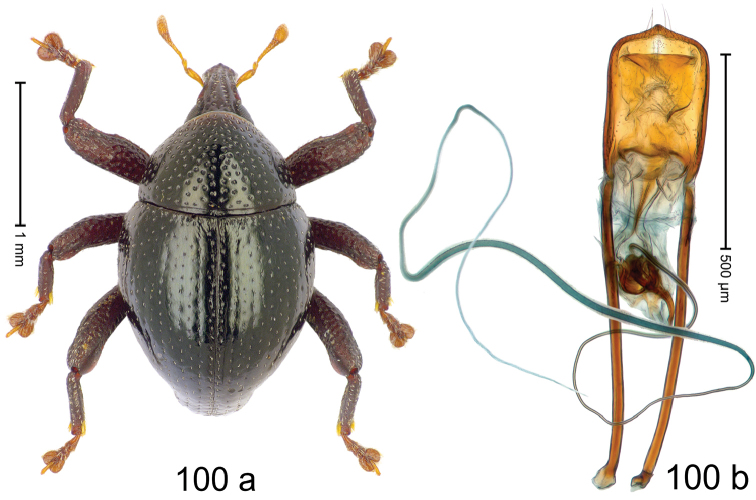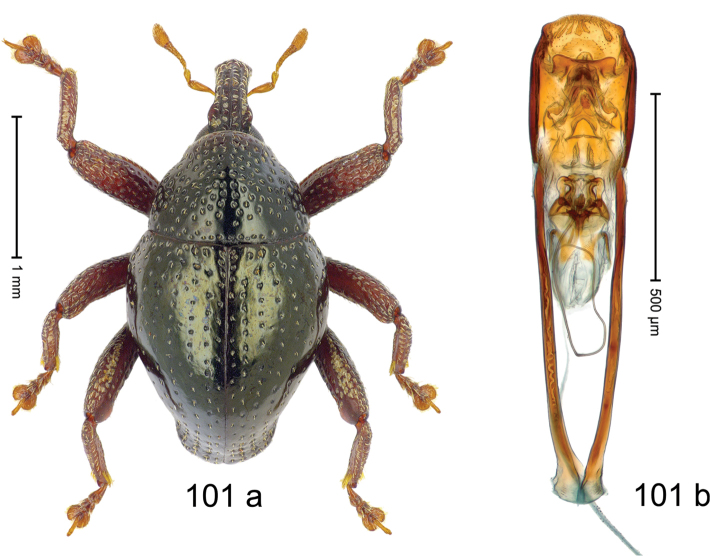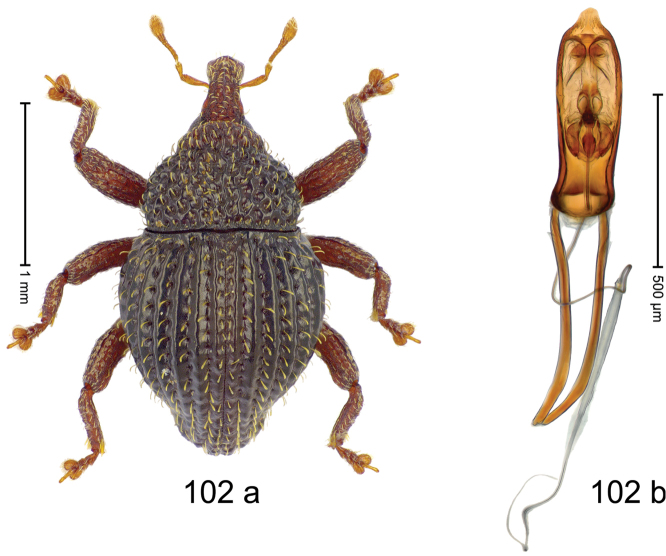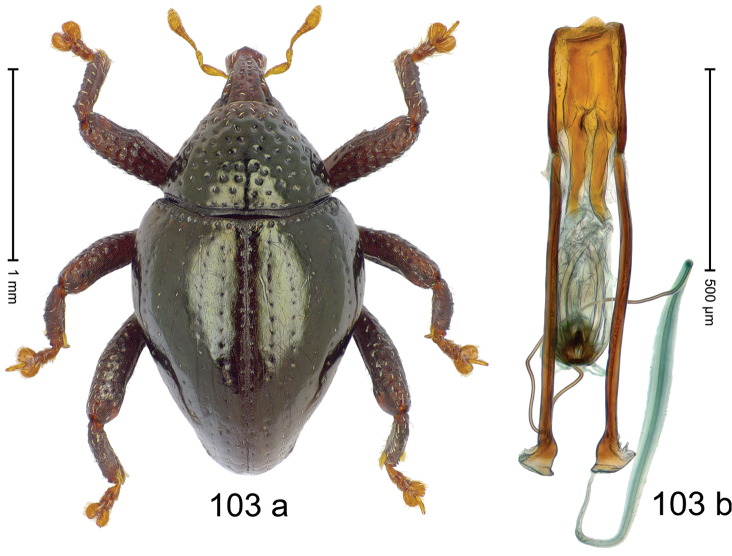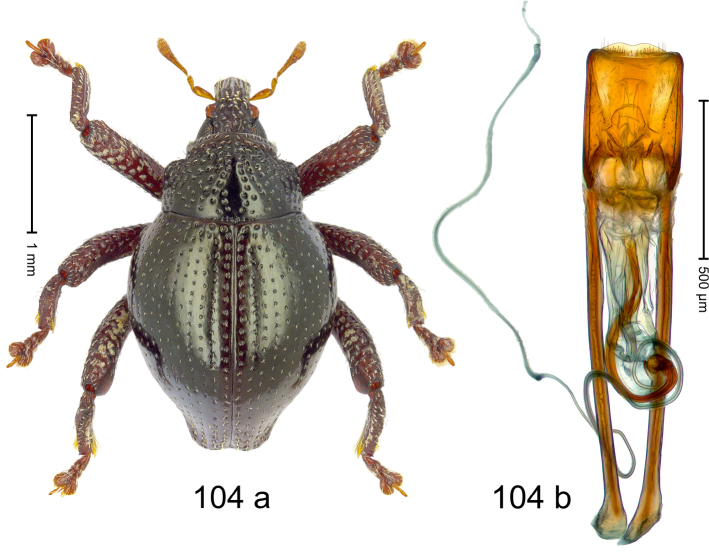Abstract Abstract
The genus Trigonopterus Fauvel, 1862 is highly diverse in Melanesia, the Moluccas, and the Sunda Islands. Only one species, Trigonopterusfulvicornis (Pascoe, 1885) was so far recorded from Sulawesi. Based on focused field-work the fauna from Sulawesi and nearby islands is here revised. We redescribe T.allotopus Riedel newly recorded for Sulawesi and describe an additional 103 new species: T.abnormissp. n., T.adspersussp. n., T.ambangensissp. n., T.ampanensissp. n., T.analissp. n., T.arachnobassp. n., T.armipessp. n., T.artemissp. n., T.asterixsp. n., T.barbipessp. n., T.bonthainensissp. n., T.carinirostrissp. n., T.castaneipennissp. n., T.celebensissp. n., T.cirripessp. n., T.collarissp. n., T.costatulussp. n., T.curvipessp. n., T.crenulatussp. n., T.crickisp. n., T.darwinisp. n., T.ejaculatoriussp. n., T.fuscipessp. n., T.gracilipessp. n., T.hebertisp. n., T.hirsutussp. n., T.humilissp. n., T.hypocritasp. n., T.idefixsp. n., T.impressicollissp. n., T.incendiumsp. n., T.incognitussp. n., T.indigenussp. n., T.inhonestussp. n., T.invalidussp. n., T.jasminaesp. n., T.klabatensissp. n., T.kolakensissp. n., T.kotamobagensissp. n., T.laevigatussp. n., T.lamprossp. n., T.latipennissp. n., T.lompobattangensissp. n., T.luwukensissp. n., T.mahawuensissp. n., T.manadensissp. n., T.mangkutanensissp. n., T.matalibaruensissp. n., T.mesaisp. n., T.minahassaesp. n., T.moatensissp. n., T.modoindingensissp. n., T.nanussp. n., T.nitidulussp. n., T.obelixsp. n., T.ovalipunctatussp. n., T.ovatulussp. n., T.pagaranganensissp. n., T.palopensissp. n., T.paracollarissp. n., T.paupersp. n., T.pendolensissp. n., T.posoensissp. n., T.prismaesp. n., T.procurtussp. n., T.pseudallotopussp. n., T.pseudanalis, sp. n., T.pseudovatulussp. n., T.pseudovalipunctatussp. n., T.pseudofulvicornissp. n., T.pseudomanadensissp. n., T.pseudosimulanssp. n., T.pumilussp. n., T.rantepaosp. n., T.reticulatussp. n., T.rhombiformissp. n., T.rotundatussp. n., T.rotundulussp. n., T.rudissp. n., T.rufipessp. n., T.sampunensissp. n., T.sampuragensissp. n., T.satyrussp. n., T.scabripessp. n., T.scaphiformissp. n., T.scitulussp. n., T.selayarensissp. n., T.serripessp. n., T.seticnemissp. n., T.silvicolasp. n., T.squalidulussp. n., T.sulawesiensissp. n., T.suturatussp. n., T.tatorensissp. n., T.tenuipessp. n., T.tomohonensissp. n., T.torajasp. n., T.vicinussp. n., T.viduussp. n., T.volcanorumsp. n., T.wangiwangiensissp. n., T.watsonisp. n., and T.yodasp. n. All new species are authored by the taxonomist-in-charge, Alexander Riedel.
Keywords: Celebes, Coleoptera , conservation, cox1, Cryptorhynchinae , Curculionidae , DNA barcoding, endemism, hyperdiverse, integrative taxonomy, morphology, Southeast Asia, turbo-taxonomy, Wallacea, weevils
Introduction
Trigonopterus Fauvel, a genus of flightless weevils placed in the subfamily Cryptorhynchinae of Curculionidae (Alonso-Zarazaga and Lyal 1999) currently comprises 341 species, herein brought to 444 species. It ranges from Sumatra to Samoa, and from the Philippines to Northern Australia. Its center of origin and presumably its highest diversity is in the Papuan region (Riedel et al. 2013b; Riedel et al. 2014; Tänzler et al. 2012; Tänzler et al. 2016; Toussaint et al. 2017; unpublished data). The Sunda Islands further west harbor a less diverse fauna of Trigonopterus; still, 99 described species have been recorded from Sumatra, Borneo, Java, and the Lesser Sunda Islands (Riedel et al. 2014). The island of Sulawesi formerly known as “Celebes” is located between these two regions (Lohman et al. 2011; Stelbrink et al. 2012), and a rich fauna can be expected from this geographic position (Whitten et al. 2012). However, only one single species, T.fulvicornis (Pascoe, 1885) has been described from Sulawesi to date (Riedel 2011). Our own field-work soon revealed this pattern as a sampling artefact and numerous undescribed Sulawesi Trigonopterus were included in the phylogeny of Tänzler et al. (2016) [supplement figure S1].
The purpose of the present publication is to make available a substantial number of names of Sulawesi Trigonopterus and to provide a preliminary baseline for their taxonomy. Species of the smaller offshore islands of Selayar and Wangi Wangi are also included.
We follow the previously established approach of accelerated or “fast-track” taxonomy that combines the benefits of molecular and morphological systematics (Riedel et al. 2013a, b, 2014, 2016). The taxonomic information on the genus is bundled on open access websites, i.e., species-ID (http://species-id.net/wiki/Trigonopterus), respectively wikispecies (https://species.wikimedia.org/wiki/Trigonopterus) .
The phylogenetic relationships of the species are indicated by a provisional catalogue of species groups. The name of one existing subgenus (i.e., Mimidotasia Voss) is being used, but we refrain from describing additional subgenera at this point. Instead, the use of informal species groups appears more adequate, as this system can be adjusted without the restrictions of nomenclature in future. Moreover, there is a lesser demand for reflecting the same hierarchy, i.e., morphologically diverse clades can be subdivided into a greater number of groups while morphologically uniform clades are left undivided.
Materials and methods
This study is based on 3,953 specimens of Trigonopterus, most of them collected specifically for a larger project on this genus. Specimens were collected by tipping foliage over a beating sheet or by sifting the litter of primary forests with subsequent extraction by hand or using eclectors (Besuchet et al. 1987). Holotypes were selected from the 514 sequenced specimens; their DNA had been extracted nondestructively as described by Riedel et al. (2010). The genitalia of most specimens did not require maceration after DNA-extraction; they could be directly stained with an alcoholic Chlorazol Black solution and stored in glycerol in microvials attached to the pin of the specimens. Genitalia of collection specimens or specimens whose abdominal muscle tissue was not sufficiently digested after DNA extraction were macerated with 10% KOH and rinsed in diluted acetic acid before staining. Illustrations of habitus and genitalia were prepared from holotypes. Finally, type series were supplemented with specimens stored in ethanol and older material from the dry collection. As always the case in paratypes, there is a chance that some of these are incorrectly assigned; this is especially true for specimens without sequence data as an identification based on external morphological characters is more prone to error than an identification based on a cox1 sequence (Tänzler et al. 2012). Type depositories are cited using the following abbreviations:
ARC Alexander Riedel Collection, stored in SMNK, Germany
MZB LIPI Research Center of Biology, Division of Zoology, Museum Zoologicum Bogoriense, Widyasatwaloka, Cibinong, Indonesia
SMNK Staatliches Museum für Naturkunde, Karlsruhe, Germany
ZSM Zoologische Staatssammlung, München, Germany
The methods applied for DNA sequencing and sequence analysis are described by Riedel et al. (2010) and Tänzler et al. (2012). Morphological descriptions are limited to major diagnostic characters as outlined by Riedel et al. (2013a, b). Negative character states (i.e., the absence of a character) are only mentioned explicitly where it appears appropriate. In groups comprising hundreds of species enumerating the absence of rare character states leads to inflated descriptions that distract the reader from the important information, i.e., the diagnostic characters present in a given species.
Morphological terminology follows Beutel and Leschen (2005) and Leschen et al. (2009), i.e., the terms “mesoventrite” / “metaventrite” are used instead of “mesosternite” / “metasternite”, and “mesanepisternum” / “metanepisternum” instead of “mesepisternum” / “metepisternum”; “penis” is used instead of “aedeagus” as the tegmen is usually without useful characters in Trigonopterus and therefore omitted from species descriptions. Specimens were examined with a Leica MZ16 dissecting microscope and a fluorescent desk lamp for illumination. Measurements were taken with the help of an ocular grid. The length of the body was measured in dorsal aspect from the elytral apex to the front of the pronotum. Legs were described in an idealized laterally extended position; there is a dorsal / ventral and an anterior / posterior surface. Habitus illustrations were compiled using a DFC495 camera with L.A.S. 4.8.0 software adapted to a Z6 APO (all from Leica Microsystems, Heerbrugg, Switzerland). Photographic illustrations of genitalia were made using a DFC450 camera with L.A.S. 4.8.0 software adapted to an Axio Imager M2 microscope (Carl Zeiss Microscopy), with 5×, respectively 10× A-Plan lenses; resulting image stacks were compiled using the Helicon Focus 6.7.1 Pro software (Helicon Soft Ltd). For photography genitalia were temporarily embedded in glycerol gelatin as described by Riedel (2005), with their longitudinal axis somewhat lifted anteriorly, to adequately illustrate structures of the curved down apex. All photographs were enhanced using Adobe Photoshop CS2 and CS6. However, care was taken not to obscure or alter any features of the specimens illustrated. Sequence data were submitted to the European Molecular Biology Laboratory (EMBL), respectively to GenBank of NCBI (National Center for Biotechnology Information) and the accession numbers are provided under each species e.g., as “(EMBL # LN884964)”.
Newly identified species are provided with a species number which was consistently used before a scientific name became available, e.g. in phylogenies (Tänzler et al. 2016) or for sequence data entries. To allow later interpretation of such data, these species numbers are given in “Notes”. Species groups were defined in a combined approach to agree with monophyletic clades of our molecular phylogenies (Tänzler et al. 2016: fig. S1; unpublished data) and to reflect morphological characters. Since the weevil´s life style on foliage versus edaphic in leaf litter has a great impact on its outer appearance, it was attempted to delineate groups of species with a single life style.
The abbreviation “Gn.” stands for “Gunung”, the Indonesian word for mountain and “Pc.” stands for “Puncak” (peak or pass). The Indonesian provinces of Sulawesi were transliterated as follows: “Sulawesi Selatan” = S-Sulawesi, “Sulawesi Tenggara” = SE-Sulawesi, “Sulawesi Tengah” = C-Sulawesi, “Sulawesi Utara” = N-Sulawesi.
Taxonomy
Trigonopterus
Fauvel, 1862
Type species.
Trigonopterusinsignis Fauvel, 1862, by monotypy.
Diagnosis. Fully apterous genus of Cryptorhynchinae. Length 1.5–6.0 mm. Rostrum in repose not reaching center of mesocoxa. Scutellar shield completely absent externally. Mesothoracic receptacle deep, posteriorly closed. Metanepisternum completely absent externally. Elytra with nine striae (sometimes superficially effaced). Tarsal claws minute. Usually body largely unclothed, without dense vestiture. For additional information, see http://species-id.net/wiki/Trigonopterus.
Descriptions of the species
1. Trigonopterus abnormis
Riedel sp. n.
http://zoobank.org/1393EC13-E94B-4BFC-B8A9-56BD94D724E5
Diagnostic description.
Holotype, male (Fig. 1a). Length 3.00 mm. Color of antennae and legs ferruginous; remainder black. Body shape dominated by laterally protruding humeri; in dorsal aspect with marked constriction between pronotum and elytron; in profile dorsally convex. Rostrum in basal 1/2 dorsally with median ridge and pair of submedian ridges; anteriorly coarsely punctate; furrows with rows of erect subclavate scales; epistome with transverse ridge and submedian pair of denticles. Pronotum anteriorly with lateral flanges; disk subquadrate, coarsely punctate; interspaces subglabrous. Elytra with humeri markedly protruding; densely irregularly punctate with small punctures, near base punctures larger; striae indistinct, some marked by hairlines; sutural interval in basal 1/3 swollen, densely irregularly punctate; swollen humeri densely coarsely punctate; subbasally with yellowish almond-shaped scales; subapically with sparse narrow scales. Femora with anteroventral ridge distinct, crenate, in meso- and metafemur ending with denticle; anterior surface punctate-reticulate, each puncture with a scale, dorsally scales erect and subclavate. Metafemur with dorsoposterior edge serrate; subapically with stridulatory patch. Metatibia with posterior surface densely setose in subapical 1/2, with erect scales in basal 1/2. Abdominal ventrites 1–2 concave, subglabrous. Abdominal ventrite 5 flat, densely coarsely punctate. Penis (Fig. 1b) with body differentiated into hyaline lateral flanges and sclerotized inner frame; sides of body weakly diverging; apex with median constriction; apodemes 3.1 × as long as body of penis; transfer apparatus complex, asymmetrical; ductus ejaculatorius without distinct bulbus. Intraspecific variation. Length 2.20–3.00 mm. Female rostrum dorsally flattened, with ridges less distinct; epistome indistinct. Female pronotum without lateral flanges. Female elytra without swollen humeri.
Figure 1.
Trigonopterusabnormis Riedel, sp. n., holotype; a habitus b penis.
Material examined.
Holotype (MZB): ARC3142 (EMBL # LN884964), SE-Sulawesi Prov., Kendari, road from Wawotobi to Lasolo, 03°44.142'S 122°13.670'E, 482 m, sifted, 17-IV-2013. Paratypes (SMNK, MZB): 5 exx, ARC3143 (GenBank # MK260434), ARC3144 (GenBank # MK260436), ARC3145 (GenBank # MK260435), same data as holotype.
Distribution.
SE-Sulawesi Prov. (Kendari). Elevation ca. 480 m.
Biology.
In leaf litter of lowland forest.
Etymology.
This epithet is based on the Latin adjective abnormis, -e (abnormal) and refers to the species´ unusual body shape.
Notes.
Trigonopterusabnormis sp. n. was coded as “Trigonopterus sp. 481”.
2. Trigonopterus adspersus
Riedel sp. n.
http://zoobank.org/0903BE32-9040-4803-87CF-33B73D6F848B
Diagnostic description.
Holotype, male (Fig. 2a). Length 2.30 mm. Color of antennae ferruginous; legs and basal 1/2 of elytra dark ferruginous; remainder black. Body subovate; in dorsal aspect and in profile with moderate constriction between pronotum and elytron. Rostrum dorsally with median and pair of submedian ridges; intervening furrows with sparse, erect scales; epistome weakly swollen, simple. Pronotum with lateral edges weakly converging, with weak subapical constriction; disk with pair of distinct longitudinal impressions, lined with sparse yellow almond-shaped scales; medially broadly swollen, densely punctate with coarse punctures, with narrow subglabrous midline. Elytra punctate with small punctures; near base and at humeral angles more densely punctate with coarse punctures; striae hardly marked by hairlines; with patches of sparse yellow recumbent scales. Femora dentate, with acute tooth; anteroventral ridges crenate. Metafemur dorsally denticulate; subapically with stridulatory patch. Dorsoposterior edge of tibiae subbasally denticulate. Metatibia weakly curved. Abdominal ventrites 1–2 concave, subglabrous, with sparse scales; ventrite 5 concave, with sparse punctures. Penis (Fig. 2b) with sides of body subparallel, apex subtruncate, with few short setae; apodemes 1.6 × as long as body of penis; transfer apparatus flagelliform, subequal to length of body of penis; ductus ejaculatorius without distinct bulbus.
Figure 2.
Trigonopterusadspersus Riedel, sp. n., holotype; a habitus b penis.
Material examined.
Holotype (MZB): ARC3146 (EMBL # LN884965), SE-Sulawesi Prov., Kendari, road from Wawotobi to Lasolo, 03°44.142'S 122°13.670'E, 482 m, sifted, 17-IV-2013.
Distribution.
SE-Sulawesi Prov. (Kendari). Elevation ca. 480 m.
Biology.
In leaf litter of lowland forest.
Etymology.
This epithet is based on the Latin participle adspersus (sprinkled, strewn on) and refers to the species´ integument with scattered scales.
Notes.
Trigonopterusadspersus Riedel, sp. n. was coded as “Trigonopterus sp. 489”.
3. Trigonopterus allotopus
Riedel
Trigonopterus allotopus Riedel: Riedel et al. 2014: 12–13.
Diagnostic description.
Fig. 3a. Length 2.40–2.63 mm. Color of antennae ferruginous, legs dark ferruginous or black; remainder black. Body ovate, almost without constriction between pronotum and elytron; in profile dorsally convex. Rostrum dorsally punctate, weakly rugose; dorsolateral furrows with rows of piliform scales. Eyes with dorsal margin bordered by furrow, continuous with forehead, not carinate. Pronotum subglabrous, sparsely punctate with minute punctures, laterally above procoxa with sparse coarse punctures. Elytra subglabrous, striae hardly visible but with few deeper punctures along basal margin and near apex; striae 7–9 at humerus marked by coarse punctures. Femora subglabrous, with minute punctures; with anteroventral ridge distinct, simple. Posterior surface of metafemur with two longitudinal furrows; with simple dorsoposterior edge; subapically without stridulatory patch. Mesotibia basally rounded; males subapically with uncus and larger premucro, females with minute premucro. Male metatibia subapically with fringe of curved, white setae, missing in female; with uncus, without premucro. Abdominal ventrite 2 swollen, with posterior edge projecting, in males medially forming common cavity with ventrite 1; ventrite 5 dull, microreticulate, punctate, with shallow subapical depression. Penis (Fig. 3b). Apex symmetrical, with median triangular extension; apodemes 2.8 × as long as body of penis; transfer apparatus dentiform, apically bordered by pair of L-shaped sclerites; ductus ejaculatorius with indistinct bulbus.
Figure 3.
. Trigonopterusallotopus Riedel, Kolaka (ARC3164); a habitus b penis.
Material examined.
Holotype (MZB): ARC1513 (EMBL # LM655611), West Nusa Tenggara Prov., Sumbawa, Batu Dulang, Mt Batu Pasak, sample 2, 08°37.028'S 117°15.783'E, 1305 m, 12-IV-2010. Other material examined (SMNK): SE-Sulawesi Prov.: 4 exx, ARC3163 (GenBank # MK260197), ARC3164 (GenBank # MK260199), ARC3165 (GenBank # MK260198), Kolaka, km 45 on Kendari-road, Talodo village, 04°00.686'S 121°50.198'E to 04°00.673'S 121°49.869'E, 450–565 m, 20-IV-2013.
Distribution.
West Nusa Tenggara Prov. (Sumbawa); SE-Sulawesi Prov. (Kolaka). Elevation 565–1305 m.
Notes.
This species originally described from Sumbawa Island was coded as “Trigonopterus sp. 331” by Tänzler et al. (2014). It is closely related to T.pseudallotopus Riedel, sp. n., from which it differs by ca. 5.8–6.4% p-distance of cox1 and morphologically by the deeply impressed striae 7–9 of the elytral humeri.
4. Trigonopterus ambangensis
Riedel sp. n.
http://zoobank.org/179145C5-3FD4-4075-ADFE-698FFBAE82D5
Diagnostic description.
Holotype, male (Fig. 4a). Length 2.60 mm. Color of antennae and tarsi ferruginous; remainder black. Body subovate; in dorsal aspect with weak constriction between pronotum and elytron; in profile dorsally convex. Rostrum dorsally with broad median costa and pair of submedian ridges; intervening furrows each with row of subrecumbent scales. Pronotum with disk densely punctate with coarse punctures; interspaces between punctures subglabrous, smaller than punctures´ diameter. Elytra with striae marked by distinct rows of small punctures; basal margin bordered by transverse row of deeper punctures joining stria 8; sutural interval with additional row, other intervals subglabrous, with few interspersed punctures. Femora edentate; anterior surface coarsely punctate, each puncture with recumbent white narrow scale. Metafemur with dorsoposterior edge denticulate; subapically with stridulatory patch. Metatibia subapically with dense cluster of setae. Abdominal ventrites 1–2 concave, subglabrous, laterally with suberect scales; ventrite 5 at middle with deep depression, subapically densely punctate and laterally with few erect scales. Penis (Fig. 4b) with sides of body weakly subparallel, in apical 1/3 with lateral swelling; apex subtruncate, with median extension and sparse setae; apodemes 1.5 × as long as body of penis; transfer apparatus complex; ductus ejaculatorius without bulbus. Intraspecific variation. Length 2.40–2.76 mm. Female rostrum with low, widened median costa; separated from submedian costae by row of punctures. Female abdominal ventrite 5 flat, evenly punctate, with sparse scales.
Figure 4.
Trigonopterusambangensis Riedel, sp. n., holotype; a habitus b penis.
Material examined.
Holotype (MZB): ARC5250 (GenBank # MK260278), N-Sulawesi Prov., NE of Kotamobagu, Modoinding, Gn. Ambang, east slope, 00°45.71'N 124°25.41'E, 1500 m, hand-collected, 25-XI-2012. Paratypes (ARC, MZB, SMNK): N-Sulawesi Prov., NE of Kotamobagu, Modoinding, Gn. Ambang: 1 ex, ARC0341 (EMBL # HG939577), 00°45.533'N 123°25.383'E, 1480 m, 20-VI-2006; 1 ex, ARC5240 (GenBank # MK260276), 00°46.86'N 124°29.42'E, 1480 m, 28-XII-2012; 2 exx, ARC5251 (GenBank # MK260275), ARC5252 (GenBank # MK260277), same data as holotype; 1 ex, 1450 m, sifted, 06-XII-1999; 6 exx, 1200–1450 m, beaten, 12-XII-1999.
Distribution.
N-Sulawesi Prov. (Mt Ambang). Elevation 1480–1500 m.
Biology.
On foliage in montane forests.
Etymology.
This epithet is a Latinized adjective based on the type locality Mt Ambang.
Notes.
Trigonopterusambangensis Riedel, sp. n. was coded as “Trigonopterus sp. 393”.
5. Trigonopterus ampanensis
Riedel sp. n.
http://zoobank.org/DEA64FC0-2AC2-4D18-8903-D0A855A86717
Diagnostic description.
Holotype, male (Fig. 5a). Length 2.95 mm. Color of antennae and tarsi ferruginous; legs dark ferruginous; remainder black. Body subrhomboid; in dorsal aspect with very weak constriction between pronotum and elytron; in profile dorsally convex. Rostrum dorsally with median and pair of submedian carinae; intervening furrows with rows of subrecumbent silvery scales; epistome indistinct, somewhat polished, sparsely setose. Pronotum with disk densely punctate; interspaces between punctures subglabrous, subequal to punctures´ diameter; each puncture with fine, recumbent seta; median line impunctate; laterally with weak subapical constriction, anteriorly with sparse subclavate scales. Elytra irregularly punctate with small punctures; interspaces subglabrous; striae 2–6 marked by fine hairlines. Femora edentate; anteroventral ridge of mesofemur and metafemur crenate; anterior surface coarsely punctate-reticulate, each puncture with subrecumbent narrow scale. Metafemur dorsally with 2–3 rows of suberect silvery scales; dorsoposterior edge denticulate; subapically with stridulatory patch. Metatibia subapically with weak dorsal constriction. Abdominal ventrites 1–2 concave, sublaterally with erect silvery scales; ventrite 5 flat, punctate. Penis (Fig. 5b) with sides diverging, body with lateral flanges; apex subangulate, without setae; apodemes 2.8 × as long as body of penis; transfer apparatus spiniform, directed basad in repose, subequal in length to body of penis; ductus ejaculatorius with indistinct bulbus. Intraspecific variation. Length 2.73–3.03 mm. Female rostrum slender, dorsally subglabrous, with submedian row of punctures and sublateral furrows.
Figure 5.
Trigonopterusampanensis Riedel, sp. n., holotype; a habitus b penis.
Material examined.
Holotype (MZB): ARC3256 (GenBank # MK260561), C-Sulawesi Prov., Ampana, Bongka, Mire, 01°08.399'S 121°26.545'E to 01°08.202'S 121°26.673'E, 400–450 m, beaten, 19-V-2013. Paratypes (MZB, SMNK): C-Sulawesi Prov., Ampana: 39 exx, ARC3257 (GenBank # MK260562), ARC3258 (GenBank # MK260564), same data as holotype; 2 exx, Mire, Bongka, 01°08.399'S 121°26.545'E, 426 m, sifted, 19-V-2013; 22 exx, ARC3236 (GenBank # MK260563), ARC3237 (GenBank # MK260559), ARC3238 (GenBank # MK260560), Tanjung Api, 00°49.855'S 121°36.493'E to 00°49.687'S 121°36.560'E, 130–166 m, 18-V-2013.
Distribution.
S-Sulawesi Prov. (Ampana). Elevation 160–430 m.
Biology.
On foliage in lowland forests.
Etymology.
This epithet is a Latinized adjective based on the town of Ampana.
Notes.
Trigonopterusampanensis Riedel, sp. n. was coded as “Trigonopterus sp. 523”.
6. Trigonopterus analis
Riedel sp. n.
http://zoobank.org/F7AFE612-F2D1-4AED-A5C4-3B0212B6F5CE
Diagnostic description.
Holotype, male (Fig. 6a). Length 2.54 mm. Color of antennae and legs ferruginous; remainder black with slight bronze luster. Body subovate; in dorsal aspect with weak constriction between pronotum and elytron; in profile dorsally convex. Rostrum dorsally with median and pair of submedian carinae; intervening furrows with rows of erect yellowish scales; epistome indistinct, sparsely setose. Pronotum with disk densely, coarsely punctate; interspaces between punctures subglabrous, subequal or less than punctures´ diameter; sublaterally some punctures with clavate, yellowish scale; median line impunctate. Elytra irregularly punctate with small punctures; interspaces subglabrous; basal margin bordered by deeper punctures and almond-shaped yellowish scales; near apex striae more distinctly impressed, with sparse rows of yellowish scales; apex subtruncate. Femora with anteroventral ridge ending with blunt tooth; anterior surface coarsely punctate, each puncture with narrow yellowish scale. Metafemur with dorsoposterior ridge denticulate, subapically with stridulatory patch. Meso- and metatibia with dorsal edge irregularly serrate. Metatibia ventrally with fine ridge; subapically at base of uncus with fine pointed brush of long setae. Abdominal ventrites 1–2 concave, sublaterally behind metacoxa with patch of erect white scales; ventrite 5 concave, subglabrous, microreticulate, in basal 1/2 with median carina, apex curved ventrad forming thin bilobed lamina. Penis (Fig. 6b) with body differentiated into weakly sinuate inner frame and narrow lateral membranous lobes; converging towards weakly anchor-shaped apex; apodemes 1.8 × as long as body of penis; transfer apparatus hook-shaped, ca. 0.6 × length of body; ductus ejaculatorius without distinct bulbus. Intraspecific variation. Length 2.38–2.54 mm. Female rostrum slender, dorsally subglabrous, with submedian and sublateral rows of minute punctures. Female abdominal ventrite 5 simple, flat, with sparse scales.
Figure 6.
Trigonopterusanalis Riedel, sp. n., holotype; a habitus b penis.
Material examined.
Holotype (MZB): ARC3179 (EMBL # LN884969), SE-Sulawesi Prov., N Kolaka, Uluwolo village, 03°48.073'S 121°16.856'E, 182 m, sifted, 21-IV-2013. Paratype (SMNK): 1 ex, ARC3180 (PCR failed), same data as holotype.
Distribution.
SE-Sulawesi Prov. (Kolaka). Elevation ca. 180 m.
Biology.
In leaf litter of lowland forest.
Etymology.
This epithet is based on the Latin adjective analis, e (pertaining to the anus) and refers to the peculiar morphology of ventrite 5.
Notes.
Trigonopterusanalis Riedel, sp. n. was coded as “Trigonopterus sp. 473”. This species is very closely related to T.pseudanalis Riedel, sp. n., from which it differs by ca. 11.7–12.7% p-distance of cox1, by the apex of the penis, and by a more slender body shape with a less densely punctate pronotum.
7. Trigonopterus arachnobas
Riedel sp. n.
http://zoobank.org/3CF8926F-808D-443B-B852-97043703A6C0
Diagnostic description.
Holotype, male (Fig. 7a). Length 2.04 mm. Color of antennae yellowish; legs and rostrum dark ferruginous; remainder black. Body subovate; in profile with distinct constriction between pronotum and elytron. Rostrum long; dorsally with median ridge and pair of sublateral somewhat irregular ridges; intervening furrows with punctures and sparse rows of setae; epistome simple, subglabrous. Pronotum with disk densely, coarsely punctate; interspaces between punctures reticulate, wrinkled. Elytra with striae deeply impressed, intervals costate, subglabrous; punctures each with short, suberect seta. Legs long. Femora edentate. Anteroventral ridges indistinct, simple; anterior surface of femora coriaceous, punctate. Metafemur subapically with stridulatory patch. Abdominal ventrite 1 weakly concave, microreticulate, with coarse punctures; ventrite 5 subglabrous, with subquadrate depression. Penis (Fig. 7b) with sides subparallel in basal 1/2; in apical 1/3 converging in sinuate line forming long, pointed, downwardly curved extension, laterally with sparse setae; basal orifice with well-sclerotized ventral plate; apodemes 2.4 × as long as body of penis; transfer apparatus dentiform, directed basad in repose; ductus ejaculatorius with indistinct bulbus. Intraspecific variation. Length 1.98–2.04 mm.
Figure 7.
. Trigonopterusarachnobas Riedel, sp. n., holotype; a habitus b penis.
Material examined.
Holotype (MZB): ARC3014 (GenBank # MK260543), S-Sulawesi Prov., Tanah Toraja, Rantepao, Gn. Karre (= Gn. Wokim), 02°59.013'S 120°02.251'E, 1423 m, sifted, 06-V-2013. Paratypes (MZB, SMNK): 2 exx, ARC3015 (GenBank # MK260546), same data as holotype; 2 exx, ARC6024 (GenBank # MK260544), ARC6025 (GenBank # MK260545), Tanah Toraja, Rantepao, Gn. Karre (= Gn. Wokim), 02°59.021'S 120°02.523'E, 1456 m, 06-V-2013, sifted.
Distribution.
S-Sulawesi Prov. (Tanah Toraja). Elevation 1420–1460 m.
Biology.
In leaf litter of montane forest.
Etymology.
This epithet is based on the genus name Arachnobas Boisduval and is treated as a noun in apposition. It refers to the superficial resemblance of the species´ habitus.
Notes.
Trigonopterusarachnobas Riedel, sp. n. was coded as “Trigonopterus sp. 517”.
8. Trigonopterus armipes
Riedel sp. n.
http://zoobank.org/8DF8DE54-6853-4903-BE18-034953EE8AF7
Diagnostic description.
Holotype, male (Fig. 8a). Length 2.39 mm. Color of antennae and legs ferruginous; remainder black. Body subovate; in profile dorsally convex, with weak constriction between pronotum and elytron. Rostrum dorsally with median and pair of submedian ridges; intervening furrows with sparse rows of suberect setae; epistome posteriorly with transverse, angulate ridge. Pronotum with weak subapical constriction; densely punctate disk forming broad ridge with impunctate median line; interspaces between punctures subglabrous, subequal to or smaller than punctures´ diameter. Elytra with striae marked by rows of small punctures; basal margin bordered by transverse row of slightly deeper punctures; near humerus striae 7–9 with large, coarse punctures; sutural interval with additional row, other intervals subglabrous, with few interspersed punctures. Femora with anteroventral ridges crenate, ending with acute tooth; anterior surface coarsely punctate, each puncture with subrecumbent yellowish seta. Metafemur with dorsoposterior edge denticulate; subapically with stridulatory patch. Abdominal ventrite 1 and anterior portion of ventrite 2 cavernous, subglabrous; ventrite 2 posteriorly forming rim; ventrite 5 broadly concave, sparsely punctate. Penis (Fig. 8b) with sides of body rounded to medially pointed apex; apodemes 2.0 × as long as body of penis; transfer apparatus with complex sclerites; ductus ejaculatorius with indistinct bulbus. Intraspecific variation. Length 2.13–2.39 mm. Female rostrum dorsally punctate-rugose, with median costa; epistome indistinct. Female abdominal ventrite 5 flat.
Figure 8.
Trigonopterusarmipes Riedel, sp. n., holotype; a habitus b penis.
Material examined.
Holotype (MZB): ARC2900 (EMBL # LN884944), N-Sulawesi Prov., Kotamobagu, Modoinding, Lake Moat area, 00°42.862'N 124°28.356'E, 1024 m, beaten, 19-V-2012. Paratypes (MZB, SMNK): N-Sulawesi Prov.: 2 exx, ARC2901 (GenBank # MK260296), ARC2902 (GenBank # MK260297), same data as holotype; 7 exx, Kotamobagu, Modoinding, Lake Moat area, 00°42.862'N 124°28.356'E, 1024 m, sifted, 19-V-2012; 5 exx, ARC0333 (PCR failed), ARC0334 (GenBank # MK260299), ARC0335 (GenBank # MK260298), ARC0336 (PCR failed), Gn. Bonde near Matayangan, Bogani Nani Wartabone N.P., 00°27.300'N 123°56.950'E, 908 m, 18-VI-2006.
Distribution.
N-Sulawesi Prov. (Lake Moat, Mt Bonde). Elevation: 910–1020 m.
Biology.
On foliage and in leaf litter in montane forests.
Etymology.
This epithet is a combination of the Latin nouns arma (weapon) and pes (foot, leg). It is treated as a noun in apposition.
Notes.
Trigonopterusarmipes Riedel, sp. n. was coded as “Trigonopterus sp. 397”. Populations from Lake Moat and Mt Bonde exhibit 10.7–11.1% p-distance in cox1 sequences, but no significant morphological differences could be found.
9. Trigonopterus artemis
Riedel sp. n.
http://zoobank.org/6A038220-5377-4C4F-9DD8-DC9289B0DBF3
Diagnostic description.
Holotype, male (Fig. 9a). Length 2.53 mm. Color of antennae and tarsi ferruginous; remainder black with bronze luster. Body subovate; in dorsal aspect with marked constriction between pronotum and elytron; in profile dorsally convex. Rostrum dorsally punctate-rugose, in basal 1/2 with median and pair of indistinct submedian ridges, anteriorly coarsely punctate-rugose, with sparse, erect, subclavate scales; epistome posteriorly with transverse, subangulate ridge. Pronotum with disk densely punctate; anteriorly punctures larger and containing each one suberect, clavate scale; interspaces between punctures subglabrous, anteriorly smaller, posteriorly larger than punctures´ diameter. Elytra with striae marked by fine lines and rows of fine punctures; with suberect, narrow scales, becoming denser towards apex; sutural interval with row of small punctures, other intervals subglabrous; apex laterally swollen, subtruncate. Femora edentate; surface densely coarsely punctate, each puncture with suberect scale, with sparse denticles. Metafemur subapically with stridulatory patch. Abdominal ventrites 1–2 cavernous, subglabrous, lateral rims with sparse erect scales; ventrite 5 dull, microreticulate, at middle with shallow impression. Penis (Fig. 9b) with sides of body subparallel, converging in apical 1/3; median extension with sparse short setae; apodemes 1.4 × as long as body of penis; transfer apparatus spear-shaped, 0.7 × as long as body of penis; ductus ejaculatorius basally sclerotized, with indistinct bulbus. Intraspecific variation. Length 2.53–2.93 mm. Female rostrum slender, dorsally coarsely punctate-rugose with median and pair of submedian ridges; epistome simple. Female abdominal ventrite 5 flat, with sparse erect scales.
Figure 9.
Trigonopterusartemis Riedel, sp. n., holotype; a habitus b penis.
Material examined.
Holotype (MZB): ARC2803 (GenBank # MK260270), N-Sulawesi Prov., Airmadidi, Gn. Klabat, 01°26.635'N 125°00.823'E, 1031 m, sifted, 16-V-2012. Paratypes (SMNK): N-Sulawesi Prov.: 2 exx, ARC2779 (GenBank # MK260269), ARC2780 (GenBank # MK260268), same data as holotype.
Distribution.
N-Sulawesi Prov. (Mt Klabat). Elevation ca. 1030 m.
Biology.
In leaf litter of montane forest.
Etymology.
This epithet is the name of the Greek goddess of hunting and nature, Ártemis. It is a noun in apposition.
Notes.
Trigonopterusartemis Riedel, sp. n. was coded as “Trigonopterus sp. 390”.
10. Trigonopterus asterix
Riedel sp. n.
http://zoobank.org/D9607DCA-15DB-4EE2-BC5F-B005A0169F5E
Diagnostic description.
Holotype, male (Fig. 10a). Length 2.68 mm. Color of antennae and legs ferruginous; remainder black. Body subovate; in dorsal aspect with weak constriction between pronotum and elytron; in profile dorsally convex. Rostrum dorsally with median and pair of submedian ridges; intervening furrows each with sparse row of recumbent piliform scales; epistome posteriorly with subangulate, transverse, irregularly interrupted ridge. Pronotum with disk punctate with small punctures; each puncture containing a single seta; interspaces subglabrous. Elytra punctate with small punctures; striae marked by fine hairlines; irregular intervals each with additional sparse row of punctures; interspaces between punctures subglabrous; stria 8 along humerus with four large, coarse punctures, externally bordered by weakly raised interval 9. Femora edentate; anterior surface punctate with small punctures, each with recumbent piliform scale. Metafemur subapically with stridulatory patch. Protibia widened to apex. Posterior face of metatibia in apical 1/2 with dense fringe of yellowish setae. Abdominal ventrites 1–2 concave, subglabrous; ventrite 5 with deep, subglabrous pit, laterally and subapically punctate and sparsely setose. Penis (Fig. 10b) with sides of body subparallel; apex subangulate, without setae; body dorsally with median ridge, forming angulate profile; apodemes 2.0 × as long as body; transfer apparatus complex, with basal sclerite shaped as an inverted V; ductus ejaculatorius with indistinct bulbus. Intraspecific variation. Length 2.40–2.81 mm. Female rostrum slender, dorsally with median row of punctures and pair of sublateral furrows; epistome simple. Female metatibia only subapically setose. Female ventrite 5 flat, subglabrous, sparsely punctate.
Figure 10.
Trigonopterusasterix Riedel, sp. n., holotype; a habitus b penis.
Material examined.
Holotype (MZB): ARC3007 (GenBank # MK260221), S-Sulawesi Prov., Tanah Toraja, Rantepao, Gn. Karre (= Gn. Wokim), 02°59.013'S 120°02.251'E, 1423 m, beaten, 06-V-2013. Paratypes (MZB, SMNK): S-Sulawesi Prov.: 6 exx, ARC2993 (GenBank # MK260222), ARC5988 (GenBank # MK260216), ARC5992 (GenBank # MK260226), Tanah Toraja, Rantepao, Gn. Karre (= Gn. Wokim), 02°59.021'S 120°02.523'E, 1456 m, 06-V-2013, beaten; 1 ex, ARC ARC6028 (GenBank # MK260225), Tanah Toraja, Rantepao, Gn. Karre (= Gn. Wokim), 02°59.021'S 120°02.523'E, 1456 m, 06-V-2013, sifted; 4 exx, Tanah Toraja, Rantepao, Gn. Karre (= Gn. Wokim), 02°58.846'S 120°02.158'E, 1396 m, beaten, 06-V-2013; 4 exx, ARC3008 (GenBank # MK260220), ARC6003 (GenBank # MK260227), same data as holotype; 24 exx, ARC2824 (GenBank # MK260223), ARC2825 (GenBank # MK260219), ARC2826 (GenBank # MK260218), ARC2827 (GenBank # MK260217), ARC6050 (GenBank # MK260224), Pc. Palopo, Gn. Sampuna, 02°56.539'S 120°05.320'E to 02°56.545'S 120°05.595'E, 1038–1101 m, 29-V-2012, beaten; 1 ex, ARC6005 (GenBank # MK260228), Pc. Palopo, Gn. Sampuna, 02°56.539'S 120°05.320'E to 02°56.545'S 120°05.595'E, 1038–1101 m, 02-V-2013, beaten.
Distribution.
S-Sulawesi Prov. (Rantepao, Pc. Palopo). Elevation 1100–1460 m.
Biology.
On foliage in montane forests.
Etymology.
This epithet is based on a character of the French Asterix comics. It is a noun in apposition.
Notes.
Trigonopterusasterix Riedel, sp. n. was coded as “Trigonopterus sp. 378”. This species is very closely related to T.fuscipes Riedel, sp. n., from which it differs by ca. 12% p-distance of cox1 and by the structure of the male genitalia.
11. Trigonopterus barbipes
Riedel sp. n.
http://zoobank.org/1DBB9806-71AF-43F2-9F82-F60B56742406
Diagnostic description.
Holotype, male (Fig. 11a). Length 2.65 mm. Color of antennae and legs ferruginous; remainder black. Body subovate; in dorsal aspect with distinct constriction between pronotum and elytron; in profile with weak constriction. Rostrum dorsally with median costa and pair of submedian ridges; intervening furrows each with row of suberect scales; apical 1/3 punctate-rugose, with indistinct epistome. Pronotum with weak subapical constriction; disk densely punctate; interspaces between punctures subglabrous; indistinct lateral edges more densely punctate, median line impunctate. Elytra irregularly punctate; some striae marked by hardly visible hairlines; basal margin bordered by denser punctures; stria 8 along humerus with six large, coarse punctures. Femora edentate; anteroventral ridge of mesofemur and metafemur crenate; anterior surface of metafemur coarsely punctate, each puncture with subrecumbent silvery scale. Metafemur subapically with stridulatory patch. Metatibia near middle with dense, beard-like cluster of long setae; subapically ventral surface subglabrous, lined by setose fringes. Abdominal ventrites 1–2 concave, punctate, with sparse suberect lanceolate scales; ventrite 5 with distinct, round depression, with suberect lanceolate scales. Penis (Fig. 11b) with sides weakly sinuate; apex with median notch, without setae; apodemes 1.7 × as long as body of penis; transfer apparatus complex; ductus ejaculatorius with indistinct bulbus. Intraspecific variation. Length 2.50–2.65 mm.
Figure 11.
Trigonopterusbarbipes Riedel, sp. n., holotype; a habitus b penis.
Material examined.
Holotype (MZB): ARC3048 (GenBank # MK260526), S-Sulawesi Prov., Tanah Toraja, Bittuang, Gn. Ponding, 02°56.446'S 119°38.075'E, 1625 m, beaten, 09-V-2013. Paratypes (MZB, SMNK): 2 exx, ARC3047 (EMBL # LN884953), ARC3049 (GenBank # MK260525), same data as holotype.
Distribution.
S-Sulawesi Prov. (Tanah Toraja). Elevation ca. 1625 m.
Biology.
On foliage in montane forests.
Etymology.
This epithet is a combination of the Latin nouns barba (beard) and pes (foot). It refers to the setose metatibia. Invariable.
Notes.
Trigonopterusbarbipes Riedel, sp. n. was coded as “Trigonopterus sp. 505”.
12. Trigonopterus bonthainensis
Riedel sp. n.
http://zoobank.org/51AB1F69-4C28-420C-9656-829D6EBD2B71
Diagnostic description.
Holotype, male (Fig. 12a). Length 2.65 mm. Color of antennae, legs, and elytra orange-ferruginous; pterothorax and abdomen dark ferruginous; head and prothorax black. Body subovate; in profile dorsally convex. Rostrum dorsally coarsely punctate; sublaterally with sparse row of piliform scales; epistome short, indistinct. Pronotum with disk densely coarsely punctate; interspaces between punctures reticulate, subglabrous. Elytra with striae marked by rows of small punctures; intervals flat; basal margin bordered by transverse row of deeper punctures; stria 8 along humerus with coarse punctures. Femora edentate. Meso- and metafemur with anteroventral ridge crenate. Metafemur with dorsoposterior edge weakly denticulate; subapically with stridulatory patch. Metaventrite anteriorly at middle with puncture bearing fine pointed brush of setae. Abdominal ventrites 1–2 weakly concave, at middle subglabrous, sublaterally and posteriorly with dense coarse punctures; ventrite 5 flat, coarsely punctate. Penis (Fig. 12b) with sides of body in basal 1/2 diverging, with lateral flanges, subapically converging to subangulate apex, with sparse short setae; apodemes 3.0 × as long as body of penis; transfer apparatus small; ductus ejaculatorius without bulbus. Intraspecific variation. Length 2.53–2.65 mm. Female rostrum slender, dorsally subglabrous, with two submedian rows of punctures, with pair of sublateral furrows.
Figure 12.
Trigonopterusbonthainensis Riedel, sp. n., holotype; a habitus b penis.
Material examined.
Holotype (MZB): ARC3205 (GenBank # MK260504), S-Sulawesi Prov., Gn. Lompobattang, Malakaji, Parambintolo, 05°23.545'S 119°55.517'E, 1750–1850 m, 27-IV-2013, beaten. Paratype (SMNK): S-Sulawesi Prov.: 1 ex, ARC3197 (EMBL # LN884974), Gn. Lompobattang, Malakaji, Parambintolo, 05°23.545'S 119°55.517'E, 1803 m, sifted, 27-IV-2013.
Distribution.
S-Sulawesi Prov. (Gn. Lompobattang). Elevation ca. 1800 m.
Biology.
Presumably mostly on foliage in montane forests.
Etymology.
This epithet is a Latinized adjective based on the historical locality of “Bonthain”. “The Peak of Bonthain” is identical with Mt Lompobattang.
Notes.
Trigonopterusbonthainensis Riedel, sp. n. was coded as “Trigonopterus sp. 500”.
13. Trigonopterus carinirostris
Riedel sp. n.
http://zoobank.org/7386C1F9-C392-4F11-8808-EDADFCE644A6
Diagnostic description.
Holotype, male (Fig. 13a). Length 2.04 mm. Color of antennae and tarsi ferruginous; remainder black with bronze luster. Body subglobose; in dorsal aspect with weak constriction between pronotum and elytron; in profile dorsally convex. Rostrum dorsally with distinct median carina and pair of submedian carinae; median carina widening posteriorly, extending as wide glabrous costa onto forehead; intervening furrows each with sparse row of erect scales; epistome short, indistinct. Pronotum with disk coarsely punctate; interspaces subglabrous; basal margin medially extended, at middle subangulate. Elytra densely punctate with small punctures; interspaces subglabrous. Femora edentate; anteroventral ridge distinct, crenate; anterior surface rugose-punctate, dorsally with erect clavate scales. Metafemur dorsally denticulate; subapically with stridulatory patch. Tibial base dentiform, when leg extended tibial tooth overlapping femoral apex. Metatibia with dorsal edge denticulate. Abdominal ventrites 1–2 concave, subglabrous; ventrite 5 flat, in basal 1/2 with pair of shallow sublateral depressions, subapically punctate. Penis (Fig. 13b) with sides of body subparallel; apex with median, subtriangular extension; apodemes 2.8 × as long as body of penis; transfer apparatus flagelliform, ca. 2.5 × length of body of penis; ductus ejaculatorius with indistinct bulbus. Intraspecific variation. Length 1.90–2.06 mm. Female rostrum dorsally flattened, with ridges less distinct. Female abdominal ventrite 5 flat.
Figure 13.
Trigonopteruscarinirostris Riedel, sp. n., holotype; a habitus b penis.
Material examined.
Holotype (MZB): ARC3221 (GenBank # MK260428), S-Sulawesi Prov., Mangkutana, 02°20.306'S 120°46.792'E, 909 m, sifted, 14-V-2013. Paratypes (MZB, SMNK): S-Sulawesi Prov.: 4 exx, ARC3229 (GenBank # MK260427), ARC3230 (GenBank # MK260429), ARC3231 (GenBank # MK260430), Mangkutana, 02°20.203'S 120°46.878'E, 903 m, sifted, 14-V-2013.
Distribution.
S-Sulawesi Prov. (Mangkutana). Elevation 900–910 m.
Biology.
In leaf litter of montane forest.
Etymology.
This epithet is an adjectival combination of the Latin nouns carina (keel) and rostrum (snout) with the second adjectival declension ending -is and refers to the dorsal sculpture of the rostrum.
Notes.
Trigonopteruscarinirostris Riedel, sp. n. was coded as “Trigonopterus sp. 479”.
14. Trigonopterus castaneipennis
Riedel sp. n.
http://zoobank.org/91E966AB-EC57-4A75-967B-262C289AE1C7
Diagnostic description.
Holotype, male (Fig. 14a). Length 2.55 mm. Color of antennae ferruginous; legs and base of elytra dark ferruginous; remainder black. Body subovate; in dorsal aspect with moderate constriction between pronotum and elytron; in profile dorsally convex. Rostrum dorsally with median and pair of submedian ridges; intervening furrows with sparse, erect scales; epistome short, posteriorly with transverse ridge. Pronotum with lateral edges weakly converging, before apex rounded to subapical constriction; disk with pair of distinct longitudinal impressions, medially broadly swollen, densely punctate with coarse punctures, narrow interspaces subglabrous, with narrow median costa; with yellowish slender recumbent scales. Elytra sparsely punctate with minute punctures; at humeral angles with some coarse punctures; striae hardly marked by hairlines; in basal 1/3 and subapically with sparse yellow recumbent scales. Femora dentate, with acute tooth; anteroventral ridge of meso- and metafemur crenate. Metafemur with dorsoposterior edge denticulate; subapically with stridulatory patch. Metatibia subbasally widened, dorsal edge serrate. Metatibia curved. Abdominal ventrites 1–2 concave, subglabrous, sparsely punctate, with few scattered piliform scales; ventrite 5 concave, sparsely punctate. Penis (Fig. 14b) with sides of body subparallel, subapically widened forming knobs with tufts of long curly setae; apodemes 3.3 × as long as body of penis; transfer apparatus flagelliform, 3.5 × longer than body of penis; ductus ejaculatorius with indistinct bulbus. Intraspecific variation. Length 2.25–2.55 mm. Female rostrum dorsally with median and pair of submedian glabrous costae; epistome simple. Female ventrite 5 flat.
Figure 14.
Trigonopteruscastaneipennis Riedel, sp. n., holotype; a habitus b penis.
Material examined.
Holotype (MZB): ARC2832 (GenBank # MK260387), S-Sulawesi Prov., Pc. Palopo, Gn. Sampuna, 02°56.545'S 120°05.595'E, 1101 m, sifted, 29-V-2012. Paratypes (MZB, SMNK): S-Sulawesi Prov.: 9 exx, ARC2833 (GenBank # MK260389), ARC2834 (GenBank # MK260390), ARC2835 (GenBank # MK260388), same data as holotype; 20 exx, Pc. Palopo, Gn. Sampuna, 02°56.545'S 120°05.595'E, 1101 m, sifted, 02-V-2013.
Distribution.
S-Sulawesi Prov. (Pc. Palopo). Elevation ca. 1100 m.
Biology.
In leaf litter of montane forest.
Etymology.
This epithet is an adjectival combination of the Latin adjective castaneus, -a, -um (chestnut brown) and noun penna (wing, elytron), with the second declension adjectival ending -is.
Notes.
Trigonopteruscastaneipennis Riedel, sp. n. was coded as “Trigonopterus sp. 419”.
15. Trigonopterus celebensis
Riedel sp. n.
http://zoobank.org/54CE7E8A-01A5-4CC2-8C52-87C7D49E2B8D
Diagnostic description.
Holotype, male (Fig. 15a). Length 2.58 mm. Color of antennae and tarsi ferruginous; remainder black. Body subovate; in profile dorsally convex. Rostrum dorsally with median carina; in basal 1/2 with submedian ridges; intervening furrows with sparse rows of suberect setae; epistome indistinct. Pronotum with disk densely punctate except along impunctate median line; interspaces between punctures subglabrous, subequal to or larger than punctures´ diameter. Elytra irregularly punctate with small punctures; some striae marked by hardly visible hairlines. Femora edentate. Meso- and metafemur with anteroventral ridge weakly crenate. Metafemur with dorsoposterior edge denticulate-crenate; subapically with stridulatory patch. Metatibia with dorsal edge weakly denticulate, especially near middle. Abdominal ventrites 1–2 concave, subglabrous; ventrite 5 at middle with shallow depression. Penis (Fig. 15b) with sides of body subparallel; apex subangulate, with short median extension; apodemes 3.0 × as long as body of penis; transfer apparatus spiniform, directed basad in repose by brace-like sclerites; ductus ejaculatorius with distinct bulbus. Intraspecific variation. Length 2.58–2.75 mm. Female rostrum slender, dorsally subglabrous, with two submedian rows of punctures, with pair of sublateral furrows. Female abdominal ventrite 5 flat.
Figure 15.
Trigonopteruscelebensis Riedel, sp. n., holotype; a habitus b penis.
Material examined.
Holotype (MZB): ARC3262 (GenBank # MK260521), C-Sulawesi Prov., Luwuk, Salodi, Gn. Taluanjang, 00°49.202'S 122°52.395'E to 00°49.307'S 122°52.322'E, 600–760 m, beaten, 21-V-2013. Paratypes (MZB, SMNK): C-Sulawesi Prov.: 13 exx, ARC3261 (GenBank # MK260520), ARC3263 (GenBank # MK260518), ARC3264 (GenBank # MK260519), same data as holotype; 1 ex, Luwuk, Salodi, Gn. Taluanjang, 00°49.307'S 122 52.322'E, 760 m, sifted, 21-V-2013.
Distribution.
C-Sulawesi Prov. (Luwuk). Elevation 600–760 m.
Biology.
On foliage in lowland forests.
Etymology.
This epithet is a Latinized adjective based on the former name of Sulawesi, Celebes.
Notes.
Trigonopteruscelebensis Riedel, sp. n. was coded as “Trigonopterus sp. 503”.
16. Trigonopterus cirripes
Riedel sp. n.
http://zoobank.org/F7C2B959-C114-4340-85CC-3FDDAD0D7091
Diagnostic description.
Holotype, male (Fig. 16a). Length 2.54 mm. Color of antennae and tarsi ferruginous; remainder black. Body subovate; in dorsal aspect with weak constriction between pronotum and elytron; in profile dorsally convex. Rostrum dorsally with broad median costa and pair of submedian ridges; intervening furrows each with sparse row of subrecumbent setae; epistome weakly scabrous. Pronotum with disk densely punctate; interspaces between punctures subglabrous, subequal to or smaller than punctures´ diameter. Elytra with striae marked by fine lines and rows of small punctures; basal margin bordered by transverse row of deeper punctures; sutural interval with additional row, other intervals subglabrous, with few interspersed punctures; stria 8 along humerus with five coarse punctures. Femora edentate; anteroventral ridge of mesofemur and metafemur crenate; anterior surface coarsely punctate, each puncture with recumbent narrow scale. Metafemur with dorsoposterior edge denticulate; subapically with stridulatory patch. Metatibia subapically concave, subglabrous, with two dense clusters of setae, near tarsal articulation setae strongly incurved. Abdominal ventrites 1–2 concave, subglabrous; ventrite 5 with apical 1/2 bent ventrad; subapically punctate. Penis (Fig. 16b) with sides of body constricted in basal 1/2, diverging to shallow subapical constriction; ostium at middle with large sclerite; apodemes 2.5 × as long as body of penis; transfer apparatus elongate; ductus ejaculatorius with indistinct bulbus. Intraspecific variation. Length 2.48–2.55 mm. Female rostrum subglabrous, with two submedian rows of punctures, with pair of sublateral furrows. Female abdominal ventrite 5 flat, subapically punctate.
Figure 16.
Trigonopteruscirripes Riedel, sp. n., holotype; a habitus b penis.
Material examined.
Holotype (MZB): ARC2915 (GenBank # MK260283), N-Sulawesi Prov., Kotamobagu, Modoinding, Kakenturan, 00°46.951'N 124°30.427'E to 00°47.053'N 124°30.413'E, 1210–1228 m, beaten, 19-V-2012. Paratypes (MZB, SMNK): N-Sulawesi Prov.: 13 exx, ARC2916 (EMBL # LN884945), ARC2917 (GenBank # MK260284), ARC2918 (GenBank # MK260285), same data as holotype.
Distribution.
N-Sulawesi Prov. (Modoinding). Elevation ca. 1200 m.
Biology.
On foliage in montane forests.
Etymology.
This epithet is a combination of the Latin nouns cirrus (curl) and pes (foot, leg). It refers to the male metatibia.
Notes.
Trigonopteruscirripes Riedel, sp. n. was coded as “Trigonopterus sp. 395”.
17. Trigonopterus collaris
Riedel sp. n.
http://zoobank.org/9805629C-D7AA-4AD2-AEB3-E03F1E869421
Diagnostic description.
Holotype, male (Fig. 17a). Length 4.16 mm. Color of antennae and tarsi dark ferruginous; remainder black with slightly bronze luster. Body subovate; in dorsal aspect with distinct constriction between pronotum and elytron; in profile dorsally convex. Rostrum dorsally with median and pair of submedian ridges, converging on forehead; intervening furrows each with sparse row of suberect piliform scales; epistome indistinct, sparsely punctate. Pronotum with sides weakly converging in straight line to distinct subapical constriction; disk densely coarsely punctate-reticulate, medially costate; with sparse recumbent narrow scales. Elytra with striae marked by weakly impressed lines and sparse coarse punctures; sutural interval and humerus densely punctate, intervals 2–7 each with single row of punctures; with scattered recumbent narrow scales. Profemur with anteroventral ridge simple, ending with small blunt tooth. Meso- and metafemur with anteroventral ridge crenate, ending with small acute tooth; anterior surface densely punctate, each puncture with recumbent narrow scale. Metafemur with dorsoposterior edge weakly crenate; subapically with stridulatory patch. Metatibia with posterior face subglabrous, with sparse setae, possibly partly abraded. Abdominal ventrites 1–2 medially concave, subglabrous; sublaterally with suberect scales; ventrite 5 flat, coarsely punctate, with dense erect setae. Penis (Fig. 17b) with sides of body subparallel, at middle and subapically with constriction; apex subangulate; sparsely setose; apodemes 2.2 × as long as body; transfer apparatus flagelliform, 1.4 × longer than body of penis; ductus ejaculatorius basally sclerotized, with distinct bulbus. Intraspecific variation. Length 4.08–4.40 mm. Female rostrum slender, in apical 1/2 median and pair of submedian costae dorsally somewhat flattened. Posterior face of metatibia in specimens from Pc. Palopo covered with yellowish setae.
Figure 17.
Trigonopteruscollaris Riedel, sp. n., holotype; a habitus b penis.
Material examined.
Holotype (MZB): ARC3019 (GenBank # MK260247), S-Sulawesi Prov., Tanah Toraja, Rantepao, Gn. Karre (= Gn. Wokim), 02°59.013'S 120°02.251'E, 1423 m, sifted, 06-V-2013. Paratypes (MZB, SMNK): S-Sulawesi Prov.: 1 ex, ARC3020 (GenBank # MK260242), Tanah Toraja, Rantepao, Gn. Karre (= Gn. Wokim), 02°58.846'S 120°02.158'E, 1396 m, sifted, 06-V-2013; 1 ex, ARC3013 (GenBank # MK260244), Tanah Toraja, Rantepao, Gn. Karre (= Gn. Wokim), 02°59.021'S 120°02.523'E, 1456 m, sifted, 06-V-2013; 3 exx, ARC2836 (GenBank # MK260245), ARC3085 (GenBank # MK260243), ARC3086 (GenBank # MK260246), Pc. Palopo, Gn. Sampuna, 02°56.545'S 120°05.595'E, 1101 m, sifted, 29-V-2012.
Distribution.
S-Sulawesi Prov. (Tanah Toraja, Pc. Palopo). Elevation 1100–1420 m.
Biology.
In leaf litter of montane forest.
Etymology.
This epithet is based on the Latin adjective collaris (pertaining to the neck) and refers to the species´ subapically constricted pronotum.
Notes.
Trigonopteruscollaris Riedel, sp. n. was coded as “Trigonopterus sp. 384”. This species is closely related to T.paracollaris Riedel, sp. n., from which it can be distinguished by the elytral sculpture and the morphology of the male genitalia.
18. Trigonopterus costatulus
Riedel sp. n.
http://zoobank.org/0414154D-8533-4834-B0CF-CB00D8CD1513
Diagnostic description.
Holotype, male (Fig. 18a). Length 2.28 mm. Color of antennae and legs ferruginous; remainder dark ferruginous. Body subovate; in dorsal aspect and in profile with weak constriction between pronotum and elytron. Rostrum dorsally with median ridge and pair of submedian ridges; intervening furrows with sparse rows of suberect setae; epistome posteriorly with transverse, angulate ridge. Pronotum with weak subapical constriction; disk coarsely punctate-reticulate; each puncture with suberect, weakly spatulate scale. Elytra with striae deeply impressed, containing rows of punctures each with short, suberect scale; intervals costate, subglabrous; sutural interval raised, with additional row of punctures; apex produced ventrad. Metathoracic spiracle located on laterally projecting denticle. Femora edentate. Metafemur subapically with stridulatory patch. Mesotibia apically confluent with enlarged, curved uncus. Abdominal ventrites 1–2 medially deeply impressed, with dense coarse punctures; ventrite 5 medially with distinct subglabrous depression, laterally coarsely punctate. Penis (Fig. 18b) with sides of body weakly diverging; apex subangulate, sparsely setose; apodemes 1.6 × as long as body of penis; transfer apparatus complex; ductus ejaculatorius with apical part broken and missing. Intraspecific variation. Length 2.22–2.60 mm. Female rostrum slender, dorsally with ridges more rounded; epistome indistinct. Female elytral apex ventrally concave, with sutural interval in profile forming subangulate projection. Female abdominal ventrite 5 with shallow median depression, evenly coarsely punctate.
Figure 18.
Trigonopteruscostatulus Riedel, sp. n., holotype; a habitus b penis.
Material examined.
Holotype (MZB): ARC3075 (GenBank # MK260537), S-Sulawesi Prov., Tanah Toraja, Ponding, Baruppu, 02°48.010'S 119°47.560'E, 2199 m, sifted, 04-V-2013. Paratypes (ARC, MZB, SMNK): S-Sulawesi Prov., Tanah Toraja: 7 exx, ARC3073 (GenBank # MK260536), ARC3074 (GenBank # MK260535), same data as holotype; 6 exx, ARC3068 (EMBL # LN884956), ARC3069 (GenBank # MK260534), Ponding, Baruppu, 02°48.339'S 119°47.880'E, 2113 m, sifted, 04-V-2013; 15 exx, Ponding, Baruppu, 02°49.662'S 119°48.871'E, 2173 m, sifted, 05-V-2013; 23 exx, Ponding, Baruppu, 02°47.918'S 119°47.408'E, 2233 m, sifted, 04-V-2013; 4 exx, Tanah Toraja, Pulu Pulu, 2400 m, sifted, 15–16-VIII-1990.
Distribution.
S-Sulawesi Prov. (Tanah Toraja). Elevation 2100–2400 m.
Biology.
In leaf litter of montane forest.
Etymology.
This epithet is based on the diminutive form of the Latin adjective costatus, -a, -um (ribbed) and refers to the species´ small size and its elytral sculpture.
Notes.
Trigonopteruscostatulus Riedel, sp. n. was coded as “Trigonopterus sp. 511”.
19. Trigonopterus curvipes
Riedel sp. n.
http://zoobank.org/5CE695CE-624D-4AAA-82CF-5D72400A9956
Diagnostic description.
Holotype, male (Fig. 19a). Length 2.75 mm. Color of antennae and legs ferruginous; remainder black with bronze luster. Body subovate; in dorsal aspect with weak constriction between pronotum and elytron; in profile dorsally flat, convex to apex. Rostrum dorsally with median carina and pair of submedian carinae; intervening furrows with sparse rows of suberect yellowish scales; epistome short, indistinct; base of rostrum swollen, in profile dorsally convex, arching over forehead. Pronotum laterally with distinct subapical constriction; disk densely punctate; interspaces subglabrous, reticulate; with subglabrous median ridge. Elytra densely punctate with small punctures; striae indistinct; intervals with rows of small punctures; subbasally and subapically with sparse yellowish scales. Hind legs long. Femora edentate; anteroventral ridge distinct, weakly crenate; anterior surface punctate-reticulate, each puncture with narrow scale. Metafemur dorsally weakly denticulate, with row of erect clavate scales; subapically with stridulatory patch. Metatibia curved, subapically with few long setae. Thoracic venter and abdominal ventrites 1–2 sparsely setose with long erect setae. Abdominal ventrite 5 at middle with subglabrous concavity, basal margin at middle with short extension. Penis (Fig. 19b) with sides of body in basal 1/2 subparallel, subapically widened; apex sparsely setose, with median, subtriangular extension; apodemes 2.4 × as long as body of penis; transfer apparatus flagelliform, ca. 1.5 × length of body of penis; ductus ejaculatorius with indistinct bulbus. Intraspecific variation. Length 2.60–2.75 mm. Female rostrum dorsally flattened, with ridges less distinct. Female thoracic and abdominal venter subglabrous. Female abdominal ventrite 5 flat.
Figure 19.
Trigonopteruscurvipes Riedel, sp. n., holotype; a habitus b penis.
Material examined.
Holotype (MZB): ARC3227 (GenBank # MK260432), S-Sulawesi Prov., Mangkutana, 02°20.203'S 120°46.878'E, 903 m, sifted, 14-V-2013. Paratypes (SMNK): 2 exx, ARC3225 (GenBank # MK260431), ARC3226 (GenBank # MK260433), same data as holotype. Other material examined: 1 ex, ARC3209 (EMBL # LN884975), C-Sulawesi Prov., Pendolo, Gn. Sampuraga, 02°12.165'S 120°45.567'E, 934 m, sifted, 13-V-2013.
Distribution.
S-/C-Sulawesi Prov. (Mangkutana, Pendolo). Elevation 900–930 m.
Biology.
In leaf litter of montane forest.
Etymology.
This epithet is a combination of the Latin adjective curvus, -a, -um (curved, bent) and the noun pes (foot, leg). It refers to the curved metatibia. A noun in apposition.
Notes.
Trigonopteruscurvipes Riedel, sp. n. was coded as “Trigonopterus sp. 480”. The form “480-A” represented by a female specimen from Pendolo differs ca. 11% p-distance of cox1 and may represent a separate species.
20. Trigonopterus crenulatus
Riedel sp. n.
http://zoobank.org/81656BD8-D6C3-4B63-A110-0A06F3E4BEDF
Diagnostic description.
Holotype, male (Fig. 20a). Length 2.30 mm. Color of antennae and legs ferruginous, remainder dark ferruginous. Body subovate; in profile with distinct constriction between pronotum and elytron. Rostrum dorsally with median and pair of submedian ridges; intervening furrows with rows of punctures and sparse setae; epistome short, posteriorly with transverse, subangulate ridge extended into median denticle. Pronotum with very weak subapical constriction; disk with transverse, crenulate costae separated by deep furrows; costae with rows of anteriad directed setae. Elytra with striae deeply impressed, with dense rows of punctures; punctures each with narrow, suberect scale; intervals costate, subglabrous. Metathoracic spiracle located on laterally projecting denticle. Femora with anterior surface punctate-rugose. Profemur edentate. Mesofemur and metafemur with small tooth; metafemur subapically with stridulatory patch. Abdominal ventrite 1 concave, microreticulate, with coarse punctures; ventrite 5 at middle with distinct depression, coarsely punctate. Penis (Fig. 20b) with sides of body subparallel; apex subtruncate, with sparse short setae; basal orifice with transverse brace; apodemes 2.8 × as long as body of penis; endophallus with pair of elongate sclerites; transfer apparatus flagelliform, 2.0 × longer than body; ductus ejaculatorius with distinct bulbus. Intraspecific variation. Length 2.05–2.30 mm. Female rostrum dorsally subglabrous, punctate; epistome indistinct. Female abdominal ventrite 5 flat, coarsely punctate.
Figure 20.
Trigonopteruscrenulatus Riedel, sp. n., holotype; a habitus b penis.
Material examined.
Holotype (MZB): ARC3009 (GenBank # MK260552), S-Sulawesi Prov., Rantepao, Gn. Karre (= Gn. Wokim), 02°59.021'S 120°02.523'E, 1456 m, sifted, 06-V-2013. Paratypes (MZB, SMNK): 69 exx, ARC3010 (GenBank # MK260555), ARC3011 (GenBank # MK260554), ARC3012 (GenBank # MK260553), same data as holotype.
Distribution.
S-Sulawesi Prov. (Tanah Toraja). Elevation ca. 1460 m.
Biology.
In leaf litter of montane forest.
Etymology.
This epithet is the Latin adjective crenulatus, -a, -um (with small notches, rounded projections) and refers to the sculpture of the pronotum.
Notes.
Trigonopteruscrenulatus Riedel, sp. n. was coded as “Trigonopterus sp. 520”.
21. Trigonopterus cricki
Riedel sp. n.
http://zoobank.org/237FC65A-7B34-4BD8-AB59-60A05F6FF0E6
Diagnostic description.
Holotype, male (Fig. 21a). Length 2.38 mm. Color of antennae, tibiae and tarsi ferruginous; remainder black. Body subovate; in dorsal aspect and in profile with weak constriction between pronotum and elytron. Rostrum dorsally with median and pair of submedian ridges; intervening furrows with sparse rows of piliform scales; epistome short, posteriorly with five denticles. Pronotum with disk densely punctate with small punctures; each puncture containing fine, recumbent seta; interspaces between punctures subglabrous. Elytra with striae marked by rows of small punctures; basal margin costate; sutural interval subbasally swollen, coarsely punctate; other intervals subglabrous; humerus with irregular, coarse punctures. Femora edentate; anteroventral ridge distinct, weakly crenate; anterior surface densely coarsely punctate, each puncture with recumbent piliform scale. Metafemur subapically with stridulatory patch. Abdominal ventrites 1–2 concave, microreticulate, subglabrous; ventrite 5 at middle with subtrapezoid impression, microreticulate, punctate. Penis (Fig. 21b) with subangulate extension, medially weakly rounded, without setae; apodemes 3.0 × as long as body of penis; transfer apparatus flagelliform, 2.5 × longer than body of penis; ductus ejaculatorius with indistinct bulbus. Intraspecific variation. Length 2.38–2.40 mm. Female rostrum more slender; dorsally in apical 1/2 subglabrous, with two submedian rows of punctures, with pair of sublateral furrows. Female abdominal ventrite 5 flat, coarsely punctate.
Figure 21.
Trigonopteruscricki Riedel, sp. n., holotype; a habitus b penis.
Material examined.
Holotype (MZB): ARC3036 (EMBL # LN884951), S-Sulawesi Prov., Tanah Toraja, Bittuang, Gn. Ponding, 02°56.446'S 119°38.075'E, 1625 m, beaten, 09-V-2013. Paratypes (SMNK): 2 exx, ARC3039 (GenBank # MK260502), ARC6032 (GenBank # MK260503), same data as holotype.
Distribution.
S-Sulawesi Prov. (Tanah Toraja). Elevation ca. 1625 m.
Biology.
On foliage in montane forests.
Etymology.
This species is named in honor of Nobel laureate Francis HC Crick for his contribution in the discovery of the structure of DNA. An invariable genitive.
Notes.
Trigonopteruscricki Riedel, sp. n. was coded as “Trigonopterus sp. 499”.
22. Trigonopterus darwini
Riedel sp. n.
http://zoobank.org/2DE322F0-B934-4A86-A3FE-204575336118
Diagnostic description.
Holotype, male (Fig. 22a). Length 1.90 mm. Color of antennae yellowish; tarsi ferruginous; remainder black. Body subovate; in dorsal aspect with weak constriction, in profile with marked constriction between pronotum and elytron. Rostrum dorsally with median costa and pair of submedian ridges; intervening furrows with rows of punctures containing each one indistinct seta; epistome simple, subglabrous. Pronotum with disk dorsally swollen, densely punctate; interspaces between punctures subglabrous. Elytra with striae marked by dense rows of deep punctures; sutural interval with row of small punctures, other intervals subglabrous, weakly costate; basal margin bordered by transverse row of punctures. Profemur with anteroventral ridge simple; meso- and metafemur with minute denticle in apical 1/2; anterior surface of femora punctate, wrinkled, microreticulate. Metafemur subapically with stridulatory patch. Abdominal ventrite 1 microreticulate, concave, with coarse punctures; ventrite 5 microreticulate, with shallow concavity, sparsely punctate. Penis (Fig. 22b) with sides converging; apex rounded, sublaterally with sparse fringe of setae; apodemes 1.4 × as long as body of penis; transfer apparatus dentiform, directed basad in repose; ductus ejaculatorius with indistinct bulbus. Intraspecific variation. Length 1.90–2.28 mm. Female rostrum more slender; dorsally in apical 1/2 subglabrous, with lateral and sublateral rows of punctures. Female abdominal ventrite 5 microreticulate, sparsely punctate, with sparse suberect setae.
Figure 22.
Trigonopterusdarwini Riedel, sp. n., holotype; a habitus b penis.
Material examined.
Holotype (MZB): ARC2860 (GenBank # MK260334), C-Sulawesi Prov., Pendolo, Gn. Sampuraga, 02°12.476'S 120°45.506'E, 1050 m, sifted, 31-V-2012. Paratypes (MZB, SMNK): C-Sulawesi Prov.: 4 exx, ARC2861 (GenBank # MK260335), ARC6067 (GenBank # MK260337), ARC6068 (GenBank # MK260336), same data as holotype; 1 ex, ARC3210 (GenBank # MK260333), Pendolo, Gn. Sampuraga, 02°12.308'S 120°45.544'E, 1011 m, sifted, 13-V-2013.
Distribution.
C-Sulawesi Prov. (Pendolo). Elevation 1010–1050 m.
Biology.
In leaf litter of montane forest.
Etymology.
This species is named in honor of Charles Darwin for providing an evolutionary foundation to the science of taxonomy. An invariable genitive.
Notes.
Trigonopterusdarwini Riedel, sp. n. was coded as “Trigonopterus sp. 407”.
23. Trigonopterus ejaculatorius
Riedel sp. n.
http://zoobank.org/B0620ADD-D4B0-418E-8545-CD6A9416E712
Diagnostic description.
Holotype, male (Fig. 23a). Length 2.75 mm. Color of antennae ferruginous; legs dark ferruginous; remainder black. Body subovate; in dorsal aspect with distinct constriction between pronotum and elytron, in profile dorsally convex. Rostrum dorsally with median costa and pair of submedian ridges; intervening furrows with rows of silvery elongate scales; in profile median costa forming subangular hump at junction with forehead; epistome indistinct. Pronotum with disk densely punctate; interspaces between punctures subglabrous; median line impunctate. Elytra densely irregularly punctate with small punctures; striae marked by hardly visible hairlines; intervals flat; stria 7 and 8 along humerus with 5–6 coarse punctures. Femora edentate. Meso- and metafemur with anteroventral ridge crenate; anterior surface of femora densely punctate, each puncture with narrow recumbent scale. Metafemur with dorsoposterior edge weakly crenate; subapically with stridulatory patch. Metatibia with dorsal edge in basal 1/2 denticulate. Abdominal ventrites 1–2 weakly concave, subglabrous, laterally microreticulate, with sparse erect scales; ventrite 5 at middle impressed, concave, subglabrous, sublaterally and subapically densely punctate. Penis (Fig. 23b) with sides subparallel; apex subangulate, weakly pointed, without setae; apodemes 2.0 × as long as body of penis; transfer apparatus spiniform, directed basad in repose; ductus ejaculatorius with distinct, swollen bulbus.
Figure 23.
Trigonopterusejaculatorius Riedel, sp. n., holotype; a habitus b penis.
Material examined.
Holotype (MZB): ARC3094 (GenBank # MK260527), S-Sulawesi Prov., Mangkutana, 02°20.306'S 120°46.792'E to 02°20.203'S 120°46.878'E, 850–910 m, beaten, 14-V-2013.
Distribution.
S-Sulawesi Prov. (Mangkutana). Elevation ca. 850–910 m.
Biology.
On foliage in montane forests.
Etymology.
This epithet is based on the ductus ejaculatorius which is markedly swollen in males of this species. It is treated as an adjective.
Notes.
Trigonopterusejaculatorius Riedel, sp. n. was coded as “Trigonopterus sp. 507”. It is closely related to T.vicinus Riedel, sp. n. from which it differs by 17.3% p-distance of cox1 and can be distinguished by the subangular basal hump of the rostral profile.
24. Trigonopterus fuscipes
Riedel sp. n.
http://zoobank.org/E56071FB-B7A5-433C-AA59-2E7AEC15D999
Diagnostic description.
Holotype, male (Fig. 24a). Length 2.75 mm. Color of antennae and legs ferruginous; remainder black. Body subovate; in dorsal aspect with weak constriction between pronotum and elytron; in profile dorsally convex. Rostrum dorsally with median and pair of submedian ridges; intervening furrows each with sparse row of recumbent piliform scales; epistome with one median denticle and two less distinct pairs of submedian / sublateral denticles. Pronotum with disk punctate with small punctures; interspaces subglabrous. Elytra punctate with small punctures; striae marked by fine hairlines; irregular intervals each with additional sparse row of punctures; interspaces between punctures subglabrous; stria 8 and 9 along humerus with somewhat larger punctures. Femora edentate; anterior surface punctate with small punctures, each with recumbent piliform scale. Metafemur subapically with stridulatory patch. Protibia widened to apex. Posterior face of metatibia in apical 1/2 with dense yellowish setae. Abdominal ventrites 1–2 concave, subglabrous; ventrite 5 with deep, subglabrous pit, subapically punctate. Penis (Fig. 24b) with sides of body subparallel; apex with median subangulate extension, sparsely setose; apodemes 2.5 × as long as body; transfer apparatus complex, with anchor-shaped basal sclerite; ductus ejaculatorius with indistinct bulbus. Intraspecific variation. Length 2.70–2.75 mm. Female rostrum slender, with median row of punctures and pair of sublateral furrows; epistome simple. Female metatibia only subapically setose.
Figure 24.
Trigonopterusfuscipes Riedel, sp. n., holotype; a habitus b penis.
Material examined.
Holotype (MZB): ARC2994 (GenBank # MK260571), S-Sulawesi Prov., Tanah Toraja, Rantepao, Gn. Karre (= Gn. Wokim), 02°59.021'S 120°02.523'E, 1456 m, beaten, 06-V-2013. Paratypes (MZB, SMNK): S-Sulawesi Prov., Tanah Toraja, Rantepao, Gn. Karre (= Gn. Wokim): 24 exx, ARC2995 (GenBank # MK260570), ARC5987 (GenBank # MK260575), ARC5989 (GenBank # MK260574), ARC5991 (GenBank # MK260572), same data as holotype; 1 ex, ARC6026 (GenBank # MK260569), 02°59.021'S 120°02.523'E, 1456 m, sifted, 06-V-2013; 18 exx, ARC6002 (GenBank # MK260577), ARC6004 (GenBank # MK260573), 02°59.013'S 120°02.251'E, 1423 m, beaten, 06-V-2013; 20 exx, ARC6012 (GenBank # MK260578), ARC6013 (GenBank # MK260576), 02°58.846'S 120°02.158'E, 1396 m, beaten, 06-V-2013.
Distribution.
S-Sulawesi Prov. (Tanah Toraja). Elevation 1400–1460 m.
Biology.
On foliage in montane forests.
Etymology.
This epithet is a combination of the Latin adjective fuscus, -a, -um (dark, tawny) and the noun pes (foot, leg). A noun in apposition.
Notes.
Trigonopterusfuscipes Riedel, sp. n. was coded as “Trigonopterus sp. 526”. This species is very closely related to T.asterix Riedel, sp. n., from which it differs by ca. 12% p-distance of cox1 and by the structure of the male genitalia.
25. Trigonopterus gracilipes
Riedel sp. n.
http://zoobank.org/0EC4E275-EF1A-4987-9F05-242EB6D6FD2D
Diagnostic description.
Holotype, male (Fig. 25a). Length 1.82 mm. Color of antennae yellowish; legs ferruginous; remainder black. Body subovate; in dorsal aspect with weak constriction, in profile with distinct constriction between pronotum and elytron. Rostrum long; at middle with gentle constriction; dorsally with median and pair of submedian, somewhat irregular ridges; intervening furrows with punctures and sparse indistinct setae; epistome posteriorly with angulate ridge bearing median and pair of sublateral denticles. Pronotum with disk densely, coarsely punctate; interspaces between punctures reticulate, subglabrous. Elytra with punctures large, deeply impressed; dorsally intervals dorsally costate, subglabrous; sutural interval basally curving laterad. Legs long, almost spider-like. Femora with very indistinct anteroventral ridge ending with minute denticle; anterior and dorsal surface punctate-rugose, with longitudinal wrinkles. Metafemur subapically with stridulatory patch. Abdominal ventrites 1–2 dull, microreticulate, with coarse punctures; ventrite 5 flat, microreticulate, dull. Penis (Fig. 25b) with body curved ventrad, in basal 1/2 sides subparallel, converging to acute apex; subapically with fringe of long setae; basal orifice with well-sclerotized ventral rim; apodemes 2.1 × as long as body of penis; transfer apparatus indistinct; ductus ejaculatorius with indistinct bulbus.
Figure 25.
Trigonopterusgracilipes Riedel, sp. n., holotype; a habitus b penis.
Material examined.
Holotype (MZB): ARC2881 (GenBank # MK260366), N-Sulawesi Prov., Kotamobagu, Matalibaru, 00°32.445'N 124°14.185'E, 956 m, beaten, 20-V-2012.
Distribution.
N-Sulawesi Prov. (Kotamobagu). Elevation ca. 960 m.
Biology.
On foliage in montane forests.
Etymology.
This epithet is a combination of the Latin adjective gracilis (slender) and the noun pes (foot, leg). It refers to the species´ long, slender legs. A noun in apposition.
Notes.
Trigonopterusgracilipes Riedel, sp. n. was coded as “Trigonopterus sp. 414”.
26. Trigonopterus heberti
Riedel sp. n.
http://zoobank.org/6572C721-CBCB-4D69-BB4C-A8B68FA1E98F
Diagnostic description.
Holotype, male (Fig. 26a). Length 2.46 mm. Color of antennae and legs ferruginous; remainder black. Body subovate; in dorsal aspect with weak constriction between pronotum and elytron, in profile dorsally convex. Rostrum dorsally with median and pair of submedian ridges; intervening furrows with sparse rows of suberect setae; epistome short, posteriorly with transverse, angulate ridge. Pronotum with median, densely punctate swelling; submedially disk with pair of broad, sparsely punctate depressions; interspaces between punctures subglabrous. Elytra with striae marked by rows of minute punctures; basal margin bordered by transverse row of deeper punctures; stria 8 along humerus with six large, coarse punctures; sutural interval with additional row, other intervals subglabrous, with few interspersed punctures; elytral apex subangulate. Femora edentate; anterior surface densely coarsely punctate, each puncture with recumbent scale. Metafemur with dorsoposterior edge denticulate, with silvery-yellowish scales upcurved; subapically with stridulatory patch. Abdominal ventrite 1 and anterior portion of ventrite 2 concave, cavernous, subglabrous; ventrite 2 posteriorly forming rim; ventrite 5 broadly concave, sparsely punctate. Penis (Fig. 26b) subapically with fringe of sparse setae, medially with angulate extension; dorsum with submedian brushes of setae; apodemes 1.7 × as long as body of penis; transfer apparatus with complex sclerites; ductus ejaculatorius without bulbus. Intraspecific variation. Length 2.26–2.46 mm. Female rostrum in apical 1/2 slender, subglabrous, with two submedian rows of punctures, with pair of sublateral furrows. Female abdominal ventrite 5 flat, sparsely punctate, setose.
Figure 26.
Trigonopterusheberti Riedel, sp. n., holotype; a habitus b penis.
Material examined.
Holotype (MZB): ARC2885 (GenBank # MK2 60352), N-Sulawesi Prov., Kotamobagu, Matalibaru, 00°32.445'N 124°14.185'E, 956 m, beaten, 20-V-2012. Paratypes (MZB, SMNK): N-Sulawesi Prov.: 1 ex, ARC2887 (GenBank # MK260348), same data as holotype; 3 exx, ARC2903 (GenBank # MK260349), ARC2904 (GenBank # MK260350), ARC2910 (GenBank # MK260353), Kotamobagu, Modoinding, Lake Moat area, 00°42.862'N 124°28.356'E, 1024 m, sifted, 19-V-2012; 1 ex, ARC2756 (GenBank # MK260351), Tomohon, Rurukan, Gn. Mahawu, 01°21.409'N 124°51.535'E to 01°21.370'N 124°51.676'E, 1126–1231 m, 14-V-2012.
Distribution.
N-Sulawesi Prov. (Kotamobagu, Lake Moat, Tomohon). Elevation 960–1130 m.
Biology.
On foliage in montane forests.
Etymology.
This species is named in honor of Prof. Paul DN Hebert (University of Guelph) for establishing “DNA barcoding” as a tool in taxonomic practice. An invariable genitive.
Notes.
Trigonopterusheberti Riedel, sp. n. was coded as “Trigonopterus sp. 411”.
27. Trigonopterus hirsutus
Riedel sp. n.
http://zoobank.org/5C69DEE2-52CE-4576-BAFE-BC7CB937662E
Diagnostic description.
Holotype, male (Fig. 27a). Length 1.56 mm. Color ferruginous, tarsi and antennal club darker. Body subovate; in dorsal aspect with distinct constriction between pronotum and elytron; in profile dorsally flat, convex to apex. Rostrum dorsally with median and pair of submedian ridges; intervening furrows with rows of coarse punctures and sparse setae; epistome short, posteriorly with transverse, subangulate ridge. Pronotum with weak subapical constriction; disk densely punctate with coarse punctures; each puncture with spatulate, anteriad directed, yellowish scale. Elytra with striae impressed, marked by rows of coarse punctures; punctures each with spatulate, yellowish scale; intervals costate, subglabrous. Metathoracic spiracle located on laterally projecting denticle. Femora edentate; surface dull, microreticulate. Metafemur subapically with stridulatory patch. Abdominal ventrites 1–2 concave, microreticulate, punctate; ventrite 5 flat, coarsely densely punctate, dull. Penis (Fig. 27b) with sides of body subparallel; apex subtruncate, with few short setae, medially membranous; apodemes 2.4 × as long as body of penis; endophallus with pair of elongate sclerites; transfer apparatus short flagelliform, subequal to body of penis; ductus ejaculatorius with distinct bulbus. Intraspecific variation. Length 1.40–1.63 mm. Female rostrum dorsally subglabrous, punctate; epistome indistinct. Female abdominal ventrite 5 flat, coarsely punctate.
Figure 27.
Trigonopterushirsutus Riedel, sp. n., holotype; a habitus b penis.
Material examined.
Holotype (MZB): ARC3060 (GenBank # MK260447), S-Sulawesi Prov., Tanah Toraja, Bittuang, Gn. Karoa, 02°55.032'S 119°40.365'E, 1992 m, sifted, 10-V-2013. Paratypes (ARC, MZB, SMNK): S-Sulawesi, Tanah Toraja: 2 exx, ARC3061 (GenBank # MK260446), ARC3062 (GenBank # MK260448), same data as holotype; 10 exx, ARC3076 (GenBank # MK260450), ARC3077 (GenBank # MK260451), Ponding, Baruppu, 02°48.010'S 119°47.560'E, 2199 m, sifted, 04-V-2013; 6 exx, Tanah Toraja, Ponding, Baruppu, 02°48.597'S 119°47.611'E, 1963 m, sifted, 03-V-2013; 42 exx, ARC3081 (GenBank # MK260452), ARC3082 (GenBank # MK260453), ARC3083 (GenBank # MK260454), ARC3084 (GenBank # MK260455), Ponding, Baruppu, 02°49.748'S 119°48.995'E, 2139 m, 05-V-2013; 7 exx, Tanah Toraja, Ponding, Baruppu, 02°48.339'S 119°47.880'E, 2113 m, sifted, 04-V-2013; 11 exx, Ponding, Baruppu, 02°49.662'S 119°48.871'E, 2173 m, sifted, 05-V-2013; 24 exx, Ponding, Baruppu, 02°47.918'S 119°47.408'E, 2233 m, sifted, 04-V-2013; 13 exx, Tanah Toraja, Pulu Pulu, 2400 m, sifted, 15–16-VIII-1990; 8 exx, Tanah Toraja, Pulu Pulu, 2400 m, sifted, 13–16-VIII-1990; 1 ex, ARC3018 (GenBank # MK260449), Rantepao, Gn. Karre (= Gn. Wokim), 02°59.021'S 120°02.523'E, 1456 m, sifted, 06-V-2013.
Distribution.
S-Sulawesi Prov. (Tanah Toraja). Elevation 1460–2400 m.
Biology.
In leaf litter of montane forest.
Etymology.
This epithet is the Latin adjective hirsutus, -a, -um (rough, bristly) and refers to the species´ elytral vestiture.
Notes.
Trigonopterushirsutus Riedel, sp. n. was coded as “Trigonopterus sp. 485”. Most of the specimens examined are females (2 males / 74 females); the reason for this unequal proportion is unknown.
28. Trigonopterus humilis
Riedel sp. n.
http://zoobank.org/34BACAC4-74ED-4490-A117-4BEE925C13D5
Diagnostic description.
Holotype, male (Fig. 28a). Length 2.30 mm. Color of antennae and legs ferruginous; remainder black. Body subovate; in dorsal aspect and in profile with distinct constriction between pronotum and elytron. Rostrum at middle with constriction, apical 1/2 slightly widening, spatulate; dorsally with median ridge and pair of submedian ridges; intervening furrows with rows of punctures and sparse setae; epistome short, posteriorly with transverse, subangulate ridge. Pronotum with weak subapical constriction; disk coarsely punctate, interspaces reticulate-scabrous; each puncture with erect piliform scale. Elytra markedly convex; coarsely punctate; interspaces somewhat irregularly tuberculate-costate, subglabrous; punctures each with suberect piliform scale. Metathoracic spiracle located on laterally projecting denticle. Femora edentate; anterior surface dull, weakly punctate-rugose, with sparse piliform scales. Metafemur with anteroventral ridge ending with indistinct blunt tooth; subapically with stridulatory patch. Abdominal ventrite 1 flat, with transverse row of coarse punctures; ventrite 5 with transverse depression, punctate. Penis (Fig. 28b) with sides subparallel, apex subangulate, with sparse setae; in apical 1/3 ventral surface with transverse blade-like process; apodemes 2.5 × as long as body of penis; transfer apparatus complex, symmetrical; ductus ejaculatorius with indistinct bulbus.
Figure 28.
Trigonopterushumilis Riedel, sp. n., holotype; a habitus b penis.
Material examined.
Holotype (MZB): ARC3059 (GenBank # MK260558), S-Sulawesi Prov., Tanah Toraja, Bittuang, Gn. Karoa, 02°55.032'S 119°40.365'E, 1992 m, sifted, 10-V-2013.
Distribution.
S-Sulawesi Prov. (Tanah Toraja). Elevation ca. 2000 m.
Biology.
In leaf litter of montane forest.
Etymology.
This epithet is the Latin adjective humilis, -e (close to the ground, small) and refers to the species´ small size and edaphic habitat.
Notes.
Trigonopterushumilis Riedel, sp. n. was coded as “Trigonopterus sp. 522”.
29. Trigonopterus hypocrita
Riedel sp. n.
http://zoobank.org/3D38A342-94DD-425E-88E9-27AD1B4A2237
Diagnostic description.
Holotype, male (Fig. 29a). Length 2.63 mm. Color of antennae and tarsi ferruginous; remainder black. Body subovate; in dorsal aspect and in profile with distinct constriction between pronotum and elytron. Rostrum dorsally with median and pair of submedian costae widening towards forehead; intervening furrows with sparse rows of thin setae; epistome posteriorly with transverse, angulate ridge. Pronotum with disk densely punctate; interspaces between punctures subglabrous, laterally subequal to punctures´ diameter; dorsally punctures denser, interspaces reticulate; median line impunctate. Elytra with striae marked by dense rows of minute punctures; along humerus with confused, coarse punctures; intervals subglabrous, with interspersed rows of punctures. Femora edentate; anterior surface coarsely punctate, each puncture with recumbent seta; anteroventral ridge crenate. Metafemur with dorsoposterior edge denticulate; subapically with stridulatory patch. Mesotibia with enlarged, curved uncus. Abdominal ventrite 1 concave; ventrite 2 flat, subglabrous; ventrite 5 with large, deep concavity, punctate, microreticulate, anteriorly with dense erect scales. Penis (Fig. 29b) with sides weakly diverging to apical 1/3, markedly converging to subtruncate apex; body with pair of overlapping crescent-shaped sclerites; apodemes 2.7 × as long as body of penis; transfer apparatus small, directed ventrad; ductus ejaculatorius with indistinct bulbus. Intraspecific variation. Length 2.58–2.63 mm.
Figure 29.
Trigonopterushypocrita Riedel, sp. n., holotype; a habitus b penis.
Material examined.
Holotype (MZB): ARC3123 (GenBank # MK260312), C-Sulawesi Prov., Pendolo, Gn. Sampuraga, 02°15.407'S 120°47.051'E, 1406 m, beaten, 16-V-2013. Paratypes (SMNK): C-Sulawesi Prov: 1 ex, ARC2866 (GenBank # MK260311), Pendolo, Gn. Sampuraga, 02°15.407'S 120°47.051'E, 1406 m, beaten, 31-V-2012.
Distribution.
C-Sulawesi Prov. (Pendolo). Elevation ca. 1400 m.
Biology.
On foliage in montane forests.
Etymology.
This epithet is the Latin noun hypocrita (mime) and refers to its superficial resemblance to other species.
Notes.
Trigonopterushypocrita Riedel, sp. n. was coded as “Trigonopterus sp. 402”.
30. Trigonopterus idefix
Riedel sp. n.
http://zoobank.org/961F1622-CC34-442C-8890-B4C9E66E3CF2
Diagnostic description.
Holotype, male (Fig. 30a). Length 1.60 mm. Color of antennae yellowish; legs and rostrum dark ferruginous; remainder black. Body subovate; in dorsal aspect with weak constriction, in profile with distinct constriction between pronotum and elytron. Rostrum long; subapically slightly widened; dorsally with median costa and pair of sublateral ridges; intervening furrows with rows of punctures containing each one indistinct seta; epistome simple, subglabrous. Pronotum with disk densely, coarsely punctate; interspaces between punctures reticulate, subglabrous. Elytra with striae deeply impressed, intervals subglabrous, costate; punctures each with short, suberect seta; sutural interval basally curving laterad. Legs long. Profemur with anteroventral ridge simple; meso- and metafemur with indistinct denticle at middle; anterior surface of femora coriaceous, punctate. Metafemur subapically with stridulatory patch. Abdominal ventrite 1 dull, microreticulate, weakly concave, with coarse punctures; ventrite 5 subglabrous, weakly microreticulate, with shallow concavity. Penis (Fig. 30b) with sides subparallel in basal 1/2, towards apex converging in sinuate line; apex with long, pointed, downwardly curved extension, laterally with sparse setae; basal orifice with well-sclerotized ventral rim; apodemes 1.6 × as long as body of penis; transfer apparatus dentiform, directed basad in repose; ductus ejaculatorius with indistinct bulbus. Intraspecific variation. Length 1.60–1.88 mm. Female rostrum in apical 1/2 subglabrous, with lateral and sublateral rows of punctures. Female abdominal ventrite 5 flat, sparsely punctate.
Figure 30.
Trigonopterusidefix Riedel, sp. n., holotype; a habitus b penis.
Material examined.
Holotype (MZB): ARC2842 (GenBank # MK260327), S-Sulawesi Prov., Pc. Palopo, Gn. Sampuna, 02°56.539'S 120°05.320'E, 1038 m, sifted, 29-V-2012. Paratypes (MZB, SMNK): S-Sulawesi Prov.: 5 exx, ARC3087 (GenBank # MK260329), ARC3088 (GenBank # MK260330), ARC3089 (GenBank # MK260331), Pc. Palopo, Gn. Sampuna, 02°56.545'S 120°05.595'E, 1101 m, sifted, 02-V-2013; 28 exx, ARC3016 (GenBank # MK260326), ARC6022 (GenBank # MK260332), ARC6023 (GenBank # MK260328),Tanah Toraja, Rantepao, Gn. Karre (= Gn. Wokim), 02°59.021'S 120°02.523'E, 1456 m, sifted, 06-V-2013.
Distribution.
S-Sulawesi Prov. (Tanah Toraja, Pc. Palopo). Elevation 1040–1460 m.
Biology.
In leaf litter of montane forest.
Etymology.
This epithet is based on a character of the French Asterix comics. It is a noun in apposition.
Notes.
Trigonopterusidefix Riedel, sp. n. was coded as “Trigonopterus sp. 406”.
31. Trigonopterus impressicollis
Riedel sp. n.
http://zoobank.org/EBEAF140-BE40-4802-B1A3-8477C58276C4
Diagnostic description.
Holotype, male (Fig. 31a). Length 2.26 mm. Color of antennae, legs, and elytral humeri ferruginous; remainder black. Body subovate; in dorsal aspect with moderate constriction between pronotum and elytron; in profile dorsally convex. Rostrum dorsally with median carina and pair of submedian ridges; intervening furrows with sparse, erect scales; epistome short, posteriorly with transverse ridge. Pronotum with lateral edges weakly converging, with weak subapical constriction; disk with pair of distinct longitudinal impressions, lined with yellow elongate scales; medially broadly swollen, densely punctate, interspaces subglabrous, with narrow median costa. Elytra sparsely punctate with minute punctures; striae marked by impressed lines; in basal 1/3 and subapically with sparse yellow recumbent scales. Femora dentate, with acute tooth; anteroventral ridge of metafemur crenate. Metafemur with dorsoposterior edge weakly denticulate; subapically with stridulatory patch. Meso- and metatibia subbasally slightly widened, dorsal edge serrate. Metatibia curved. Abdominal ventrites 1–2 concave, subglabrous, sparsely punctate, with few scattered piliform scales; ventrite 5 concave, punctate, with sparse erect setae. Penis (Fig. 31b) with sides of body subparallel; apex subtruncate, laterally with tufts of long curly setae; apodemes 4.0 × as long as body of penis; transfer apparatus flagelliform, 3.5 × longer than body of penis; ductus ejaculatorius with indistinct bulbus. Intraspecific variation. Length 1.90–2.38 mm. Color of elytra ferruginous, partly ferruginous, or black. Female rostrum slender, dorsally in apical 1/2 subglabrous, with submedian row of punctures and with pair of sublateral furrows.
Figure 31.
Trigonopterusimpressicollis Riedel, sp. n., holotype; a habitus b penis.
Material examined.
Holotype (MZB): ARC3222 (GenBank # MK260468), S-Sulawesi Prov., Mangkutana, 02°20.203'S 120°46.878'E, 903 m, sifted, 14-V-2013. Paratypes (MZB, SMNK): S-Sulawesi Prov.: 14 exx, ARC3223 (GenBank # MK260472), ARC3224 (GenBank # MK260471), ARC6042 (GenBank # MK260470), ARC6043 (GenBank # MK260469), same data as holotype.
Distribution.
S-Sulawesi Prov. (Mangkutana). Elevation ca. 900 m.
Biology.
In leaf litter of montane forest.
Etymology.
This epithet is an adjectival combination of the Latin participle impressus, -a, -um (imprinted), the noun collum (neck), and the second adjectival declension ending -is, and refers to the pair of impressions on the pronotum.
Notes.
Trigonopterusimpressicollis Riedel, sp. n. was coded as “Trigonopterus sp. 491”.
32. Trigonopterus incendium
Riedel sp. n.
http://zoobank.org/955B25AD-C35F-4EEC-B13F-095CB8F6C539
Diagnostic description.
Holotype, male (Fig. 32a). Length 1.83 mm. Color of antennae, legs and head ferruginous; remainder black. Body subovate; in dorsal aspect and in profile with weak constriction between pronotum and elytron. Rostrum in front of eye with distinct lateral constriction; dorsally with median and pair of submedian, somewhat irregular ridges; intervening furrows with sparse rows of suberect setae; epistome short, posteriorly with transverse ridge. Pronotum with disk densely punctate with coarse punctures; interspaces between punctures microreticulate; each puncture with fine, recumbent seta; median line costate. Elytra with striae impressed, marked by rows of distinct punctures; punctures each with short, subrecumbent seta; sutural interval punctate, other intervals subglabrous. Femora with small, blunt tooth; anterior surface coarsely rugose-punctate, microgranulate, with sparse recumbent piliform scales. Metafemur subapically with stridulatory patch. Abdominal ventrite 1 medially deeply impressed, behind metacoxa with angular knob; ventrite 5 at middle with distinct depression, coarsely punctate, microgranulate. Penis (Fig. 32b) with sides of body subparallel, slightly diverging; apex subtruncate with short median extension; apodemes 2.0 × as long as body of penis; endophallus containing hyaline Y-shaped structure; transfer apparatus short flagelliform, 0.8 × length of body of penis; ductus ejaculatorius with indistinct bulbus. Intraspecific variation. Length 1.63–1.89 mm. Female rostrum with ridges less distinct, ending in apical 1/2; epistome indistinct. Female abdominal ventrite 5 flat.
Figure 32.
Trigonopterusincendium Riedel, sp. n., holotype; a habitus b penis.
Material examined.
Holotype (MZB): ARC3247 (EMBL # LN884980), C-Sulawesi Prov., Ampana, Tanjung Api, 00°49.855'S 121°36.493'E, 166 m, sifted, 18-V-2013. Paratypes (MZB, SMNK, ZSM): C-Sulawesi, Ampana, Tanjung Api: 12 exx, ARC3248 (GenBank # MK260411), ARC3249 (GenBank # MK260412), same data as holotype; 13 exx, ARC3250 (GenBank # MK260410), 00°49.771'S 121°36.527'E, 137 m, sifted, 18-V-2013; 29 exx, 00°49.687'S 121°36.560'E, 130 m, sifted, 18-V-2013.
Distribution.
C-Sulawesi Prov. (Ampana). Elevation 130–170 m.
Biology.
In leaf litter of lowland forest.
Etymology.
This epithet is the Latin noun incendium (burning, arson) in apposition and refers to the type locality Tanjung Api (Cape of Fire) with flames of natural gas.
Notes.
Trigonopterusincendium Riedel, sp. n. was coded as “Trigonopterus sp. 471”.
33. Trigonopterus incognitus
Riedel sp. n.
http://zoobank.org/DBE171E0-3687-4352-B952-5E77DF98A28F
Diagnostic description.
Holotype, male (Fig. 33a). Length 2.24 mm. Color of antennae and tarsi ferruginous; legs dark ferruginous; remainder black. Body subovate; in dorsal aspect and in profile with weak constriction between pronotum and elytron. Rostrum dorsally with rows of coarse punctures each containing one recumbent seta; medially with indistinct subglabrous costa; epistome indistinct, with median denticle. Pronotum with disk densely punctate; each puncture containing fine, recumbent seta; interspaces between punctures subglabrous. Elytra with striae marked by rows of small punctures and fine hairlines, more distinctly impressed near base; intervals subglabrous, with interspersed punctures; stria 8 along humerus with row of coarse punctures. Femora edentate. Meso- and metafemur with anteroventral ridge weakly crenate; anterior surface densely coarsely punctate-rugose, each puncture with recumbent piliform scale. Metafemur with dorsoposterior edge simple, indistinct; subapically with stridulatory patch. Abdominal ventrites 1–2 concave, subglabrous, microreticulate, weakly rugose; ventrite 5 with median depression bordered by sublateral swellings, punctate, microreticulate. Penis (Fig. 33b) with sides of body subparallel; apex subangulate, with sparse setae; apodemes 2.2 × as long as body of penis; endophallus with several sclerites; transfer apparatus anchor-shaped; ductus ejaculatorius with indistinct bulbus. Intraspecific variation. Length 2.24–2.38 mm. Female rostrum slender; dorsally subglabrous, with submedian rows of minute punctures, sublaterally coarsely punctate.
Figure 33.
Trigonopterusincognitus Riedel, sp. n., holotype; a habitus b penis.
Material examined.
Holotype (MZB): ARC3025 (EMBL # LN884950), S-Sulawesi Prov., Tanah Toraja, Bittuang, Gn. Ponding, 02°56.446'S 119°38.075'E, 1625 m, sifted, 09-V-2013. Paratypes (MZB, SMNK): 2 exx, ARC3026 (GenBank # MK260531), ARC6031 (GenBank # MK260532),same as holotype; 2 exx, ARC3037 (GenBank # MK260533), ARC3038 (GenBank # MK260529), Tanah Toraja, Bittuang, Gn. Ponding, 02°56.446'S 119°38.075'E, 1625 m, beaten; 1 ex, ARC2996 (GenBank # MK260530), Tanah Toraja, Rantepao, Gn. Karre (= Gn. Wokim), 02°59.021'S 120°02.523'E, 1456 m, beaten, 06-V-2013.
Distribution.
S-Sulawesi Prov. (Tanah Toraja). Elevation 1460–1625 m.
Biology.
Uncertain if more often on foliage or in leaf litter.
Etymology.
This epithet is the Latin adjective incognitus, -a, -um (unknown).
Notes.
Trigonopterusincognitus Riedel, sp. n. was coded as “Trigonopterus sp. 510”.
34. Trigonopterus indigenus
Riedel sp. n.
http://zoobank.org/AB740FCF-9088-4F59-A9B4-49C77605CBC0
Diagnostic description.
Holotype, male (Fig. 34a). Length 2.12 mm. Color of antennae and tarsi ferruginous; remainder black. Body subovate; in dorsal aspect with weak constriction between pronotum and elytron; in profile dorsally convex. Rostrum dorsally with median and pair of submedian ridges becoming less distinct and replaced by coarse punctures anteriorly; epistome posteriorly with transverse ridge. Pronotum with disk densely punctate with coarse punctures; interspaces between punctures subglabrous, subequal to punctures´ diameter. Elytra with striae marked by small punctures; basal margin bordered by transverse row of deeper punctures joining stria 8; along humerus row of coarse punctures externally bordered by costa; in basal 1/2 suture bordered by row of small punctures; intervals subglabrous. Mesosternal receptacle ventrally with sparse golden scales. Anteroventral ridge of mesofemur and metafemur ending with blunt tooth. Metafemur with dorsoposterior edge denticulate; subapically with stridulatory patch. Abdominal ventrite 1 subglabrous, medially flat behind metacoxa convex; ventrite 2 costate; ventrite 5 flat, subglabrous. Penis (Fig. 34b) with sides of body subparallel; apex subtruncate with short median subacute extension; apodemes 2.8 × as long as body of penis; transfer apparatus complex, partly membranous; ductus ejaculatorius with indistinct bulbus. Intraspecific variation. Length 2.10–2.20 mm. Female rostrum slender, dorsally subglabrous, sublaterally punctate and with pair of indistinct furrows.
Figure 34.
Trigonopterusindigenus Riedel, sp. n., holotype; a habitus b penis.
Material examined.
Holotype (MZB): ARC2767 (GenBank # MK260264), N-Sulawesi Prov., Tomohon, Rurukan, Gn. Mahawu, 01°21.697'N 124°51.885'E, 1176 m, sifted, 14-V-2012. Paratypes (ARC, MZB, SMNK, ZSM): N-Sulawesi Prov: 13 exx, ARC2768 (GenBank # MK260261), ARC2769 (GenBank # MK260263), same data as holotype; 2 exx, ARC6046 (GenBank # MK260267), ARC6047 (GenBank # MK260265), Tomohon, Rurukan, Gn. Mahawu, 01°21.409'N 124°51.535'E, 1166 m, 14-V-2012, sifted; 16 exx, Tomohon, Rurukan, Gn. Mahawu, 1200 m, 30-XI-1999, sifted; 7 exx, Tomohon, Rurukan, Gn. Mahawu, 01°21.409'N 124°51.535'E, 1126 m, 14-V-2012; 5 exx, Gn. Mahawu, Tomohon, 01°20.951'N 124°52.207'E, 1230 m, 14-V-2012, sifted; 13 exx, Gn. Mahawu, Tomohon, 01°20.791'N 124°52.268'E, 1230 m, sifted, 14-V-2012; 15 exx, Gn. Mahawu, Tomohon, 01°20.844'N 124°52.253'E, 1209 m, sifted, 15-V-2012; 12 exx, Gn. Mahawu, Tomohon, 01°20.819'N 124°52.194'E,1278 m, sifted, 15-V-2012; 4 exx, Gn. Mahawu, Tomohon, 01°20.751'N 124°52.129'E, 1305 m, sifted, 15-V-2012; 2 exx, ARC2919 (GenBank # MK260262), ARC2920 (GenBank # MK260266), Kotamobagu, Modoinding, Kakenturan, 00°47.053'N 124°30.413'E, 1228 m, sifted, 19-V-2012.
Distribution.
N-Sulawesi Prov. (Tomohon, Modoinding). Elevation 1170–1305 m.
Biology.
In leaf litter of montane forest.
Etymology.
This epithet is the Latin adjective indigenus, -a, -um (native).
Notes.
Trigonopterusindigenus Riedel, sp. n. was coded as “Trigonopterus sp. 389”.
35. Trigonopterus inhonestus
Riedel sp. n.
http://zoobank.org/4244BDF3-DB06-451F-AFAD-FB09B8398E70
Diagnostic description.
Holotype, male (Fig. 35a). Length 3.09 mm. Color of antennae ferruginous; tarsi and tibiae dark ferruginous; remainder black. Body elongate; in dorsal aspect and in profile with distinct constriction between pronotum and elytron. Rostrum slender, dorsally with median carina and pair of submedian ridges; intervening furrows with sparse rows cream-colored scales; subapically sparsely punctate-rugose, epistome indistinct. Pronotum with disk densely punctate; punctures becoming larger towards sides; interspaces between punctures subglabrous, reticulate. Elytra with striae marked by fine hairlines and rows of punctures; intervals 1–3 irregularly punctate with smaller punctures; stria 9 along humerus with seven large, coarse punctures, externally bordered by costa; intervals subglabrous; intervals 2–3 subbasally with patch of recumbent cream-colored scales; subapically intervals 3–7 with another patch of recumbent cream-colored scales; intervals 2–3 behind middle with few scattered scales. Femora edentate. Profemur in basal 1/3 posteriorly with callus. Meso- and metafemur on dorsal edge densely squamose with cream-colored scales; anteroventral ridge simple, distinct. Metafemur subapically with indistinct stridulatory patch. Mesocoxa with dense cluster of erect white scales. Abdominal ventrites 1–2 concave, subglabrous microreticulate, sublaterally with coarse punctures; ventrite 5 with shallow impression, at middle, subglabrous, sublaterally coarsely punctate. Penis (Fig. 35b) with sides diverging, anteriorly converging to subangulate apex, with sparse setae; apodemes 2.3 × as long as body of penis; transfer apparatus symmetrical, spiniform, shorter than lateral guiding pieces; ductus ejaculatorius without bulbus. Intraspecific variation. Length 2.51–3.41 mm. Dorsal surface of females rather polished with smaller punctures. Female rostrum more slender, in apical 1/2 subglabrous, dorsally with submedian row of punctures, with sublateral furrow. Elytra with patches of scales slightly smaller or larger, but usually present; rarely abraded. Female mesocoxa with indistinct patch of short scales. Female abdominal ventrites 1–2 flat, subglabrous. Female ventrite 5 flat, punctate.
Figure 35.
Trigonopterusinhonestus Riedel, sp. n., holotype; a habitus b penis.
Material examined.
Holotype (MZB): ARC2748 (GenBank # MK260641), N-Sulawesi Prov., Tomohon, Rurukan, Gn. Mahawu, 01°21.409'N 124°51.535'E to 01°21.370'N 124°51.676'E, 1126–1231 m, beaten, 14-V-2012. Paratypes (ARC, MZB, SMNK, ZSM): S-Sulawesi: 49 exx, ARC2811 (EMBL # LT603143), ARC2812 (GenBank # MK260642), ARC2813 (PCR failed), Pc. Palopo, Gn. Sampuna, 02°56.539'S 120°05.320'E to 02°56.545'S 120°05.595'E, 1038–1101 m, 29-V-2012, beaten; 8 exx, Pc. Palopo, Gn. Sampuna, 800–1050 m, 15–16-IX-1997; 8 exx, 15 km W Palopo, 11–19-VIII-1990; 22 exx, ARC3030 (GenBank # MK260653), ARC3031 (GenBank # MK260650), ARC3032 (GenBank # MK260649), Tanah Toraja, Bittuang, Gn. Ponding, 02°56.446'S 119°38.075'E, 1625 m, beaten, 09-V-2013; 25 exx, ARC3051 (GenBank # MK260651), ARC3052 (GenBank # MK260652), Tanah Toraja, Bittuang, Gn. Karoa, 02°55.270'S 119°40.179'E to 02°55.032'S 119°40.365'E, 1800–2000 m, beaten, 10-V-2013; 1 ex, Tanah Toraja, Bittuang, Gn. Karoa, 02°55.270'S 119°40.179'E, 1836 m, sifted, 10-V-2013; 1 ex, ARC3208 (GenBank # MK260646), Gn. Rantemario, Melaning, 03°19.573'S 119°57.217'E, 1205 m, 07-V-2013; C-Sulawesi: 1 ex, ARC2867 (GenBank # MK260639), Pendolo, Gn. Sampuraga, 02°13.053'S 120°45.653'E, 1178 m, 31-V-2012, beaten; 9 exx, ARC3110 (GenBank # MK260644), ARC3111 (GenBank # MK260643), Pendolo, Boe, 02°05.405'S 120°38.551'E to 02°05.446'S 120°38.519'E, 750–950 m, beaten, 15-V-2013; 2 exx, Pendolo, Boe, 02°05.446'S 120°38.519'E, 915 m, sifted, 15-V-2013; 1 ex, Pendolo, Boe, 21-VIII-1990; 2 exx, Pendolo, ca. 15 km -> Mangkutana, 22-VIII-1990; 2 exx, ARC2879 (GenBank # MK260638), ARC2880 (GenBank # MK260656), Tentena, Taripa, 01°49.858'S 120°47.108'E to 01°50.040'S 120°46.666'E, 896–911 m, 02-VI-2012, beaten; 2 exx, Tentena, Tonusu, 20 km on Bada road, 19–29-IV-1994; N-Sulawesi Prov.: 58 exx, ARC2749 (GenBank # MK260640), same data as holotype; 45 exx, Tomohon, Rurukan, Gn. Mahawu, 01°20.951'N 124°52.207'E, 1230 m, beaten, 14-V-2012; 1 ex, Gn. Mahawu, Tomohon, 01°20.951'N 124°52.207'E, 1230 m, 14-V-2012, sifted; 1 ex, Gn. Mahawu, Tomohon, 01°20.791'N 124°52.268'E,1230 m, sifted, 14-V-2012; 1 exx, Gn. Mahawu, Tomohon, 01°20.751'N 124°52.129'E, 1305 m, sifted, 15-V-2012; 1 ex, Tomohon, Rurukan, Gn. Mahawu, 01°21.409'N 124°51.535'E to 01°21.370'N 124°51.676'E, 1126–1231 m, beaten, 14-V-2012; 143 exx, Tomohon, Rurukan, Gn. Mahawu, 01°20.844'N 124°52.253'E to 01°20.751'N 124°52.129'E, 1209–1305 m, beaten, 15-V-2012; 110 exx, Tomohon, Rurukan, Gn. Mahawu, 1150–1200 m, 30-XI-1999; 2 exx, ARC2799 (GenBank # MK260645), Airmadidi, Gn. Klabat, 01°26.368'N 125°00.609'E to 01°26.505'N 125°00.636'E, 872–923 m, 16-V-2012, beaten; 26 exx, Gn. Soputan, Kawangkoan, Tombasi, 1200–1400 m, 02-XII-1999, beaten; 1 ex, ARC2912 (GenBank # MK260647), Kotamobagu, Modoinding, Kakenturan, 00°46.951'N 124°30.427'E to 00°47.053'N 124°30.413'E, 1210–1228 m, 19-V-2012, beaten; 13 exx, Gn. Ambang, Modoinding, 1200–1450 m, 12-XII-1999; 11 exx, ARC2882 (GenBank # MK260655), ARC2883 (GenBank # MK260654), ARC2884 (GenBank # MK260648), Kotamobagu, Matalibaru, 00°32.445'N 124°14.185'E, 956 m, 20-V-2012, beaten; 8 exx, Kotamobagu, Matalibaru, 700–950 m, 10-XII-1999; 4 exx, Matalibaru, road to Torosik, Gn. Tongara, 900–950 m, 08-XII-1999.
Distribution.
S-Sulawesi (Gn. Rantemario, Tanah Toraja, Pc. Palopo), C-Sulawesi (Pendolo, Tentena), N-Sulawesi Prov. (Tomohon, Gn. Klabat, Gn. Soputan, Modoinding, Kotamobagu). Elevation 910–1840 m.
Biology.
Beaten from lower vegetation of montane forests that often includes tall grasses (e.g., Saccharum sp.). This species may develop in grasses, like some other members of the T.honestus-group.
Etymology.
This epithet is the Latin adjective inhonestus, -a, -um (disgraceful) and refers to the name of T.honestus (Pascoe), a sibling species.
Notes.
Trigonopterusinhonestus Riedel, sp. n. was coded as “Trigonopterus sp. 946”. This species is closely related to T.honestus (Pascoe) which occurs in North Maluku and can be distinguished by a longer flagelliform transfer apparatus of the male genitalia, by a slightly larger body size, and by the absence of scale patches near the elytral base. It is the only member of the T.honestus group currently known from Sulawesi. It occupies a relatively wide range from Mt Rantemario in South Sulawesi to Tomohon in the north. Different populations are genetically structured but appear conspecific.
36. Trigonopterus invalidus
Riedel sp. n.
http://zoobank.org/990C1308-78A9-43FF-B08F-1F8F8220AF7C
Diagnostic description.
Holotype, male (Fig. 36a). Length 2.43 mm. Color of antennae and tarsi ferruginous; remainder black. Body subovate; in profile dorsally convex. Rostrum dorsally with median carina; in basal 1/2 with submedian ridges; intervening furrows with sparse rows of piliform scales; epistome indistinct. Pronotum with disk densely punctate with small punctures; interspaces between punctures subglabrous. Elytra with striae marked by minute punctures and indistinct hairlines; basal margin bordered by transverse row of deeper punctures, curving along humeri; intervals flat, subglabrous. Femora edentate. Meso- and metafemur with anteroventral ridge distinct, simple. Metafemur with anterior surface coarsely punctate, each puncture with elongate recumbent silvery scale; with dorsoposterior edge weakly denticulate; subapically with stridulatory patch. Abdominal ventrites 1–2 concave, subglabrous; ventrite 5 flat, coarsely punctate. Penis (Fig. 36b) with sides converging in basal 1/2, anteriorly subparallel; apex subangulate, with few setae; basal orifice of body ventrally with angulate extensions; apodemes 2.2 × as long as body of penis; transfer apparatus complex, small, elongate; ductus ejaculatorius with indistinct bulbus. Intraspecific variation. Length 2.43–2.55 mm. Female rostrum slender, dorsally subglabrous, with two submedian rows of punctures, with pair of sublateral furrows. Female abdominal ventrite 5 flat, punctate, with sparse scales.
Figure 36.
Trigonopterusinvalidus Riedel, sp. n., holotype; a habitus b penis.
Material examined.
Holotype (MZB): ARC3189 (EMBL # LN884972), S-Sulawesi Prov., Selayar Is, Pagarangan, 06°18.334'S 120°30.794'E, 545 m, beaten, 24-IV-2013. Paratypes (MZB, SMNK): 3 exx, ARC3190 (GenBank # MK260517), ARC3191 (GenBank # MK260516), same data as holotype.
Distribution.
S-Sulawesi Prov. (Selayar Is). Elevation ca. 545 m.
Biology.
On foliage in lowland forests.
Etymology.
This epithet is the Latin adjective invalidus, -a, -um (invalid, weak) and refers to the state of the holotype.
Notes.
Trigonopterusinvalidus Riedel, sp. n. was coded as “Trigonopterus sp. 502”.
37. Trigonopterus jasminae
Riedel sp. n.
http://zoobank.org/6F156BB2-B021-4B6E-942F-B3B4A2D8B89E
Diagnostic description.
Holotype, male (Fig. 37a). Length 2.53 mm. Color of antennae and legs ferruginous; remainder black. Body subovate; in dorsal aspect with marked constriction between pronotum and elytron; in profile dorsally weakly convex. Rostrum dorsally with median carina and pair of submedian carinae; intervening furrows each with sparse row of elongate, suberect, yellowish scales; epistome indistinct, subglabrous, sparsely punctate. Pronotum with marked subapical constriction, with sparse suberect yellowish scales; disk subglabrous, with few minute punctures; subapically with sparse course punctures. Elytra with striae 1–3 marked by fine hairlines and minute punctures, striae 4–6 marked by minute punctures only; subbasally with few yellowish scales; laterally subglabrous. Femora edentate; anteroventral ridges simple; anterior surface coarsely punctate, especially towards apex, with subrecumbent narrow yellowish scales. Metafemur with dorsoposterior edge denticulate; subapically with stridulatory patch. Metatibia with dorsal edge weakly denticulate; uncus small, weakly curved inwards. Abdominal ventrites 1–2 deeply concave, cavernous, subglabrous; ventrite 5 flat, with sparse suberect yellowish scales. Penis (Fig. 37b) with sides of body subparallel; apex with sparse setae, medially with small angulate extension; apodemes 2.4 × as long as body of penis; transfer apparatus with narrow lyriform frame; ductus ejaculatorius with indistinct bulbus. Intraspecific variation. Length 2.55–3.00 mm. Female rostrum in apical 1/2 with two submedian rows of punctures, with pair of sublateral furrows; basally with median and pair of submedian carinae, intervening furrows with suberect, yellowish scales directed posteriad.
Figure 37.
Trigonopterusjasminae Riedel, sp. n., holotype; a habitus b penis.
Material examined.
Holotype (MZB): ARC2806 (EMBL # LN884930), SE-Sulawesi Prov., Wakatobi, Wangi Wangi Is, Matahora, 05°20.302'S 123°36.680'E, 32 m, sifted, 26-V-2012. Paratypes (MZB, SMNK): N-Sulawesi Prov.: 19 exx, ARC2804 (GenBank # MK260363), ARC2805 (GenBank # MK260364), ARC2807 (GenBank # MK260365), same data as holotype.
Distribution.
SE-Sulawesi Prov. (Wangi Wangi Is). Elevation ca. 30 m.
Biology.
In thin leaf litter of lowland forest.
Etymology.
This species is named for my daughter Jasmin, who found the first specimen of this species. The epithet is a noun in the genitive case. Invariable.
Notes.
Trigonopterusjasminae Riedel, sp. n. was coded as “Trigonopterus sp. 413”.
38. Trigonopterus klabatensis
Riedel sp. n.
http://zoobank.org/E999C99F-76FB-4521-BD89-D9259768DD30
Diagnostic description.
Holotype, male (Fig. 38a). Length 3.30 mm. Color of antennae ferruginous; legs dark ferruginous; remainder black. Body subovate; in dorsal aspect with weak constriction between pronotum and elytron; in profile dorsally weakly convex. Rostrum dorsally with median carina and pair of submedian carinae, intervening furrows each with sparse row of suberect piliform scales; epistome indistinct. Pronotum with indistinct lateral edges weakly converging to subapical constriction; disk densely punctate, punctures anteriorly and laterally larger, bearing each one suberect transparent scale; median line impunctate. Elytra irregularly punctate; striae marked by hairlines; subapically punctures bearing short suberect transparent scale. Femora with anteroventral ridge ending with denticle, in meso- and metafemur crenate; anterior surface densely coarsely punctate, each puncture with suberect scale. Metafemur with dorsoposterior edge denticulate; subapically with stridulatory patch. Abdominal ventrites 1–2 concave, subglabrous, laterally with flange; ventrite 5 flat, punctate, with sparse suberect scales. Penis (Fig. 38b) with sides of body subparallel, in apical 1/2 weakly widening to rounded apex; apodemes 2.6 × as long as body; transfer apparatus flagelliform, slightly longer than body of penis; ductus ejaculatorius basally swollen, sclerotized, without bulbus.
Figure 38.
Trigonopterusklabatensis Riedel, sp. n., holotype; a habitus b penis.
Material examined.
Holotype (MZB): ARC2787 (GenBank # MK260241), N-Sulawesi Prov., Airmadidi, Gn. Klabat, 01°26.635'N 125°00.823'E, 1031 m, sifted, 16-V-2012.
Distribution.
N-Sulawesi Prov. (Mt Klabat). Elevation ca. 1030 m.
Biology.
In leaf litter of montane forest.
Etymology.
This epithet is a Latinized adjective based on the type locality, Mt Klabat.
Notes.
Trigonopterusklabatensis Riedel, sp. n. was coded as “Trigonopterus sp. 383”.
39. Trigonopterus kolakensis
Riedel sp. n.
http://zoobank.org/9353BAB1-AC67-489C-B832-CFD6C6227D1C
Diagnostic description.
Holotype, male (Fig. 39a). Length 2.65 mm. Color of antennae and legs ferruginous; remainder black. Body elongate; in dorsal aspect with distinct constriction between pronotum and elytron; in profile dorsally convex. Rostrum dorsally with median carina and pair of submedian ridges; intervening furrows with rows of erect elongate scales; epistome short, posteriorly with transverse, subangulate ridge, medially with denticle. Pronotum with disk densely punctate; interspaces between punctures subglabrous, subequal to or smaller than punctures´ diameter. Elytra densely irregularly punctate with small punctures; along basal margin and humeri with punctation more densely; striae marked by fine hairlines; apex subtruncate, with sparse scales. Femora of meso- and metafemur with anteroventral ridges crenate, ending with small tooth; anterior surface coarsely punctate, reticulate, each puncture with long subclavate scale. Metafemur with dorsoposterior edge serrate; subapically with stridulatory patch. Dorsal edge of tibiae denticulate, subbasally with distinct tooth. Abdominal ventrites 1–2 medially flat, subglabrous; ventrite 5 flat, coarsely punctate. Penis (Fig. 39b) with sides of body subparallel, slightly diverging; apex bisinuate, with sparse short setae; apodemes 2.5 × as long as body of penis; transfer apparatus complex; ductus ejaculatorius without bulbus. Intraspecific variation. Length 1.98–2.83 mm. Female rostrum more slender, dorsally punctate-rugose; epistome indistinct.
Figure 39.
Trigonopteruskolakensis Riedel, sp. n., holotype; a habitus b penis.
Material examined.
Holotype (MZB): ARC3159 (EMBL # LN884967), SE-Sulawesi Prov., Kolaka, km 45 on Kendari-road, Talodo village, 04°00.686'S 121°50.198'E, 515 m, sifted, 20-IV-2013. Paratypes (MZB, SMNK, ZSM): SE-Sulawesi Prov., Kolaka, km 45 on Kendari-road, Talodo village: 54 exx, ARC3160 (GenBank # MK260439), ARC3161 (GenBank # MK260438), same data as holotype; 40 exx, ARC3162 (GenBank # MK260437), 04°00.763'S 121°50.175'E, 471 m, sifted, 20-IV-2013; 4 exx, 04°00.673'S 121°49.869'E, 565 m, sifted, 20-IV-2013.
Distribution.
SE-Sulawesi Prov. (Kolaka). Elevation 470–565 m.
Biology.
In leaf litter of lowland forest.
Etymology.
This epithet is a Latinized adjective based on the type locality.
Notes.
Trigonopteruskolakensis Riedel, sp. n. was coded as “Trigonopterus sp. 482”.
40. Trigonopterus kotamobagensis
Riedel sp. n.
http://zoobank.org/0E28EA4A-968D-4F69-A3DF-AB3AE6DE45FF
Diagnostic description.
Holotype, male (Fig. 40a). Length 3.00 mm. Color of antennae ferruginous; legs dark ferruginous; remainder black. Body subovate; in profile dorsally convex, elytral base weakly projecting. Rostrum dorsally with median and pair of shorter submedian ridges; intervening furrows each with sparse row of piliform scales; in apical 1/3 with median costa and two indistinct pairs of submedian / sublateral denticles; epistome indistinct. Pronotum with disk densely punctate; median line impunctate; interspaces between punctures subglabrous, subequal to or smaller than punctures´ diameter. Elytra punctate with small punctures; basal margin bordered by transverse row of denser punctures; striae marked by hairlines; interspaces between punctures subglabrous; striae 7–9 with larger punctures, stria 8 along humerus with six large, coarse punctures. Femora edentate. Metafemur with dorsoposterior edge denticulate, with row of suberect transparent scales; subapically with stridulatory patch. Dorsal edge of tibiae with subbasal angulation. Posterior face of metatibia in apical 1/2 with dense yellowish setae. Abdominal ventrites 1–2 concave, subglabrous; ventrite 5 flat, subglabrous, apex sparsely punctate, curved ventrad. Penis (Fig. 40b) with sides of body subparallel; apex subtruncate, with short median extension, with dense fringe of curved setae; apodemes 3.5 × as long as body; transfer apparatus flagelliform, supported by M-shaped sclerite, directed basad in repose, 3.5 × longer than body of penis; ductus ejaculatorius with distinct bulbus.
Figure 40.
Trigonopteruskotamobagensis Riedel, sp. n., holotype; a habitus b penis.
Material examined.
Holotype (MZB): ARC2888 (EMBL # LN884943), N-Sulawesi Prov., Kotamobagu, Matalibaru, 00°32.445'N 124°14.185'E, 956 m, beaten, 20-V-2012.
Distribution.
N-Sulawesi Prov. (Kotamobagu). Elevation 960 m.
Biology.
On foliage in montane forests.
Etymology.
This epithet is a Latinized adjective based on the type locality.
Notes.
Trigonopteruskotamobagensis Riedel, sp. n. was coded as “Trigonopterus sp. 380”.
41. Trigonopterus laevigatus
Riedel sp. n.
http://zoobank.org/E84E9B2A-4A68-4DCF-904D-748385456AFE
Diagnostic description.
Holotype, male (Fig. 41a). Length 2.63 mm. Color of antennae and tarsi ferruginous; remainder black. Body subovate; in profile dorsally convex. Rostrum dorsally with median carina and pair of submedian ridges; intervening furrows with sparse rows of elongate suberect scales. Pronotum with disk punctate with minute punctures; interspaces between punctures subglabrous. Elytra irregularly punctate with minute punctures; basal margin bordered by transverse row of deeper punctures, continuing laterad along humerus; stria 8 near humerus with five large punctures. Femora edentate. Meso- and metafemur with anteroventral ridge crenate. Metafemur with anterior surface coarsely punctate, reticulate, each puncture with elongate silvery scale; with dorsoposterior edge denticulate; subapically with stridulatory patch. Metatibia with dorsal edge in apical 1/3 forming denticle, subapically with dorsal contour concave. Abdominal ventrites 1–2 concave, subglabrous; ventrite 5 with broad transverse ovate depression, punctate. Penis (Fig. 41b) with sides converging in basal 1/2, anteriorly subparallel; apex with subangulate extension, with sparse setae; apodemes 2.1 × as long as body of penis; transfer apparatus spiniform, directed basad in repose, attached to anchor-shaped supporting sclerite; ductus ejaculatorius with indistinct bulbus. Intraspecific variation. Length 2.53–2.70 mm. Female rostrum slender, dorsally subglabrous, with two submedian rows of punctures, with pair of sublateral furrows. Female abdominal ventrite 5 flat, punctate, with sparse erect scales.
Figure 41.
Trigonopteruslaevigatus Riedel, sp. n., holotype; a habitus b penis.
Material examined.
Holotype (MZB): ARC3147 (GenBank # MK260510), SE-Sulawesi Prov., Kendari, road from Wawotobi to Lasolo, 03°44.142'S 122°13.670'E, 482 m, beaten, 17-IV-2013. Paratypes (MZB, SMNK): SE-Sulawesi Prov.: 5 exx, ARC3148 (GenBank # MK260511), ARC3149 (GenBank # MK260512), ARC3153 (GenBank # MK260513), ARC3154 (GenBank # MK260508), same data as holotype; 5 exx, Kendari, road from Wawotobi to Lasolo, 03°46.422'S 122°12.576'E, 334 m, beaten, 17-IV-2013; 2 exx, Kendari, road from Wawotobi to Lasolo, 03°45.086'S 122°12.976'E, 339 m, beaten, 17-IV-2013; 21 exx, ARC3156 (GenBank # MK260509), ARC3157 (GenBank # MK260505), ARC3158 (GenBank # MK260515), Kolaka, km 28 on Kendari-road, Mowewe village, beaten, 04°01.063'S 121°44.485'E to 04°01.298'S 121°44.873'E, 312–481 m, 19-IV-2013; 3 exx, ARC3168 (GenBank # MK260507), ARC3169 (GenBank # MK260506), Kolaka, km 45 on Kendari-road, Talodo village, beaten, 04°00.686'S 121°50.198'E to 04°00.673'S 121°49.869'E, 450–565 m, 20-IV-2013; 3 exx, ARC3183 (EMBL # LN884971), ARC3184 (GenBank # MK260514), N Kolaka, Uluwolo village, 03°48.073'S 121°16.856'E, 100–200 m, beaten, 21-IV-2013.
Distribution.
SE-Sulawesi Prov. (Kendari, Kolaka). Elevation 200–480 m.
Biology.
On foliage in lowland forests.
Etymology.
This epithet is the Latin adjective laevigatus, -a, -um (smooth, slippery).
Notes.
Trigonopteruslaevigatus Riedel, sp. n. was coded as “Trigonopterus sp. 501”.
42. Trigonopterus lampros
Riedel sp. n.
http://zoobank.org/908A22DF-77F1-46DB-97AF-EAA3813CFC7C
Diagnostic description.
Holotype, male (Fig. 42a). Length 2.49 mm. Color of antennae light ferruginous; legs and rostrum dark ferruginous; remainder black with bronze luster. Body subglobose; in dorsal aspect with distinct constriction between pronotum and elytron; in profile dorsally convex. Rostrum dorsally with distinct median carina and pair of submedian ridges; intervening furrows each with row of erect, clavate scales; epistome short, subglabrous, indistinct. Pronotum laterally with marked subapical constriction; disk coarsely punctate; interspaces subglabrous, reticulate; with subglabrous median costa. Elytra with basal margin subangulate; densely punctate with coarse punctures, especially near base where punctures partly confluent; interspaces subglabrous; each puncture with suberect to subrecumbent, weakly clavate, scale. Femora edentate; anteroventral ridge distinct; anterior surface rugose-punctate, microgranulate, dull, with sparse subrecumbent scales. Metafemur dorsally denticulate; subapically with stridulatory patch. Metatibia with dorsal edge denticulate; ventrally with fringe of sparse setae. Abdominal ventrites 1–2 concave, subglabrous, sparsely punctate, with sparse suberect scales; ventrite 5 flat, densely coarsely punctate, with suberect slender scales. Penis (Fig. 42b) with sides of body subparallel, slightly widening before weakly extended apex; apodemes 2.9 × as long as body of penis; transfer apparatus complex, asymmetrical; ductus ejaculatorius with distinct bulbus. Intraspecific variation. Length 2.18–2.49 mm. Female rostrum dorsally flattened, with ridges less distinct; with median costa and pair of submedian costae less distinct, anteriorly separated by row of punctures.
Figure 42.
Trigonopteruslampros Riedel, sp. n., holotype; a habitus b penis.
Material examined.
Holotype (MZB): ARC3196 (EMBL # LN884973), S-Sulawesi Prov., Selayar Is, Bahorea, 06°20.484'S 120°30.127'E, 368 m, sifted, 25-IV-2013. Paratype (SMNK): 1 ex, ARC3188 (GenBank # MK260426), S-Sulawesi Prov., Selayar Is, Pagarangan, 06°18.334'S 120°30.794'E, 545 m, 24-IV-2013.
Distribution.
S-Sulawesi Prov. (Selayar Is). Elevation 370–545 m.
Biology.
In leaf litter of lowland forest.
Etymology.
This epithet is based on the Greek adjective lampros (shining, bright) and refers to the species´ metallic luster. To be treated as a noun in apposition.
Notes.
Trigonopteruslampros Riedel, sp. n. was coded as “Trigonopterus sp. 478”.
43. Trigonopterus latipennis
Riedel sp. n.
http://zoobank.org/6F51741C-6E73-435D-B7B3-55B0D2A91CF0
Diagnostic description.
Holotype, male (Fig. 43a). Length 2.68 mm. Color of antennae and legs ferruginous; remainder black. Body subrhomboid; in dorsal aspect with constriction between pronotum and elytron; in profile dorsally convex. Rostrum dorsally with median and pair of submedian ridges; intervening furrows with rows of suberect yellowish scales; epistome short, subglabrous, posteriorly with transverse ridge. Pronotum with lateral edges subparallel, weakly converging, rounded to subapical constriction; disk densely punctate, forming broad ridge with impunctate median line; anteriorly some punctures bearing long, slender scales. Elytra with humeri laterally markedly protruding; striae marked by small punctures; stria 1 more distinctly impressed; intervals subglabrous, with sparse recumbent yellowish scales; humeri densely irregularly punctate; along base transversely impressed, with punctures larger, scales denser and wider. Femora edentate; anteroventral ridge distinct, simple. Metafemur with dorsoposterior edge denticulate; subapically with stridulatory patch. Metatibia in basal 1/2 with dorsal edge denticulate; in apical 1/2 slender, posteroventrally densely clothed with short yellowish setae. Abdominal ventrites 1–2 concave, subglabrous; ventrite 5 flat, sparsely punctate. Penis (Fig. 43b) with sides of body subparallel; apex weakly rounded, with setae; apodemes 2.5 × as long as body of penis; transfer apparatus complex; ductus ejaculatorius with indistinct bulbus. Intraspecific variation. Length 2.14–2.68 mm. Female body more slender, subovate, humeri not protruding; female rostrum subglabrous with submedian row of punctures and sublateral pair of furrows; epistome simple.
Figure 43.
Trigonopteruslatipennis Riedel, sp. n., holotype; a habitus b penis.
Material examined.
Holotype (MZB): ARC2773 (GenBank # MK260383), N-Sulawesi Prov., Airmadidi, Gn. Klabat, 01°26.505'N 125°00.636'E, 923 m, sifted, 16-V-2012. Paratypes (MZB, SMNK): N-Sulawesi Prov.: 5 exx, ARC2774 (GenBank # MK260382), ARC2775 (GenBank # MK260378), ARC2776 (GenBank # MK260381), same data as holotype; 3 exx, ARC2794 (GenBank # MK260380), ARC2796 (GenBank # MK260379), Airmadidi, Gn. Klabat, 01°26.430'N 125°00.622'E, 889 m, sifted, 17-V-2012; 4 exx, ARC0329 (GenBank # MK260386), ARC0330 (EMBL # HG939576), ARC0331 (GenBank # MK260385), ARC0332 (GenBank # MK260384), Bitung, Gn. Dua Saudara, 01°29.417'N 125°09.150'E, sifted, 25-VI-2006.
Distribution.
N-Sulawesi Prov. (Mt Klabat, Bitung). Elevation 890–920 m.
Biology.
In leaf litter of montane forest.
Etymology.
This epithet is an adjectival combination of the Latin adjective latus, -a, -um (wide), the noun penna (wing, elytron) and the second adjectival declension ending -is, and refers to the body shape of this species.
Notes.
Trigonopteruslatipennis Riedel, sp. n. was coded as “Trigonopterus sp. 418”.
44. Trigonopterus lompobattangensis
Riedel sp. n.
http://zoobank.org/0C7F2E43-CB50-4D82-922A-9A2B81B91A75
Diagnostic description.
Holotype, male (Fig. 44a). Length 2.24 mm. Color of antennae and legs ferruginous; remainder dark ferruginous to black. Body subovate; in dorsal aspect with weak constriction between pronotum and elytron; in profile dorsally convex, with very weak constriction between pronotum and elytron. Rostrum dorsally coarsely rugose punctate; with sparse suberect setae; epistome posteriorly with transverse ridge, medially and laterally with small denticle. Pronotum with weak subapical constriction; disk coarsely punctate-reticulate; with irregular median ridge. Elytra with striae deeply impressed, containing rows of punctures each with short, suberect seta; humerus irregularly scabrous; sutural interval punctate, other intervals costate, subglabrous, with sparse punctures. Femora with small, blunt denticle; anterior surface rugose-punctate, dull, with sparse recumbent piliform scales. Metafemur subapically with stridulatory patch. Abdominal ventrites 1–2 concave, microreticulate, with coarse punctures; ventrite 5 flat, at middle with shallow impression, microreticulate, coarsely punctate. Penis (Fig. 44b) with sides of body subparallel; apex rounded; apodemes 2.8 × as long as body of penis; transfer apparatus spiniform to short flagelliform, 1.7 × length of body of penis; ductus ejaculatorius without bulbus. Intraspecific variation. Length 2.12–2.24 mm. Female rostrum slender, dorsally with ridges less distinct, with median costa and submedian row of coarse punctures; epistome indistinct. Female abdominal ventrite 5 flat.
Figure 44.
Trigonopteruslompobattangensis Riedel, sp. n., holotype; a habitus b penis.
Material examined.
Holotype (MZB): ARC3198 (GenBank # MK260424), S-Sulawesi Prov., Gn. Lompobattang, Malakaji, Parambintolo, 05°23.545'S 119°55.517'E, 1803 m, sifted, 27-IV-2013. Paratype (SMNK): 1 ex, ARC3199 (GenBank # MK260425), same data as holotype.
Distribution.
S-Sulawesi Prov. (Gn. Lompobattang). Elevation ca. 1800 m.
Biology.
In leaf litter of montane forest.
Etymology.
This epithet is a Latinized adjective based on Mt Lompobattang.
Notes.
Trigonopteruslompobattangensis Riedel, sp. n. was coded as “Trigonopterus sp. 477”.
45. Trigonopterus luwukensis
Riedel sp. n.
http://zoobank.org/ACABCF52-81B7-4D80-9638-E59671BEC74C
Diagnostic description.
Holotype, male (Fig. 45a). Length 1.61 mm. Color of antennae light ferruginous; legs and head dark ferruginous; remainder black. Body subovate; in dorsal aspect and in profile with constriction between pronotum and elytron. Rostrum dorsally coarsely punctate-rugose, with median ridge; with sparse rows of suberect setae; epistome indistinct, sparsely punctate. Pronotum with weak subapical constriction; disk coarsely punctate, interspaces reticulate; each puncture with suberect, curved seta. Elytra with striae deeply impressed; each puncture with suberect, curved seta; intervals costate, subglabrous, weakly microreticulate. Meso- and metafemur with small tooth, profemur edentate. Metafemur subapically without stridulatory patch. Abdominal ventrite 5 large, flat, markedly microreticulate. Penis (Fig. 45b) hardly asymmetrical; tip medially weakly extended; basal orifice ventrally simple; apodemes shorter than body of penis (0.6 ×); ductus ejaculatorius with distinct bulbus. Intraspecific variation. Length 1.61–1.82 mm. Female rostrum dorsally subglabrous, densely punctate; epistome indistinct.
Figure 45.
Trigonopterusluwukensis Riedel, sp. n., holotype; a habitus b penis.
Material examined.
Holotype (MZB): ARC3274 (EMBL # LN884982), C-Sulawesi Prov., Luwuk, Salodi, Gn. Taluanjang, 00°49.202'S 122°52.395'E, 702 m, sifted, 21-V-2013. Paratypes (MZB, SMNK): 5 exx, ARC3275 (GenBank # MK260406), ARC3276 (GenBank # MK260405), same data as holotype.
Distribution.
C-Sulawesi Prov. (Luwuk). Elevation ca. 700 m.
Biology.
In leaf litter of lower montane forest.
Etymology.
This epithet is a Latinized adjective based on the town of Luwuk.
Notes.
Trigonopterusluwukensis Riedel, sp. n. was coded as “Trigonopterus sp. 466”.
46. Trigonopterus mahawuensis
Riedel sp. n.
http://zoobank.org/4CDD6C21-46CA-4DB1-9AF0-3ED04765E96F
Diagnostic description.
Holotype, male (Fig. 46a). Length 2.58 mm. Color of antennae and tarsi ferruginous; remainder black. Body subovate; in dorsal aspect with weak constriction between pronotum and elytron; in profile dorsally convex. Rostrum dorsally with median costa and pair of submedian ridges; intervening furrows each with row of subrecumbent setae. Pronotum with disk densely punctate; interspaces between punctures subglabrous, subequal to or smaller than punctures´ diameter. Elytra with striae marked by fine lines and rows of small punctures; basal margin bordered by transverse row of deeper punctures; stria 8 along humerus with six larger punctures, externally bordered by costa; sutural interval with additional row of small punctures, other intervals subglabrous, with few interspersed punctures. Femora edentate; anteroventral ridge of mesofemur and metafemur crenate; anterior surface coarsely punctate, each puncture with recumbent narrow scale. Metafemur with dorsoposterior edge denticulate; subapically with stridulatory patch. Metatibia subapically near tarsal articulation with dense cluster of strongly incurved setae. Abdominal ventrites 1–2 concave, subglabrous; ventrite 5 with apical 1/2 bent ventrad; sparsely punctate. Penis (Fig. 46b) with sides of body concave, widening to apex; with ostium protruding over ventral rim of penis, without setae; apodemes 2.2 × as long as body of penis; transfer apparatus complex; ductus ejaculatorius without bulbus. Intraspecific variation. Length 2.20–2.63 mm. Female rostrum with low, widened median costa; separated from submedian costae by row of punctures. Female abdominal ventrite 5 flat, subapically with sparse recumbent scales.
Figure 46.
Trigonopterusmahawuensis Riedel, sp. n., holotype; a habitus b penis.
Material examined.
Holotype (MZB): ARC2763 (GenBank # MK260279), N-Sulawesi Prov., Tomohon, Rurukan, Gn. Mahawu, 01°20.844'N 124°52.253'E to 01°20.751'N 124°52.129'E, 1209–1305 m, beaten, 15-V-2012. Paratypes (MZB, SMNK): N-Sulawesi Prov.: 81 exx, ARC2764 (GenBank # MK260282), same data as holotype; 35 exx, ARC2750 (GenBank # MK260280), ARC2751 (GenBank # MK260281), Tomohon, Rurukan, Gn. Mahawu, 01°21.409'N 124°51.535'E to 01°21.370'N 124°51.676'E, 1126–1231 m, beaten, 14-V-2012; 27 exx, Tomohon, Rurukan, Gn. Mahawu, 01°20.951'N 124°52.207'E, 1230 m, beaten, 14-V-2012; 5 exx, Gn. Mahawu, Tomohon, 01°20.951'N 124°52.207'E, 1230 m, 14-V-2012, sifted; 1 ex, Gn. Mahawu, Tomohon, 01°20.819'N 124°52.194'E,1278 m, sifted, 15-V-2012; 26 exx, Tomohon, Rurukan, Gn. Mahawu, 1150–1200 m, beaten, 30-XI-1999; 10 exx, Tomohon, Rurukan, Gn. Mahawu, 1150–1200 m, beaten, 30-XI-1999 / 03-XII-1999; 11 exx, Gn. Soputan, Kawangkoan, Tombasi, 1200–1400 m, beaten, 02-XII-1999.
Distribution.
N-Sulawesi Prov. (Tomohon, Mt Soputan). Elevation 1200–1280 m.
Biology.
On foliage in montane forests.
Etymology.
This epithet is a Latinized adjective based on the type locality Mt Mahawu.
Notes.
Trigonopterusmahawuensis Riedel, sp. n. was coded as “Trigonopterus sp. 394”.
47. Trigonopterus manadensis
Riedel sp. n.
http://zoobank.org/88CD1735-590E-4646-9295-30B0DA2E28AF
Diagnostic description.
Holotype, male (Fig. 47a). Length 2.26 mm. Color of antennae and tarsi ferruginous; remainder black. Body subovate; in profile dorsally convex. Rostrum dorsally with median and pair of submedian ridges; intervening furrows with sparse rows of suberect setae; epistome short, posteriorly with transverse, angulate ridge. Pronotum with weak subapical constriction; disk densely punctate; in apical 1/2 forming broad ridge with impunctate median line; interspaces between punctures subglabrous, subequal to or smaller than punctures´ diameter. Elytra with striae marked by rows of small punctures; stria 8 and 9 along humerus with large, coarse punctures; sutural interval with additional row, other intervals subglabrous, with few interspersed punctures; elytral base weakly costate. Femora with anteroventral ridges ending with small tooth; anterior surface coarsely punctate, each puncture with recumbent yellowish seta. Metafemur with dorsoposterior edge denticulate; subapically with stridulatory patch. Abdominal ventrite 1 and anterior portion of ventrite 2 concave, subglabrous; ventrite 2 posteriorly forming rim; ventrite 5 weakly concave, almost flat; sparsely punctate. Penis (Fig. 47b) with sides of body in basal 1/2 rounded, converging to pointed apex; in profile body of penis markedly curved ventrad; apodemes 2.2 × as long as body of penis; transfer apparatus complex; ductus ejaculatorius without bulbus. Intraspecific variation. Length 2.22–2.36 mm. Female rostrum dorsally punctate-rugose, with median costa; epistome indistinct. Female abdominal ventrite 5 flat, subapically with sparse recumbent scales.
Figure 47.
Trigonopterusmanadensis Riedel, sp. n., holotype; a habitus b penis.
Material examined.
Holotype (MZB): ARC2753 (GenBank # MK260295), N-Sulawesi Prov., Tomohon, Rurukan, Gn. Mahawu, 01°21.409'N 124°51.535'E to 01°21.370'N 124°51.676'E, 1126–1231 m, beaten, 14-V-2012. Paratypes (MZB, SMNK): N-Sulawesi Prov.: 2 exx, ARC2752 (GenBank # MK260294), ARC2760 (GenBank # MK260287), same data as holotype; 10 exx, ARC2765 (GenBank # MK260288), ARC2766 (GenBank # MK260289), Tomohon, Rurukan, Gn. Mahawu, 01°21.697'N 124°51.885'E, 1176 m, 14-V-2012; 8 exx, Gn. Mahawu, Tomohon, 01°20.844'N 124°52.253'E, 1209 m, sifted, 15-V-2012; 7 exx, Tomohon, Rurukan, Gn. Mahawu, 1200 m, beaten, 30-XI-1999; 3 exx, Gn. Mahawu, Tomohon, 01°20.951'N 124°52.207'E, 1230 m, 14-V-2012, sifted; 11 exx, ARC6051 (GenBank # MK260293), ARC6052 (GenBank # MK260286), Gn. Mahawu, Tomohon, 01°20.791'N 124°52.268'E, 1230 m, sifted, 14-V-2012; 1 ex, Gn. Mahawu, Tomohon, 01°20.819'N 124°52.194'E, 1278 m, sifted, 15-V-2012; 1 ex, ARC6048 (GenBank # MK260292), Tomohon, Rurukan, Gn. Mahawu, 01°21.409'N 124°51.535'E, 1166 m, 14-V-2012, sifted; 2 exx, Airmadidi, Gn. Klabat, 01°26.430'N 125°00.622'E, 889 m, sifted, 17-V-2012; 3 exx, Airmadidi, Gn. Klabat, 01°26.505'N 125°00.636'E, 923 m, sifted, 16-V-2012; 5 exx, Airmadidi, Gn. Klabat, 01°26.619'N 125°00.805'E, 1018 m, sifted, 17-V-2012; 3 exx, ARC2789 (GenBank # MK260291), Airmadidi, Gn. Klabat, 01°26.635'N 125°00.823'E, 1031 m, sifted, 16-V-2012; 2 exx, Airmadidi, Gn. Klabat, 01°26.988'N 125°01.244'E, 1392 m, sifted, 17-V-2012; 1 ex, ARC0327 (GenBank # MK260290), Bitung, Gn. Dua Saudara, 01°29.417'N 125°09.150'E, sifted, 25-VI-2006.
Distribution.
N-Sulawesi Prov. (Tomohon, Mt Klabat, Mt Dua Saudara). Elevation 890–1390 m.
Biology.
On foliage in montane forests, rarely in leaf litter.
Etymology.
This epithet is a Latinized adjective based on the town of Manado.
Notes.
Trigonopterusmanadensis Riedel, sp. n. was coded as “Trigonopterus sp. 396”.
48. Trigonopterus mangkutanensis
Riedel sp. n.
http://zoobank.org/DAEA1F6F-B019-478C-B122-0E22E0B91730
Diagnostic description.
Holotype, male (Fig. 48a). Length 2.98 mm. Color of antennae and legs ferruginous; remainder black with slight bluish luster. Body subovate; in dorsal aspect with weak constriction between pronotum and elytron, in profile dorsally convex. Rostrum dorsally with median carina and pair of distinct sublateral ridges; interspaces with sparse rows of erect piliform scales; epistome short, posteriorly with transverse ridge, with median denticle and pair of larger lateral denticles. Eyes with dorsal margin bordered by furrow. Pronotum with disk densely punctate, partly reticulate; median line glabrous. Elytra irregularly punctate with small punctures, subapically with few deeper punctures; some striae marked by fine hairlines. Femora edentate; anteroventral ridge distinct, simple. Metafemur with dorsoposterior ridge denticulate, subapically with stridulatory patch, anterior surface coarsely rugose-punctate, each puncture with slender subrecumbent to suberect scale. Abdominal ventrites 1–2 concave, subglabrous, microreticulate, with sparse erect scales; ventrite 5 flat, coarsely punctate, sparsely setose. Penis (Fig. 48b) with body subparallel, apex subangulate, medially sparsely setose; apodemes 2.6 × as long as body of penis; transfer apparatus flagelliform, 1.7 × longer than body of penis; ductus ejaculatorius without bulbus.
Figure 48.
Trigonopterusmangkutanensis Riedel, sp. n., holotype; a habitus b penis.
Material examined.
Holotype (MZB): ARC3234 (EMBL # LN884978), S-Sulawesi Prov., Mangkutana, 02°20.203'S 120°46.878'E, 903 m, sifted, 14-V-2013.
Distribution.
S-Sulawesi Prov. (Mangkutana). Elevation ca. 900 m.
Biology.
In leaf litter of montane forest.
Etymology.
This epithet is a Latinized adjective based on the type locality.
Notes.
Trigonopterusmangkutanensis Riedel, sp. n. was coded as “Trigonopterus sp. 470”.
49. Trigonopterus matalibaruensis
Riedel sp. n.
http://zoobank.org/28976E8E-A34B-466D-970D-5004ACB60FBB
Diagnostic description.
Holotype, male (Fig. 49a). Length 2.81 mm. Color of antennae ferruginous; legs dark ferruginous; remainder black. Body subovate; in profile dorsally convex. Rostrum dorsally with median and pair of submedian costae separated by row of coarse punctures; with sparse rows of suberect setae; epistome sparsely punctate, with minute median denticle. Pronotum with disk densely punctate; median line impunctate; interspaces between punctures subglabrous, subequal to punctures´ diameter. Elytra with striae marked by rows of small punctures and hairlines; along basal margin with transverse row of denser punctures; stria 8 along humerus with larger punctures; intervals flat, subglabrous, with few punctures. Femora edentate. Metafemur with dorsoposterior edge denticulate; subapically with stridulatory patch. Posterior face of metatibia in apical 1/2 with dense long setae, subapically forming inward curved brush. Abdominal ventrites 1–2 concave, microreticulate, with erect, slender scales; ventrite 5 concave, subglabrous, with sparse punctures. Penis (Fig. 49b) with sides of body subparallel, converging to subacute apex; apodemes 2.8 × as long as body of penis; transfer apparatus flagelliform, supported by complex sclerites, directed basad in repose, 1.5 × longer than body of penis; ductus ejaculatorius with indistinct bulbus. Intraspecific variation. Length 2.65–2.88 mm. Female rostrum slender, dorsally subglabrous, with rows of small punctures; epistome simple. Female metatibia subapically only with small patch of setae, without curved brushes. Female abdominal ventrites 1–2 flat, nude; ventrite 5 flat.
Figure 49.
Trigonopterusmatalibaruensis Riedel, sp. n., holotype; a habitus b penis.
Material examined.
Holotype (MZB): ARC2889 (GenBank # MK260235), N-Sulawesi Prov., Kotamobagu, Matalibaru, 00°32.445'N 124°14.185'E, 956 m, beaten, 20-V-2012. Paratypes (SMNK): 2 exx, ARC2890 (GenBank # MK260236), ARC2891 (GenBank # MK260237), same data as holotype.
Distribution.
N-Sulawesi Prov. (Kotamobagu). Elevation 960 m.
Biology.
On foliage in montane forests.
Etymology.
This epithet is a Latinized adjective based on the town Matalibaru which is close to the type locality.
Notes.
Trigonopterusmatalibaruensis Riedel, sp. n. was coded as “Trigonopterus sp. 381”.
50. Trigonopterus mesai
Riedel sp. n.
http://zoobank.org/5DD35D8B-BEA7-448E-BF70-068AD2F93950
Diagnostic description.
Holotype, male (Fig. 50a). Length 2.04 mm. Color of antennae and legs ferruginous; elytra dark ferruginous; remainder black. Body subovate; in dorsal aspect with moderate constriction between pronotum and elytron; in profile dorsally convex. Rostrum dorsally with median and pair of submedian ridges; intervening furrows with sparse, erect scales; epistome short, posteriorly with transverse ridge. Pronotum with lateral edges weakly converging, with weak subapical constriction; disk with pair of distinct longitudinal impressions, lined with sparse yellow almond-shaped scales; medially broadly swollen, densely punctate with coarse punctures, with narrow subglabrous midline. Elytra densely irregularly punctate; striae 1–3 weakly impressed; with sparse yellow recumbent scales, especially in basal 1/3 and near middle. Femora dentate, with acute tooth; anteroventral ridge of meso- and metafemur crenate. Metafemur with dorsoposterior edge denticulate; subapically with stridulatory patch. Dorsoposterior edge of tibiae subbasally denticulate. Metatibia weakly curved. Abdominal ventrites 1–2 concave, subglabrous, with few coarse punctures; ventrite 5 at middle weakly concave, with sparse coarse punctures and sparse erect setae. Penis (Fig. 50b) with sides of body subparallel, apex subtruncate, with sparse setae; apodemes 3.4 × as long as body of penis; transfer apparatus flagelliform, 3.0 × longer than body of penis; ductus ejaculatorius with indistinct bulbus. Intraspecific variation. Length 1.92–2.20 mm. Elytra with or without yellow scales. Female rostrum slender, dorsally in apical 1/2 subglabrous, with submedian row of punctures and with pair of sublateral furrows.
Figure 50.
Trigonopterusmesai Riedel, sp. n., holotype; a habitus b penis.
Material examined.
Holotype (MZB): ARC3267 (EMBL # LN884981), C-Sulawesi Prov., Luwuk, Salodi, Gn. Taluanjang, 00°49.202'S 122°52.395'E, 702 m, sifted, 21-V-2013. Paratypes (MZB, SMNK): C-Sulawesi Prov.: 6 exx, ARC3268 (GenBank # MK260467), ARC3269 (GenBank # MK260466), ARC6020 (GenBank # MK260465), ARC6021 (GenBank # MK260464), same data as holotype; 7 exx, Luwuk, Salodi, Gn. Taluanjang, 00°49.307'S 122°52.322'E, 760 m, sifted, 21-V-2013.
Distribution.
C-Sulawesi Prov. (Luwuk). Elevation 700–760 m.
Biology.
In leaf litter of montane forest.
Etymology.
This epithet is a patronym in honor of “Mesa”, Raden Pramesa Narakusumo, curator of Coleoptera at the Indonesian National Zoological Collection. An invariable genitive.
Notes.
Trigonopterusmesai Riedel, sp. n. was coded as “Trigonopterus sp. 490”.
51. Trigonopterus minahassae
Riedel sp. n.
http://zoobank.org/73330AB6-235C-466F-927B-306B77DD061B
Diagnostic description.
Holotype, male (Fig. 51a). Length 2.00 mm. Color of antennae ferruginous; legs and head dark ferruginous; remainder black with weak bronze luster. Body subovate; in dorsal aspect with weak constriction between pronotum and elytron; in profile dorsally convex. Rostrum dorsally with median and pair of submedian ridges; intervening furrows with sparse rows of setae; epistome posteriorly with indistinct transverse ridge. Pronotum with disk punctate; median line weakly costate; interspaces between punctures subglabrous, subequal to or smaller than punctures´ diameter. Elytra with striae marked by small punctures; intervals flat, subglabrous; basal margin bordered by transverse row of deeper punctures joining stria 8; along humerus externally bordered by costa. Femora edentate. Metafemur with dorsoposterior edge weakly denticulate; subapically with stridulatory patch. Abdominal ventrites 1–2 impressed, weakly concave, subglabrous; ventrite 5 at middle with shallow pit, subglabrous. Penis (Fig. 51b) with sides of body subparallel, apex subangulate, with sparse setae; apodemes 2.6 × as long as body; transfer apparatus complex, anchor-shaped; ductus ejaculatorius with indistinct bulbus. Intraspecific variation. Length 2.10–2.28 mm. Female rostrum slender, dorsally subglabrous, sparsely punctate; in basal 1/3 with median and pair of submedian costae; epistome simple.
Figure 51.
Trigonopterusminahassae Riedel, sp. n., holotype; a habitus b penis.
Material examined.
Holotype (MZB): ARC2791 (GenBank # MK260250), N-Sulawesi Prov., Airmadidi, Gn. Klabat, 01°26.635'N 125°00.823'E, 1031 m, sifted, 16-V-2012. Paratypes (MZB, SMNK): N-Sulawesi Prov.: 7 exx, ARC0319 (GenBank # MK260253), ARC0320 (GenBank # MK260251), ARC0321 (GenBank # MK260254), ARC0322 (GenBank # MK260255), Bitung, Gn. Dua Saudara, 01°29.417'N 125°09.150'E, 907 m, 24-VI-2006; 2 exx, Airmadidi, Gn. Klabat, 01°26.430'N 125°00.622'E, 889 m, sifted, 17-V-2012; 7 exx, ARC2793 (GenBank # MK260252), same data as holotype; 4 exx, Airmadidi, Gn. Klabat, 01°26.505'N 125°00.636'E, 923 m, sifted, 16-V-2012; 6 exx, Airmadidi, Gn. Klabat, 01°26.619'N 125°00.805'E, 1018 m, sifted, 17-V-2012.
Distribution.
N-Sulawesi Prov. (Mt Dua Saudara, Mt Klabat). Elevation 890–1030 m.
Biology.
In leaf litter of montane forest.
Etymology.
This epithet is based on Minahassa region of North Sulawesi. An invariable genitive.
Notes.
Trigonopterusminahassae Riedel, sp. n. was coded as “Trigonopterus sp. 386”.
52. Trigonopterus moatensis
Riedel sp. n.
http://zoobank.org/BAC62C84-DC02-4E84-87E4-3B5B895AF5D5
Diagnostic description.
Holotype, male (Fig. 52a). Length 2.48 mm. Color of antennae ferruginous; legs dark ferruginous; remainder black. Body subovate; in profile dorsally convex. Rostrum dorsally with median costa and pair of submedian costae, in apical 1/2 continued as fine ridges; with sparse rows of suberect piliform scales; epistome sparsely punctate, with minute median denticle. Pronotum with disk densely punctate; median line sparsely punctate; interspaces between punctures subglabrous, subequal to punctures´ diameter. Elytra with striae marked by rows of small punctures and hairlines except stria 1 without hairline; along basal margin with transverse row of denser punctures; stria 8 along humerus with larger punctures; intervals flat, subglabrous, with few interspersed punctures. Femora edentate. Metafemur with dorsoposterior edge denticulate; subapically with stridulatory patch. Posterior face of metatibia in apical 1/2 with dense long setae, subapically forming inwards curved brush. Abdominal ventrites 1–2 concave, subglabrous; ventrite 5 concave, subglabrous. Penis (Fig. 52b) with sides of body weakly constricted near middle; apex subangulate, with sparse setae; apodemes 2.2 × as long as body; transfer apparatus complex; ductus ejaculatorius with indistinct bulbus. Intraspecific variation. Length 2.40–2.68 mm.
Figure 52.
Trigonopterusmoatensis Riedel, sp. n., holotype; a habitus b penis.
Material examined.
Holotype (MZB): ARC2908 (GenBank # MK260238), N-Sulawesi Prov., Kotamobagu, Modoinding, Lake Moat area, 00°42.862'N 124°28.356'E, 1024 m, beaten, 19-V-2012. Paratypes (MZB, SMNK): 4 exx, ARC2907 (GenBank # MK260240), ARC2909 (GenBank # MK260239), same data as holotype.
Distribution.
N-Sulawesi Prov. (Lake Moat). Elevation ca. 960 m.
Biology.
On foliage in montane forests.
Etymology.
This epithet refers to Lake Moat which is close to the type locality. A variable Latinized adjective.
Notes.
Trigonopterusmoatensis Riedel, sp. n. was coded as “Trigonopterus sp. 382”.
53. Trigonopterus modoindingensis
Riedel sp. n.
http://zoobank.org/979D045D-8B3D-4496-882F-F89FD34712F4
Diagnostic description.
Holotype, male (Fig. 53a). Length 2.24 mm. Color of antennae ferruginous; tarsi and tibiae dark ferruginous; remainder black. Body subovate; in dorsal aspect with distinct constriction between pronotum and elytron; in profile dorsally convex, with weak constriction between pronotum and elytron. Rostrum with lateral flanges in front of eyes; dorsally with weak median and pair of submedian ridges; intervening furrows with rows of coarse punctures and rows of thin setae; epistome short, posteriorly with transverse, angulate ridge. Pronotum with disk densely punctate with coarse punctures; interspaces between punctures subglabrous, reticulate; median line weakly costate. Elytra with striae weakly impressed, with rows of small punctures; along base weakly transversely impressed, with row of coarse punctures; stria 8 along humerus with large, coarse punctures; intervals subglabrous. Femora edentate; anteroventral ridge distinct; anterior surface coarsely punctate, each puncture with recumbent piliform scale. Metafemur with dorsoposterior edge denticulate; subapically with stridulatory patch. Abdominal ventrites 1–2 flat, subglabrous, with lateral rim; ventrite 5 with shallow impression, subglabrous, near base punctate. Penis (Fig. 53b) with sides weakly converging, apex subangulate, medially rounded, without setae; apodemes 1.6 × as long as body of penis; transfer apparatus symmetrical, complex; ductus ejaculatorius without bulbus. Intraspecific variation. Length 2.24–2.40 mm.
Figure 53.
Trigonopterusmodoindingensis Riedel, sp. n., holotype; a habitus b penis.
Material examined.
Holotype (MZB): ARC2897 (GenBank # MK260627), N-Sulawesi Prov., Kotamobagu, Modoinding, Lake Moat area, 00°42.862'N 124°28.356'E, 1024 m, sifted, 19-V-2012. Paratypes (SMNK): 3 exx, ARC2898 (GenBank # MK260626), ARC2899 (GenBank # MK260625), same data as holotype.
Distribution.
N-Sulawesi Prov. (Lake Moat). Elevation ca. 1020 m.
Biology.
In leaf litter of montane forest.
Etymology.
This epithet is a Latinized adjective based on the type locality.
Notes.
Trigonopterusmodoindingensis Riedel, sp. n. was coded as “Trigonopterus sp. 580”.
54. Trigonopterus nanus
Riedel sp. n.
http://zoobank.org/A111977C-D358-4F16-BDAB-23B511702426
Diagnostic description.
Holotype, male (Fig. 54a). Length 1.49 mm. Color of antennae and legs ferruginous; remainder black. Body subovate; in dorsal aspect with distinct constriction between pronotum and elytron; in profile with weak constriction between pronotum and elytron. Rostrum dorsally punctate-rugose, microreticulate, with median ridge and rows of coarse punctures, each with suberect seta; epistome short, posteriorly with transverse, subangulate ridge. Pronotum with weak subapical constriction; disk densely punctate with coarse punctures; each puncture with single seta. Elytra with striae impressed, containing punctures with short suberect setae; intervals costate, subglabrous. Femora edentate; surface dull, microreticulate. Metafemur subapically with stridulatory patch. Abdominal ventrites 1–2 concave, subglabrous, microreticulate; ventrite 5 flat, coarsely punctate, microreticulate. Penis (Fig. 54b) with sides of body subparallel; apex subtruncate, with few short setae, medially membranous; apodemes 3.3 × as long as body of penis; endophallus with pair of elongate sclerites; transfer apparatus short flagelliform, subequal to body of penis; ductus ejaculatorius with distinct bulbus. Intraspecific variation. Length 1.35–1.59 mm. Female rostrum dorsally subglabrous, punctate; epistome indistinct.
Figure 54.
Trigonopterusnanus Riedel, sp. n., holotype; a habitus b penis.
Material examined.
Holotype (MZB): ARC3201 (GenBank # MK260457), S-Sulawesi Prov., Gn. Lompobattang, Malakaji, Parambintolo, 05°23.545'S 119°55.517'E, 1803 m, sifted, 27-IV-2013. Paratypes (MZB, SMNK): 10 exx, ARC3202 (GenBank # MK260459), ARC3203 (GenBank # MK260456), ARC3204 (GenBank # MK260458), same data as holotype.
Distribution.
S-Sulawesi Prov. (Gn. Lompobattang). Elevation ca. 1800 m.
Biology.
In leaf litter of montane forest.
Etymology.
This epithet is the Latin noun nanus (dwarf) and refers to the small body size of this species.
Notes.
Trigonopterusnanus Riedel, sp. n. was coded as “Trigonopterus sp. 486”.
55. Trigonopterus nitidulus
Riedel sp. n.
http://zoobank.org/A7FA7A13-766C-4E42-B309-B76696D20D9C
Diagnostic description.
Holotype, male (Fig. 55a). Length 2.50 mm. Color of antennae, tibiae, and tarsi ferruginous; remainder black. Body subovate; in profile dorsally convex. Rostrum dorsally with median and pair of submedian ridges; behind epistome scabrous; with sparse rows of erect, subclavate scales; epistome posteriorly with transverse, angulate ridge. Pronotum with disk densely punctate; dorsally punctures small; interspaces between punctures subglabrous; laterally punctures coarse. Elytra with striae marked by small punctures and weakly impressed lines, subapically more deeply entrenched; stria 8 along humerus with large, coarse punctures; intervals subglabrous; subapically profile of ventral margin crenate. Femora edentate; anterior surface coarsely punctate, each puncture with recumbent scale. Metafemur with dorsoposterior edge denticulate; subapically with stridulatory patch. Abdominal ventrites 1–2 concave, subglabrous; ventrite 5 flat, microgranulate, dull. Penis (Fig. 55b) with sides of body subparallel, converging to subtriangular apex; subapically with sparse setae; dorsally with patches of setae pointing to midline; apodemes 1.4 × as long as body of penis; transfer apparatus flagelliform, ca. 1.2 × longer than body; ductus ejaculatorius with indistinct bulbus. Intraspecific variation. Length 2.33–2.58 mm. Female rostrum with dorsal ridges only at base, anteriorly subglabrous, with submedian rows of punctures and sublateral furrows; epistome simple. Female abdominal ventrite 5 sparsely punctate, sublaterally with sparse erect scales.
Figure 55.
Trigonopterusnitidulus Riedel, sp. n., holotype; a habitus b penis.
Material examined.
Holotype (MZB): ARC2797 (GenBank # MK260301), N-Sulawesi Prov., Airmadidi, Gn. Klabat, 01°26.368'N 125°00.609'E to 01°26.505'N 125°00.636'E, 872–923 m, beaten, 16-V-2012. Paratypes (MZB, SMNK): N-Sulawesi Prov.: 1 ex, ARC2798 (GenBank # MK260302), same data as holotype; 1 ex, Airmadidi, Gn. Klabat, 01°26.430'N 125°00.622'E, 889 m, sifted, 17-V-2012; 1 ex, Airmadidi, Gn. Klabat, 01°26.505'N 125°00.636'E, 923 m, sifted, 16-V-2012; 1 ex, Airmadidi, Gn. Klabat, 01°26.368'N 125°00.609'E to 01°26.505'N 125°00.636'E, 872–923 m, 16-V-2012, beaten; 4 exx, Airmadidi, Gn. Klabat, 01°26.505'N 125°00.636'E to 01°26.635'N 125°00.823'E, 923–1031 m, 16-V-2012, beaten; 1 ex, ARC0349 (GenBank # HG939578), Bitung, Gn. Dua Saudara, 750 m, 24-VI-2006, sifted.
Distribution.
N-Sulawesi Prov. (Mt Dua Saudara, Mt Klabat). Elevation 750–920 m.
Biology.
Uncertain if more frequently on foliage or in leaf litter.
Etymology.
This epithet is the diminutive form of the Latin adjective nitidus, -a, -um (polished) and refers to the species´ small size and its elytral sculpture.
Notes.
Trigonopterusnitidulus Riedel, sp. n. was coded as “Trigonopterus sp. 400”.
56. Trigonopterus obelix
Riedel sp. n.
http://zoobank.org/19308561-E86B-4127-BD3D-0E3BF297E67A
Diagnostic description.
Holotype, male (Fig. 56a). Length 2.65 mm. Color of antennae ferruginous; legs dark ferruginous; remainder black. Body broadly subovate; in dorsal aspect with weak constriction between pronotum and elytron; in profile dorsally convex. Rostrum dorsally with median and pair of submedian carinae; intervening furrows each with row of erect scales; epistome with one median denticle and two pairs of submedian / sublateral denticles. Pronotum with disk densely punctate with coarse, almost confluent punctures; each puncture containing a single seta; narrow interspaces subglabrous; medially with indistinct costa. Elytra densely irregularly punctate with small punctures; striae indistinct; interspaces between punctures subglabrous; striae 7–9 with larger punctures; stria 8 along humerus with 5 large, coarse punctures. Femora edentate; anterior surface densely coarsely punctate, each puncture with suberect scale. Metafemur with dorsoposterior edge denticulate; subapically with stridulatory patch. Posterior face of metatibia in apical 1/2 with dense yellowish setae. Abdominal ventrites 1–2 concave, subglabrous, microreticulate, with sparse coarse punctures, sublaterally each with blunt tooth; in profile ventrite 2 subangularly projecting; ventrite 5 with median impression bordered by submedian carinae; medially punctate, interspaces subglabrous. Penis (Fig. 56b) with sides of body subparallel; apex subangulate medially rounded, without setae; apodemes 2.9 × as long as body; transfer apparatus complex, symmetrical; ductus ejaculatorius extremely long, with distinct bulbus. Intraspecific variation. Length 2.48–2.75 mm. Female rostrum slender, dorsally in apical 1/2 subglabrous, with submedian row of punctures and sublateral pair of furrows; in basal 1/2 with median and pair of submedian glabrous costae; epistome simple. Female abdominal ventrite 5 flat.
Figure 56.
Trigonopterusobelix Riedel, sp. n., holotype; a habitus b penis.
Material examined.
Holotype (MZB): ARC2817 (GenBank # MK260203), S-Sulawesi Prov., Pc. Palopo, Gn. Sampuna, 02°56.539'S 120°05.320'E to 02°56.545'S 120°05.595'E, 1038–1101 m, beaten, 29-V-2012. Paratypes (MZB, SMNK, ZSM): S-Sulawesi Prov., Pc. Palopo, Gn. Sampuna: 46 exx, ARC2818 (GenBank # MK260202), ARC2819 (EMBL # LN884932), same data as holotype; 18 exx, Pc. Palopo, Gn. Sampuna, 02°56.539'S 120°05.320'E, 1038 m, sifted, 29-V-2012; 15 exx, 02°56.539'S 120°05.320'E to 02°56.545'S 120°05.595'E, 1038–1101 m, beaten, 02-V-2013; 11 exx, ARC2840 (GenBank # MK260201), ARC2841 (GenBank # MK260200), 02°56.545'S 120°05.595'E, 1101 m, sifted, 29-V-2012; 23 exx, 02°56.545'S 120°05.595'E, 1101 m, sifted, 02-V-2013.
Distribution.
S-Sulawesi Prov. (Pc. Palopo). Elevation 1040–1100 m.
Biology.
On foliage in montane forests, but also in leaf litter.
Etymology.
This epithet is based on a character of the French Asterix comics. It is a noun in apposition.
Notes.
Trigonopterusobelix Riedel, sp. n. was coded as “Trigonopterus sp. 376”. This species is closely related to T.posoensis Riedel, sp. n., from which it differs by ca. 15.0–15.5% p-distance of cox1, and by the rounded profile of abdominal ventrite 2.
57. Trigonopterus ovalipunctatus
Riedel sp. n.
http://zoobank.org/C80D8DE7-A6C0-409E-A6FF-9FAC6456B112
Diagnostic description.
Holotype, male (Fig. 57a). Length 2.03 mm. Color of antennae and tarsi ferruginous; remainder black. Body subovate; in dorsal aspect with weak constriction between pronotum and elytron; in profile dorsally convex, with very weak constriction between pronotum and elytron. Rostrum dorsally punctate-rugose; median costa indistinct, with pair of irregular submedian ridges; epistome indistinct, subglabrous, with weak median denticle. Pronotum with ovate punctures of transverse orientation; interspaces subglabrous. Elytra with striae marked by rows of small punctures; sutural interval with additional row, other intervals subglabrous, with sparse minute punctures. Femora dentate with small tooth; anteroventral ridge of meso-and metafemur weakly crenate; anterior surface densely punctate, microreticulate, each puncture with short recumbent seta. Metafemur subapically with stridulatory patch. Abdominal ventrites 1–2 concave, subglabrous, with sparse punctures; ventrite 5 flat, densely punctate, markedly microreticulate. Penis (Fig. 57b) with body subparallel, apex rounded; apodemes 2.4 × as long as body of penis; transfer apparatus short spiniform; ductus ejaculatorius with indistinct bulbus. Intraspecific variation. Length 2.03–2.22 mm. Female rostrum subglabrous, with sparse minute punctures.
Figure 57.
Trigonopterusovalipunctatus Riedel, sp. n., holotype; a habitus b penis.
Material examined.
Holotype (MZB): ARC3126 (GenBank # MK260422), C-Sulawesi Prov., Pendolo, Gn. Sampuraga, 02°15.407'S 120°47.051'E, 1406 m, beaten, 16-V-2013. Paratypes (MZB, SMNK): C-Sulawesi Prov.: 4 exx, ARC3125 (EMBL # LN884959), ARC3127 (GenBank # MK260421), same data as holotype; 2 exx, ARC6069 (EMBL # MK260420), ARC6070 (EMBL # MK260423), Pendolo, Gn. Sampuraga, 02°15.407'S 120°47.051'E, 1406 m, beaten, 31-V-2012.
Distribution.
C-Sulawesi Prov. (Pendolo). Elevation ca. 1410 m.
Biology.
On foliage in montane forests.
Etymology.
This epithet is an adjectival combination of the Latin adjective ovalis, -e (ovate) and the participle punctatus (punctate). It refers to the peculiar shape of punctures on the pronotum.
Notes.
Trigonopterusovalipunctatus Riedel, sp. n. was coded as “Trigonopterus sp. 476”.
58. Trigonopterus ovatulus
Riedel sp. n.
http://zoobank.org/A6F6DE94-F34A-4F06-9584-E0A1C149AA36
Diagnostic description.
Holotype, male (Fig. 58a). Length 1.98 mm. Color of antennae and tarsi ferruginous; tibiae and femora dark ferruginous; remainder black. Body subovate; in dorsal aspect with weak constriction between pronotum and elytron; in profile dorsally convex. Rostrum dorsally with median costa and pair of submedian ridges, weakly microreticulate; intervening furrows with sparse rows of piliform, recumbent scales; epistome in apical 1/3 indistinct, weakly swollen, subglabrous, sparsely setose. Pronotum with disk punctate with small punctures; interspaces subglabrous, weakly microreticulate. Elytra with striae marked by rows of small punctures; intervals subglabrous; near base with few additional, slightly larger punctures. Femora with anteroventral ridge distinct, ending in apical 1/3 with small blunt tooth; anterior surface densely punctate, microreticulate, each puncture with narrow recumbent scale. Metafemur subapically with extensive stridulatory patch. Metatibia with dorsal edge weakly denticulate, with small supra-uncal spine. Abdominal ventrites 1–2 weakly concave, subglabrous; ventrite 5 with shallow impression, densely punctate, covered with suberect scales, scales larger sublaterally. Penis (Fig. 58b) with body subparallel, apex with subangulate extension, without setae; apodemes 2.3 × as long as body of penis; transfer apparatus complex, asymmetrical, with subrotund capsule; ductus ejaculatorius without bulbus. Intraspecific variation. Length 1.75–2.34 mm. Female rostrum dorsally with submedian row of punctures, with sublateral furrow. Femora with anteroventral ridge ending with small blunt tooth or rounded.
Figure 58.
Trigonopterusovatulus Riedel, sp. n., holotype; a habitus b penis.
Material examined.
Holotype (MZB): ARC2990 (GenBank # MK260608), S-Sulawesi Prov., Tanah Toraja, Rantepao, Gn. Karre (= Gn. Wokim), 02°59.021'S 120°02.523'E, 1456 m, beaten, 06-V-2013. Paratypes (MZB, SMNK): S-Sulawesi Prov.: 10 exx, ARC2991 (GenBank # MK260607), ARC2992 (GenBank # MK260624), ARC3000 (GenBank # MK260611), same data as holotype; 1 ex, ARC6027 (GenBank # MK260609), Tanah Toraja, Rantepao, Gn. Karre (= Gn. Wokim), 02°59.021'S 120°02.523'E, 1456 m, sifted, 06-V-2013; 2 exx, Tanah Toraja, Rantepao, Gn. Karre (= Gn. Wokim), 02°59.013'S 120°02.251'E, 1423 m, beaten, 06-V-2013; 3 exx, ARC6037 (GenBank # MK260621), ARC6038 (GenBank # MK260619), ARC6039 (GenBank # MK260618), Tanah Toraja, Rantepao, Gn. Karre (= Gn. Wokim), 02°58.846'S 120°02.158'E, 1396 m, beaten, 06-V-2013; C-Sulawesi Prov.: 46 exx, ARC2856 (GenBank # MK260615), ARC2857 (GenBank # MK260612), ARC2858 (GenBank # MK260616), ARC2859 (GenBank # MK260617), ARC2862 (GenBank # MK260622), Pendolo, Gn. Sampuraga, 02°12.476'S 120°45.506'E, 1050 m, beaten, 31-V-2012; 50 exx, ARC6044 (GenBank # MK260623), ARC6045 (GenBank # MK260620), Pendolo, Gn. Sampuraga, 02°12.165'S 120°45.567'E to 02°12.308'S 120°45.544'E, beaten, 934–1011 m, 13-V-2013; 3 exx, ARC3100 (GenBank # MK260614), ARC3101 (GenBank # MK260613), ARC3102 (GenBank # MK260610), Pendolo, Boe, 02°05.405'S 120°38.551'E to 02°05.446'S 120°38.519'E, 750–950 m, beaten, 15-V-2013.
Distribution.
S-Sulawesi Prov. (Tanah Toraja); C-Sulawesi Prov. (Pendolo). Elevation 910–1450 m.
Biology.
On foliage in montane forests.
Etymology.
This epithet is the diminutive form of the Latin adjective ovatus, -a, -um (egg-shaped) and refers to the species´ body form and small size. It is a variable adjective as well.
Notes.
Trigonopterusovatulus Riedel, sp. n. was coded as “Trigonopterus sp. 535”. This species is very closely related to T.pseudovatulus Riedel, sp. n., from which it cannot be separated by morphological characters. It differs by ca. 17.1–17.3% p-distance of cox1, correlated by marked differences in the nuclear genes 28S and CAD. Two allopatric populations occur at Gn. Karre and at the mountains north of Lake Poso. The latter population is sympatric with T.pseudovatulus Riedel, sp. n.. In the future, more comprehensive studies could lead to the conclusion that these populations also constitute distinct species.
59. Trigonopterus pagaranganensis
Riedel sp. n.
http://zoobank.org/57FE6FFB-8272-4755-B07A-C1746EE81D65
Diagnostic description.
Holotype, male (Fig. 59a). Length 2.88 mm. Color of antennae and tarsi ferruginous; remainder black. Body subovate; in dorsal aspect and in profile with very weak constriction between pronotum and elytron. Rostrum dorsally with median carina and pair of submedian ridges; intervening furrows with rows of subrecumbent yellowish scales; epistome indistinct, somewhat subglabrous, sparsely setose. Pronotum with disk densely punctate; interspaces between punctures subglabrous, subequal to punctures´ diameter; each puncture with fine, recumbent seta; median line impunctate. Elytra irregularly punctate with small punctures; interspaces subglabrous; some striae marked by fine hairlines. Femora dentate with acute tooth; anterior surface coarsely punctate, each puncture with narrow recumbent scale. Metafemur subapically with stridulatory patch. Metatibia clavate, in apical 1/2 widened, in apical 1/3 ventrally with brush of long setae. Metaventrite medially with short median carina. Abdominal ventrites 1–2 concave, sublaterally covered with erect plumose scales; ventrite 5 at middle with shallow concavity, sublaterally with patches of erect scales. Penis (Fig. 59b) with body differentiated into lateral struts and sinuate inner frame, apex subangulate; apodemes 2.1 × as long as body of penis; transfer apparatus complex; ductus ejaculatorius without bulbus. Intraspecific variation. Length 2.74–2.88 mm. Female rostrum dorsally subglabrous, with submedian and sublateral rows of punctures. Female metatibia apically less swollen, without brush of long setae. Female abdominal ventrites 1–2 weakly concave, without erect plumose scales; female abdominal ventrite 5 flat, densely punctate, with scattered minute scales.
Figure 59.
Trigonopteruspagaranganensis Riedel, sp. n., holotype; a habitus b penis.
Material examined.
Holotype (MZB): ARC3192 (GenBank # MK260414), S-Sulawesi Prov., Selayar Is, Pagarangan, 06°18.334'S 120°30.794'E, 545 m, beaten, 24-IV-2013. Paratypes (MZB, SMNK): S-Sulawesi Prov., Selayar Is: 20 exx, ARC3193 (GenBank # MK260416), ARC3194 (GenBank # MK260413), same data as holotype; 3 exx, ARC3195 (GenBank # MK260415), Bahorea, 06°20.484'S 120°30.127'E, 368 m, beaten 25-IV-2013.
Distribution.
S-Sulawesi Prov. (Selayar Is). Elevation 370–545 m.
Biology.
On foliage in lowland forests.
Etymology.
This epithet is a Latinized adjective based on the type locality.
Notes.
Trigonopteruspagaranganensis Riedel, sp. n. was coded as “Trigonopterus sp. 472”.
60. Trigonopterus palopensis
Riedel sp. n.
http://zoobank.org/2D7AE6A2-1F15-4D44-9751-5D6C93FAF8E4
Diagnostic description.
Holotype, male (Fig. 60a). Length 2.45 mm. Color of antennae ferruginous; legs dark ferruginous; remainder black. Body subovate; in dorsal aspect with moderate constriction between pronotum and elytron; in profile dorsally convex. Rostrum dorsally with median and pair of submedian ridges; intervening furrows each with sparse row of suberect piliform scales; epistome with one median denticle and two pairs of submedian / sublateral denticles. Pronotum with disk densely punctate; each puncture containing a single seta; median line impunctate; interspaces between punctures subglabrous, subequal to punctures´ diameter. Elytra densely punctate with small punctures; striae marked by hairlines; interspaces between punctures subglabrous; striae 7–9 with larger punctures, stria 8 along humerus with seven large, coarse punctures. Femora edentate; anteroventral ridge shortened in apical 1/3. Metafemur with dorsoposterior edge weakly denticulate; subapically with stridulatory patch. Abdominal ventrites 1–2 concave, subglabrous; behind metacoxa with lateral flange; in profile ventrite 2 weakly projecting, rounded; ventrite 5 flat, subglabrous, sparsely punctate. Penis (Fig. 60b) with sides of body constricted at middle; apex pointed; dorsally body near middle with pair of densely setose patches; apodemes 2.7 × as long as body of penis; transfer apparatus spiniform, directed basad in repose, supported by X-shaped sclerite; ductus ejaculatorius with indistinct bulbus. Intraspecific variation. Length 2.45–2.98 mm. Female rostrum slender, dorsally subglabrous, anteriorly with rows of punctures, near base with median and pair of submedian costae; epistome simple.
Figure 60.
Trigonopteruspalopensis Riedel, sp. n., holotype; a habitus b penis.
Material examined.
Holotype (MZB): ARC2839 (GenBank # MK260234), S-Sulawesi Prov., Pc. Palopo, Gn. Sampuna, 02°56.545'S 120°05.595'E, 1101 m, beaten, 29-V-2012. Paratypes (MZB, SMNK, ZSM): S-Sulawesi Prov., Pc. Palopo, Gn. Sampuna: 3 exx, ARC2838 (GenBank # MK260229), ARC6072 (GenBank # MK260233), ARC6073 (GenBank # MK260232), same data as holotype; 11 exx, ARC2814 (GenBank # MK260230), ARC2815 (EMBL # LN884931), ARC2816 (GenBank # MK260231), 02°56.539'S 120°05.320'E to 02°56.545'S 120°05.595'E, 1038–1101 m, beaten, 29-V-2012; 13 exx, 02°56.545'S 120°05.595'E, 1101 m, sifted, 02-V-2013.
Distribution.
S-Sulawesi Prov. (Pc. Palopo). Elevation 1040–1100 m.
Biology.
On foliage in montane forests, rarely in leaf litter.
Etymology.
This epithet is a Latinized adjective based on the type locality Puncak Palopo.
Notes.
Trigonopteruspalopensis Riedel, sp. n. was coded as “Trigonopterus sp. 379”.
61. Trigonopterus paracollaris
Riedel sp. n.
http://zoobank.org/91BDBA22-A340-44C5-9A72-29D631278F41
Diagnostic description.
Holotype, male (Fig. 61a). Length 3.68 mm. Color of antennae and tarsi ferruginous; remainder black with slight bronze luster. Body subovate; in dorsal aspect with distinct constriction between pronotum and elytron; in profile dorsally convex. Rostrum dorsally with median and pair of submedian ridges, converging on forehead; intervening furrows each with sparse row of suberect piliform scales. Pronotum with sides converging in straight line to distinct subapical constriction; disk densely coarsely punctate-reticulate, medially costate; with scattered recumbent narrow scales. Elytra with striae deeply impressed; intervals costate, subglabrous, sutural interval densely punctate, intervals 2–7 each with single row of punctures; with scattered recumbent narrow scales. Profemur with anteroventral ridge simple, ending with small blunt tooth. Meso- and metafemur with anteroventral ridge crenate, ending with small acute tooth; anterior surface densely punctate, each puncture with recumbent narrow scale. Metafemur with dorsoposterior edge weakly crenate; subapically with stridulatory patch. Metatibia subbasally widened, dorsal contour subangulate. Abdominal ventrites 1–2 medially concave, subglabrous; sublaterally with suberect scales; ventrite 5 at middle with shallow pit, coarsely punctate, microreticulate, sparsely setose. Penis (Fig. 61b) with sides of body subparallel, weakly converging to subangulate apex, sparsely setose; endophallus brownish, with numerous folds; apodemes 3.2 × as long as body of penis; transfer apparatus spiniform; ductus ejaculatorius basally sclerotized, without bulbus.
Figure 61.
Trigonopterusparacollaris Riedel, sp. n., holotype; a habitus b penis.
Material examined.
Holotype (MZB): ARC3024 (GenBank # MK260583), S-Sulawesi Prov., Tanah Toraja, Bittuang, Gn. Ponding, 02°56.446'S 119°38.075'E, 1625 m, sifted, 09-V-2013.
Distribution.
S-Sulawesi Prov. (Tanah Toraja). Elevation ca. 1625 m.
Biology.
In leaf litter of montane forest.
Etymology.
This epithet is a Latinized adjective based on the Greek prefix para (next to; nearby) and the name of T.collaris Riedel, sp. n., a sibling species.
Notes.
Trigonopterusparacollaris Riedel, sp. n. was coded as “Trigonopterus sp. 528”. This species is closely related to T.collaris Riedel, sp. n., from which it can be distinguished by the elytral sculpture and the morphology of the male genitalia.
62. Trigonopterus pauper
Riedel sp. n.
http://zoobank.org/A25F64D4-961A-49BA-9352-FD13E9E591C3
Diagnostic description.
Holotype, male (Fig. 62a). Length 1.94 mm. Color of antennae light ferruginous; legs and head dark ferruginous; remainder black. Body subovate; in dorsal aspect and in profile with distinct constriction between pronotum and elytron. Rostrum dorsally coarsely punctate-rugose, with distinct median ridge; with sparse rows of suberect setae; epistome indistinct, subglabrous. Pronotum with weak subapical constriction; disk coarsely punctate, interspaces reticulate; each puncture with erect, slender, curved scale. Elytra with striae deeply impressed; each puncture with erect, slender, curved scale; intervals costate, subglabrous. Meso- and metafemur with small tooth, profemur edentate. Metafemur subapically without stridulatory patch. Abdominal ventrite 5 flat, microreticulate, sparsely setose. Penis (Fig. 62b) hardly asymmetrical; tip medially weakly extended; basal orifice ventrally simple; apodemes shorter than body of penis (0.7 ×); ductus ejaculatorius with distinct bulbus. Intraspecific variation. Length 1.68–2.18 mm. Color as in holotype, or darker, with only antenna and tarsi ferruginous, remainder black. Female rostrum dorsally in apical 1/2 subglabrous, densely punctate; epistome simple.
Figure 62.
Trigonopteruspauper Riedel, sp. n., holotype; a habitus b penis.
Material examined.
Holotype (MZB): ARC2771 (GenBank # MK260400), N-Sulawesi Prov., Tomohon, Rurukan, Gn. Mahawu, 01°21.409'N 124°51.535'E, 1126 m, 14-V-2012. Paratypes (MZB, SMNK, ZSM): N-Sulawesi: 2 exx, ARC2777 (GenBank # MK260394), ARC2778 (GenBank # MK260395), Airmadidi, Gn. Klabat, 01°26.505'N 125°00.636'E, 923 m, 16-V-2012, sifted; 12 exx, ARC6056 (GenBank # MK260399), ARC6057 (GenBank # MK260401), Airmadidi, Gn. Klabat, 01°26.430’ N 125°00.622'E, 889 m, sifted, 17-V-2012; 1 ex, Airmadidi, Gn. Klabat, 01°26.619'N 125°00.805'E, 1018 m, sifted, 17-V-2012; 7 exx, ARC2781 (GenBank # MK260396), ARC2782 (GenBank # MK260397), ARC2783 (GenBank # MK260398), Airmadidi, Gn. Klabat, 01°26.635'N 125°00.823'E, 1031 m, 16-V-2012, sifted; 5 exx, ARC0323 (EMBL # LN884929), ARC0324 (GenBank # MK260402), ARC0325 (GenBank # MK260403), ARC0326 (EMBL # HG939575), Bitung, Gn. Dua Saudara, 01°29.417'N 125°09.150'E, 950 m, 24-VI-2006, sifted; 3 exx, ARC0350 (GenBank # MK260404), Bitung, Gn. Dua Saudara, 750 m, 24-VI-2006, sifted.
Distribution.
N-Sulawesi Prov. (Tomohon, Gn. Klabat, Bitung). Elevation 750–1130 m.
Biology.
In leaf litter of montane forest.
Etymology.
This epithet is the Latin noun pauper (poor man).
Notes.
Trigonopteruspauper Riedel, sp. n. was coded as “Trigonopterus sp. 427”.
63. Trigonopterus pendolensis
Riedel sp. n.
http://zoobank.org/6DA462D3-6D91-4B01-85A9-3A3022EE5277
Diagnostic description.
Holotype, male (Fig. 63a). Length 2.85 mm. Color of antennae and legs ferruginous; remainder black. Body elongate; in dorsal aspect with distinct constriction between pronotum and elytron; in profile dorsally flat. Rostrum dorsally with median ridge and pair of submedian ridges; intervening furrows with rows of erect setae, towards base with elongate scales; epistome short, posteriorly with transverse angulate ridge, with median denticle. Pronotum with disk subquadrate, abruptly rounded to weak subapical constriction; densely punctate; each puncture with fine, recumbent seta; interspaces between punctures subglabrous. Elytra densely irregularly punctate; some striae marked by fine hairlines; apex subtruncate; apex and base with sparse scales. Foreleg relatively long. Femora with small, acute tooth; anteroventral ridges of meso- and metafemur crenate; anterior surface coarsely punctate, reticulate, each puncture with long subclavate scale. Metafemur subapically with stridulatory patch. Dorsal edge of tibiae subbasally with tooth. Abdominal ventrites 1–2 concave, microreticulate, with sparse punctures bearing erect elongate scales; ventrite 5 with shallow median depression, coarsely punctate, with sparse erect scales. Penis (Fig. 63b) with sides of body subparallel; converging to sparsely setose, rounded apex; in profile with apex markedly curved ventrad; apodemes 2.5 × as long as body of penis; transfer apparatus short flagelliform, 0.5 × as long as body of penis; ductus ejaculatorius with indistinct bulbus. Intraspecific variation. Length 2.23–2.85 mm. Female rostrum more slender, epistome indistinct. Female foreleg shorter. Female abdominal ventrite 5 flat.
Figure 63.
Trigonopteruspendolensis Riedel, sp. n., holotype; a habitus b penis.
Material examined.
Holotype (MZB): ARC3132 (EMBL # LN884961), C-Sulawesi Prov., Pendolo, Boe, 02°05.405'S 120°38.551'E, 857 m, sifted, 15-V-2013. Paratypes (ARC, MZB, SMNK): C-Sulawesi Prov.: 21 exx, ARC3133 (GenBank # MK260487), ARC3134 (GenBank # MK260485), ARC6035 (GenBank # MK260484), ARC6036 (GenBank # MK260486), same data as holotype; 1 ex, Pendolo, Boe, 21-VIII-1990, sifted.
Distribution.
C-Sulawesi Prov. (Pendolo). Elevation ca. 860 m.
Biology.
In leaf litter of montane forest.
Etymology.
This epithet is a Latinized adjective based on the type locality.
Notes.
Trigonopteruspendolensis Riedel, sp. n. was coded as “Trigonopterus sp. 495”.
64. Trigonopterus posoensis
Riedel sp. n.
http://zoobank.org/8CAF82B8-656E-4CAC-A34B-094B92DA5818
Diagnostic description.
Holotype, male (Fig. 64a). Length 2.60 mm. Color of antennae ferruginous; legs dark ferruginous; remainder black. Body subovate; in dorsal aspect with moderate constriction between pronotum and elytron; in profile dorsally convex. Rostrum dorsally with median and pair of submedian ridges; intervening furrows each with sparse row of erect scales; epistome scabrous, with median ridge. Pronotum with disk densely punctate with coarse, almost confluent punctures; each puncture containing single, minute seta; narrow interspaces subglabrous; medially with indistinct costa. Elytra densely irregularly punctate with small punctures; striae indistinct; interspaces between punctures subglabrous; striae 7–9 with larger punctures; stria 8 along humerus with seven large, coarse punctures. Femora edentate; anterior surface densely coarsely punctate, each puncture with suberect scale. Metafemur with dorsoposterior edge simple; subapically with stridulatory patch. Abdominal ventrites 1–2 concave, subglabrous, with sparse coarse punctures; in profile ventrite 2 rounded; ventrite 5 at middle with shallow impression, densely coarsely punctate, sublaterally with sparse erect scales. Penis (Fig. 64b) with sides of body diverging; apex bent ventrad, subangulate, with short subacute median extension, with sparse setae; apodemes 2.8 × as long as body; transfer apparatus complex, with basal sclerites and flagelliform part, subequal to body of penis; ductus ejaculatorius with distinct bulbus. Intraspecific variation. Length 2.60–2.78 mm. Female rostrum slender, dorsally with median and pair of submedian glabrous costae; epistome simple, punctate-rugose. Female abdominal ventrites 1–2 almost flat.
Figure 64.
Trigonopterusposoensis Riedel, sp. n., holotype; a habitus b penis.
Material examined.
Holotype (MZB): ARC2873 (EMBL # LN884941), C-Sulawesi Prov., Tentena, Taripa, 01°51.589'S 120°48.353'E to 01°50.886'S 120°48.336'E, 680–770 m, beaten, 02-VI-2012. Paratypes (ARC, MZB, SMNK, ZSM): C-Sulawesi Prov., Lake Poso area: 4 exx, ARC2874 (GenBank # MK260213), ARC2875 (GenBank # MK260214), same data as holotype; 2 exx, Tentena, Taripa, 01°49.858'S 120°47.108'E to 01°50.040'S 120°46.666'E, 896–911 m, beaten, 02-VI-2012; 11 exx, ARC3121 (GenBank # MK260204), ARC3122 (GenBank # MK260215), Pendolo, Gn. Sampuraga, 02°14.099'S 120°46.631'E, 1245 m, beaten, 13-V-2013; 1 ex, Pendolo, Gn. Sampuraga, 02°14.099'S 120°46.631'E, 1245 m, sifted, 13-V-2013; 239 exx, ARC3107 (GenBank # MK260209), ARC3108 (GenBank # MK260212), ARC3109 (GenBank # MK260207), ARC3119 (GenBank # MK260206), ARC3120 (GenBank # MK260205), ARC5984 (GenBank # MK260208), ARC5985 (GenBank # MK260210), ARC5986 (GenBank # MK260211), Pendolo, Boe, 02°05.405'S 120°38.551'E to 02°05.446'S 120°38.519'E, 750–950 m, 15-V-2013, beaten; 11 exx, Pendolo, Boe, 02°05.440'S 120°38.537'E, 901 m, sifted, 15-V-2013; 4 exx, Pendolo, Boe, 02°05.446'S 120°38.519'E, 915 m, sifted, 15-V-2013; 10 exx, Pendolo, Boe, 02°05.405'S 120°38.551'E, 857 m, 15-V-2013, beaten; 37 exx, Pendolo, Boe, 21-VIII-1990; 1 ex, Pendolo, 15 km -> Mangkutana, 22-VIII-1990.
Biology.
On foliage in lower montane forests.
Distribution.
C-Sulawesi Prov. (Pendolo, Tentena). Elevation 680–1245 m.
Etymology.
This epithet is a Latinized adjective that refers to Lake Poso which is close to the type locality.
Notes.
Trigonopterusposoensis Riedel, sp. n. was coded as “Trigonopterus sp. 377”. This species is very closely related to T.obelix Riedel, sp. n., from which it differs by ca. 15.0–15.5% p-distance of cox1, and by the subangularly projecting profile of abdominal ventrite 2.
65. Trigonopterus prismae
Riedel sp. n.
http://zoobank.org/425F3CA1-82D2-463F-A28B-683FA2A5BE28
Diagnostic description.
Holotype, male (Fig. 65a). Length 2.36 mm. Color of antennae yellowish-ferruginous; legs and head ferruginous; remainder black with bronze luster. Body subovate; in dorsal aspect with weak constriction between pronotum and elytron; in profile dorsally convex. Rostrum dorsally with median and pair of submedian, somewhat irregular ridges; intervening furrows with sparse rows of subrecumbent setae; epistome posteriorly with transverse, angulate ridge. Pronotum with disk densely punctate with coarse punctures except along impunctate median line; interspaces between punctures subglabrous, subequal to or smaller than punctures´ diameter. Elytra with striae marked by small punctures; intervals subglabrous; sutural interval in basal 1/2 with row of small punctures; basal margin bordered by transverse row of punctures; laterally forming ridge along humerus; stria 8 along humerus with four larger punctures. Femora edentate. Meso- and metafemur with anteroventral ridge crenate. Metafemur with dorsoposterior edge weakly denticulate; subapically with stridulatory patch. Abdominal ventrite 1 concave, punctate, with sparse erect piliform scales, microreticulate; ventrite 5 at middle with broad shallow pit, punctate, basally and sublaterally with sparse erect scales. Penis (Fig. 65b) with sides of body subparallel; with narrow lateral flanges; apex with median dentiform extension, sparsely setose; apodemes 2.3 × as long as body of penis; transfer apparatus complex; ductus ejaculatorius with indistinct bulbus. Intraspecific variation. Length 1.76–2.36 mm. Female rostrum in apical 1/2 subglabrous with submedian and sublateral rows of punctures; without distinct epistome. Female abdominal ventrite 1 subglabrous, ventrite 5 flat.
Figure 65.
Trigonopterusprismae Riedel, sp. n., holotype; a habitus b penis.
Material examined.
Holotype (MZB): ARC3218 (GenBank # MK260539), S-Sulawesi Prov., Mangkutana, 02°20.306'S 120°46.792'E, 909 m, sifted, 14-V-2013. Paratypes (MZB, SMNK): S-Sulawesi Prov.: 28 exx, ARC3217 (GenBank # MK260538), ARC3219 (GenBank # MK260540), ARC3220 (GenBank # MK260541), same data as holotype; 21 exx, Mangkutana, 02°20.203'S 120°46.878'E, 903 m, sifted, 14-V-2013.
Distribution.
S-Sulawesi Prov. (Mangkutana). Elevation ca. 900–910 m.
Biology.
In leaf litter of montane forest.
Etymology.
This epithet honors the senior author’s wife, Prisma Riedel. An invariable genitive.
Notes.
Trigonopterusprismae Riedel, sp. n. was coded as “Trigonopterus sp. 514”.
66. Trigonopterus procurtus
Riedel sp. n.
http://zoobank.org/6ED58BAB-BF9B-4E92-869C-5446BD7A45E3
Diagnostic description.
Holotype, male (Fig. 66a). Length 1.78 mm. Color of antennae ferruginous; legs and rostrum dark ferruginous; remainder black. Body subovate; in dorsal aspect with weak constriction, in profile with distinct constriction between pronotum and elytron. Rostrum long; at level of antennal insertion with shallow lateral constriction, dorsally with median ridge; dorsolaterally with rows of erect yellow scales; epistome simple, subglabrous. Pronotum with distinct subapical constriction bordered by row of yellowish scales; disk with scattered coarse punctures and recumbent yellowish scales; interspaces microreticulate, dull. Elytra sparsely punctate with small punctures, with sparse yellowish or white recumbent scales; interspaces microreticulate, dull; striae indistinct, some obsolete. Femora with indistinct anteroventral ridge ending with indistinct blunt tooth. Metafemur subbasally curved, dorsally rounded, subapically without stridulatory patch. Dorsal edge of tibiae irregularly microdenticulate. Abdominal ventrite 1 concave, subglabrous, sparsely punctate, with few scattered piliform scales; ventrite 5 flat, subapically with weak depression, subglabrous. Penis (Fig. 66b) with sides of body weakly converging to subangulate apex, with sparse thin setae; apodemes 1.8 × as long as body of penis; transfer apparatus flagelliform, 1.4 × longer than body of penis; ductus ejaculatorius without bulbus. Intraspecific variation. Length 1.78–1.79 mm.
Figure 66.
Trigonopterusprocurtus Riedel, sp. n., holotype; a habitus b penis.
Material examined.
Holotype (MZB): ARC2892 (GenBank # MK260392), N-Sulawesi Prov., Kotamobagu, Modoinding, Lake Moat area, 00°42.862'N 124°28.356'E, 1024 m, sifted, 19-V-2012. Paratype (SMNK): 1 ex, ARC2893 (GenBank # MK260391), same data as holotype.
Distribution.
N-Sulawesi Prov. (Lake Moat area). Elevation ca. 1020 m.
Biology.
In leaf litter of montane forest.
Etymology.
This epithet is a combination of the Latin prefix pro- (before) and the name of T.curtus (Voss). Presumably, this species represents an early offshoot from the T.curtus-species-group. A variable adjective.
Notes.
Trigonopterusprocurtus Riedel, sp. n. was coded as “Trigonopterus sp. 420”.
67. Trigonopterus pseudallotopus
Riedel sp. n.
http://zoobank.org/ED1BF737-4FB6-4C5A-9FBE-79FCD78E2E52
Diagnostic description.
Holotype, male (Fig. 67a). Length 2.40 mm. Color of antennae ferruginous; remainder black. Body ovate, almost without constriction between pronotum and elytron; in profile evenly convex. Rostrum dorsally punctate; with dorsolateral furrows. Eyes with dorsal margin bordered by furrow, continuous with forehead, not carinate. Pronotum subglabrous, sparsely punctate with minute punctures, laterally above procoxa with sparse coarse punctures. Elytra subglabrous, striae hardly visible but marked by few deeper punctures along basal margin and near apex; humeral region subglabrous. Femora subglabrous, with minute punctures; with anteroventral ridge distinct, simple. Posterior surface of metafemur with two longitudinal furrows; with simple dorsoposterior edge; subapically without stridulatory patch. Mesotibia basally rounded; subapically with uncus and larger premucro. Metatibia subapically with fringe of curved, white setae; with uncus, without premucro. Abdominal ventrite 2 swollen, with posterior edge projecting, medially forming common cavity with ventrite 1; ventrite 5 dull, microreticulate, punctate, with shallow subapical depression. Penis (Fig. 67b). Apex symmetrical, with median triangular extension; apodemes 2.7 × as long as body of penis; transfer apparatus dentiform, apically bordered by pair of L-shaped sclerites; ductus ejaculatorius with indistinct bulbus. Intraspecific variation. Length 2.24–2.63 mm. Female mesotibia subapically with uncus and minute premucro. Female metatibia subapically simple, without fringe of long setae. Female abdominal ventrites 1–2 medially flat.
Figure 67.
Trigonopteruspseudallotopus Riedel, sp. n., holotype; a habitus b penis.
Material examined.
Holotype (MZB): ARC2854 (EMBL # LN884937), C-Sulawesi Prov., Pendolo, Gn. Sampuraga, 02°12.476'S 120°45.506'E, 1050 m, 31-V-2012. Paratypes (MZB, SMNK): S-Sulawesi Prov.: 1 ex, ARC2820 (GenBank # MK260637), Pc. Palopo, Gn. Sampuna, 02°56.539'S 120°05.320'E to 02°56.545'S 120°05.595'E, 1038–1101 m, beaten, 29-V-2012; C-Sulawesi Prov.: 1 ex, ARC2853 (GenBank # MK260633), same data as holotype; 2 exx, ARC3117 (GenBank # MK260631), ARC3118 (GenBank # MK260635), Pendolo, Gn. Sampuraga, 02°12.165'S 120°45.567'E to 02°12.308'S 120°45.544'E, beaten, 934–1011 m, 13-V-2013; 1 ex, ARC3099 (GenBank # MK260634), Pendolo, Boe, 02°05.405'S 120°38.551'E to 02°05.446'S 120°38.519'E, beaten, 750–950 m, 15-V-2013; 2 exx, ARC3265 (GenBank # MK260636), ARC3266 (GenBank # MK260632), Luwuk, Salodi, Gn. Taluanjang, 00°49.202'S 122°52.395'E to 00°49.307'S 122°52.322'E, 600–760 m, beaten, 21-V-2013.
Distribution.
S-Sulawesi Prov. (Pc. Palopo); C-Sulawesi Prov. (Pendolo, Luwuk). Elevation 760–1050 m.
Biology.
On foliage in montane forests.
Etymology.
This epithet is based on the Greek prefix pseudo- (false) and the name of T.allotopus Riedel, a sibling species. A noun in apposition.
Notes.
Trigonopteruspseudallotopus Riedel, sp. n. was coded as “Trigonopterus sp. 945”. This species is closely related to T.allotopus Riedel, from which it differs by ca. 5.8–6.4% p-distance of cox1 and morphologically by the weakly impressed striae 7–9 of the elytral humeri.
68. Trigonopterus pseudanalis
Riedel sp. n.
http://zoobank.org/7044E7A3-94B5-4479-8766-939F9F4CD65E
Diagnostic description.
Holotype, male (Fig. 68a). Length 2.95 mm. Color of antennae and legs ferruginous; remainder black with slight bronze luster. Body subovate; in dorsal aspect with weak constriction between pronotum and elytron; in profile dorsally convex. Rostrum dorsally with median and pair of submedian ridges; intervening furrows with rows of erect yellowish scales; epistome indistinct, subglabrous, sparsely setose. Pronotum with disk densely, coarsely punctate; punctures subovate, with oblique anteriomesad orientation; interspaces between punctures subglabrous, reticulate; in anterior 1/2 punctures with clavate, yellowish scale; median line impunctate. Elytra irregularly punctate with small punctures; interspaces subglabrous; basal margin bordered by deeper punctures and almond-shaped yellowish scales; near apex striae more distinctly impressed, with sparse rows of yellowish scales; apex subtruncate. Femora with anteroventral ridge ending with small tooth; anterior surface coarsely punctate, each puncture with narrow yellowish scale. Metafemur with dorsoposterior ridge denticulate, subapically with stridulatory patch. Meso- and metatibia with dorsal edge irregularly serrate. Metatibia ventrally with fine ridge; subapically near uncus with fine row of long setae. Abdominal ventrites 1–2 weakly concave, with scattered erect white scales, especially behind metacoxa; ventrite 5 concave, subglabrous, microreticulate, at basal margin with median denticle and pair of sublateral denticles, apex curved ventrad forming truncate lamina. Penis (Fig. 68b) with body at middle with narrow lateral membranous lobes; weakly converging; apex subtruncate, sparsely setose; apodemes 1.7 × as long as body of penis; transfer apparatus hook-shaped, ca. 0.4 × length of body, basally continued as fork-shaped sclerite; ductus ejaculatorius without bulbus. Intraspecific variation. Length 2.18–2.95 mm. Female rostrum slender, dorsally subglabrous, with submedian and sublateral rows of punctures. Female abdominal ventrite 5 weakly concave, punctate, with sparse scales.
Figure 68.
Trigonopteruspseudanalis Riedel, sp. n., holotype; a habitus b penis.
Material examined.
Holotype (MZB): ARC3213 (GenBank # MK260628), S-Sulawesi, Mangkutana, 02°20.306'S 120°46.792'E, 909 m, sifted, 14-V-2013. Paratypes (MZB, SMNK): S-Sulawesi: 6 exx, ARC3214 (GenBank # MK260629), ARC3215 (GenBank # MK260630), ARC3216 (PCR failed), same data as holotype; 5 exx, Mangkutana, 02°20.203'S 120°46.878'E, 903 m, sifted, 14-V-2013; C-Sulawesi: 1 ex, ARC3140 (PCR failed), Pendolo, Boe, 02°05.405'S 120°38.551'E, 857 m, sifted, 15-V-2013.
Distribution.
S-Sulawesi Prov. (Mangkutana), C-Sulawesi Prov. (Pendolo). Elevation 860–910 m.
Biology.
In leaf litter of lowland forest.
Etymology.
This epithet is a Latinized adjective based on the Greek prefix pseudo- (false) and the name of T.analis Riedel, sp. n., a sibling species.
Notes.
Trigonopteruspseudanalis Riedel, sp. n. was coded as “Trigonopterus sp. 944”. This species is very closely related to T.analis Riedel, sp. n., from which it differs by ca. 11.7–12.7% p-distance of cox1, by the apex of the penis, and by a stouter body shape with a more densely punctate pronotum.
69. Trigonopterus pseudovatulus
Riedel sp. n.
http://zoobank.org/00D09582-E837-45E5-A894-351F321F885A
Diagnostic description.
Holotype, male (Fig. 69a). Length 2.35 mm. Color of antennae and tarsi ferruginous; remainder black. Body subovate; in dorsal aspect with weak constriction between pronotum and elytron; in profile dorsally convex. Rostrum dorsally with median costa and pair of submedian ridges, weakly microreticulate; intervening furrows with sparse rows of narrow, recumbent scales; epistome in apical 1/3 indistinct, weakly swollen, subglabrous, with sparse setae. Pronotum with disk punctate with small punctures; interspaces subglabrous, weakly microreticulate. Elytra with striae marked by rows of small punctures; intervals subglabrous; near base with few additional, slightly larger punctures. Femora edentate; anteroventral ridge distinct, ending in apical 1/3; anterior surface densely punctate, microreticulate, each puncture with narrow recumbent scale. Metafemur subapically with extensive stridulatory patch. Metatibia with dorsal edge weakly denticulate, with supra-uncal tooth. Abdominal ventrites 1–2 weakly concave, subglabrous; ventrite 5 with shallow impression, densely punctate, covered with small suberect scales. Penis (Fig. 69b) with body subparallel, apex with subangulate extension, without setae; apodemes 2.7 × as long as body of penis; transfer apparatus complex, asymmetrical, with subrotund capsule; ductus ejaculatorius without bulbus. Intraspecific variation. Length 1.76–2.60 mm. Body of females more slender. Female rostrum dorsally with submedian row of punctures, with sublateral furrow.
Figure 69.
Trigonopteruspseudovatulus Riedel, sp. n., holotype; a habitus b penis.
Material examined.
Holotype (MZB): ARC3128 (GenBank # MK260601), C-Sulawesi Prov., Pendolo, Gn. Sampuraga, 02°15.407'S 120°47.051'E, 1406 m, beaten, 16-V-2013. Paratypes (MZB, SMNK): 3 exx, ARC3129 (GenBank # MK260600), ARC3130 (GenBank # MK260599), ARC6009 (GenBank # MK260593), ARC6033 (GenBank # MK260606), same data as holotype; 1 ex, ARC2864 (GenBank # MK260594), C-Sulawesi Prov., Pendolo, Gn. Sampuraga, 02°15.407'S 120°47.051'E, 1406 m, beaten, 31-V-2012; 344 exx, ARC3095 (GenBank # MK260605), ARC3096 (GenBank # MK260604), ARC3097 (GenBank # MK260603), ARC3098 (GenBank # MK260602), ARC5978 (PCR failed), ARC5979 (GenBank # MK260598), ARC5980 (PCR failed), ARC5981 (GenBank # MK260597), ARC5982 (GenBank # MK260596), ARC5983 (GenBank # MK260595), S-Sulawesi Prov., Mangkutana, 02°20.306'S 120°46.792'E to 02°20.203'S 120°46.878'E, 850–910 m, beaten, 14-V-2013.
Distribution.
S-Sulawesi Prov. (Mangkutana), C-Sulawesi Prov. (Pendolo). Elevation 910–1400 m.
Biology.
On foliage in montane forests.
Etymology.
This epithet is a Latinized adjective based on the Greek prefix pseudo- (false) and the name of T.ovatulus Riedel, sp. n., a sibling species.
Notes.
Trigonopteruspseudovatulus Riedel, sp. n. was coded as “Trigonopterus sp. 534”. This species is very closely related to T.ovatulus Riedel, sp. n., from which it cannot be separated by morphological characters. It differs by ca. 17.1–17.3% p-distance of cox1, correlated by marked differences in the nuclear genes 28S and CAD.
70. Trigonopterus pseudovalipunctatus
Riedel sp. n.
http://zoobank.org/0DEC38E9-5AA4-435B-8839-E9227680D1A9
Diagnostic description.
Holotype, male (Fig. 70a). Length 1.78 mm. Color of antennae and legs ferruginous; remainder black. Body subovate; in dorsal aspect with weak constriction between pronotum and elytron, in profile dorsally convex. Rostrum dorsally with median costa and pair of submedian ridges; intervening furrows with sparse rows of short setae; epistome indistinct. Pronotum with ovate punctures of transverse orientation; interspaces subglabrous. Elytra with striae marked by rows of distinct punctures; sutural interval with additional row, other intervals subglabrous, with few interspersed punctures. Femora with anteroventral ridge crenate, ending with blunt angulation; anterior surface weakly rugose, weakly denticulate, microreticulate. Metafemur subapically with stridulatory patch. Abdominal ventrites 1–2 markedly microreticulate, almost impunctate, concave; ventrite 5 coarsely punctate, with depression at middle. Penis (Fig. 70b) with body subparallel, weakly rounded to subtruncate apex; apodemes 2.0 × as long as body of penis; transfer apparatus flagelliform, 2.4 × longer than body of penis; ductus ejaculatorius without bulbus. Intraspecific variation. Length 1.78–1.90 mm. Female rostrum subglabrous, with two submedian rows of punctures, with pair of sublateral furrows.
Figure 70.
Trigonopteruspseudovalipunctatus Riedel, sp. n., holotype; a habitus b penis.
Material examined.
Holotype (MZB): ARC3044 (GenBank # MK260417), S-Sulawesi Prov., Tanah Toraja, Bittuang, Gn. Ponding, 02°56.446'S 119°38.075'E, 1625 m, beaten, 09-V-2013. Paratypes (MZB, SMNK): S-Sulawesi Prov.: 3 exx, ARC3043 (EMBL # LN884952), ARC3045 (GenBank # MK260418), ARC6029 (GenBank # MK260419), same data as holotype.
Distribution.
S-Sulawesi Prov. (Bittuang). Elevation ca. 1625 m.
Biology.
On foliage in montane forests.
Etymology.
This epithet is a Latinized adjective based on the Greek prefix pseudo- (false) and the name of T.ovalipunctatus Riedel, sp. n., a sibling species.
Notes.
Trigonopteruspseudovalipunctatus Riedel, sp. n. was coded as “Trigonopterus sp. 474”.
71. Trigonopterus pseudofulvicornis
Riedel sp. n.
http://zoobank.org/CEE8FE95-36F0-40B3-824A-C3BCFD29EDCD
Diagnostic description.
Holotype, male (Fig. 71a). Length 2.92 mm. Color of antennae ferruginous; legs dark ferruginous; remainder black. Body subovate; in dorsal aspect with weak constriction between pronotum and elytron; in profile dorsally convex. Rostrum dorsally with median carina and pair of submedian ridges; intervening furrows with sparse rows of suberect narrow scales; epistome indistinct, punctate-rugose. Pronotum with weak lateral flanges, with weak subapical constriction; disk subquadrate, densely punctate with small punctures; interspaces between punctures subglabrous. Elytra irregularly punctate with small punctures; striae marked by hardly visible hairlines; basal margin bordered by slightly larger punctures; stria 8 along humerus with five large, coarse punctures. Femora edentate. Metafemur with anteroventral ridge crenate. Metafemur with dorsoposterior edge weakly crenate; subapically with stridulatory patch. Metatibia with dorsal edge in basal 1/3 weakly denticulate. Abdominal ventrites 1–2 concave, subglabrous; ventrite 5 flat, punctate, with erect scales. Penis (Fig. 71b) with sides of body subparallel; apex subangulate; apodemes 2.4 × as long as body of penis; transfer apparatus flagelliform, 1.3 × as long as body of penis, 0.4 × total length of penis; ductus ejaculatorius with indistinct bulbus. Intraspecific variation. Length 2.56–2.95 mm. Female rostrum slender, dorsally subglabrous, with two submedian rows of minute punctures, with pair of sublateral furrows. Female pronotum more slender. Female abdominal ventrite 5 with sparse recumbent scales.
Figure 71.
Trigonopteruspseudofulvicornis Riedel, sp. n., holotype; a habitus b penis.
Material examined.
Holotype (MZB): ARC3155 (GenBank # MK260522), SE-Sulawesi Prov., Kendari, road from Wawotobi to Lasolo, 03°45.086'S 122°12.976'E, 339 m, beaten, 17-IV-2013. Paratypes (MZB, SMNK): 3 exx, same data as holotype; 5 exx, ARC3150 (EMBL # LN884966), ARC3151 (GenBank # MK260524), ARC3152 (GenBank # MK260523), SE-Sulawesi Prov., Kendari, road from Wawotobi to Lasolo, 03°44.142'S 122°13.670'E, 482 m, beaten, 17-IV-2013.
Distribution.
SE-Sulawesi Prov. (Kendari). Elevation 340–480 m.
Biology.
On foliage in lowland forests.
Etymology.
This epithet is a Latinized adjective based on the Greek prefix pseudo- (false) and the name of Trigonopterusfulvicornis (Pascoe) which is superficially very similar.
Notes.
Trigonopteruspseudofulvicornis Riedel, sp. n. was coded as “Trigonopterus sp. 504”. Trigonopterusfulvicornis (Pascoe) differs mainly by the greater length of the transfer apparatus, which is about the penis’ total length in Trigonopterusfulvicornis (Pascoe) but only half the penis’ total length in Trigonopteruspseudofulvicornis Riedel, sp. n.
72. Trigonopterus pseudomanadensis
Riedel sp. n.
http://zoobank.org/BCAABE0C-ED1C-40BD-9F03-3A4C09B21E4F
Diagnostic description.
Holotype, male (Fig. 72a). Length 2.51 mm. Color of antennae and legs ferruginous; remainder black. Body subovate; in profile dorsally convex; with weak constriction between pronotum and elytron. Rostrum dorsally with median and pair of submedian ridges; intervening furrows with sparse rows of suberect setae; epistome swollen, sparsely punctate. Pronotum with disk densely punctate; interspaces between punctures subglabrous, subequal to or smaller than punctures´ diameter; median line weakly costate, impunctate. Elytra with striae marked by rows of small punctures; basal margin weakly costate, bordered by transverse row of deeper punctures; stria 8 and 9 along humerus with large, coarse punctures; sutural interval with additional row of small punctures, other intervals subglabrous, with few interspersed punctures. Femora edentate; anterior surface coarsely punctate, each puncture with recumbent yellowish scale. Metafemur with dorsoposterior edge denticulate; subapically with stridulatory patch. Metatibia with uncus thick, curved ventroposteriad. Abdominal ventrite 1 and anterior portion of ventrite 2 cavernous, subglabrous, microreticulate; ventrite 2 posteriorly forming rim; ventrite 5 in basal 1/2 with weak median ridge and pair of shallow submedian impressions, subapically densely covered with short erect scales. Penis (Fig. 72b) with sides of body subparallel, in apical 1/4 angularly projecting, ventrally converging to acute apex; without setae; apodemes 2.6 × as long as body of penis; transfer apparatus complex; ductus ejaculatorius with indistinct bulbus.
Figure 72.
Trigonopteruspseudomanadensis Riedel, sp. n., holotype; a habitus b penis.
Material examined.
Holotype (MZB): ARC2886 (GenBank # MK260300), N-Sulawesi Prov., Kotamobagu, Matalibaru, 00°32.445'N 124°14.185'E, 956 m, beaten, 20-V-2012.
Distribution.
N-Sulawesi Prov. (Kotamobagu). Elevation ca. 960 m.
Biology.
On foliage in montane forests.
Etymology.
This epithet is a combination of the Greek prefix pseudo- (false) and the name of T.manadensis sp. n., a closely related species. A variable adjective.
Notes.
Trigonopteruspseudomanadensis Riedel, sp. n. was coded as “Trigonopterus sp. 399”.
73. Trigonopterus pseudosimulans
Riedel sp. n.
http://zoobank.org/71216E34-1FD2-44B2-B50F-8CC0532AED3D
Diagnostic description.
Holotype, male (Fig. 73a). Length 2.53 mm. Color of antennae ferruginous; legs dark ferruginous to black; remainder black. Body subovate; in profile broadly convex, dorsally flat. Rostrum dorsally punctate-rugose, with median subglabrous ridge; with sparse suberect yellow scales; epistome indistinct. Pronotum dorsally subglabrous with sparse minute punctures, anteriorly with small punctures and two patches of sparse recumbent yellowish scales; laterally above procoxa with coarse punctures. Elytra subglabrous with minute punctures, with two patches of sparse recumbent yellowish scales sublaterally near base; striae largely obsolete. Femora edentate; anteroventral ridge distinct, simple. Metafemur with dorsoposterior ridge simple, subapically without stridulatory patch, anterior surface coarsely rugose-punctate, each puncture with narrow recumbent scale. Abdominal ventrites 1–2 subglabrous, microreticulate; ventrite 1 behind metacoxa with angular protrusion, medially impressed; ventrite 2 flat; ventrite 5 swollen, subglabrous, punctate, at middle with shallow impression. Penis (Fig. 73b) with sides of body subparallel, apex rounded, with very few short setae; endophallus near ostium with 8-shaped sclerite; apodemes 2.3 × as long as body of penis; transfer apparatus simple, spiniform; ductus ejaculatorius with indistinct bulbus.
Figure 73.
Trigonopteruspseudosimulans Riedel, sp. n., holotype; a habitus b penis.
Material examined.
Holotype (MZB): ARC2855 (EMBL # LN884938), C-Sulawesi Prov., Pendolo, Gn. Sampuraga, 02°12.476'S 120°45.506'E, 1050 m, beaten, 31-V-2012.
Distribution.
C-Sulawesi Prov. (Pendolo). Elevation ca. 1050 m.
Biology.
The species most likely inhabits the leaf litter of montane forest; the finding of the holotype on vegetation was probably exceptional.
Etymology.
This epithet is a combination of the Greek prefix pseudo- (false) and the name of T.simulans Riedel, a related species from New Guinea. A variable adjective.
Notes.
Trigonopteruspseudosimulans Riedel, sp. n. was coded as “Trigonopterus sp. 421”.
74. Trigonopterus pumilus
Riedel sp. n.
http://zoobank.org/07C03D68-22CE-43FD-BDCA-23DFCE162A05
Diagnostic description.
Holotype, male (Fig. 74a). Length 1.67 mm. Color of antennae and legs ferruginous; remainder dark ferruginous to black. Body subovate; in dorsal aspect and in profile with weak constriction between pronotum and elytron. Rostrum dorsally with median ridge and pair of sublateral somewhat irregular ridges; intervening furrows with coarse punctures containing each one indistinct seta; epistome short, subglabrous. Pronotum with disk densely, coarsely punctate; interspaces between punctures reticulate-rugose. Elytra with striae deeply impressed, intervals dorsally tuberculate-costate, subglabrous; punctures each with short, suberect piliform scale. Legs long. Femora edentate. Anteroventral ridges indistinct; anterior surface of femora coriaceous, punctate. Metafemur subapically with stridulatory patch. Abdominal ventrite 1 weakly concave, microreticulate, with coarse punctures; ventrite 5 basally and laterally with coarse punctures, at middle with subglabrous depression. Penis (Fig. 74b) with sides subparallel in basal 1/2; apex forming long, spiniform, markedly downwardly curved extension, laterally with sparse setae; basal orifice with well-sclerotized ventral plate; apodemes 2.3 × as long as body of penis; transfer apparatus and ductus ejaculatorius lost. Intraspecific variation. Length 1.67–1.80 mm. Female rostrum dorsally with rows of coarse punctures, medially with indistinct subglabrous costa; without epistome. Female abdominal ventrite 5 flat, coarsely punctate.
Figure 74.
Trigonopteruspumilus Riedel, sp. n., holotype; a habitus b penis.
Material examined.
Holotype (MZB): ARC3063 (GenBank # MK260547), S-Sulawesi Prov., Tanah Toraja, Bittuang, Gn. Karoa, 02°55.270'S 119°40.179'E, 1836 m, sifted, 10-V-2013. Paratypes (MZB, SMNK): 3 exx, ARC3064 (GenBank # MK260548), same data as holotype.
Distribution.
S-Sulawesi Prov. (Tanah Toraja). Elevation ca. 1840 m.
Biology.
In leaf litter of montane forest.
Etymology.
This epithet is based on the Latin noun pumilus (dwarf) and refers to the species´ small body size.
Notes.
Trigonopteruspumilus Riedel, sp. n. was coded as “Trigonopterus sp. 518”.
75. Trigonopterus rantepao
Riedel sp. n.
http://zoobank.org/028CFE48-40B1-476A-BF3C-FB263FB9A56C
Diagnostic description.
Holotype, male (Fig. 75a). Length 2.73 mm. Color of antennae and legs ferruginous; remainder black. Body subovate; in profile dorsally convex. Rostrum dorsally with median and pair of submedian costae; intervening furrows with sparse rows of suberect piliform scales; epistome indistinct, subglabrous, with sparse setae. Pronotum with disk densely punctate with small punctures; interspaces between punctures subglabrous. Elytra irregularly punctate with small punctures, along basal margin with transverse row of denser punctures; some striae marked by hardly visible hairlines; intervals flat; stria 8 along humerus with seven distinct punctures. Femora with denticle. Meso- and metafemur with anteroventral ridge crenate, ending with denticle in apical 1/3. Metafemur dorsally with row of suberect, silvery scales; dorsoposterior edge crenate in apical 1/3; subapically with stridulatory patch. Metatibia ventrally with row of sparse thin setae; dorsal outline subapically weakly concave. Abdominal ventrites 1–2 concave, subglabrous; in profile ventrite 2 subangularly projecting; ventrite 5 at middle with shallow pit, laterally punctate. Penis (Fig. 75b) with sides of body subparallel; apex rounded, nude; apodemes 1.5 × as long as body of penis; transfer apparatus spiniform, directed basad in repose, surrounded by complex of supporting sclerites; ductus ejaculatorius with indistinct bulbus. Intraspecific variation. Length 2.60–2.78 mm. Female rostrum slender, subglabrous, with two submedian rows of punctures, with pair of sublateral furrows. Female abdominal ventrite 5 flat, coarsely punctate.
Figure 75.
Trigonopterusrantepao Riedel, sp. n., holotype; a habitus b penis.
Material examined.
Holotype (MZB): ARC2987 (GenBank # MK260341), S-Sulawesi Prov., Tanah Toraja, Rantepao, Gn. Karre (= Gn. Wokim), 02°59.021'S 120°02.523'E, 1456 m, beaten, 06-V-2013. Paratypes (MZB, SMNK, ZSM): S-Sulawesi Prov.: 5 exx, ARC2988 (GenBank # MK260340), ARC2989 (GenBank # MK260338), same data as holotype; 4 exx, ARC5993 (GenBank # MK260344), ARC5994 (GenBank # MK260342), Tanah Toraja, Rantepao, Gn. Karre (= Gn. Wokim), 02°59.013'S 120°02.251'E, 1423 m, beaten, 06-V-2013; 2 exx, Tanah Toraja, Rantepao, Gn. Karre (= Gn. Wokim), 02°58.846'S 120°02.158'E, 1396 m, beaten, 06-V-2013; 14 exx, ARC2821 (EMBL # LN884933), ARC2822 (GenBank # MK260346), ARC6049 (GenBank # MK260345), Pc. Palopo, Gn. Sampuna, 02°56.539'S 120°05.320'E to 02°56.545'S 120°05.595'E, 1038–1101 m, beaten, 29-V-2012; 5 exx, ARC5999 (GenBank # MK260343), ARC6000 (GenBank # MK260339), ARC6001 (GenBank # MK260347), Pc. Palopo, Gn. Sampuna, 02°56.539'S 120°05.320'E to 02°56.545'S 120°05.595'E, 1038–1101 m, beaten, 02-V-2013.
Distribution.
S-Sulawesi Prov. (Tanah Toraja, Pc. Palopo). Elevation 1100–1460 m.
Biology.
On foliage in montane forests.
Etymology.
This epithet is based on the town of Rantepao, center of the Land of Toraja. It is treated as a noun in apposition.
Notes.
Trigonopterusrantepao Riedel, sp. n. was coded as “Trigonopterus sp. 409”. It is closely related to T.toraja Riedel, sp. n. from which it can be distinguished by the structure of the penis.
76. Trigonopterus reticulatus
Riedel sp. n.
http://zoobank.org/3820A26F-BE31-45AE-9472-91F1D8AB59C8
Diagnostic description.
Holotype, male (Fig. 76a). Length 3.06 mm. Color of antennae and legs ferruginous; remainder black. Body elongate; in dorsal aspect with distinct constriction between pronotum and elytron; in profile dorsally flat. Rostrum dorsally with median ridge and pair of submedian ridges; intervening furrows with rows of erect elongate scales; epistome short, with median denticle, laterally with two denticles on the right and with one denticle on the left of rostral apex. Pronotum with disk subquadrate, anteriorly forming angulation, before converging to weak subapical constriction; densely coarsely punctate; each puncture with fine, recumbent seta; interspaces between punctures reticulate, subglabrous; median line weakly costate, impunctate. Elytra densely irregularly punctate; striae 1–2 weakly impressed; apex subtruncate; apex and base with sparse scales. Foreleg relatively long. Femora with small acute tooth; anteroventral ridges of meso- and metafemur crenate; anterior surface coarsely punctate, reticulate, each puncture with long subclavate scale. Metafemur with dorsoposterior edge weakly denticulate; subapically with stridulatory patch. Dorsal edge of tibiae denticulate. Abdominal ventrites 1–2 weakly concave, with coarse punctures bearing erect elongate scales; ventrite 5 flat, coarsely punctate, with erect scales. Penis (Fig. 76b) with sides of body subparallel, converging to subangulate, sparsely setose apex; apodemes 2.0 × as long as body of penis; transfer apparatus spiniform, 0.5 × as long as body of penis; ductus ejaculatorius with indistinct bulbus. Intraspecific variation. Length 1.95–3.25 mm. Female rostrum more slender, dorsally with rows of coarse punctures and weak longitudinal ridges; epistome indistinct. Female foreleg shorter.
Figure 76.
Trigonopterusreticulatus Riedel, sp. n., holotype; a habitus b penis.
Material examined.
Holotype (MZB): ARC3239 (EMBL # LN884979), C-Sulawesi Prov., Ampana, Tanjung Api, 00°49.855'S 121°36.493'E, 166 m, sifted, 18-V-2013. Paratypes (MZB, SMNK, ZSM): C-Sulawesi Prov.: 38 exx, ARC3240 (GenBank # MK260480), ARC3241 (GenBank # MK260481), ARC3242 (GenBank # MK260482), ARC3243 (GenBank # MK260483), same data as holotype; 12 exx, Ampana, Tanjung Api, 00°49.771'S 121°36.527'E, 137 m, sifted, 18-V-2013; 26 exx, Ampana, Tanjung Api, 00°49.687'S 121°36.560'E, 130 m, sifted, 18-V-2013.
Distribution.
SE-Sulawesi Prov. (Ampana). Elevation 130–170 m.
Biology.
In leaf litter of lowland forest.
Etymology.
This epithet is the Latin adjective reticulatus, -a, -um (reticulated) and refers to the species´ punctate-reticulate integument.
Notes.
Trigonopterusreticulatus Riedel, sp. n. was coded as “Trigonopterus sp. 494”.
77. Trigonopterus rhombiformis
Riedel sp. n.
http://zoobank.org/3E578B9D-3D2B-4E3B-89A4-14A27A3B86AB
Diagnostic description.
Holotype, male (Fig. 77a). Length 2.93 mm. Color of antennae ferruginous; legs dark ferruginous; remainder black. Body subrhomboid; in dorsal aspect humeri projecting, with weak constriction between pronotum and elytron; in profile dorsally convex. Rostrum dorsally in basal 1/2 with median and pair of submedian ridges, intervening furrows and anteriorly punctate, with sparse suberect elongate scales; epistome posteriorly with transverse ridge. Pronotum with lateral edges weakly converging, before apex rounded to subapical constriction; disk punctate, forming broad ridge with impunctate median line; in basal 1/2 with pair of subglabrous patches. Elytra with striae marked by weakly impressed lines and rows of fine punctures; intervals with interspersed punctures; along basal margin and swollen humeri with denser, larger punctures. Femora edentate. Metafemur with dorsoposterior edge denticulate; subapically with stridulatory patch. Metatibia in basal 1/3 slightly widened, dorsal edge denticulate. Abdominal ventrites 1–2 concave, subglabrous, with sparse erect subclavate scales; ventrite 5 almost flat, weakly concave, subglabrous. Penis (Fig. 77b) with sides of body subparallel; apex rounded, with sparse setae; apodemes 2.4 × as long as body of penis; transfer apparatus complex, anchor-shaped; ductus ejaculatorius with distinct bulbus.
Figure 77.
Trigonopterusrhombiformis Riedel, sp. n., holotype; a habitus b penis.
Material examined.
Holotype (MZB): ARC2795 (GenBank # MK260256), N-Sulawesi Prov., Airmadidi, Gn. Klabat, 01°26.430'N 125°00.622'E, 889 m, sifted, 17-V-2012.
Distribution.
N-Sulawesi Prov. (Mt Klabat). Elevation ca. 890 m.
Biology.
In leaf litter of montane forest.
Etymology.
This epithet is a combination of the Latin nouns rhombus (rhomb), forma (shape) and the 2nd adjectival declension ending -is, and refers to the body shape of this species. A variable adjective.
Notes.
Trigonopterusrhombiformis Riedel, sp. n. was coded as “Trigonopterus sp. 387”.
78. Trigonopterus rotundatus
Riedel sp. n.
http://zoobank.org/5F4A869E-8CB6-41C7-BDC2-0BD7AA113756
Diagnostic description.
Holotype, male (Fig. 78a). Length 3.00 mm. Color of antennae ferruginous; legs dark ferruginous; remainder black. Body subovate; in profile dorsally convex. Rostrum dorsally with median carina and pair of lower submedian ridges; intervening furrows each with sparse row of erect scales; epistome indistinct, with weak median denticle. Pronotum with disk densely punctate; interspaces between punctures subglabrous, subequal to punctures´ diameter; median line impunctate. Elytra with striae marked by minute punctures and indistinct hairlines; stria 8 along humerus with seven large punctures; intervals subglabrous, with sparse rows of minute punctures. Femora edentate; anteroventral ridges simple; anterior surface densely coarsely punctate, each puncture with subrecumbent, dorsally erect scale. Metafemur with dorsoposterior edge denticulate; subapically with stridulatory patch. Metatibia ventrally with sparse row of long, stiff setae. Abdominal ventrites 1–2 concave, subglabrous; ventrite 5 weakly concave, almost flat, coarsely punctate. Penis (Fig. 78b) with sides of body diverging; subapically rounded, with short median extension; apodemes 2.1 × as long as body of penis; endophallus with complex sclerites; transfer apparatus complex, largely composed of membranous lobes; ductus ejaculatorius with indistinct bulbus. Intraspecific variation. Length 2.59–3.00 mm. Female rostrum dorsally with median and pair of submedian costae in basal 1/3; anteriorly slender, dorsally subglabrous, with rows of punctures.
Figure 78.
Trigonopterusrotundatus Riedel, sp. n., holotype; a habitus b penis.
Material examined.
Holotype (MZB): ARC2848 (GenBank # MK260307), C-Sulawesi Prov., Lake Poso area, Pendolo, Gn. Sampuraga, 02°12.476'S 120°45.506'E, 1050 m, beaten, 31-V-2012. Paratypes (MZB, SMNK): S-Sulawesi Prov.: 1 ex, ARC3235 (GenBank # MK260306), Mangkutana, 02°20.203'S 120°46.878'E, 903 m, 14-V-2013, sifted; C-Sulawesi Prov., Lake Poso area: 8 exx, ARC3114 (GenBank # MK260310), ARC3115 (GenBank # MK260304), ARC3116 (GenBank # MK260305), Pendolo, Gn. Sampuraga, 02°12.165'S 120°45.567'E to 02°12.308'S 120°45.544'E, 934–1011 m, 13-V-2013, beaten; 1 ex, Pendolo, Gn. Sampuraga, 02°12.165'S 120°45.567'E, 934 m, 13-V-13, sifted; 1 ex, Pendolo, Gn. Sampuraga, 02°12.308'S 120°45.544'E, 1011 m, 13-V-13, sifted; 4 exx, ARC2876 (EMBL # LN884942), ARC2877 (GenBank # MK260309), ARC2878 (GenBank # MK260308), ARC6071 (GenBank # MK260303), Tentena, Taripa, 01°49.858'S 120°47.108'E to 01°50.040'S 120°46.666'E, 896–911 m, 02-VI-2012, beaten.
Distribution.
C-Sulawesi Prov. (Pendolo, Taripa); S-Sulawesi Prov. (Mangkutana). Elevation 900–1050 m.
Biology.
On foliage in montane forests.
Etymology.
This epithet is the Latin participle rotundatus, -a, -um (rounded) and refers to the species´ habitus.
Notes.
Trigonopterusrotundatus Riedel, sp. n. was coded as “Trigonopterus sp. 401”.
79. Trigonopterus rotundulus
Riedel sp. n.
http://zoobank.org/EE30A008-80DF-4875-B7EC-1F8649396690
Diagnostic description.
Holotype, male (Fig. 79a). Length 2.02 mm. Color of antennae and tarsi ferruginous; remainder black, body with bronze luster. Body subglobose; in dorsal aspect with weak constriction between pronotum and elytron; in profile dorsally convex. Rostrum dorsally with median and pair of submedian ridges; intervening furrows with sparse rows of setae; epistome short, posteriorly with transverse, subangulate ridge. Pronotum with disk coarsely punctate; interspaces between punctures subglabrous, subequal to or smaller than punctures´ diameter; median line weakly costate. Elytra with striae marked by small punctures; each puncture bearing short subrecumbent seta; stria 8 near humerus with six larger punctures, externally bordered by costa; intervals subglabrous. Femora dentate; anteroventral ridges crenate, ending with acute tooth. Metafemur with indistinct posteroventral ridge bearing a second acute tooth; subapically with stridulatory patch. Abdominal ventrites 1–2 concave, subglabrous, microreticulate; ventrite 5 flat, sparsely punctate, microreticulate. Penis (Fig. 79b) with sides of body subparallel; apex subtruncate with subtriangular median extension; behind ostium with pair of elongate endophallic sclerites; apodemes 3.2 × as long as body of penis; transfer apparatus spiniform; ductus ejaculatorius with distinct bulbus. Intraspecific variation. Length 1.98–2.02 mm. Female rostrum more slender, in apical 1/2 dorsally subglabrous, with sparse punctures and pair of sublateral furrows.
Figure 79.
Trigonopterusrotundulus Riedel, sp. n., holotype; a habitus b penis.
Material examined.
Holotype (MZB): ARC3137 (GenBank # MK260441), C-Sulawesi Prov., Pendolo, Boe, 02°05.405'S 120°38.551'E, 857 m, sifted, 15-V-2013. Paratypes (MZB, SMNK): S-Sulawesi Prov.: 13 exx, ARC3136 (EMBL # LN884962), ARC3138 (GenBank # MK260443), ARC6017 (GenBank # MK260444), ARC6018 (GenBank # MK260440), ARC6019 (GenBank # MK260442), same data as holotype.
Distribution.
C-Sulawesi Prov. (Pendolo). Elevation ca. 860 m.
Biology.
In leaf litter of montane forest.
Etymology.
This epithet is the diminutive form of the Latin adjective rotundatus, -a, -um (rounded) and refers to the species´ body shape.
Notes.
Trigonopterusrotundulus Riedel, sp. n. was coded as “Trigonopterus sp. 483”.
80. Trigonopterus rudis
Riedel sp. n.
http://zoobank.org/270C4D52-EA7A-4D3A-BC12-F78DA9E126CA
Diagnostic description.
Holotype, male (Fig. 80a). Length 1.76 mm. Color of antennae and legs ferruginous; elytra dorsally and near base ferruginous, remainder dark ferruginous to black. Body subovate; in dorsal aspect and in profile with distinct constriction between pronotum and elytron. Rostrum dorsally with median ridge and pair of submedian ridges; intervening furrows with coarse punctures containing each one suberect seta; epistome subglabrous. Pronotum with weak subapical constriction; disk densely, coarsely punctate; interspaces between punctures reticulate-rugose. Elytra with striae deeply impressed, intervals dorsally tuberculate-costate, subglabrous; intervals 1, 3, 5, 7 near base more distinctly swollen; punctures each with stout, suberect seta. Femora edentate. Anteroventral ridges simple; anterior surface of femora punctate-rugose. Metafemur subapically with stridulatory patch. Abdominal ventrite 1 weakly concave, with coarse punctures; ventrite 5 at middle with weak depression, coarsely punctate. Penis (Fig. 80b) with sides subparallel, apex subangulate, laterally with sparse setae; apodemes 2.3 × as long as body of penis; transfer apparatus dentiform, directed basad in repose; ductus ejaculatorius with indistinct bulbus. Intraspecific variation. Length 1.76–1.96 mm. Female rostrum slender, dorsally with submedian and sublateral row of coarse punctures; without epistome. Female abdominal ventrite 5 flat, coarsely punctate.
Figure 80.
Trigonopterusrudis Riedel, sp. n., holotype; a habitus b penis.
Material examined.
Holotype (MZB): ARC3079 (GenBank # MK260551), S-Sulawesi Prov., Tanah Toraja, Ponding, Baruppu, 02°47.918'S 119°47.408'E, 2233 m, sifted, 04-V-2013. Paratypes (ARC, MZB, SMNK): 3 exx, ARC3078 (GenBank # MK260549), ARC3080 (GenBank # MK260550), same data as holotype; 1 ex, Ponding, Baruppu, 02°48.010'S 119°47.560'E, 2199 m, sifted, 04-V-2013; 2 exx, Tanah Toraja, Pulu Pulu, 1700 m, 13–16-VIII-1990, sifted; 2 exx, Tanah Toraja, Pulu Pulu, 2400 m, 15–16-VIII-1990, sifted.
Distribution.
S-Sulawesi Prov. (Tanah Toraja). Elevation 1700–2400 m.
Biology.
In leaf litter of montane forest.
Etymology.
This epithet is the Latin adjective rudis, -e (coarse, rough) and refers to the species´ sculpture.
Notes.
Trigonopterusrudis Riedel, sp. n. was coded as “Trigonopterus sp. 519”.
81. Trigonopterus rufipes
Riedel sp. n.
http://zoobank.org/BB886D1C-80E9-42A6-867B-8DBDEA43F575
Diagnostic description.
Holotype, male (Fig. 81a). Length 2.84 mm. Color of antennae and legs ferruginous; remainder black. Body subovate; in profile dorsally convex. Rostrum dorsally with median and pair of submedian costae; intervening furrows with sparse rows of suberect setae; epistome indistinct. Pronotum with disk densely punctate with small punctures; interspaces between punctures subglabrous. Elytra with striae marked by small punctures and fine hairlines; stria 8 along humerus with punctures larger; intervals subglabrous, with few interspersed minute punctures. Femora edentate; anteroventral ridges simple. Metafemur dorsally sparsely covered with recumbent silvery scales; dorsoposterior edge simple; subapically with stridulatory patch. Abdominal ventrites 1–2 concave, subglabrous; behind metacoxa with small lateral flange, with sparse suberect scales; ventrite 5 with subglabrous impression, laterally with sparse coarse punctures and sparse erect scales, subapically with dense erect setae. Penis (Fig. 81b) with sides of body subparallel; at middle with shallow constriction; rounded to subangulate apex, without setae; apodemes 2.3 × as long as body of penis; transfer apparatus flagelliform, 1.7 × as long as body of penis; ductus ejaculatorius without bulbus.
Figure 81.
Trigonopterusrufipes Riedel, sp. n., holotype; a habitus b penis.
Material examined.
Holotype (MZB): ARC2999 (EMBL # LN884948), S-Sulawesi Prov., Tanah Toraja, Rantepao, Gn. Karre (= Gn. Wokim), 02°59.021'S 120°02.523'E, 1456 m, beaten, 06-V-2013.
Distribution.
S-Sulawesi Prov. (Tanah Toraja). Elevation ca. 1460 m.
Biology.
On foliage in montane forests.
Etymology.
This epithet is a combination of the Latin adjective rufus, -a, -um (red) and noun pes (foot, leg).
Notes.
Trigonopterusrufipes Riedel, sp. n. was coded as “Trigonopterus sp. 515”.
82. Trigonopterus sampunensis
Riedel sp. n.
http://zoobank.org/B83F5594-7FC8-45BA-897B-BD6D30998C75
Diagnostic description.
Holotype, male (Fig. 82a). Length 2.14 mm. Color of antennae ferruginous; legs and head dark ferruginous; remainder black. Body subovate; in profile dorsally convex. Rostrum dorsally with median and pair of submedian ridges; intervening furrows with sparse rows of setae; epistome posteriorly with transverse ridge. Pronotum with disk densely punctate; interspaces between punctures subglabrous, subequal to punctures´ diameter; median line impunctate. Elytra with striae marked by small punctures; stria 8 near humerus with slightly larger punctures; suture bordered by row of small punctures; intervals subglabrous. Anteroventral ridge of mesofemur and metafemur ending with small blunt tooth. Metafemur with simple dorsoposterior edge, dorsally with sparse suberect transparent scales; subapically with stridulatory patch. Abdominal ventrites 1–2 concave, subglabrous, microreticulate; ventrite 2 laterally forming flange, in profile subangularly projecting; ventrite 5 subglabrous, sparsely punctate, at middle with round pit. Penis (Fig. 82b) with sides of body subparallel; apex subtruncate with short median extension; apodemes 2.9 × as long as body of penis; transfer apparatus flagelliform, directed basad in repose, subequal in length to body of penis; ductus ejaculatorius with indistinct bulbus. Intraspecific variation. Length 2.04–2.50 mm.
Figure 82.
Trigonopterussampunensis Riedel, sp. n., holotype; a habitus b penis.
Material examined.
Holotype (MZB): ARC2837 (GenBank # MK260258), S-Sulawesi Prov., Pc. Palopo, Gn. Sampuna, 02°56.545'S 120°05.595'E, 1101 m, sifted, 29-V-2012. Paratypes (MZB, SMNK): S-Sulawesi Prov.: 3 exx, ARC3090 (GenBank # MK260259), ARC3091 (GenBank # MK260257), ARC3092 (GenBank # MK260260), same data as holotype.
Distribution.
S-Sulawesi Prov. (Pc. Palopo). Elevation ca. 1100 m.
Biology.
In leaf litter of montane forest.
Etymology.
This epithet is a Latinized adjective based on the type locality, Mt Sampuna.
Notes.
Trigonopterussampunensis Riedel, sp. n. was coded as “Trigonopterus sp. 388”.
83. Trigonopterus sampuragensis
Riedel sp. n.
http://zoobank.org/B9B6D6BC-9BD4-4486-9B07-40F4BCD0433B
Diagnostic description.
Holotype, male (Fig. 83a). Length 3.22 mm. Color of antennae ferruginous; tarsi dark ferruginous; remainder black. Body subovate; in dorsal aspect with indistinct constriction between pronotum and elytron; in profile dorsally convex. Rostrum in basal 1/2 dorsally with glabrous median carina and pair of submedian ridges; at level of antennal insertion median carina abruptly terminated by bottom of cup-shaped ridge; with sparse suberect yellowish scales; epistome sparsely punctate, posteriorly with pair of sublateral and pair of submedian denticles. Pronotum with disk densely punctate with small punctures; interspaces between punctures subglabrous. Elytra irregularly punctate with small punctures; striae hardly visible; stria 8 near humerus with larger punctures. Femora with anteroventral ridge terminating with acute tooth, in meso- and metafemur anteroventral ridge crenate; anterior surface of femora coarsely punctate, each puncture with recumbent silvery scale. Metafemur with dorsoposterior edge simple, without denticles; subapically with stridulatory patch. Abdominal ventrites 1–2 concave, subglabrous; ventrite 5 at middle with distinct depression, concave, sparsely punctate, sublaterally densely punctate. Penis (Fig. 83b) with sides of body subparallel, apex rounded, without setae; apodemes 1.9 × as long as body of penis; transfer apparatus supported by lyriform sclerite; ductus ejaculatorius without bulbus. Intraspecific variation. Length 3.22–3.44 mm.
Figure 83.
Trigonopterussampuragensis Riedel, sp. n., holotype; a habitus b penis.
Material examined.
Holotype (MZB): ARC2847 (EMBL # LN884936), C-Sulawesi Prov., Pendolo, Gn. Sampuraga, 02°12.476'S 120°45.506'E, 1050 m, beaten, 31-V-2012. Paratypes (MZB, SMNK): C-Sulawesi Prov.: 4 exx, ARC3112 (GenBank # MK260376), ARC3113 (GenBank # MK260377), Pendolo, Gn. Sampuraga, 02°12.165'S 120°45.567'E to 02°12.308'S 120°45.544'E, 934–1011 m, beaten, 13-V-2013.
Distribution.
C-Sulawesi Prov. (Pendolo). Elevation 1010–1050 m.
Biology.
On foliage in montane forests.
Etymology.
This epithet is a Latinized adjective based on the type locality.
Notes.
Trigonopterussampuragensis Riedel, sp. n. was coded as “Trigonopterus sp. 417”.
84. Trigonopterus satyrus
Riedel sp. n.
http://zoobank.org/CDF5F279-1E5F-4B1B-8EEB-084BCCFD0A35
Diagnostic description.
Holotype, male (Fig. 84a). Length 2.24 mm. Color of antennae and legs ferruginous; remainder black. Body subovate; in dorsal aspect with weak constriction between pronotum and elytron; in profile dorsally convex. Rostrum dorsally with somewhat flattened median costa and pair of submedian costae; intervening furrows with sparse rows of recumbent setae; apical 1/3 subglabrous, with few punctures and with sparse setae. Pronotum with disk densely punctate with coarse punctures except along impunctate median line; interspaces between punctures subglabrous, microreticulate, subequal to or smaller than punctures´ diameter. Elytra with striae marked by punctures and fine hairlines; basal margin bordered by transverse row; intervals flat, microreticulate, with few interspersed punctures. Femora edentate; anteroventral ridges simple. Metafemur dorsally with sparse, recumbent, silvery scales; dorsoposterior edge simple; subapically with stridulatory patch. Metatibia ventrally with sparse row of setae. Abdominal ventrites 1–2 concave, subglabrous, sparsely punctate; ventrite 5 at middle with distinct, broadly ovate impression, densely punctate. Penis (Fig. 84b) with sides of body subparallel; apex subtruncate, with median angulate extension, with sparse setae; apodemes 1.8 × as long as body of penis; transfer apparatus spiniform, directed basad in repose, attached to anchor-shaped supporting sclerite; ductus ejaculatorius without bulbus. Intraspecific variation. Length 2.24–2.56 mm. Female rostrum slender, subglabrous, with two submedian rows of punctures, with pair of sublateral furrows.
Figure 84.
Trigonopterussatyrus Riedel, sp. n., holotype; a habitus b penis.
Material examined.
Holotype (MZB): ARC3055 (EMBL # LN884955), S-Sulawesi Prov., Tanah Toraja, Bittuang, Gn. Karoa, 02°55.270'S 119°40.179'E to 02°55.032'S 119°40.365'E, 1800–2000 m, beaten, 10-V-2013. Paratype (SMNK): 1 ex, ARC3056 (GenBank # MK260542), same data as holotype.
Distribution.
S-Sulawesi Prov. (Tanah Toraja). Elevation ca. 1800–2000 m.
Biology.
On foliage in montane forests.
Etymology.
This epithet is the name of Satyrus, a forest-god of the train of Bacchus. It is treated as a noun in apposition.
Notes.
Trigonopterussatyrus Riedel, sp. n. was coded as “Trigonopterus sp. 516”.
85. Trigonopterus scabripes
Riedel sp. n.
http://zoobank.org/796E679F-62B9-4E62-818D-5618D4C03FBF
Diagnostic description.
Holotype, male (Fig. 85a). Length 3.14 mm. Color of antennae and legs ferruginous; remainder black. Body elongate; in dorsal aspect with distinct constriction between pronotum and elytron; in profile dorsally flat. Rostrum dorsally with median ridge and pair of submedian ridges; intervening furrows with rows of erect subclavate scales; epistome short, with median denticle, laterally with two denticles on the right and with one denticle on the left of rostral apex. Pronotum with disk subquadrate, anteriorly forming angulation, before converging to weak subapical constriction; densely coarsely punctate; interspaces between punctures subglabrous; in anterior 1/2 with erect subclavate scales; median line weakly costate, impunctate. Elytra densely irregularly punctate; along basal margin and humeri with punctation more densely; striae marked by fine hairlines; apex subtruncate; apex and base with sparse scales. Foreleg relatively long. Femora with small acute tooth; anteroventral ridges of meso- and metafemur weakly crenate; anterior surface coarsely punctate, reticulate, each puncture with long subclavate scale. Metafemur subapically with stridulatory patch. Dorsal edge of tibiae serrate. Abdominal ventrites 1–2 concave, microreticulate, with sparse punctures bearing erect elongate scales; ventrite 5 flat, coarsely punctate, with erect scales. Penis (Fig. 85b) with sides of body subparallel, converging to slightly spatulate, sparsely setose apex; apodemes 2.1 × as long as body of penis; transfer apparatus spiniform, 0.6 × as long as body of penis; ductus ejaculatorius with indistinct bulbus. Intraspecific variation. Length 2.20–3.14 mm. Female rostrum more slender, dorsal ridges less distinct, sometimes punctate-reticulate, epistome indistinct. Female foreleg shorter.
Figure 85.
Trigonopterusscabripes Riedel, sp. n., holotype; a habitus b penis.
Material examined.
Holotype (MZB): ARC3173 (EMBL # LN884968), SE-Sulawesi Prov., N Kolaka, Uluwolo village, 03°48.073'S 121°16.856'E, 182 m, sifted, 21-IV-2013. Paratypes (MZB, SMNK): SE-Sulawesi Prov.: 39 exx, ARC3174 (GenBank # MK260476), ARC3175 (GenBank # MK260477), ARC3176 (GenBank # MK260478), ARC3177 (GenBank # MK260473), ARC3178 (GenBank # MK260479), ARC6010 (GenBank # MK260474), ARC6011 (GenBank # MK260475), same data as holotype.
Distribution.
SE-Sulawesi Prov. (Kolaka). Elevation ca. 180 m.
Biology.
In leaf litter of lowland forest.
Etymology.
This epithet is a combination of the Latin adjective scaber, -a, -um (rough) and the noun pes (foot, leg) and refers to sculpture and vestiture of the species´ legs. It is to be treated as a noun in apposition.
Notes.
Trigonopterusscabripes Riedel, sp. n. was coded as “Trigonopterus sp. 493”.
86. Trigonopterus scaphiformis
Riedel sp. n.
http://zoobank.org/9C1EB881-939C-49D3-A2B3-21CB34FD772D
Diagnostic description.
Holotype, male (Fig. 86a). Length 2.43 mm. Color of antennae and legs ferruginous; remainder black. Body subovate; in profile dorsally convex. Rostrum dorsally in basal 1/2 with median and pair of submedian costae; intervening furrows with sparse rows of recumbent piliform scales; apical 1/3 subglabrous, sparsely setose. Pronotum with disk densely punctate with small punctures; interspaces between punctures subglabrous. Elytra irregularly punctate with small punctures, along basal margin with transverse row of denser punctures; some striae marked by hardly visible hairlines; intervals flat; stria 8 along humerus with six larger punctures; apex markedly angulate. Legs long. Femora edentate. Meso- and metafemur with anteroventral ridge crenate. Metafemur dorsally with row of recumbent, silvery scales; subapically with stridulatory patch. Metatibia ventrally with row of sparse, thin setae. Abdominal ventrites 1–2 concave, subglabrous; ventrite 5 at middle with ovate subglabrous pit laterally bordered by ridges, subapically with denticle. Penis (Fig. 86b) with sides of body subparallel; apex asymmetrical, with short extension on right side, with sparse setae; apodemes 2.3 × as long as body of penis; transfer apparatus spiniform, directed basad in repose, attached to anchor-shaped supporting sclerite; ductus ejaculatorius without bulbus. Intraspecific variation. Length 2.35–2.43 mm. Female rostrum slender, dorsally subglabrous, with two submedian rows of punctures, with pair of sublateral furrows. Female abdominal ventrite 5 flat, medially subglabrous, laterally punctate and sparsely setose.
Figure 86.
Trigonopterusscaphiformis Riedel, sp. n., holotype; a habitus b penis.
Material examined.
Holotype (MZB): ARC2997 (GenBank # MK260489), S-Sulawesi Prov., Tanah Toraja, Rantepao, Gn. Karre (= Gn. Wokim), 02°59.021'S 120°02.523'E, 1456 m, beaten, 06-V-2013. Paratypes (MZB, SMNK): 4 exx, ARC3005 (EMBL # LN884949), ARC3006 (GenBank # MK260492), ARC5990 (GenBank # MK260493), same data as holotype; 5 exx, ARC3040 (GenBank # MK260491), ARC3041 (GenBank # MK260490), ARC3042 (GenBank # MK260488), Tanah Toraja, Bittuang, Gn. Ponding, 02°56.446'S 119°38.075'E, 1625 m, beaten, 09-V-2013; 1 ex, Tanah Toraja, Bittuang, Gn. Ponding, 02°56.446'S 119°38.075'E, 1625 m, sifted, 09-V-2013.
Distribution.
S-Sulawesi Prov. (Tanah Toraja). Elevation 1460–1625 m.
Biology.
On foliage in montane forests.
Etymology.
This epithet is a combination of the Latin nouns scapha (boat, skiff), forma (shape) and the 2nd adjectival declension ending -is, and refers to the body shape of this species.
Notes.
Trigonopterusscaphiformis Riedel, sp. n. was coded as “Trigonopterus sp. 497”.
87. Trigonopterus scitulus
Riedel sp. n.
http://zoobank.org/A4B1DA07-7FAD-4A7F-AED2-C32E9CED6A31
Diagnostic description.
Holotype, male (Fig. 87a). Length 2.26 mm. Color of antennae, tibiae, tarsi and rostrum ferruginous; femora dark ferruginous to black; remainder black. Body subovate; in profile dorsally convex, with distinct constriction between pronotum and elytron. Rostrum dorsally with median subglabrous carina, pair of submedian ridges indistinct; with sparse rows of erect piliform yellow scales; epistome short, subglabrous. Pronotum subglabrous, at middle, subapically and laterally with sparse coarse punctures; subapically with sparse yellowish narrow suberect scales. Elytra subglabrous, with sparse minute punctures, striae obsolete; with sparse recumbent yellowish scales near base, on sutural interval and subapically. Femora edentate; anteroventral ridge distinct, simple. Metafemur with dorsoposterior ridge denticulate, subapically without stridulatory patch, anterior surface coarsely rugose-punctate, each puncture with narrow recumbent scale. Abdominal ventrites 1–2, fused, weakly concave, subglabrous; ventrite 5 with distinct depression, sublaterally with sparse erect piliform scales. Penis (Fig. 87b) with sides of body subparallel, apex subangulate, with sparse short setae; apodemes 2.1 × as long as body of penis; transfer apparatus simple, spiniform; ductus ejaculatorius with indistinct bulbus. Intraspecific variation. Length 2.06–2.26 mm. Female unknown.
Figure 87.
Trigonopterusscitulus Riedel, sp. n., holotype; a habitus b penis.
Material examined.
Holotype (MZB): ARC2788 (GenBank # MK260393), N-Sulawesi Prov., Airmadidi, Gn. Klabat, 01°26.635'N 125°00.823'E, 1031 m, sifted, 16-V-2012. Paratype (SMNK): 1 ex, ARC2802 (EMBL # LT603141), N-Sulawesi, Airmadidi, Gn. Klabat, 01°26.619'N 125°00.805'E, 1018 m, sifted, 17-V-2012.
Distribution.
N-Sulawesi Prov. (Gn. Klabat). Elevation ca. 1020–1030 m.
Biology.
In leaf litter of montane forest.
Etymology.
This epithet is the Latin adjective scitulus, -a, -um (neat).
Notes.
Trigonopterusscitulus Riedel, sp. n. was coded as “Trigonopterus sp. 422”.
88. Trigonopterus selayarensis
Riedel sp. n.
http://zoobank.org/251C9B66-F9E0-42B4-9DEC-9A0C1DE91E5B
Diagnostic description.
Holotype, male (Fig. 88a). Length 1.98 mm. Color of antennae ferruginous; legs and head dark ferruginous; remainder black. Body subrotund; in dorsal aspect with distinct constriction between pronotum and elytron, in profile with weaker constriction. Rostrum dorsally with distinct median ridge and pair of sublateral ridges; with sparse rows of suberect setae; epistome short, sparsely punctate, posteriorly with transverse, angulate ridge. Pronotum with subapical constriction; disk coarsely punctate, scabrous; each puncture with erect, curved seta. Elytra with striae deeply impressed; with rows of erect, weakly clavate, curved scales; intervals carinate, subglabrous, microreticulate. Meso- and metafemur with minute blunt denticle, profemur edentate. Metafemur subapically without stridulatory patch. Abdominal ventrite 5 flat, microreticulate, punctate, sparsely setose with long setae. Penis (Fig. 88b) hardly asymmetrical; tip medially extended; basal orifice ventrally simple; apodemes subequal to body of penis (1.0 ×); ductus ejaculatorius with distinct bulbus. Intraspecific variation. Length 1.68–2.14 mm. Body subrotund in larger specimens to subovate in smaller specimens. Female rostrum more slender, dorsally punctate-rugose, epistome indistinct.
Figure 88.
Trigonopterusselayarensis Riedel, sp. n., holotype; a habitus b penis.
Material examined.
Holotype (MZB): ARC3186 (GenBank # MK260407), S-Sulawesi Prov., Selayar Is, Pagarangan, 06°18.334'S 120°30.794'E, 545 m, sifted, 24-IV-2013. Paratypes (MZB, SMNK): 7 exx, ARC3185 (GenBank # MK260409), ARC3187 (GenBank # MK260408), same data as holotype.
Distribution.
S-Sulawesi Prov. (Selayar Is). Elevation ca. 545 m.
Biology.
In leaf litter of lowland forest.
Etymology.
This epithet is a Latinized adjective based on the type locality Selayar Island.
Notes.
Trigonopterusselayarensis Riedel, sp. n. was coded as “Trigonopterus sp. 467”.
89. Trigonopterus serripes
Riedel sp. n.
http://zoobank.org/41B24644-E9B5-4F85-83E6-BC94150CA9CC
Diagnostic description.
Holotype, male (Fig. 89a). Length 2.28 mm. Color of antennae and legs ferruginous; elytral humeri dark ferruginous; remainder black. Body subovate; in dorsal aspect with moderate constriction between pronotum and elytron; in profile dorsally convex. Rostrum dorsally with median carina and pair of submedian ridges; intervening furrows with sparse, erect scales; epistome short, posteriorly with transverse ridge. Pronotum with lateral edges weakly converging, with weak subapical constriction; disk with pair of distinct longitudinal impressions; medially broadly swollen, densely coarsely punctate; interspaces subglabrous, with narrow median costa; with scattered yellow elongate scales. Elytra sparsely punctate with minute punctures; striae marked by fine hairlines; in basal 1/3, at middle and subapically with sparse yellow recumbent scales. Femora dentate, with acute tooth; anteroventral ridge of metafemur crenate. Metafemur with dorsoposterior edge denticulate; subapically with stridulatory patch. Meso- and metatibia in basal 1/2 widened, dorsal edge serrate. Metatibia curved. Abdominal ventrites 1–2 concave, subglabrous, sparsely punctate, with few scattered piliform scales; ventrite 5 weakly concave, punctate, with sparse erect setae. Penis (Fig. 89b) with sides of body weakly diverging; apex subtruncate, with fringe of long curly setae; apodemes 2.9 × as long as body of penis; transfer apparatus flagelliform, 1.8 × longer than body of penis; ductus ejaculatorius with indistinct bulbus. Intraspecific variation. Length 2.28–2.36 mm. Female rostrum slender, in apical 1/2 with submedian row of punctures and sublateral furrows; epistome simple. Female ventrite 5 flat.
Figure 89.
Trigonopterusserripes Riedel, sp. n., holotype; a habitus b Aedeagus.
Material examined.
Holotype (MZB): ARC3170 (GenBank # MK260591), SE-Sulawesi Prov., N Kolaka, Uluwolo village, 03°48.073'S 121°16.856'E, 182 m, sifted, 21-IV-2013. Paratypes (MZB, SMNK): 14 exx, ARC3171 (GenBank # MK260590), ARC3172 (GenBank # MK260592), same data as holotype.
Distribution.
SE-Sulawesi Prov. (Kolaka). Elevation ca. 180 m.
Biology.
In leaf litter of lowland forest.
Etymology.
This epithet is a combination of the Latin noun serra (a saw) and the noun pes (foot, leg) and is to be treated as noun in apposition.
Notes.
Trigonopterusserripes Riedel, sp. n. was coded as “Trigonopterus sp. 533”.
90. Trigonopterus seticnemis
Riedel sp. n.
http://zoobank.org/8AA861C3-1CCC-4EE8-84B3-71ECD1219238
Diagnostic description.
Holotype, male (Fig. 90a). Length 2.79 mm. Color of antennae and legs ferruginous; remainder black. Body subovate; in dorsal aspect and in profile with weak constriction between pronotum and elytron. Rostrum dorsally with median and pair of submedian costae; intervening furrows with sparse rows of suberect scales; epistome indistinct. Pronotum with disk densely punctate with small punctures; interspaces between punctures subglabrous; median line glabrous. Elytra with striae marked by small punctures; intervals flat, with similar rows of slightly smaller punctures; stria 8 along humerus with short row of six coarse punctures, externally bordered by costa. Femora edentate. Meso- and metafemur with anteroventral ridge crenate. Metafemur dorsally punctate, with recumbent, silvery scales; subapically with stridulatory patch. Metatibia ventrally with sparse row of long setae. Abdominal ventrites 1–2 concave, subglabrous, with sparse coarse punctures each containing a scale; ventrite 5 with median, subglabrous, sparsely punctate impression, sublaterally weakly swollen, coarsely punctate, with sparse scales. Penis (Fig. 90b) with sides of body subparallel; apex subangulate, nude; apodemes 1.8 × as long as body of penis; transfer apparatus flagelliform, 2.0 × longer than body of penis, subapically held by lyriform supporting sclerite; ductus ejaculatorius with indistinct bulbus.
Figure 90.
Trigonopterusseticnemis Riedel, sp. n., holotype; a habitus b penis.
Material examined.
Holotype (MZB): ARC2998 (GenBank # MK260528), S-Sulawesi Prov., Tanah Toraja, Rantepao, Gn. Karre (= Gn. Wokim), 02°59.021'S 120°02.523'E, 1456 m, beaten, 06-V-2013.
Distribution.
S-Sulawesi Prov. (Tanah Toraja). Elevation ca. 1460 m.
Biology.
On foliage in montane forests.
Etymology.
This epithet is a combination of the Latin nouns seta (bristle) and Greek Latinized noun cnemis (greave) and refers to the species´ metatibia.
Notes.
Trigonopterusseticnemis Riedel, sp. n. was coded as “Trigonopterus sp. 508”.
91. Trigonopterus silvicola
Riedel sp. n.
http://zoobank.org/46339435-D59E-4C4E-9462-0FA3375AD0F6
Diagnostic description.
Holotype, male (Fig. 91a). Length 2.20 mm. Color of legs and head ferruginous; remainder black. Body subovate; in dorsal aspect with weak constriction between pronotum and elytron; in profile dorsally convex. Rostrum in front of eye with distinct lateral constriction; dorsally with median and pair of submedian ridges; intervening furrows with sparse rows of subrecumbent setae; epistome short, posteriorly with transverse, angulate ridge. Pronotum with disk densely coarsely punctate; each puncture containing fine, recumbent seta; with impunctate median ridge; towards sides punctures becoming larger, with reticulate interspaces. Elytra with striae marked by small punctures, each with indistinct recumbent seta; intervals subglabrous, with few interspersed punctures. Femora edentate. Meso- and metafemur with anteroventral ridge crenate. Metafemur with dorsoposterior edge weakly denticulate-crenate; subapically with stridulatory patch. Metatibia at middle ventrally with short row of setae. Abdominal ventrite 1 concave, sparsely punctate, microreticulate; ventrite 5 punctate, at middle and sublaterally with shallow depressions. Penis (Fig. 91b) with sides of body subparallel; apex subangulate, with short median extension, sparsely setose; apodemes 2.4 × as long as body of penis; transfer apparatus complex; ductus ejaculatorius without bulbus. Intraspecific variation. Length 2.14–2.24 mm. Female rostrum in apical 1/2 subglabrous with submedian rows of punctures and sublateral furrows; without distinct epistome. Female metatibia ventrally simple, with sparse setae.
Figure 91.
Trigonopterussilvicola Riedel, sp. n., holotype; a habitus b penis.
Material examined.
Holotype (MZB): ARC3270 (GenBank # MK260568), C-Sulawesi Prov., Luwuk, Salodi, Gn. Taluanjang, 00°49.202'S 122°52.395'E, 702 m, sifted, 21-V-2013. Paratypes (MZB, SMNK): Luwuk, Salodi, Gn. Taluanjang: 5 exx, ARC3271 (GenBank # MK260566), ARC3272 (GenBank # MK260565), ARC3273 (GenBank # MK260567), same data as holotype; 2 exx, 00°49.264'S 122°52.343'E, 759 m, sifted, 21-V-2013; 3 exx, 00°49.307'S 122°52.322'E, 760 m, sifted, 21-V-2013.
Distribution.
C-Sulawesi Prov. (Luwuk). Elevation 700–760 m.
Biology.
In leaf litter of lower montane forest.
Etymology.
This epithet is the Latin noun silvicola (sylvan, forest dweller) in apposition.
Notes.
Trigonopterussilvicola Riedel, sp. n. was coded as “Trigonopterus sp. 524”.
92. Trigonopterus squalidulus
Riedel sp. n.
http://zoobank.org/09E96BD0-077B-4C03-BCA1-7DC60A25F499
Diagnostic description.
Holotype, male (Fig. 92a). Length 1.94 mm. Color of antennae and legs ferruginous, remainder dark ferruginous. Body subovate; in dorsal aspect and in profile with distinct constriction between pronotum and elytron. Rostrum dorsally with median and pair of submedian ridges; intervening furrows with rows of coarse punctures and sparse setae; epistome short, posteriorly with transverse, subangulate ridge. Pronotum with weak subapical constriction; disk with transverse, crenulate costae separated by deep furrows; costae with rows of anteriad directed scales. Elytra with striae deeply impressed, with rows of spatulate suberect scales; intervals costate, subglabrous, with sparse punctures; intervals 1, 3, 5, 7 more distinctly swollen, weakly tuberculate. Metathoracic spiracle located on laterally projecting denticle. Femora with anterior surface punctate-rugose. Profemur edentate. Mesofemur and metafemur with small acute tooth; metafemur subapically with stridulatory patch. Mesotibia with enlarged, curved uncus. Abdominal ventrite 1 weakly concave, with coarse punctures; ventrite 5 at middle with shallow depression, coarsely punctate. Penis (Fig. 92b) with sides of body subparallel; apex subangulate, with sparse short setae; apodemes 2.3 × as long as body of penis; endophallus with pair of elongate sclerites; transfer apparatus complex, with asymmetrical S-shaped basal sclerite; ductus ejaculatorius with indistinct bulbus. Intraspecific variation. Length 1.84–2.00 mm. Female rostrum slender, dorsally subglabrous, punctate; epistome indistinct. Female abdominal ventrite 5 flat, basally coarsely punctate.
Figure 92.
Trigonopterussqualidulus Riedel, sp. n., holotype; a habitus b penis.
Material examined.
Holotype (MZB): ARC3071 (GenBank # MK260556), Tanah Toraja, Ponding, Baruppu, 02°48.339'S 119°47.880'E, 2113 m, sifted, 04-V-2013. Paratypes (ARC, MZB, SMNK): 11 exx, ARC3070 (PCR failed), ARC3072 (GenBank # MK260557), same data as holotype; 34 exx, Tanah Toraja, Ponding, Baruppu, 02°48.597'S 119°47.611'E, 1963 m, sifted, 03-V-2013; 1 ex, Tanah Toraja, Ponding - Pulu Pulu, 1800 m, sifted, 13–17-VIII-1990.
Distribution.
S-Sulawesi Prov. (Tanah Toraja). Elevation 1800–2100 m.
Biology.
In leaf litter of montane forest.
Etymology.
This epithet is the diminutive form of the Latin adjective squalidus, -a, -um (rough; dirty) and refers to the species´ small size and its rough integument often incrusted with dirt. A variable adjective as well.
Notes.
Trigonopterussqualidulus Riedel, sp. n. was coded as “Trigonopterus sp. 521”.
93. Trigonopterus sulawesiensis
Riedel sp. n.
http://zoobank.org/5D510F98-56F8-42A5-B1F5-651E88F8F2B5
Diagnostic description.
Holotype, male (Fig. 93a). Length 2.53 mm. Color of antennae ferruginous; legs dark ferruginous to black; remainder black. Body subovate; in dorsal aspect and in profile with weak constriction between pronotum and elytron. Rostrum dorsally with median and pair of submedian costae, anteriorly punctate; furrows with rows of suberect scales; epistome medially carinate, posteriorly with denticle. Pronotum with disk densely punctate; interspaces between punctures subglabrous, subequal to punctures´ diameter; median line impunctate. Elytra with striae marked by hairlines and rows of fine punctures; basal margin bordered by dense punctures; sutural interval punctate, other intervals subglabrous. Profemur with anteroventral ridge simple; meso- and metafemur with anteroventral ridge crenate, ending with denticle in apical 1/4; anterior surface of femora coarsely punctate, each puncture with narrow recumbent scale. Metafemur with dorsoposterior edge weakly denticulate; subapically with stridulatory patch. Metatibia ventrally with sparse row of long, stiff setae. Abdominal ventrites 1–2 concave, subglabrous; posteriorly sparsely punctate; ventrite 5 almost flat, with median shallow impression, dull, microreticulate, punctate. Penis (Fig. 93b) with sides subparallel in basal 1/2, converging in apical 1/3 to subacute, weakly rounded apex; apodemes 2.7 × as long as body of penis; transfer apparatus spiniform, directed basad in repose; ductus ejaculatorius with indistinct bulbus. Intraspecific variation. Female. Length 2.50 mm. Rostrum in apical 1/2 dorsally subglabrous, with submedian and sublateral rows of punctures. Abdominal ventrite 5 flat, punctate.
Figure 93.
Trigonopterussulawesiensis Riedel, sp. n., holotype; a habitus b penis.
Material examined.
Holotype (MZB): ARC2913 (GenBank # MK260367), N-Sulawesi Prov., Kotamobagu, Modoinding, Kakenturan, 00°46.951'N 124°30.427'E to 00°47.053'N 124°30.413'E, 1210–1228 m, beaten, 19-V-2012. Paratype (SMNK): N-Sulawesi Prov.: 1 ex, ARC2914 (GenBank # MK260368), same data as holotype.
Distribution.
N-Sulawesi Prov. (Modoinding). Elevation ca. 1210–1230 m.
Biology.
On foliage in montane forests.
Etymology.
This epithet is a Latinized adjective based on the island of Sulawesi.
Notes.
Trigonopterussulawesiensis Riedel, sp. n. was coded as “Trigonopterus sp. 415”.
94. Trigonopterus suturatus
Riedel sp. n.
http://zoobank.org/C86DBAF5-D075-4255-82BD-6F244DC28CB4
Diagnostic description.
Holotype, male (Fig. 94a). Length 2.58 mm. Color of antennae light ferruginous; legs dark ferruginous; head and elytra dark ferruginous to black; remainder black. Body elongate; in dorsal aspect with constriction between pronotum and elytron; in profile dorsally flat. Rostrum dorsally with median carina and pair of distinct submedian ridges; intervening furrows with sparse, piliform scales; epistome indistinct. Pronotum elongate; disk densely punctate with coarse punctures, reticulate interspaces glabrous; with median costa, in basal 1/2 bordered by shallow submedian depressions; with sparse yellowish scales, anteriorly piliform and erect, sublaterally broader and recumbent. Elytra with striae 1–4 deeply entrenched, laterally with partly irregular punctures; dorsally intervals costate; sutural interval anteriorly markedly swollen, forming transverse costa to humeri; dorsally with sparse, almond-shaped, yellow, recumbent scales. Femora dentate, with acute tooth; anterior surface subglabrous, sparsely punctate, with few scattered recumbent piliform scales. Metafemur dorsally with sparse, almond-shaped, yellow scales; subapically with stridulatory patch. Tibia with dorsal edge subbasally denticulate. Abdominal ventrites 1–2 subglabrous, laterally with sparse coarse punctures; ventrite 5 flat, subglabrous, laterally with sparse coarse punctures. Penis (Fig. 94b) with sides of body subparallel, apex rounded, without setae; apodemes 2.6 × as long as body of penis; transfer apparatus flagelliform, 2.3 × longer than body of penis; ductus ejaculatorius without bulbus. Intraspecific variation. Length 2.58–2.80 mm. Female rostrum slender.
Figure 94.
Trigonopterussuturatus Riedel, sp. n., holotype; a habitus b penis.
Material examined.
Holotype (MZB): ARC3211 (EMBL # LN884976), S-Sulawesi Prov., Mangkutana, 02°20.306'S 120°46.792'E, 909 m, sifted, 14-V-2013. Paratypes (MZB, SMNK): S-Sulawesi Prov.: 2 exx, ARC3212 (GenBank # MK260462), ARC3232 (GenBank # MK260463), same data as holotype; 1 ex, ARC3141 (GenBank # MK260461), Pendolo, Boe, 02°05.446'S 120°38.519'E, 915 m, 15-V-2013.
Distribution.
S-Sulawesi Prov. (Mangkutana), C-Sulawesi Prov. (Pendolo). Elevation ca. 910–915 m.
Biology.
In leaf litter of montane forest.
Etymology.
This epithet is a Latinized adjective based on the Latin noun sutura (seam) and suffix -atus (pertaining to) and refers to the swollen sutural interval of the elytra.
Notes.
Trigonopterussuturatus Riedel, sp. n. was coded as “Trigonopterus sp. 488”.
95. Trigonopterus tatorensis
Riedel sp. n.
http://zoobank.org/C66AA391-4843-49C5-8E5A-30F9FB105E3D
Diagnostic description.
Holotype, male (Fig. 95a). Length 2.91 mm. Color of antennae ferruginous; legs dark ferruginous to black; remainder black. Body subovate; in dorsal aspect and in profile with indistinct constriction between pronotum and elytron. Rostrum dorsally with glabrous median costa, with rows of course punctures and furrows; with sparse suberect setae; epistome indistinct. Pronotum with disk densely punctate; interspaces between punctures subglabrous; above procoxa punctures large, almost confluent. Elytra with striae marked by hairlines and rows of fine punctures; basal margin bordered row of slightly larger punctures; sutural interval punctate, other intervals subglabrous. Profemur with anteroventral ridge indistinct, simple; meso- and metafemur with anteroventral ridge denticulate; anterior surface of femora coarsely punctate, each puncture with narrow recumbent scale. Metafemur with dorsoposterior edge simple, without denticles; subapically with stridulatory patch. Metatibia ventrally with sparse row of long, stiff setae. Abdominal ventrites 1–2 concave, sparsely punctate; ventrite 5 at middle with transverse depression, sparsely punctate, with sparse upcurved scales. Penis (Fig. 95b) with sides converging, apex spatulate, weakly rounded, without setae; ostium elongate; apodemes 2.7 × as long as body of penis; transfer apparatus small, hook-shaped, directed basad in repose, without supporting sclerites; ductus ejaculatorius with indistinct bulbus. Intraspecific variation. Length 2.63–3.00 mm. Female rostrum subglabrous, with submedian and sublateral rows of punctures.
Figure 95.
Trigonopterustatorensis Riedel, sp. n., holotype; a habitus b penis.
Material examined.
Holotype (MZB): ARC2828 (EMBL # LN884935), S-Sulawesi Prov., Pc. Palopo, Gn. Sampuna, 02°56.539'S 120°05.320'E to 02°56.545'S 120°05.595'E, 1038–1101 m, beaten, 29-V-2012. Paratypes (MZB, SMNK, ZSM): S-Sulawesi Prov.: 228 exx, ARC2829 (GenBank # MK260374), ARC2830 (GenBank # MK260371), ARC2831 (GenBank # MK260370), same data as holotype; 78 exx, ARC6006 (GenBank # MK260373), Pc. Palopo, Gn. Sampuna, 02°56.539'S 120°05.320'E to 02°56.545'S 120°05.595'E, 1038–1101 m, beaten, 02-V-2013; 2 exx, Pc. Palopo, Gn. Sampuna, 02°56.539'S 120°05.320'E, 1038 m, sifted, 29-V-2012; 32 exx, Pc. Palopo, Gn. Sampuna, 800–1050 m, 15–16-IX-1997, beaten; 6 exx, ARC3002 (GenBank # MK260369), ARC3003 (GenBank # MK260375), ARC3004 (GenBank # MK260372), Tanah Toraja, Rantepao, Gn. Karre (= Gn. Wokim), 02°58.846'S 120°02.158'E, position 3, 1396 m, 06-V-2013.
Distribution.
S-Sulawesi Prov. (Pc. Palopo, Gn. Karre). Elevation 1100–1400 m.
Biology.
On foliage in montane forests.
Etymology.
This epithet is a Latinized adjective based on the Indonesian abbreviation of Tanah Toraja “TaTor” and refers to the type locality.
Notes.
Trigonopterustatorensis Riedel, sp. n. was coded as “Trigonopterus sp. 416”.
96. Trigonopterus tenuipes
Riedel sp. n.
http://zoobank.org/D9FDD83C-FE50-44BE-B38D-181863860229
Diagnostic description.
Holotype, male (Fig. 96a). Length 2.00 mm. Color of antennae yellowish; legs and rostrum dark ferruginous; remainder black. Body subovate; in dorsal aspect with weak constriction, in profile with distinct constriction between pronotum and elytron. Rostrum long; at basal 1/3 with constriction; dorsally with median costa and pair of submedian ridges; intervening furrows with rows of punctures containing each one indistinct seta; epistome indistinct, with median ridge. Pronotum with disk densely, coarsely punctate; interspaces between punctures reticulate, subglabrous. Elytra coriaceous, striae deeply impressed, dorsally intervals costate; sutural interval basally curving laterad; laterally striae marked by rows of coarse punctures. Legs long. Profemur with anteroventral ridge simple; meso- and metafemur with indistinct denticle in apical 1/3; anterior surface of femora coarsely punctate, reticulate, weakly microreticulate. Metafemur subapically with stridulatory patch. Abdominal ventrite 1 microreticulate, concave, at middle with coarse punctures; ventrite 5 microreticulate, with shallow concavity, laterally weakly rugose. Penis (Fig. 96b) with sides subparallel, in apical 1/3 weakly converging; subapically with lateral fringes of setae; subtruncate apex nude, with median notch; apodemes 1.3 × as long as body of penis; transfer apparatus short spiniform, directed basad in repose; ductus ejaculatorius with indistinct bulbus. Intraspecific variation. Length 2.00–2.22 mm. Female rostrum with lateral and sublateral rows of punctures, medially with glabrous costa.
Figure 96.
Trigonopterustenuipes Riedel, sp. n., holotype; a habitus b penis.
Material examined.
Holotype (MZB): ARC2761 (GenBank # MK260323), N-Sulawesi Prov., Tomohon, Rurukan, Gn. Mahawu, 01°20.844'N 124°52.253'E to 01°20.751'N 124°52.129'E, 1209–1305 m, beaten, 15-V-2012. Paratypes (MZB, SMNK): N-Sulawesi Prov.: 3 exx, ARC2758 (GenBank # MK260325), ARC2759 (GenBank # MK260324), Tomohon, Rurukan, Gn. Mahawu, 01°21.409'N 124°51.535'E to 01°21.370'N 124°51.676'E, 1126–1231 m, beaten, 14-V-2012.
Distribution.
N-Sulawesi Prov. (Tomohon). Elevation ca. 1130–1210 m.
Biology.
On foliage in montane forests.
Etymology.
This epithet is a combination of the Latin adjective tenuis, -e (thin) and the noun pes (foot, leg). It refers to the species´ long, slender legs.
Notes.
Trigonopterustenuipes Riedel, sp. n. was coded as “Trigonopterus sp. 405”.
97. Trigonopterus tomohonensis
Riedel sp. n.
http://zoobank.org/DE875D11-AFEC-4E49-BF92-18D134B6B4D6
Diagnostic description.
Holotype, male (Fig. 97a). Length 2.40 mm. Color of antennae ferruginous; legs, rostrum, sutural interval of elytra dark ferruginous; remainder black. Body subovate; in dorsal aspect with weak constriction between pronotum and elytron; in profile dorsally convex. Rostrum dorsally with median and pair of submedian ridges; intervening furrows with rows of indistinct, suberect scales; epistome indistinct, with median denticle. Pronotum with disk densely punctate; interspaces between punctures subglabrous, subequal to punctures´ diameter; median line impunctate. Elytra with striae marked by dense rows of small punctures; basal margin bordered by transverse row of deeper punctures; striae 7–9 near base with large punctures; sutural interval with additional row, other intervals subglabrous. Profemur with anteroventral ridge simple; meso- and metafemur with anteroventral ridge crenate-denticulate, ending with indistinct denticle in apical 1/4; anterior surface of femora coarsely punctate, each puncture with scale. Metafemur with dorsoposterior edge denticulate; subapically with stridulatory patch. Meso- and metatibia ventrally with row of long, stiff setae. Abdominal ventrite 1 concave, subglabrous; ventrite 5 with shallow concavity, densely covered with small upcurved transparent scales. Penis (Fig. 97b) with sides subparallel in basal 1/2, weakly widening before converging in apical 1/3 to subtruncate apex; ostium elongate, narrow, confined to midline; apodemes 2.1 × as long as body of penis; transfer apparatus spiniform, directed basad in repose; ductus ejaculatorius with distinct bulbus. Intraspecific variation. Length 2.40–2.54 mm. Female rostrum slender, dorsally subglabrous, sparsely punctate, epistome indistinct. Female abdominal ventrite 5 flat.
Figure 97.
Trigonopterustomohonensis Riedel, sp. n., holotype; a habitus b penis.
Material examined.
Holotype (MZB): ARC2754 (GenBank # MK260321), N-Sulawesi Prov., Tomohon, Rurukan, Gn. Mahawu, 01°21.409'N 124°51.535'E to 01°21.370'N 124°51.676'E, 1126–1231 m, beaten, 14-V-2012. Paratypes (MZB, SMNK): N-Sulawesi Prov.: 1 ex, ARC2755 (GenBank # MK260316), same data as holotype; 2 exx, ARC2770 (GenBank # MK260313), ARC2772 (GenBank # MK260318), Tomohon, Rurukan, Gn. Mahawu, 01°21.409'N 124°51.535'E, 1126 m, sifted, 14-V-2012; 4 exx, ARC6054 (GenBank # MK260320), ARC6055 (GenBank # MK260322), Gn. Mahawu, Tomohon, 01°20.844'N 124°52.253'E,1209 m, sifted, 15-V-2012; 1 ex, ARC6053 (GenBank # MK260319), Gn. Mahawu, Tomohon, 01°20.791'N 124°52.268'E,1230 m, sifted, 14-V-2012; 8 exx, Gn. Mahawu, Tomohon, 01°20.819'N 124°52.194'E,1278 m, sifted, 15-V-2012; 4 exx, Gn. Mahawu, Tomohon, 01°20.751'N 124°52.129'E, 1305 m, sifted, 15-V-2012; 6 exx, Tomohon, Rurukan, Gn. Mahawu, 1200 m, 30-XI-1999, sifted; 1 ex, Tomohon, Rurukan, Gn. Mahawu, 1150–1200 m, 30-XI/03-XII-1999; 3 exx, Airmadidi, Gn. Klabat, 01°26.430'N 125°00.622'E, 889 m, sifted, 17-V-2012; 1 ex, Airmadidi, Gn. Klabat, 01°26.505'N 125°00.636'E, 923 m, sifted, 16-V-2012; 3 exx, Airmadidi, Gn. Klabat, 01°26.619'N 125°00.805'E, 1018 m, sifted, 17-V-2012; 10 exx, ARC2784 (GenBank # MK260315X), ARC2785 (GenBank # MK260314), ARC2786 (GenBank # MK260317), Airmadidi, Gn. Klabat, 01°26.635'N 125°00.823'E, 1031 m, sifted, 16-V-2012; 2 exx, Airmadidi, Gn. Klabat, 01°26.754'N 125°01.014'E, 1145 m, sifted, 16-V-2012.
Distribution.
N-Sulawesi Prov. (Tomohon, Mt Klabat). Elevation 890–1305 m.
Biology.
In leaf litter of montane forest.
Etymology.
This epithet is a Latinized adjective based on the town of Tomohon.
Notes.
Trigonopterustomohonensis Riedel, sp. n. was coded as “Trigonopterus sp. 403”.
98. Trigonopterus toraja
Riedel sp. n.
http://zoobank.org/FEB62503-6D84-46B2-A69F-DD59ABF96195
Diagnostic description.
Holotype, male (Fig. 98a). Length 2.55 mm. Color of antennae ferruginous, tarsi and tibiae dark ferruginous; remainder black. Body subovate; in profile dorsally convex. Rostrum in basal 1/2 dorsally with median and pair of submedian costae; intervening furrows with sparse rows of recumbent piliform scales; epistome indistinct; apical 1/3 subglabrous, sparsely setose. Pronotum with disk densely punctate with small punctures; interspaces between punctures subglabrous. Elytra irregularly punctate with small punctures, some striae marked by hardly visible hairlines; intervals flat; humerus with rows of coarser punctures. Meso- and metafemur with anteroventral ridge crenate, ending with blunt denticle in apical 1/3. Metafemur dorsally with recumbent, silvery scales; subapically with stridulatory patch. Metatibia ventrally with sparse row of thin setae. Abdominal ventrites 1–2 concave, subglabrous; in profile ventrite 2 subangularly projecting; ventrite 5 flat, punctate. Penis (Fig. 98b) with sides of body subparallel; apex subtruncate, with sparse setae; apodemes 2.0 × as long as body of penis; transfer apparatus spiniform, directed basad in repose, attached to anchor-shaped supporting sclerite; ductus ejaculatorius with indistinct bulbus. Intraspecific variation. Length 2.38–2.63 mm. Color of legs from dark ferruginous to almost black. Female rostrum slender, subglabrous, with two submedian rows of punctures, with pair of sublateral furrows.
Figure 98.
Trigonopterustoraja Riedel, sp. n., holotype; a habitus b penis.
Material examined.
Holotype (MZB): ARC3054 (GenBank # MK260495), S-Sulawesi Prov., Tanah Toraja, Bittuang, Gn. Karoa, 02°55.270'S 119°40.179'E to 02°55.032'S 119°40.365'E, 1800–2000 m, beaten, 10-V-2013. Paratypes (MZB, SMNK, ZSM): S-Sulawesi Prov., Tanah Toraja, Bittuang: 27 exx, ARC3053 (EMBL # LN884954), ARC5995 (GenBank # MK260494), ARC5996 (EMBL # MK260501), ARC5997 (EMBL # MK260500), ARC5998 (EMBL # MK260498), same data as holotype; 1 ex Tanah Toraja, Bittuang, Gn. Karoa, 02°55.270'S 119°40.179'E, 1836 m, sifted, 10-V-2013; 71 exx, ARC3033 (GenBank # MK260496), ARC3034 (GenBank # MK260497), ARC3035 (GenBank # MK260499), Gn. Ponding, 02°56.446'S 119°38.075'E, 1625 m, beaten, 09-V-2013.
Distribution.
S-Sulawesi Prov. (Tanah Toraja). Elevation 1625–1800 m.
Biology.
On foliage in montane forests.
Etymology.
The name “Toraja” resorts both to a people and the land inhabited by them. The epithet is a noun in apposition.
Notes.
Trigonopterustoraja Riedel, sp. n. was coded as “Trigonopterus sp. 498”. It is closely related to T.rantepao Riedel, sp. n. from which it can be distinguished by the structure of the penis.
99. Trigonopterus vicinus
Riedel sp. n.
http://zoobank.org/7683ED0F-8BCE-40CE-8C63-6C5F5B7FFB44
Diagnostic description.
Holotype, male (Fig. 99a). Length 2.78 mm. Color of antennae and tarsi ferruginous; remainder black. Body subovate; in dorsal aspect with weak constriction between pronotum and elytron, in profile dorsally convex. Rostrum dorsally with median carina and pair of submedian ridges; intervening furrows with rows of yellowish piliform scales; in profile forming rounded hump at junction with forehead; epistome indistinct, subglabrous. Pronotum with disk densely punctate with small punctures; interspaces between punctures subglabrous; median line impunctate. Elytra densely irregularly punctate with small punctures; some striae marked by hardly visible hairlines; intervals flat; stria 8 along humerus with row of six large punctures. Femora edentate. Meso- and metafemur with anteroventral ridge crenate; anterior surface of femora densely punctate, each puncture with narrow recumbent scale. Metafemur dorsally with row of coarse punctures and sparse row of subrecumbent silvery scales; subapically with stridulatory patch. Metatibia with dorsal edge in basal 1/2 weakly crenate, in apical 1/3 narrowed, concave. Abdominal ventrite 1 and anterior portion of ventrite 2 concave, subglabrous; ventrite 5 at middle impressed, concave, sparsely punctate, sublaterally and subapically densely punctate with sparse suberect scales. Penis (Fig. 99b) with sides subparallel; apex subangular, weakly pointed, without setae; apodemes 2.0 × as long as body of penis; transfer apparatus spiniform, directed basad in repose; ductus ejaculatorius with distinct, swollen bulbus. Intraspecific variation. Length 2.48–3.03 mm. Female body more slender. Female rostrum slender, from basal hump bent ventrad, almost straight; dorsally subglabrous, with two submedian rows of punctures, with pair of sublateral furrows. Female abdominal ventrite 5 flat, sparsely punctate.
Figure 99.
Trigonopterusvicinus Riedel, sp. n., holotype; a habitus b penis.
Material examined.
Holotype (MZB): ARC2845 (GenBank # MK260355), C-Sulawesi Prov., Pendolo, Gn. Sampuraga, 02°12.476'S 120°45.506'E, 1050 m, beaten, 31-V-2012. Paratypes (ARC, MZB, SMNK, ZSM): C-Sulawesi Prov.: 70 exx, ARC2843 (GenBank # MK260361), ARC2844 (GenBank # MK260360), ARC2846 (GenBank # MK260356), same data as holotype; 6 exx, Pendolo, Gn. Sampuraga, 02°12.165'S 120°45.567'E to 02°12.308'S 120°45.544'E, 934–1011 m, beaten, 13-V-2013; 39 exx, ARC2870 (GenBank # MK260357), ARC2871 (GenBank # MK260358), ARC2872 (GenBank # MK260359), Tentena, Tonusu, Bada-road, 01°47.316'S 120°30.623'E, 1078 m, beaten, 01-VI-2012; 5 exx, Tentena, Tonusu, Bada-road, 800–1000 m, beaten, 01-IX-1997; 10 exx, ARC3103 (GenBank # MK260354), ARC3104 (GenBank # MK260362), Pendolo, Boe, 02°05.405'S 120°38.551'E to 02°05.446'S 120°38.519'E, 750–950 m, beaten, 15-V-2013.
Distribution.
C-Sulawesi Prov. (Lake Poso). Elevation 950–1080 m.
Biology.
On foliage in montane forests.
Etymology.
This epithet is the Latin adjective vicinus, -a, -um (neighboring, similar) and refers to its sibling species found in close geographical distance.
Notes.
Trigonopterusvicinus Riedel, sp. n. was coded as “Trigonopterus sp. 412”. It is closely related to T.ejaculatorius Riedel, sp. n. from which it differs by 17.3% p-distance of cox1 and can be distinguished by the less marked basal hump of the rostral profile.
100. Trigonopterus viduus
Riedel sp. n.
http://zoobank.org/D0B73B0D-0079-4BD8-BE6D-E5E3ACF0B3B4
Diagnostic description.
Holotype, male (Fig. 100a). Length 2.18 mm. Color of antennae and tarsi ferruginous; legs dark ferruginous; remainder black. Body subovate; in profile dorsally convex. Rostrum dorsally with median and pair of submedian carinae widening posteriorly, extending as glabrous costae onto forehead; intervening furrows with sparse rows of recumbent setae; epistome at middle with denticle. Pronotum with disk densely punctate; interspaces between punctures subglabrous, subequal or smaller than punctures´ diameter; laterally punctures coarse. Elytra with striae marked by small punctures, weakly impressed; intervals subglabrous, with rows of minute punctures; stria 8 in basal 1/2 with larger punctures, externally bordered by costa. Femora with anteroventral ridge crenate, in mesofemur and metafemur ending with tooth; anterior surface coarsely punctate, microreticulate. Metafemur with dorsoposterior edge simple; subapically with stridulatory patch. Abdominal ventrites 1–2 concave, markedly microreticulate, weakly punctate; ventrite 5 at middle with shallow pit, markedly microreticulate, punctate, subapically with squamose scales. Penis (Fig. 100b) with sides of body subparallel; apex subangular, medially extended into small tooth; with few long setae; apodemes 2.3 × as long as body of penis; transfer apparatus S-shaped, basally held by capsule; ductus ejaculatorius with distinct bulbus. Intraspecific variation. Length 1.78–2.28 mm. Female rostrum more slender, epistome indistinct. Female abdominal ventrite 5 flat.
Figure 100.
Trigonopterusviduus Riedel, sp. n., holotype; a habitus b penis.
Material examined.
Holotype (MZB): ARC3135 (GenBank # MK260581), C-Sulawesi Prov., Pendolo, Boe, 02°05.405'S 120°38.551'E, 857 m, sifted, 15-V-2013. Paratypes (MZB, SMNK): C-Sulawesi Prov.: 9 exx, ARC6014 (GenBank # MK260579), ARC6015 (GenBank # MK260582), ARC6016 (GenBank # MK260580), same data as holotype; 6 exx, Pendolo, Boe, 02°05.440'S 120°38.537'E, 901 m, sifted, 15-V-2013; 4 exx, Pendolo, Boe, 02°05.446'S 120°38.519'E, 915 m, sifted, 15-V-2013.
Distribution.
C-Sulawesi Prov. (Pendolo). Elevation 860–915 m.
Biology.
In leaf litter of lower montane forest.
Etymology.
This epithet is the Latin adjective viduus, -a, -um (widowed).
Notes.
Trigonopterusviduus Riedel, sp. n. was coded as “Trigonopterus sp. 527”.
101. Trigonopterus volcanorum
Riedel sp. n.
http://zoobank.org/CEECBD3C-1A0F-4F08-A7BD-89E65FA3B294
Diagnostic description.
Holotype, male (Fig. 101a). Length 2.34 mm. Color of antennae and legs ferruginous; remainder black. Body subovate; in dorsal aspect with weak constriction between pronotum and elytron; in profile dorsally convex. Rostrum dorsally with median and pair of submedian ridges; intervening furrows with sparse rows of subrecumbent setae; epistome short, weakly swollen. Pronotum with disk densely punctate with coarse punctures except along impunctate median line; interspaces between punctures subglabrous, subequal to or smaller than punctures´ diameter; in subbasal 1/4 punctation sparse. Elytra with striae marked by small punctures; basal margin bordered by transverse row of deeper punctures; stria 8 along humerus with row of seven large punctures; sutural interval subbasally swollen, with shortened row of small punctures; intervals subglabrous. Femora edentate. Metafemur with dorsoposterior edge denticulate; subapically with stridulatory patch. Abdominal ventrite 1 cavernous, at middle subglabrous, lateral rims with sparse erect scales; ventrite 2 costate; ventrite 5 subglabrous, punctate, with shallow impression. Penis (Fig. 101b) with sides of body subparallel; apex weakly rounded, without setae; apodemes 2.2 × as long as body of penis; transfer apparatus complex; ductus ejaculatorius with indistinct bulbus. Intraspecific variation. Length 2.20–2.34 mm. Female rostrum slender, in basal 1/4 with median and pair of submedian ridges; anteriorly subglabrous with submedian row of punctures and sublateral pair of furrows; epistome simple.
Figure 101.
Trigonopterusvolcanorum Riedel, sp. n., holotype; a habitus b penis.
Material examined.
Holotype (MZB): ARC2800 (GenBank # MK260273), N-Sulawesi Prov., Airmadidi, Gn. Klabat, 01°26.988'N 125°01.244'E, 1392 m, sifted, 17-V-2012. Paratypes (MZB, SMNK): N-Sulawesi Prov.: 1 ex, ARC2801 (GenBank # MK260274), same data as holotype; 1 ex, ARC2792 (GenBank # MK260272), Airmadidi, Gn. Klabat, 01°26.635'N 125°00.823'E, 1031 m, sifted, 16-V-2012; 1 ex, Airmadidi, Gn. Klabat, 01°26.754'N 125°01.014'E, 1145 m, sifted, 16-V-2012; 5 exx, Airmadidi, Gn. Klabat, 01°26.430'N 125°00.622'E, 889 m, sifted, 17-V-2012; 1 ex, ARC2757 (GenBank # MK260271), Tomohon, Rurukan, Gn. Mahawu, 01°21.409'N 124°51.535'E to 01°21.370'N 124°51.676'E, 1126–1231 m, 14-V-2012.
Distribution.
N-Sulawesi Prov. (Mt Klabat, Tomohon). Elevation 890–1400 m.
Biology.
In leaf litter of montane forest.
Etymology.
This epithet is a noun in genitive plural. It refers to the species´ occurrence on two active volcanoes.
Notes.
Trigonopterusvolcanorum Riedel, sp. n. was coded as “Trigonopterus sp. 392”.
102. Trigonopterus wangiwangiensis
Riedel sp. n.
http://zoobank.org/BC999D09-8E00-450F-BE3A-57165F01B4DB
Diagnostic description.
Holotype, male (Fig. 102a). Length 2.14 mm. Color of antennae ferruginous; legs and head dark ferruginous; remainder black. Body subovate; in dorsal aspect and in profile with distinct constriction between pronotum and elytron. Rostrum dorsally coarsely punctate-rugose, with distinct median ridge; with sparse rows of suberect slender scales; epistome short, posteriorly with transverse ridge. Pronotum with subapical constriction; disk coarsely punctate, scabrous; each puncture with erect, slender-clavate, curved scale. Elytra with striae deeply impressed; each puncture with erect, slender-clavate, curved scale; intervals carinate, subglabrous, weakly microreticulate. Meso- and metafemur with small denticle, profemur edentate. Metafemur subapically without stridulatory patch. Abdominal ventrite 5 flat, microreticulate, sparsely setose. Penis (Fig. 102b) hardly asymmetrical; tip medially weakly extended; basal orifice ventrally simple; apodemes subequal to body (1.1 ×); ductus ejaculatorius with distinct bulbus. Intraspecific variation. Length 2.06–2.14 mm. Female rostrum slender, dorsally in apical 1/2 subglabrous, densely punctate-rugose; epistome simple.
Figure 102.
Trigonopteruswangiwangiensis Riedel, sp. n., holotype; a habitus b penis.
Material examined.
Holotype (MZB): ARC2808 (GenBank # MK260248), SE-Sulawesi Prov., Wakatobi Reg., Wangi Wangi Is, Matahora, 05°20.302'S 123°36.680'E, 32 m, 26-V-2012. Paratypes (MZB, SMNK): 14 exx, ARC2809 (EMBL # LT603142), ARC2810 (GenBank # MK260249), same data as holotype.
Distribution.
SE-Sulawesi Prov. (Wangi Wangi Is). Elevation ca. 30 m.
Biology.
In thin leaf litter of lowland forest.
Etymology.
This epithet is a Latinized adjective based on the type locality Wangi Wangi Island.
Notes.
Trigonopteruswangiwangiensis Riedel, sp. n. was coded as “Trigonopterus sp. 385”.
103. Trigonopterus watsoni
Riedel sp. n.
http://zoobank.org/FAAC571B-2DAB-4A29-BAEA-80853A44DCFD
Diagnostic description.
Holotype, male (Fig. 103a). Length 1.90 mm. Color of antennae and tarsi ferruginous; legs and head dark ferruginous; remainder black, with slight bronze luster. Body subovate; in dorsal aspect with weak constriction between pronotum and elytron; in profile dorsally convex, with very weak constriction between pronotum and elytron. Rostrum dorsally with shortened median and pair of longer submedian ridges; intervening furrows with sparse rows of scales; epistome short, posteriorly with transverse, subangulate ridge. Pronotum with disk coarsely punctate; interspaces between punctures subglabrous. Elytra with striae marked by minute punctures; basal margin bordered by transverse row of deeper punctures; stria 8 in basal 1/2 with larger punctures, externally bordered by costa; intervals flat, subglabrous; apex ventrally subtruncate. Femora dentate. Anteroventral ridge of meso- and metafemur crenate, ending with blunt tooth. Metafemur dorsally denticulate, subapically with stridulatory patch. Abdominal ventrites 1–2 concave, subglabrous, microreticulate; ventrite 5 with sublateral ridges, at middle with impression basally bound by curved transverse ridge, densely punctate. Penis (Fig. 103b) with sides of body subparallel; apex somewhat asymmetrical, with subtriangular median extension; behind ostium with pair of elongate endophallic sclerites; apodemes 2.7 × as long as body of penis; transfer apparatus small, complex; ductus ejaculatorius with distinct bulbus. Intraspecific variation. Length 1.86–1.90 mm. Female rostrum dorsally flattened; apical 1/2 punctate, basal 1/2 with ridges less distinct; epistome indistinct.
Figure 103.
Trigonopteruswatsoni Riedel, sp. n., holotype; a habitus b penis.
Material examined.
Holotype (MZB): ARC3181 (EMBL # LN884970), SE-Sulawesi Prov., N Kolaka, Uluwolo village , 03°48.073'S 121°16.856'E, 182 m, sifted, 21-IV-2013. Paratype (SMNK): 1 ex, ARC3182 (GenBank # MK260445), same data as holotype.
Distribution.
SE-Sulawesi Prov. (Kolaka). Elevation ca. 180 m.
Biology.
In leaf litter of lowland forest.
Etymology.
This species is named in honor of Nobel laureate James D Watson for his contribution in the discovery of the structure of DNA.
Notes.
Trigonopteruswatsoni Riedel, sp. n. was coded as “Trigonopterus sp. 484”.
104. Trigonopterus yoda
Riedel sp. n.
http://zoobank.org/8C98BED0-09DA-4140-BDF4-04A57E765E43
Diagnostic description.
Holotype, male (Fig. 104a). Length 2.71 mm. Color of antennae light ferruginous; legs and head dark ferruginous; remainder black with slight bluish luster. Body subovate; in dorsal aspect with distinct constriction between pronotum and elytron; in profile dorsally convex. Rostrum at base markedly bent ventrad; with lateral flanges in front of eyes; dorsally with distinct median carina and pair of submedian ridges; intervening furrows each with row of erect, clavate scales; epistome indistinct. Pronotum laterally with marked subapical constriction; except near base disk coarsely punctate; interspaces subglabrous, reticulate; with subglabrous median ridge. Elytra with striae marked by dense rows of small punctures and weak hairlines; intervals each with a similar row of punctures; interspaces subglabrous; subapically with sparse short setae; apex subtruncate. Femora edentate; anteroventral ridge distinct; anterior surface coarsely punctate, each puncture with subclavate scale. Metafemur dorsally denticulate; subapically with stridulatory patch. Metatibia with dorsal edge denticulate. Abdominal ventrites 1–2 concave, subglabrous, with long erect slightly curved setae; ventrite 5 flat, punctate, microreticulate. Penis (Fig. 104b) with sides of body subparallel; apex with median constriction, with sparse setae; apodemes 2.6 × as long as body of penis; transfer apparatus thick flagelliform, S-shaped, 1.3 × longer than body of penis; ductus ejaculatorius with indistinct bulbus. Intraspecific variation. Length 2.28–2.73 mm. Female rostrum slender, dorsally with ridges less distinct; at base with few erect scales, anteriorly nude.
Figure 104.
Trigonopterusyoda Riedel, sp. n., holotype; a habitus b penis.
Material examined.
Holotype (MZB): ARC3253 (GenBank # MK260584), C-Sulawesi Prov., Ampana, Bongka, Mire, 01°08.202'S 121°26.673'E, 414 m, sifted, 19-V-2013. Paratypes (MZB, SMNK): C-Sulawesi Prov., Ampana: 2 exx, ARC3254 (GenBank # MK260587), ARC3255 (GenBank # MK260586), same data as holotype; 19 exx, ARC3244 (GenBank # MK260588), ARC3245 (GenBank # MK260589), ARC3246 (GenBank # MK260585) Tanjung Api, 00°49.855'S 121°36.493'E, 166 m, sifted, 18-V-2013; 1 ex, Tanjung Api, 00°49.687'S 121°36.560'E, 130 m, sifted, 18-V-2013.
Distribution.
C-Sulawesi Prov. (Ampana). Elevation 170–410 m.
Biology.
In leaf litter of lowland forest.
Etymology.
This epithet is a noun in apposition based on the fictional character Yoda in George Lucas´ Star Wars movies. It appears to fit to a small greenish forest-dwelling creature.
Notes.
Trigonopterusyoda Riedel, sp. n. was coded as “Trigonopterus sp. 529”.
Discussion
Our first study on Papuan Trigonopterus established the approach of accelerated taxonomy combining morphology and DNA barcoding by naming only selected representatives of a highly diverse fauna (Riedel et al. 2013a, b). The subsequent revisions of the Sunda Islands (Riedel et al. 2014) and Australia (Riedel and Tänzler 2016) treated all available species of a region. The present study is a compromise of both strategies. It is based on focused, yet limited field-work in Sulawesi. There are more than 30 additional species at hand, mostly represented by female specimens that should not be formally described unless additional material can be produced. Trigonopterusfulvicornis (Pascoe), the only previously described species from Sulawesi is not among our recent material although we searched near its type locality, Kendari. Vast areas of Sulawesi have never been sampled for small beetles and our current geographic sampling for Trigonopterus thus remains patchy. Many additional species are to be expected with the survey of additional localities in a group that is known for local endemism (Tänzler et al. 2012). Thus, the present work is only a first step and the species total of Sulawesi Trigonopterus is likely to double with additional surveys.
As a consequence, an identification key based on morphological characters is useless at this stage because a high proportion of species are still missing. Another complicating factor is the scarceness of distinct morphological characters that remain stable over major groups; instead characters abound that are diagnostic of species or small groups of species, but disappear among larger species groups. In this situation, BLAST searches for cox1 sequences can give a much better indication if a species is contained in published datasets than a traditional key. Absolute values of sequence divergence warranting species status cannot be provided, nor is a definition of thresholds the subject of this paper. However, based on our experience, an uncorrected cox1 p-distance of less than ca. 5% is a first indication that two Trigonopterus specimens are conspecific and such a result may be seen as a preliminary identification, especially if genital and other morphological characters confirm this; hits with distances around 10% may point to separate, although related species, while distances exceeding 15% approach a saturation of sequence information and the phylogenetic relationship of a species as resolved by cox1 becomes increasingly uncertain. Thus, the extent of sequence divergence gives clues on the further procedure, ranging from a final identification (after morphological comparison of two closely related specimens) to the sequencing of additional markers to resolve the phylogenetic position of a new, divergent lineage.
Sulawesi is located at the heart of Wallacea, a transient zone between the Oriental and Australian faunas and thus of great interest to biogeographers (Lohman et al. 2011). Some Trigonopterus species were already cited in the datasets of Tänzler et al. (2014, 2016) with manuscript species numbers. A more detailed study on the biogeography of Sulawesi Trigonopterus is in preparation and herein we provide names and faces to more than one hundred new species that will be part of the dataset. An approach providing valid names and high-resolution digital images is surely more sustainable than the extended use of morphospecies numbers without descriptions. Sometimes there is a prolonged lag between the publication of biogeographic (and other) research data and the taxonomic information that should provide their base. Too much perfectionism on the taxonomists´ side may raise doubts on their ability to provide their service to other fields of research. Names should become available as soon as possible and not be postponed for ever awaiting a better sample size.
There is also an urgent need for conservation measures and it is hoped that this is highlighted by the availability of species names. Most species of Sulawesi Trigonopterus are reported from the type locality only (79 species). A smaller number are from two or more localities with a linear distance of 12–30 km (15 species), or 50–90 km (8 species). Presumably, the average range of a Trigonopterus species in Sulawesi measures less than 100 km. The status of two populations of T.ovatulus Riedel, sp. n. separated by 160 km is uncertain and both may represent distinct species. There remain two notable species: 1) T.allotopus Riedel, previously described from Sumbawa Island, is herein recorded from SE Sulawesi near Kolaka and to date the only species of Sulawesi Trigonopterus also found on another island; this appears to be a case of relatively recent dispersal between two islands. 2) T.inhonestus Riedel, sp. n., spanning a linear distance of 780 km and ranging over at least three provinces of Sulawesi; this species is also exceptional in its capability of surviving in somewhat degraded habitats.
Thus, most of the Trigonopterus species recorded herein are endemic to the island of Sulawesi (with one exception) and most of them appear to occupy ranges of less than 100 km linear distance (three exceptions). With their high endemism, they are also highly endangered by habitat loss. Being flightless and ecologically tied to primary forest they are more vulnerable than many vertebrates or butterflies that may be able to colonize and re-colonize habitats of a wider distribution range. A flightless endemic weevil will vanish with its surrounding forest. Of Sulawesi´s natural forests only 30% are left in good condition, and these limited areas are now under increasing pressure, especially lowland forests (Cannon et. al. 2007). If we look at some of the areas where many of the newly described species have been discovered, the suitable habitats are much reduced and usually without effective protection. For example, at Mt Lompobattang, a hotspot of endemic arthropods, the natural forest below 1.700 m has been replaced by vegetable gardens. In densely populated Tanah Toraja natural forests are restricted to a few remaining areas: reforestation for timber usually leads to pine plantations that are unsuitable habitats for most of the native species. At Mt Mahawu near Tomohon natural forest has almost disappeared within the past 20 years. In fact, all these refugia may be already too small to be gazetted as National Parks or reserves with effective conservation measures, but still they contain (or used to contain) a unique and diverse fauna as exemplified by the newly described Trigonopterus weevils. A single forest fire during the dry season may seal the fate of many endemic species of Mt Klabat or Mt Lompobattang. The recent popularity of mountaineering increases the risk of camp fires getting out of control. Clearly, the majority of the largely endemic Trigonopterus species of Sulawesi cannot be preserved for the future unless the conservation of isolated remnants of natural forests can be greatly improved.
The Trigonopterus fauna of Sulawesi as currently known is composed of only few major phylogenetic lineages (figure S1 of Tänzler et al. 2016; unpublished data): 1) four species of the subgenusMimidotasia Voss; 2) two species of the T.politus-group; 3) three species of the T.curtus-group; 4) one species of the T.honestus-group; and 5) the remainder of all Sulawesi and Sunda species combined forming the “clade G” of Tänzler et al. (2016). This latter clade is speciose and morphologically heterogeneous. Its 180 described species comprise groups of both edaphic and foliage-frequenting lifestyles. They are herein subdivided into 28 separate species groups, owing to a lack of morphological characters that would allow the delineation of larger groups. Thus, based on morphological characters alone, the Trigonopterus fauna of Sulawesi appears more heterogeneous than it actually is. It is hoped that the present study encourages additional field work in the area. A higher sampling density would surely allow a better view on what may be one of the largest radiations on the island of Sulawesi.
Provisional catalogue of species groups of Trigonopterus in Sulawesi
subgenus Mimidotasia Voss: T.pauper Riedel, sp. n., T.luwukensis Riedel, sp. n., T.selayarensis Riedel, sp. n., T.wangiwangiensis Riedel, sp. n.
T.abnormis-group: T.abnormis Riedel, sp. n., T.kolakensis Riedel, sp. n.
T.analis-group: T.analis Riedel, sp. n., T.pagaranganensis Riedel, sp. n., T.pseudanalis Riedel, sp. n.
T.arachnobas-group: T.arachnobas Riedel, sp. n., T.darwini Riedel, sp. n., T.gracilipes Riedel, sp. n., T.idefix Riedel, sp. n., T.pumilus Riedel, sp. n., T.rudis Riedel, sp. n., T.tenuipes Riedel, sp. n.
T.barbipes-group: T.barbipes Riedel, sp. n., T.ejaculatorius Riedel, sp. n., T.vicinus Riedel, sp. n., T.viduus Riedel, sp. n.
T.bornensis-group: T.rotundatus Riedel, sp. n.
T.collaris-group: T.collaris Riedel, sp. n., T.klabatensis Riedel, sp. n., T.paracollaris Riedel, sp. n.
T.crenulatus-group: T.costatulus Riedel, sp. n., T.crenulatus Riedel, sp. n., T.humilis Riedel, sp. n., T.squalidulus Riedel, sp. n.
T.curtus-group: T.procurtus Riedel, sp. n., T.pseudosimulans Riedel, sp. n., T.scitulus Riedel, sp. n.
T.dimorphus-group: T.reticulatus Riedel, sp. n., T.scabripes Riedel, sp. n., T.pendolensis Riedel, sp. n.
T.fulvicornis-group: T.celebensis Riedel, sp. n., T.fulvicornis (Pascoe, 1885), T.pseudofulvicornis Riedel sp. n., T.seticnemis Riedel, sp. n.
T.honestus-group: T.inhonestus Riedel, sp. n.
T.incendium-group: T.incendium Riedel, sp. n.
T.impressicollis-group: T.adspersus Riedel sp. n., T.castaneipennis Riedel, sp. n., T.impressicollis Riedel, sp. n., T.mesai Riedel sp. n., T.serripes Riedel, sp. n., T.suturatus Riedel sp. n.
T.laevigatus-group: T.invalidus Riedel, sp. n., T.jasminae Riedel, sp. n., T.laevigatus Riedel, sp. n.
T.lampros-group: T.artemis Riedel, sp. n., T.carinirostris Riedel, sp. n., T.curvipes Riedel, sp. n., T.lampros Riedel, sp. n., T.yoda Riedel, sp. n.
T.manadensis-group: T.ambangensis Riedel, sp. n., T.armipes Riedel, sp. n., T.cirripes Riedel, sp. n., T.heberti Riedel, sp. n., T.mahawuensis Riedel, sp. n., T.manadensis Riedel, sp. n., T.modoindingensis Riedel, sp. n., T.pseudomanadensis Riedel, sp. n., T.volcanorum Riedel, sp. n.
T.minahassae-group: T.indigenus Riedel, sp. n., T.minahassae Riedel, sp. n., T.prismae Riedel, sp. n., T.sampunensis Riedel, sp. n., T.silvicola Riedel, sp. n.
T.nanus-group: T.hirsutus Riedel, sp. n. T.nanus Riedel, sp. n.
T.nitidulus-group: T.cricki Riedel, sp. n., T.nitidulus Riedel, sp. n.
T.ovalipunctatus-group: T.ovalipunctatus Riedel, sp. n., T.pseudovalipunctatus Riedel, sp. n., T.lompobattangensis Riedel, sp. n.
T.ovatulus-group: T.ovatulus Riedel, sp. n., T.pseudovatulus Riedel, sp. n.
T.palopensis-group: T.asterix Riedel, sp. n., T.fuscipes Riedel, sp. n., T.kotamobagensis Riedel, sp. n., T.latipennis Riedel, sp. n., T.matalibaruensis Riedel, sp. n., T.moatensis Riedel, sp. n., T.palopensis Riedel, sp. n., T.rhombiformis Riedel, sp. n., T.rufipes Riedel, sp. n.
T.politus-group: T.allotopus Riedel, T.pseudallotopus Riedel, sp. n.
T.posoensis-group: T.obelix Riedel, sp. n., T.posoensis Riedel
T.relictus-group: T.mangkutanensis Riedel, sp. n.
T.rotundulus-group: T.rotundulus Riedel, sp. n., T.watsoni Riedel, sp. n.
T.saltator-group: T.bonthainensis Riedel, sp. n.
T.sampuragensis-group: T.sampuragensis Riedel, sp. n.
T.tatorensis-group: T.hypocrita Riedel, sp. n., T.incognitus Riedel, sp. n., T.tatorensis Riedel, sp. n., T.tomohonensis Riedel, sp. n., T.sulawesiensis Riedel, sp. n.
T.toraja-group: T.ampanensis Riedel, sp. n., T.rantepao Riedel, sp. n., T.scaphiformis Riedel, sp. n., T.toraja Riedel, sp. n.
Plates
Acknowledgements
We thank LIPI (Indonesian Institute of Sciences), RISTEK (Ministry of State for Research and Technology, Indonesia) and the Indonesian Department of Forestry for providing relevant permits. The field work in Indonesia would not have been possible without the generous hospitality and help of many local people, and we thank all of them very warmly. Cahyo Rahmadi (MZB) provided some valuable specimens from North Sulawesi. Rene Tänzler (Munich) kindly performed some of the DNA extractions and provided sequence data. Parts of this study were carried out in the ZSM molecular lab and we thank M Balke (Munich) for his support. We are grateful to Lyubomir Penev (Sofia) for his constant support during the publication of this study. Finally, MA Alonso-Zarazaga (Madrid), M Balke (Munich), CHC Lyal (London), and AJ Velazquez de Castro (Valencia) are thanked for their helpful comments on the manuscript. This work was funded by the German Research Foundation DFG (RI 1817/1-1, 3-1, 3-3, 3-4 to A.R.) and German Academic Exchange Service DAAD (91654661 to R.P.N.).
Citation
Riedel A, Narakusumo RP (2019) One hundred and three new species of Trigonopterus weevils from Sulawesi. ZooKeys 828: 1–153. https://doi.org/10.3897/zookeys.828.32200
References
- Alonso-Zarazaga MA, Lyal CHC. (1999) A world catalogue of families and genera of Curculionoidea (Insecta: Coleoptera) (excepting Scolytidae and Platypodidae). Entomopraxis, Barcelona, 315 pp. [Google Scholar]
- Besuchet C, Burckhardt DH, Löbl I. (1987) The “Winkler/Moczarski” eclector as an efficient extractor for fungus and litter coleoptera. The Coleopterists’ Bulletin 41: 392–394. [Google Scholar]
- Beutel RG, Leschen RAB. (2005) Handbook of Zoology, Vol. IV, Part 38, Coleoptera, Beetles. Vol. 1: Morphology and Systematics (Archostemata, Adephaga, Myxophaga, Polyphaga partim). Walter de Gruyter, Berlin, 567 pp. [Google Scholar]
- Cannon CH, Summers M, Harting JR, Kessler PJA. (2007) Developing conservation priorities based on forest type, condition, and threats in a poorly known ecoregion: Sulawesi, Indonesia. Biotropica 39(6): 747–759. 10.1111/j.1744-7429.2007.00323.x [DOI] [Google Scholar]
- Leschen RAB, Beutel RG, Lawrence JF, Slipinski A. (2009) Handbook of Zoology, Vol. IV, Part 38, Coleoptera, Beetles. Vol. 2: Morphology and Systematics (Elateroidea, Bostrichiformia, Cucujiformia partim). Walter de Gruyter, Berlin, 786 pp. [Google Scholar]
- Lohman DJ, de Bruyn M, Page T, von Rintelen K, Hall R, Ng PKL, Shi H-T, Carvalho GP, von Rintelen T. (2011) Biogeography of the Indo-Australian archipelago. Annual Review of Ecology, Evolution, and Systematics 42: 205–226. 10.1146/annurev-ecolsys-102710-145001 [DOI]
- Riedel A. (2005) Digital imaging of beetles (Coleoptera) and other three-dimensional insects. In: Häuser C, Steiner A, Holstein J, Scoble MJ. (Eds) Digital Imaging of Biological Type Specimens.A Manual of Best Practice. Results from a study of the European Network for Biodiversity Information, Stuttgart, 222–250.
- Riedel A. (2011) The weevil genus Trigonopterus Fauvel (Coleoptera, Curculionidae) and its synonyms – a taxonomic study on the species tied to its genus-group names. Zootaxa 2977: 1–49. [Google Scholar]
- Riedel A, Daawia D, Balke M. (2010) Deep cox1 divergence and hyperdiversity of Trigonopterus weevils in a New Guinea mountain range (Coleoptera, Curculionidae). Zoologica Scripta 39(1): 63–74. 10.1111/j.1463-6409.2009.00404.x [DOI] [Google Scholar]
- Riedel A, Sagata K, Suhardjono YR, Tänzler R, Balke M. (2013a) Integrative taxonomy on the fast track – towards more sustainability in biodiversity research. Frontiers in Zoology 10: 15. 10.1186/1742-9994-10-15 [DOI] [PMC free article] [PubMed]
- Riedel A, Sagata K, Surbakti S, Tänzler R, Balke M. (2013b) One hundred and one new species of Trigonopterus weevils from New Guinea. ZooKeys 280: 1–150. 10.3897/zookeys.280.3906 [DOI] [PMC free article] [PubMed] [Google Scholar]
- Riedel A, Tänzler R, Balke M, Rahmadi C, Suhardjono YR. (2014) Ninety-eight new species of Trigonopterus weevils from Sundaland and the Lesser Sunda Islands. ZooKeys 467: 1–162. 10.3897/zookeys.467.8206 [DOI] [PMC free article] [PubMed] [Google Scholar]
- Riedel A, Tänzler R. (2016) Revision of the Australian species of the weevil genus Trigonopterus Fauvel. ZooKeys 556: 97–162. 10.3897/zookeys.556.6126 [DOI] [PMC free article] [PubMed] [Google Scholar]
- Stelbrink B, Albrecht C, Hall R, von Rintelen T. (2012) The biogeography of Sulawesi revisited: is there evidence for a vicariant origin of taxa on Wallace’s “anomalous island”?. Evolution: International Journal of Organic Evolution 66(7): 2252–2271. 10.1111/j.1558-5646.2012.01588.x [DOI] [PubMed] [Google Scholar]
- Tänzler R, Sagata K, Surbakti S, Balke M, Riedel A. (2012) DNA barcoding for community ecology – how to tackle a hyperdiverse, mostly undescribed Melanesian fauna. PLoS ONE 7(1): e28832. 10.1371/journal.pone.0028832 [DOI] [PMC free article] [PubMed]
- Tänzler R, Toussaint EFA, Suhardjono YR, Balke M, Riedel A. (2014) Multiple transgressions of Wallace’s Line explain diversity of flightless Trigonopterus weevils on Bali. Proceedings of the Royal Society B: Biological Sciences 281: 20132528. 10.1098/rspb.2013.2528 [DOI] [PMC free article] [PubMed]
- Tänzler R, van Dam MH, Toussaint EFA, Suhardjono YR, Balke M, Riedel A. (2016) Macroevolution of hyperdiverse flightless beetles reflects the complex geological history of the Sunda Arc. Scientific Reports 6: 18793. 10.1038/srep18793 [DOI] [PMC free article] [PubMed]
- Toussaint EFA, Tänzler R, Balke M, Riedel A. (2017) Transoceanic origin of microendemic and flightless New Caledonian weevils. Royal Society Open Science 4: 160546. 10.1098/rsos.160546 [DOI] [PMC free article] [PubMed]
- Whitten T, Henderson GS, Mustafa M. (2012) Ecology of Sulawesi. Tuttle Publishing, New York, 853 pp. [Google Scholar]



